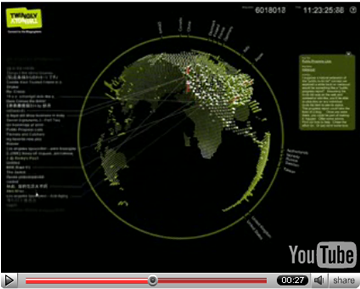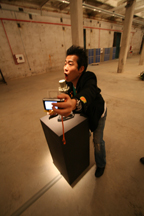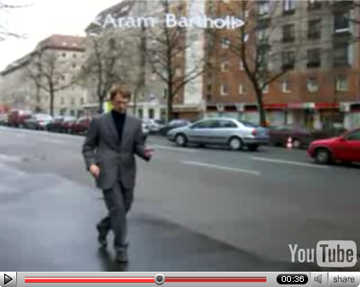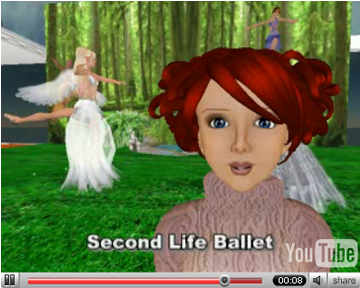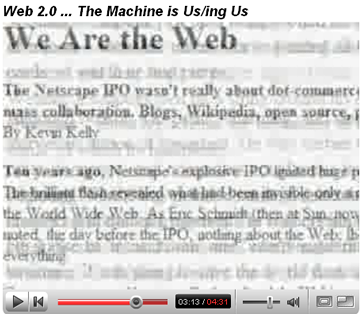« January 2007 | Main | March 2007 »
February 28, 2007
OurFloatingPoints 4: Participatory Media
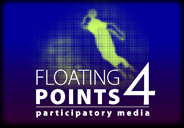
Ulises Mejias + Trebor Scholz
!! TONIGHT !! Emerson College and New Radio and Performing Arts, Inc./Turbulence.org present OurFloatingPoints 4: Participatory Media: Ulises Mejias and Trebor Scholz: The Challenges and Affordances of Participation in the Age of Networked Individualism :: DATE: February 28, 7:00 pm [EST] :: VENUE: Emerson College, Bordy Theater, 216 Tremont Street, Boston, Massachusetts, USA. The event will be streamed live and broadcast to Second Life [Emerson College Island, Emerson Island (145, 109, 23)]. Free and open to all!
This Floating Points event will start with Ulises Mejias and Trebor Scholz both presenting their positions about opportunities and problems with participation in sociable web media. They will then discuss each others argumentation and end with a debate open to the public at large. The sheer scale of current networked sociality demonstrates the potential of sociable web media to democratize society through emerging cultures of broad participation. While phenomena like information overload accompanied the emergence of communication technologies for a very long time, this current social turn is new.
Millions of people can now perform themselves as speakers, which is more pertinent than the question of quality or even political orientation of the produced content. In his presentation, titled "The Participatory Challenge," Trebor Scholz will investigate the affordances of sociable web media by looking at examples of the different intensities and motivations for participation in sociable web media and their effects.
Is production the new consumption? In "Networked participation: Wisdom of crowds or stupidity of masses?" Ulises Mejias will assess whether sociable web media can live up to its promise of reinvigorating the public sphere. While participatory networks are certainly posing an alternative to the ways in which the old mass media generates and disseminates messages, there is increasing skepticism about their ability to transform this aggregation of (mostly self-referential) information into meaningful social change. Furthermore, participatory media networks run the risk of being appropriated by the same mass media networks that contribute to the alienation of the individual within society. To understand why this is happening, we need to engage in a critique of the network as a model for organizing social realities. Only then will we be able to conceptualize new social realities that incorporate the best of networked participation with other ways of being in the world.
Ulises Ali Mejias is an educator and technocultural theorist whose research interests include networked sociality, the philosophy of technology, and learning design. He is a doctoral candidate at Columbia University, where he has taught a graduate seminar on the affordances of social media. His dissertation, "Networked Proximity: ICT's and the Mediation of Nearness" deals with the redefinition of social relevancy by digital media and explores the limits of the network as metaphor and model for organizing social realities. Mr. Mejias has been nominated two years consecutively for an EduBlog award.
Trebor Scholz is a media theorist, artist, and activist who lectures internationally on the affordances of networked sociality for media activism, art, and education. As founder of the Institute for Distributed Creativity (iDC), he contributed essays to several books, journals, and periodicals and co-edited "The Art of Free Cooperation," forthcoming with Autonomedia (NYC). He is currently assistant professor and researcher in the Department of Media Study at the State University of New York at Buffalo and research fellow at the Hochschule fuer Kunst und Gestaltung, Zurich (Switzerland).
Posted by jo at 06:36 PM | Comments (0)
Nathan (without a title)

Sonorous + Sonanos
Nathan (without a title) is a play by the Danish dramatist Christian Lollike staged by Aarhus Theatre. In Nathan (without a title) the actors are surrounded by an interactive digital scenography created by the Danish scenographer Claus Helbo in collaboration with CAVI. The recent staging of the play takes place in the Cathedral in Aarhus. In the interactive digital scenography, footage shot with a thermal camera is projected onto the vault of the cathedral. The interactive part consists of the actors being able to interact with falling pieces of projected text that are closely connected to the course of action.
The play adresses the ever present question of whether Christians, Jews and Muslims will be able to unite in a peaceful co-existence. Christian Lollike wishes to put tolerance to the test in a religious space, and that is why the performance takes place in the Cathedral in Aarhus.
Nathan (without a title) can be experienced in the Cathedral in Aarhus every Monday, Tuesday and Friday until March 16. Check out the video of Nathan (without a title). [blogged by Lene Mailund on Digital Experience]
Posted by jo at 04:19 PM | Comments (0)
Erik Nelson + Doo Yul Park

Sonorous + Sonanos
Abstract: Sonorous is an experiment in game design which aims to explore the possibilities of using music and sound as an alternative to traditional story-like narrative as the primary means of creating context for gameplay, and facilitating player engagement. Sonorous takes the form of a shortened Real Time Strategy game, where each unit the player controls takes on the properties of a musical instrument in the player's own temporary musical ensemble group. Through player choices and actions, the units will dynamically create and alter the musical score. The primary experiential goal of the piece is to evoke a grooving, or joyful dancing reaction in the player. The primary research goal of the project is to identify several tenets of Interactive Sound Design as they relate to games, in the hope of unveiling new game mechanics and systems which could be applied to arcade style and casual video games.
Keywords: Sonorous, Interactive Music, Musical RTS, Game Audio Synchronization, Game Event Synchronization, Music/Narrative, Interactive Sound Design, Grooving RTS
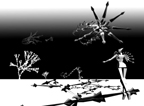
SONANOS: A Musically Structured World
Abstract: SONANOS is an application for interactive visual music. In this PC software, the user simultaneously composes music and constructs objects in a 3D environment. Combining objects generates rhythms, melodies, and phrases, which are determined by the visual properties of the procedurally generated objects. In the virtual environment, users can manipulate both the visual and musical structures. As a result, the user character evolves. The user character transforms, which represents the development of the composition. SONANOS adheres to the aesthetic conventions of the visual music genre, in which abstract graphics correspond to the rhythm. In this project, interactivity amplifies the synesthetic experience by enabling self-expression and deepening the connection between graphics and music.
KEYWORDS: SONANOS, synesthesia, interactive visual music, music video game, art game, procedural/generative/algorithmic graphics/ music/animation, music creation/composition game, musically structured world.
Posted by jo at 04:00 PM | Comments (0)
Architecture's Second Life
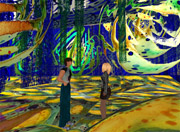
Replication of 1st Life or More?
"Who wouldn't enjoy the opportunity to change all the things about your life that you most yearn to change? This is the question the designers of Second Life had in mind when they built their successful massively-multiplayer online world. Second Life is not premised upon the completion of quests, doesn't require you to have a job, doesn't demand that you defeat any alien races or slay any dragons. The whole idea of Second Life is that you have, well - a second life in all of its minutiae. Starting with the creation of a new you, the Second Life world offers opportunities for the designing and construction of virtual clothing lines, virtual cars and yachts, and even virtual villas. There's been loads of hype, so much so, that celebrities make appearances, and big business has taken note.
For all the grand dreams of what life could be in Second Life (SL), this metaverse, as it's called, is decidedly more geared towards the exploration of post-silicon body modifications than the possibilities of spatial experience free of gravity, budget, and all those persnickety details. When it comes down to it, from an architectural perspective, Second Life just sort of replicates suburbia. In a universe built from free and easily manipulated virtual building units, there is a surprising lack of interesting work going on. Evidence, perhaps, that spatial banality is not just a symptom of something larger, but an affliction in and of itself." Continue reading Architecture's Second Life.
Posted by jo at 12:48 PM | Comments (0)
Grey Thumb Meeting Announcement

BlenderPeople
Roland Hess is talking about BlenderPeople at Grey Thumb Boston :: When: 7:00pm March 5, 2007 :: Where: The Asgard (350 Mass. Ave, Central Square, Cambridge) :: Who: All are welcome.
BlenderPeople is a free, open source crowd and combat simulation project. The system uses a combination of Blender 3D, Python programming and a MySQL database to generate and track the motion and interaction of Actors within a simulated environment. Although there have been other partial implementations of free crowd simulation software, BlenderPeople is the only one currently in development that offers a complete solution, from initial visualization through final rendering with high resolution character models. The project is not intended to be a realistic crowd simulation in the sense that one could use it to model emergency escape routes for architectural design, but focuses on producing animation that will be believable from an entertainment perspective. Technical issues that are addressed in BlenderPeople are different path finding algorithms for different time constraints, avoidance and self-structuring behavior of Actors from short rule sets, programming of Actors through simple distance thresholds, and a novel approach to footstep based character animation. Currently, the project's focus is on slashing search times for nearest neighbors from the field of Actors.
Note: Parking is available for $3 (with validation) in the garage behind The Asgard on Green St.
Grey Thumb Boston is a group of scientists, engineers, hackers, artists, and hobbyists in the Boston metro area with a strong interest in artificial life, artificial intelligence, biology, complex systems, and other related topics.
Posted by jo at 12:26 PM | Comments (0)
turned
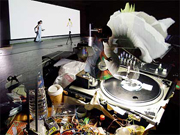
Resampled Dancer
Dance MADE IN BAVARIA 1. - 3. March 2007 Munich :: Chris Ziegler: turned + Herzliche Einladung nach Munchen in die Muffathalle, 2nd March 2007 8:30 PM :: director/ video: Christian Ziegler (D) / dance: Kazue Ikeda (J) / music: FLorian Meyer (D).
turned is an interactive and multi-media dance performance, developed and performed by media artist Chris Ziegler from Munich, with Kazue Ikeda, a Japanese dancer currently working in Berlin and DJ Florian Meyer (Institut fuer feinmotorik). The performance combines elements from dance, painting, visual art and music. The recorded images of the dancing body are sampled and distorted by electronic processing. The motion deconstructed in this manner opens up a poetic vision of loss and destruction. The viewer is taken along on a quest for clues. The piece turned is a turntable: it begins as a concert, continues as dance and then turns into an interactive video sequence and finally into a VR-installation - a multi-media-based spatial structure evolving before the eyes of the viewer.
The production realized during a residency at ZKM | Karlsruhe (center for art and media) was supported by: Kulturreferat der LH M|nchen, Bayerischer Landesverband Zeitgenvssischer Tanz, Fonds Darstellende K|nste e.V., Bonn.
Posted by jo at 11:05 AM | Comments (0)
MENDI + KEITH OBADIKE LAUNCH

Big House / Disclosure
BIG HOUSE / DISCLOSURE a 200-hour long house song with the voices of Chicago-area Citizens :: WHEN: March 1st- 8th :: WHERE: Northwestern Univ. Campus – Kresge Hall and online :: CONTACTS: office[at]blacknetart.com (blacknetart.com) & w-leopold[at]northwestern.edu, 847-491-4890 (Northwestern Office of University Relations)
Big House / Disclosure was constructed using audio interviews conducted by Northwestern University students with Chicago-area citizens about slavery and the city’s slavery era ordinance. Mixing these interviews with elements of Chicago house music, the artists created a multi-channel sound installation. The project includes 200 video clips of live art and musical performances viewable from the website. Musical events in the sound installation are triggered by custom-designed software tracking the real-time rise and fall stock prices of several corporations that have admitted to profiting from slavery.
Keith Obadike received a BA in Visual Art from North Carolina Central University and an MFA in Sound Design from Yale University. Mendi Obadike received a BA in English from Spelman College and a Ph.D. in Literature from Duke University. They have received a Rockefeller New Media Art Fellowship and commissions from the Whitney Museum of American Art, Whitechapel Gallery of London, Electronic Arts Intermix, and The New York African Film Festival. Their Internet opera, The Sour Thunder, was commissioned by Yale University, broadcast in its’ entirety in (104.5 fm) Berlin, and released by Bridge Records in 2004. In 2005 they launched Four Electric Ghosts, an opera produced by Toni Morrison’s Atelier at Princeton University, and in 2006 they performed a live sound art transmission from the Amory Art Show in New York commissioned by the Franklin Furnace. Big House / Disclosure has been generously supported by a Pick-Laudati Award from Northwestern University.
Posted by jo at 08:47 AM | Comments (0)
Aesthetic Evidence

@ Lily Pad
Aesthetic Evidence :: Halsey Burgund + Peter Bailey :: WHEN: Thursday, March 8th – 8:00 PM sharp :: WHERE: Lily Pad – 1353 Cambridge St (Inman Square), Cambridge, MA :: WHY: because we do crazy things on stage with instruments and computers and other people’s voices (and we might even ask you to donate yours…)
Aesthetic Evidence's music is based on recordings of human voices which the band members make both in the field and, in certain situations, in real-time during perfomances. These spoken voices are combined with instrumentation and singing voices to form their music. Using various sampling and triggering technologies, the band re-creates their songs live by playing traditional instruments along with real-time electronic manipulations.
Halsey Burgund uses a malletKAT, an electronic mallet percussion controller, to trigger voice samples and play various sounds while guitarist, Peter Bailey, fills out the arrangements with both electric and MIDI guitar. Please go here for more information and music downloads.
Posted by jo at 08:29 AM | Comments (0)
February 27, 2007
Upgrade! Seattle

steve boyer
Upgrade! Seattle: CODE - The Evolution of Abstraction and the Crisis of Human Identity by steve boyer :: 7pm Thursday March 8, 2007 :: 911 Media Arts Center • 402 9th Ave N • Seattle, WA.
Humanity is undergoing an Evolution of Abstraction. The physical forms and social and economic structures that have previously defined human identity are disintegrating, often being replaced by their symbolic representations. As these new modes of being replace the old we are faced with a Crisis of Identity in that assumptions about what it means to be human are challenged by new technologies, social narratives and biological realities. But every crisis presents an opportunity and at this critical turning point in human history we have a unique opportunity to rewrite the narrative codes that allow societies to self-organize and prosper. and to re-synthesize what it means to be human.
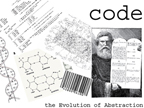
In this presentation connections will be drawn between medieval trompe l’oeil painting, cellular biology, insect robots and reality television in an attempt to elucidate some of the opportunities (and risks) that are posed by electronic and bio-technologies and to examine the role of electronic media in both the writing and re-writing of narrative codes.
Steve Boyer is an artist, designer and theorist with over 25 years of experience developing technology and creating content for interactive media. He has designed video games, electronic toys, musical instruments, light and sound sculpture and robotic architecture and has hands on experience in nearly every aspect of digital production from assembly language coding to 3D modeling and animation.
Currently, Steve is a visiting faculty member at the University of California - San Diego (UCSD) in the Visual Arts Department. He previously spent 6 years on the faculty of the Department of Art and Technology Studies at the School of the Art Institute of Chicago. Steve has a BA in Music from Northwestern University and a Master of Architecture from the Southern California Institute of Architecture.
Posted by jo at 05:23 PM | Comments (0)
Sousreality
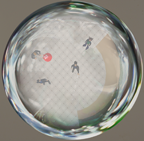
RL >><< SL
Sousreality -- by Drew Harry, Dietmar Offenhuber and Orkan Telhan at the MIT Media Lab -- is a pair of connected spaces linked through the metaphor of a crystal ball. In the SIGGRAPH gallery is a crystal ball that peers into Second Life, and in Second Life there is a crystal sphere containing a real-time inside-out vision of the gallery. The images of the spaces align visually and are also connected by audio.
The metaphor of the crystal ball informs this piece in several ways. Crystal balls are a tool for seeing into an alternate reality, a reality that maybe has something to do with the future, or may simply be created by our own minds. This vision is available to anyone, but requires the interpretation of a mystic. Our crystal ball functions the same way. It requires our presence and manipulation to keep the connection clear and open. We see our role as technologists similar to the role we play in this piece - we are expected to interpret the lessons of Second Life to predict the future of virtual worlds but often feel no more skilled at this task than mystics attempting to interpret visions in a crystal ball.
Through the larger form of the piece we address popular interpretations of Second Life. Virtual worlds are frequently described as subsidiary to the “real” world. We emphasize this by presenting Second Life as a world within a world, placing visitors to the gallery in a perceived position of power over the tiny avatars in the ball.
The audience is invited to gaze into the crystal ball and ask questions about the virtual world. The residents will happily answer, for a small fee, and we'll do our best to help them understand what they have to say and see what we can learn about the future in the process.
Status: Sousreality is work in progress - the concept described on this page doesn't exist quite yet. What you see in the video is a mockup. We'll probably be building the piece for real over the next 6 months, depending on a variety of things. If you want a tour of current mockup, feel free to email me (address below) or message me in SL at Zetetic Aubret. The land the mockup is on is shared with lots of other people who may not want lots of visitors, so we're hesitant to post a slurl right now. We'll update this page when we have more to show!
Acknowledgments: We'd like to thank Judith Donath and Aaron Zinman for helping develop the concept. We'd also like to thank all the Second Life residents who helped us make the movie and screenshot - Jaydiem Eun, Toto Donat, JC Fremont, Maximilian Haas, Squee Janitor, Mikiko Miasma, Abby Okey, and Karolwojtyla Sobocinski.
Contact: If you have any questions or comments, I can be reached at dharry at media . mit . edu. Read an interview >>
Posted by jo at 10:12 AM | Comments (0)
BREAKING NEWS:

MAN MICHINAGA SELLS THE BITFACTORY PROPERTY!
BREAKING NEWS: The Arts community in Second Life suddenly lost one of its most prized and established arts institutions late last night. The Bitfactory was the official rehearsal space for the performance art group, Second Front as well as serving as a location node for Intelligent Agent Magazine. The Bitfactory (formerly known as the Lichty-Michinaga Arts Center and Atelier Michinaga) had an equivalent reputation to the contemporary art museum, Ars Virtua. The Bitfactory's founder and owner Man Michinaga of Second Front will now devote his time and energy towards performance art and other creative endeavors... [blogged by Jeremy O. Turner aka. Wirxli Flimflam]
Posted by jo at 10:08 AM | Comments (0)
Eric Schuldenfrei
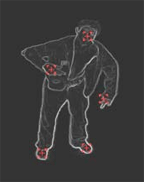
Reciprocity
“In the world of surveillance, the architecture of systems has effectively replaced architecture.” Eric Schuldenfrei
I was introduced to the work of Eric Schuldenfrei recently by Eyebeam Resident Jennifer Broutin. Schuldenfrei’s work focuses on the evolving relationship between animation, architecture, and art and has a diverse portfolio of projects that I couldn’t hope to all cover. Instead I will just cover one of his video pieces ‘Reciprocity‘ because of my own personal interest in reciprocal environments which I explored with my installation ‘Reciprocal Space‘. To look at more of Eric’s work visit his portfolio website.
Eric describes how “Theories of reciprocity… are used to describe relationships, mutually beneficial actions, situations of give and take, influence, correspondence, cause and effects within social structures. In reciprocity a relationship forms between those who operate and develop surveillance systems and those under surveillance.”
“Automatic digital collection systems and linked databases create highly contested spaces, raising questions of both security and privacy. Control is no longer conceived through building sections, plans, or perspectives, instead it is envisioned as a spatial construct in real-time, fully automated systems happening ubiquitously.” [blogged by Ruairi on Interactive Architecture dot org]
Posted by jo at 10:04 AM | Comments (0)
Charles Leadbeater + The Carr-Benkler Wager
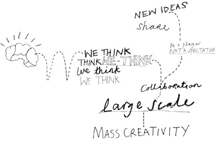
We-think
"Google is paying close on £900m for Youtube, a profitless business little more than a year old. Wikipedia continues to draw more traffic than much more established media brands, employing hundreds more people. Open source programmes such as Linux insistently chip away at corporate providers of proprietary software. Immersive multi user computer games, such as Second Life, which depend on high levels of user participation and creativity are booming. Craigslist a self help approach to searching for jobs and other useful stuff is eating into the ad revenues of newspapers. Youth magazines such as Smash Hits have been overwhelmed by the rise of social networking sites such as MySpace and Bebo. What is going on?
We-Think: the power of mass creativity is about what the rise of the likes of Wikipedia and Youtube, Linux and Craigslist means for the way we organise ourselves, not just in digital businesses but in schools and hospitals, cities and mainstream corporations. My argument is that these new forms of mass, creative collaboration announce the arrival of a society in which participation will be the key organising idea rather than consumption and work. People want to be players not just spectators, part of the action, not on the sidelines." Continue reading We-think.
What is the Carr-Benkler wager? by Charles Arthur, Thursday August 3, 2006, The Guardian:
Though sounding like something out of higher maths it's much simpler: a bet between two high-profile bloggers about whether in two years (or perhaps five) people will get paid for submitting content to sites like Digg and Flickr.
On the two sides: Nicholas Carr, a former executive editor of the Harvard Business Review; and Yochai Benkler, a professor of law at Yale University whose book, The Wealth of Networks: How Social Production Transforms Markets and Freedom, suggests that new types of collaboration let people be more productive than profit-seeking ventures.
Posted by jo at 09:36 AM | Comments (0)
Flavonoid
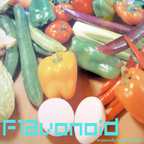
Translating 1st Life into 2nd Life
Speaking about 1st Life and 2nd Life connections, the Flavonoid project by Near-Future Laboratory colleague Julian Bleecker is of great interest. To put it shortly, it’s a mechanism for translating embodied, kinesthetic activity into 2nd Life actions.
A homebrew, Internet-enabled kinesthetic sensor, conceptually similar to a traditional pedometer, is being designed as a networked object that bridges the geophysical worlds (1st Life) and online digitally networked worlds (2nd Life). By providing data feeds about the kinesthetic activities of the person wearing Flavonoid, various embodiments representing that data can be created in 2nd Life, such as the appearance of online avatars, or that avatar’s wealth or capabilities.
So how does it work?
The Flavonoid Kinesthometer, a wearable networkable device, can transfer data as a networked object, providing simple data feeds of one’s movement over long periods of time. This data provides a channel of RSS information used as a baseline of information that can be translated to 2nd Life representations.
(…)
Flavonoid is envisioned as a platform, using standard, open feed technologies, for a variety of embodiments. The initial embodiment being a dynamic site “badge” — a small snippet of HTML that can be embedded on virtually any site, such as one’s blog or social networking home page.
The Flavonoid project proposal gives a more thorough description of what is aimed at here.
Why do I blog this? because this project takes the “Internet of Things” in a more interesting mode that what we’ve seen so far. By creating a framework for linking digital environments and the material world (”the leakage of digital networks into the physical world turns that world into a framework for a hybrid 1st Life/2nd Life”), it redefines the notion of embodiment in both environments.
This is an issue that interest me both to think about the future of ubiquitous applications and also as a user experience researcher. From a psychological point of view, there are intriguing questions to address here; especially regarding the overlap of spatial environments, their perception and how the interaction in each of them have an influence in the others. [blogged by nicolas on pasta and vinegar]
Posted by jo at 09:29 AM | Comments (0)
Neme: Erkki Huhtamo
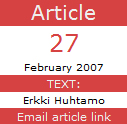
On the Identity Crisis of Interactive Art
"I encountered – “hands-on” – an emerging phenomenon called “interactive art” on my first visit to the Ars Electronica festival (Linz, Austria) in 1989. One of the works on display was Deep Contact, a laserdisc installation by the American artist Lynn Hershman. Sitting in front of a display, the user was invited by (the image of) a seductive young lady to “reach through the screen” and touch her. By means of a touchscreen interface, the spectator-turned-into-interactor responded, entering various realms, including a kind of garden of earthly delights, where s/he chose forking paths and encountered erotically loaded incidents along the way. Another installation was The Legible City by Jeffrey Shaw. By means of a stationary bicycle, like the ones at gyms, the visitor entered a virtual city consisting of letters, words and sentences. Choosing one’s routes through the spatialized database, one engaged in simultaneous acts of reading and writing with the combined efforts of one’s eyes, hands, and feet. I still remember the intoxicating feeling of diving under a giant letter “A”, or the sensation of virtually crashing through entire words. These experiences raised questions in my mind: what does cruising between and under letters, and even penetrating them, mean? What is the ontology of such experiences? Am I inside language, or even beyond it? Or inside someone else’s mind? Confronted with such uncanny issues, I had a feeling that something “new”, perhaps even the “ontological rupture” touted by virtual reality enthusiasts, was in the making." Continue reading On the Identity Crisis of Interactive Art by Erkki Huhtamo, Neme.
Posted by jo at 09:20 AM | Comments (0)
Sound Garden
![]()
Telematic Environment for Musical Becoming
Sound Garden: asynchronous improvisation by Norbert Herber + others :: telematic environment for musical becoming & interaction :: Web stream (using iTunes, Real Player, WinAmp, or Windows Media Player) :: Installation: Radio-TV Center (WTIU, WFIU, Department of Telecommunications) IU Bloomington campus.
Sound Garden is the second work in a series of musical installations that explore the relationship of people, location, and audio relative to technology. Listeners use the online interface to tend their sonic environment and take an active role in its composition and care. Using a web browser to select from a menu, participants can contribute their own digital audio files (musical material, voice and environmental recordings, etc.) and become gardeners that help to form the overall sonic landscape of Sound Garden.
Help cultivate the garden with your own short recordings, samples, soundscapes, and found sonic objects. Visit www.x-tet.com/soundgarden and access the web interface to "plant" MP3 files you would like to hear, or "prune" the garden and uproot files planted by others.
Posted by jo at 09:13 AM | Comments (0)
The Art World Is Flat
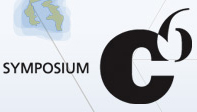
GLOBALISM – CRISIS AND OPPORTUNITY
The Art World is Flat: Globalism-Crisis and Oppportunity :: April 26-28, 2007 :: Jay Pritzker Pavilion, Millennium Park, Chicago.
Presenters: Amy Balkin, Francesco Bonami, David Buckland, Stephen Burks, Anna Deavere Smith, Bruce Ferguson, Ed Gillespie, Stanley Hainsworth, Susan Harris, Lynne Hershman Leeson, Natalie Jeremijenko, Simone Aaberg Kærn, Ruby Lerner, Rick Lowe, Lu Jie, Ken Lum, Bruce Mau, Lucy Orta, Anne Pasternak, Dan Peterman, James Rondeau, Peter Sellars, Jennifer Siegal, Stephanie Smith, Lynne Sowder and Victoria Burns, Francesca von Habsburg, Lawrence Weschler, Mathew Wilson, Jon Winet, and iro Yamagata.
Globalism is radically transforming our world, creating new political instabilities, economic interdependencies, ecological stresses and cultural hybrids. The negative results of globalism have been widely discussed: the loss of cultural and ecological diversity; the consolidation of economic and media power; the rise of violent reactionary and fundamentalist movements.
But there are concurrent trends that suggest hope for a more positive future. These include a growing awareness of the interconnectedness of human destiny regardless of religious, geographic or political differences; the uses of technology to heighten and accelerate social networks and actions; the realization of the urgency of addressing pressing, common, environmental, economic and political crises.
For the arts, the crisis of globalism is also an opportunity to interact meaningfully with visionaries in business, politics, science, and other arenas
The arts, always a harbinger of change, are likewise experiencing an unprecedented surge of new aesthetic forms, cross-disciplinary partnerships, distribution networks, market forces and inter-cultural exchanges. For the arts, the crisis of globalism is also an opportunity to interact meaningfully with visionaries in business, politics, science, and other arenas, and to play a powerful new role in the transformation of our shared reality and emerging future.
This conference will bring together an international group of innovative and socially engaged artists, writers, scientists, technologists, curators, theorists, patrons, entrepreneurs, designers, and collectors, among others. It will focus on how the forces of globalism are challenging traditional hierarchies, redistributing capital, creating powerful new collaborative models, and generating new kinds of hybrid cultural practice.
Conference participants will discuss questions relating to current trends, emerging paradigms, and possible cultural futures in three interrelated thematic areas:
New Capital(s)
Hegemony and Resistance in the Global Cultural Economy
How do shifts in wealth encourage or limit cultural visibility and diversity? Will new cultural centers emerge, offering new possibilities? What are the new models of interventionist cultural practice? Why are new patrons creating alternative structures and processes for cultural experiences?
No Borders Here?
Cultural Hybrids, Nomads, Refugees
What economic, political and cultural imperatives drive the new nomadism? How is technology erasing traditional hierarchies and boundaries of cultural production, distribution and interpretation? How is the restless peripatetic creative class producing new dislocations, networks and communities?
Green World
Art for a Sustainable Ecological Consciousness
What new solutions to the ecological crisis are emerging from collaborations between science, culture and technology? How are green artists, designers and architects using developments in science, genetics and technology? What role does culture play on the brink of environmental catastrophe?
A wide ranging and provocative discussion, the conference will raise new questions, generate lively debate and offer possible answers to how we can anticipate and respond to the challenges and opportunities resulting from the fact that for now, and for the foreseeable future, “the art world is flat.”
Posted by jo at 08:59 AM | Comments (0)
foodradio_network presents

"live_feed: Snack City" CALL IN
foodradio_network presents live_feed : Snack City from the MediaWala Festival as the culmination of a two day workshop with local / international / remote participants exploring the culture and politics of streetfood. CALL the SNACK CITY OPEN PHONE IN and talk to us about your favorite street food. Share the taste, smell and the sound of your favorite neighbourhood street snack joint live.
Turn your phone into a microphone! 1. CALL 9818977450 (DELHI) 2. Listen to the phone ring twice and go quiet 3. You are ON AIR! LISTEN LIVE :: 8pm-10pm IST - Thu, March 1st free103point9 Online Radio
foodradio_network is an open and variable network of broadcasters and foodsters exploring the culture, politics and creativity of food as a medium and a metaphor for experiments in participatory and collaborative live radio. They regularly dish up aural appetisers on their show live_feed which plays on free103point9 online radio. live_feed @ MediaWalaFestival includes participants from Australia, India, Finland, America... and possibly also You!
Posted by jo at 08:36 AM | Comments (0)
The case for network neutrality
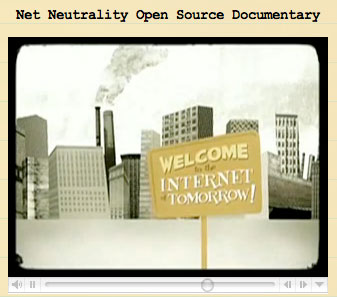
A strong video which provides an informative overview and suggestions for action can be found here. Included is code to copy and paste in your own blog to display the video. It seems very important to me that “we the digital media” act to keep the Internet open before there is only “they the digital media” as happened in the 20th century with analog. Via Lessig Blog [posted by Judy Breck on Smart Mobs]
Posted by jo at 07:42 AM | Comments (0)
February 26, 2007
ICEBOX 02 Cape Town

Festival of Audio/Visual Art
ICEBOX 02 Cape Town :: February 28 – March 10, 2007 :: Liquid Fridge presents a festival of contemporary creativity in audio/visual art. With the focus on the electronic, open and South African, ICEBOX combines music, film, video and interactive media through a programme of screenings, performances, club nights, workshops and an exhibition.
ICEBOX 02 Cape Town features music-makers, free thinkers and electronic tinkerers Bernhard Loibner (Austria), Brendon Bussy, Com.it, CY Cowboys, Garth Erasmus, Heather Ford (Johannesburg), Dean Henning (Durban), Julian Jonker, Rebecca Kahn (Johannesburg), Microstripe, MTKidu (Johannesburg), Radioboy, Story Boy, and many other proponents of eclectic sounds and plush pixels.
Supported by the Austrian Consulate Cape Town, CAPE Africa Platform, iCommons and netbek. Press support by BRAND, Enjin and one small seed, and online by Kak Duidelik and Swikiri. With thanks to alt film, Bell-Roberts, INTERFACE, Magmart, MTKidu and rustpunk.
ICEBOX 02 Screening
Venue: Labia on Kloof, Lifestyle on Kloof, 50 Kloof Street, Cape Town
Date: Wednesday, February 28 at 8.30pm
Cost: R25
An evening of innovative short-form narratives, documentaries, music videos and animations by over 20 independent creators from South Africa and abroad.
Featuring both award-winning and rarely seen work, the line-up includes Ana Alvarez-Errecalde (ES), The Blackheart Gang (SA), Jaco Brouwer (SA), Tessa Comrie (SA), Fopspeen (SA), Goldfish/Iaminawe (SA), Kidult (SA), Dmitry Kmelnitsky (US), Lark/Ontwerp (SA), Chris Moore (SA), Giorgio Partesana (IT), Andrew Schnetler (SA), Mike Scott (SA), Daniel van der Merwe (SA), Lisa Vinebaum (CA), Tina Willgren (SE) and Dale Yudelman (SA), as well as Microcinema International’s “Independent Exposure” series and the Magmart video art festival (IT).
ICEBOX 02 Exhibition
Venue: Bell-Roberts CUBE Gallery, 89 Bree Street, Cape Town
Date: Opens Thursday, March 1 at 6pm. Closes March 10
Eerie soundscapes and abstract electronica are entwined with computer-generated imagery and appropriated digital video in brief, meditative journeys and waltzes of fusion and fission. Sound painters, picture mixers and media hackers aim to challenge the viewer’s preconceived notions and question the status quo, yet at times to simply entertain the talented listener.
The line-up includes work from Kisito Assangni (TG), D-Fuse (UK), The Dualist (SA), Fabian Giles (MX), Josh Goldman (US), Henry Gwiazda (US), Corlia Harmsen (SA), Hanna Husberg (FR), Jose Insua (US), Jun'ichiro Ishii (FR), Dmitry Kmelnitsky (US), Argyro Koutsibela (GR), Bernhard Loibner (AT), Jenni Meredith (UK), Vesna Milicevic (CS), Giorgio Partesana (IT), Carol Pereira (US), John Vega (US), Hagen Wiel (DE) and Dale Yudelman (SA).
The exhibition also features “A Light Distraction.” Sonic engineer Martin Sims and electro-acoustic artist Brendon Bussy have collaborated in creating a light centred installation. Technologies normally used to measure and show change in the level of sound energy have been re-wired. Now the viewer can control input - in fact create change, leaving as a measure of their interaction, light.
Gallery hours: Monday - Friday 8.30am - 5.30pm, Saturdays 10am - 2pm
ICEBOX 02 Workshop and Performance
Venue: CAPE Africa Platform, 71 Buitengracht Street, Cape Town
Date: Saturday, March 3 at 1pm
Cost: Donation
An afternoon of presentations on appropriation art, music mash-ups, circuit bending for sound, intellectual property rights and how digital artists can both protect and share their work for collaboration. The workshop also features a live audio/visual performance by MTKidu. Creative Commons-licensed videos will be available for free, legal download onto USB flash drive.
“How to stop worrying about the big C and learn to love CC: An Artists' Guide to IP” presented by Heather Ford (executive director) and Rebecca Kahn (writing and research fellow) from iCommons, Johannesburg.
What is copyright? How does it affect my art and creativity? Is there such a thing as “legal remixing” and how do artists still make a buck while giving their stuff away for free?
The Creative Commons South Africa team explain how copyright affects artists and creators, the common pitfalls, and the practical steps you can take to make sure you are in control of your creativity. They also introduce participants to Creative Commons raw materials that are freely available to legally remix and share, and show video work by artists from South Africa and abroad, who are using copyright to spur global collaborations, broaden their communities and kick-start their careers.
“Song of Solomon” presented by writer, sound artist and cultural producer Julian Jonker.
“Song of Solomon,” devised by Julian Jonker and technologist Ralph Borland, is an algorithmic audio collage using more than 70 performances and adaptations of Solomon Linda’s composition “Mbube,” also performed and adapted as “Wimoweh” and “The Lion Sleeps Tonight.” The installation intends to provoke questions about the archetypal models of creativity that inform Western intellectual property law; in its implementation at the Durban Art Gallery in September 2006, the installation arguably infringed South African copyright law in various ways.
He also discusses the interaction between other forms of appropriation art and intellectual property law, specifically mash-ups and DJ mixes.
“Basic Circuit Bending” presented by electro-acoustic artist Dean Henning from rustpunk, Durban.
Bleeps and sweeps aplenty as Dean Henning discusses and demonstrates how simple, low-cost technology (including toys) can be re-purposed for musical performance.
“Live beat construct and visual manipulation” performance by MTKidu from Johannesburg.
The dynamic design and electronic music duo perform live, and afterwards share experiences in live audio/visual experimentation.
ICEBOX 02 Screening
Venue: Zula Sound Bar, 194 Long Street, Cape Town
Date: Sunday, March 4 at 7pm
Cost: Free
An evening of innovative short-form narratives, documentaries and animations from Ciro Altabas (ES), Dany Campos (ES), Sally Giles (SA), Dmitry Kmelnitsky (US), Frédérique Zepter (FR), Microcinema International’s “Independent Exposure” series, and the Magmart video art festival (IT).
The screening is presented in partnership with alt film, a group established to collect and screen film by creative South Africans, as well as work that most powerfully incorporates and describes the inevitable evolution of the medium.
ICEBOX 02 Workshop and Performances
Venue: CAPE Africa Platform, 71 Buitengracht Street, Cape Town
Date: Saturday, March 10 at 1pm
Cost: Donation
Musicians and media artists Bernhard Loibner (Austria), Brendon Bussy and Garth Erasmus perform live on electric bass guitar, mandolin and saxophone, with an array of electronics, custom software and deft improvisation. Afterwards, they offer a detailed insight into the dark art of experimental audio, discuss their crossover work in video and other media, and share techniques with participants. Brendon’s presentation includes a collaborative performance with multimedia artist Charles Maggs.
Bernhard Loibner is a composer of electronic music, musician and media artist. Besides live concerts on a regular basis in Europe and North America, his work includes compositions for contemporary theatre and dance, as well as video, film and radio. His compositions are characterised by the use of live electronics and computers as unique instruments to create complex musical structures between silence and noise. Starting from musical compositions, he has extended his work into the audio-visual domain.
Electro-acoustic artist Brendon Bussy creates sound pieces combining the mandolin and Audiomulch, a realtime audio processing tool. In 2003, he released “Diesel Geiger” (Open Record) and in 2006, he created wind-activated sound elements for Ralph Borland’s Sharks in Jetty Square, Cape Town. A recent work that utilises contact microphones will be performed at the 2007 Vancouver Signal and Noise Festival of video and audio art. Currently he is writing mandolin compositions intended as components of video works.
Garth Erasmus is a full-time artist and musician passionate about his indigenous Khoi-San roots. As a member of the music and performance poetry group Khoi Khonnexion, he plays self-made instruments based on ethnic ancestry. He is also part of Riempie Vasmaak, where he plays saxophone in an ensemble whose work can best be described as chaotic spontaneous musical invention or free improvisation, for the academic snobs. His solo work on saxophone is a synthesis between these two groups’ approaches with its rhythmic harmonic underpinning and expressive freedom.
ICEBOX 02 Club Night
Venue: The Independent Armchair Theatre, 135 Lower Main Road, Observatory, Cape Town
Date: Saturday, March 10 at 9pm
Cost: R30
Liquid Fridge presents an eclectic selection of DJ’d and live retro-tech-future-funk, accompanied by a hearty serving of performing pixels.
Line-up:
Bernhard Loibner (Austria) - Electro-acoustic
Story Boy - Hip-hop / Jazz / Soul
CY Cowboys - Afrikaans Electro
Radioboy (‘ardkore / Liquid Fridge) - Techno
Microstripe (Big Love) - Breakbeat
Com.it (Big Love / Bush Radio) - Drum & Bass
Bernhard Loibner is a composer of electronic music, musician and media artist. Besides live concerts on a regular basis in Europe and North America, his work includes compositions for contemporary theatre and dance, as well as video, film and radio. His compositions are characterised by the use of live electronics and computers as unique instruments to create complex musical structures between silence and noise. Starting from musical compositions, he has extended his work into the audio-visual domain.
Ongoing collaborations include the sound/video/voice duo Nerve Theory with US video artist Tom Sherman, and live concerts with musicians such as Karlheinz Essl, o.blaat, Bernhard Gal and Joao Castro Pinto. Commissioned work includes compositions for films by Austrian director Mara Mattuschka, the performance extravaganza of the French collective SUPERAMAS and the Austrian National Public Radio.
His music and video has been released on CD and DVD, and he has appeared at numerous festivals, including Ars Electronica Linz, Cybersonica London and Elektra Montreal.
After a 2-year hiatus, the CY Cowboys return with their original Afrikaans Electro sound. Unique and outspoken, these two cowboys deliver not only thought-provoking lyrics, but also tongue-in-cheek local humour and slamming beats to the Cape Town electronic scene. Join them for a DJ set of their most popular anthems, as well as audio gems from the new album.
Microstripe has been spinning her beats in some form or another since 2001. Moving between Hip-hop, Drum & Bass, Breaks and Electro, she has played at numerous gigs around Cape Town, as well as a few in Johannesburg and London. These include Big Love parties, Obs and Long Street Festivals, her own annual New Year’s Eve outdoor Electronica festival, and of course Liquid Fridge events. She recently played alongside UK Breaks producer General Midi on his SA tour.
Com.it is South Africa’s longest standing female Drum & Bass DJ. She has been involved in the D&B scene since 1994, and started playing out around 1997. She is a key member of the Momentum crew and has been a resident on the Sublime Drum & Bass show on Bush Radio 89.5FM since 2002. She is also a co-founder of the Big Love movement, which aims to further the South African electronic music scene.
Story Boy is one of Cape Town's top VJs and can be found projecting visual mixes alongside a variety of Cape Town's top DJs, bands and electronic acts. He is also a crate digger who occasionally unveils his eclectic record bag of b-boy Hip-hop nostalgia, dusty Jazz and electronic Soul goodness.
Artist / Speaker Information
Brendon Bussy
Appearance: Saturday, March 10 workshop and installation at exhibition
Web: www.openrecord.co.za/bussy.html, http://ralphborland.net/jettysquare
Electro-acoustic artist Brendon Bussy creates sound pieces combining the mandolin and Audiomulch, a realtime audio processing tool.
Performance collaborations include Abel Steen with Tinus van Dyk, Corrective with Dean Henning, and Mike Whitehead (ex-Famous Curtain Trick). He has also performed with Dutch performance art group Dogtroep, and at the UNYAZI Symposium of Electronic Music. In 2006, he created wind-activated sound elements for Ralph Borland’s Sharks in Jetty Square, Cape Town. A recent work that utilises contact microphones will be performed at the 2007 Vancouver Signal and Noise Festival of video and audio art. Currently he is writing mandolin compositions intended as components of video works.
He has taught violin, viola, piano, music theory and short courses in digital audio, and has presented at Liquid Fridge’s UPLOAD workshops. His debut solo album “Diesel Geiger” (Open Record) is a “digital twisting” of acoustic material and field recordings.
Com.it (Lecia Nel)
Appearance: Saturday, March 10 club night
Web: www.biglove.co.za
Com.it is South Africa’s longest standing female Drum & Bass DJ. She has been involved in the D&B scene since 1994, and started playing out around 1997. She is a key member of the Momentum crew and has been a resident on the Sublime Drum & Bass show on Bush Radio 89.5FM since 2002. She is also a co-founder of the Big Love movement, which aims to further the South African electronic music scene. When speaking on her plans for the future, she says that she “would like to bring the South African scene to a point where it catches up with the First World’s standards, as well as exposing our culture to their way of life.”
Garth Erasmus
Appearance: Saturday, March 10 workshop
Web: www.asai.co.za
Garth Erasmus is a full-time artist and musician passionate about his indigenous Khoi-San roots. As a member of the music and performance poetry group Khoi Khonnexion, he plays self-made instruments based on ethnic ancestry. He is also part of Riempie Vasmaak, where he plays saxophone in an ensemble whose work can best be described as chaotic spontaneous musical invention or free improvisation, for the academic snobs. His solo work on saxophone is a synthesis between these two groups’ approaches with its rhythmic harmonic underpinning and expressive freedom.
Solo and group performances include the Klein Karoo Nasionale Kunstefees with Khoi Khonnexion, “Healing the Feeling” with Werne Feller and Christian "Guy" Tschannen (Switzerland), “Urban Voices” with Malika Ndlovu, and the Sara Baartman Memorial Concert.
He has both exhibited and taught art extensively in South Africa and abroad, and has also coordinated various cultural initiatives.
Dean Henning
Appearance: Saturday, March 3 workshop
Web: www.thesoundofand.co.za, www.rustpunk.co.za
Dean Henning has been involved in the SA music scene for many years, starting at the tender age of 16 as a founding member and drummer in the seminal Fingerhead. In the following years, he has branched out into other artistic arenas, predominantly in digital media. He co-ordinated and remixed work for the rockabilly crossover “Ricky Gass Project”, remixed work for Benguela and Illuminating Shadows, and has appeared on various compilations under his “Captain Asthma” moniker.
Recently, together with partner and collaborator Rike Sitas, he has created music videos and video pieces for dance performances (such as Jay Pather’s Republic and The Beautiful Ones Must Be Born). Rike and Dean had their first solo exhibition as part of the NSA’s Young Artists Project. Entitled “a city”, described in Art South Africa as “easily the most ingenuous, ingenious, expressive and evocative installation [the reviewer has] yet encountered.” The work also received a special mention in ArtThrob’s local exhibition of the year.
Heather Ford
Appearance: Saturday, March 3 workshop
Web: www.icommons.org
Heather Ford is the Executive Director of iCommons, an international subsidiary of Creative Commons. A South African who has worked in the fields of Internet policy, law and management in South Africa, the United Kingdom and the United States, Heather graduated from Rhodes University with a Bachelor of Journalism degree and has a certificate in Telecommunications Policy, Law and Management from the University of the Witwatersrand Link Centre. After working in the United Kingdom for Greennet and Privacy International, she went on to Stanford University in 2003 where she worked as a fellow in the Reuters Digital Vision Fellowship Program. Volunteering for Creative Commons while she was at Stanford, she decided to go back to South Africa at the end of her studies to start Creative Commons South Africa and a project entitled “Commons-sense: Towards an African Digital Information Commons” at the Wits University Link Centre. Recently appointed Executive Director of iCommons, Heather is also helping to help establish an Intellectual Property Research Unit at the Link Centre and a new NGO called “The African Commons Project”.
Julian Jonker
Appearance: Saturday, March 3 workshop
Web: www.liberationchabalala.net
Julian Jonker is a writer, sound artist and cultural producer living in Cape Town. His work explores the genealogies, promises and ethics of cultural memory. He has published in a variety of literary and academic forums. He has produced music and performance projects independently, as well as for the District Six Museum, the Cape Town Festival and the Western Cape Street Bands Association. His sound art has been exhibited at the Durban Art Gallery and performed as part of the Vox Novus new music festival. He performs as a DJ and mash-up artist, and is a member of the Fong Kong Bantu Sound System.
Rebecca Kahn
Appearance: Saturday, March 3 workshop
Web: www.icommons.org
Rebecca Kahn is a writing and research fellow at iCommons, and has closely followed the growth of Creative Commons in South Africa since its launch. It took her a while to wrap her head around all this copyright stuff, but now she knows who the righteous ones are. She graduated with an Honours degree in English from Rhodes University and has worked as a freelance journalist for the last few years. She is currently completing an M.A. in Journalism at the University of the Witwatersrand, and likes her Bloody Marys spicy.
Bernhard Loibner (Austria)
Appearance: Saturday, March 10 workshop and club night
Web: www.loibner.cc
Bernhard Loibner is a composer of electronic music, musician and media artist. Besides live concerts on a regular basis in Europe and North America, his work includes compositions for contemporary theatre and dance, as well as video, film and radio.
His compositions are characterised by the use of live electronics and computers as unique instruments to create complex musical structures between silence and noise. Starting from musical compositions, he has extended his work into the audio-visual domain.
Ongoing collaborations include the sound/video/voice duo Nerve Theory with US video artist Tom Sherman, and live concerts with musicians such as Karlheinz Essl, o.blaat, Bernhard Gal and Joao Castro Pinto. Commissioned work includes compositions for films by Austrian director Mara Mattuschka, the performance extravaganza of the French collective SUPERAMAS and the Austrian National Public Radio.
His music and video has been released on CD and DVD, and he has appeared at numerous festivals, including Ars Electronica Linz, Cybersonica London and Elektra Montreal.
Microstripe (Yalena Razis)
Appearance: Saturday, March 10 club night
Web: www.soundsquad.co.za, www.biglove.co.za, www.myspace.com/yalena_
Microstripe has been spinning her beats in some form or another since 2001. Moving between Hip-hop, Drum & Bass, Breaks and Electro, she has played at numerous gigs around Cape Town, as well as a few in Johannesburg and London. These include Big Love parties, Obs and Long Street Festivals, her own annual New Year’s Eve outdoor Electronica festival, and of course Liquid Fridge events. She recently played alongside UK Breaks producer General Midi on his SA tour.
MTKidu (Murray Turpin and Nicholas Nesbitt)
Appearance: Saturday, March 3 at workshop
Web: www.mtkidu.com
On a path of shared creative consciousness, MTKidu is a beat construct and visual manipulation team formed in pursuit of an audiovisual language that is both experimental and dark.
As art galleries and clubs stagnate into white and grey cube commercialism, we will not forget the original purpose and potential of these spaces for invention and exploration. The time has come to break the conventional moulds.
MTKidu’s TFTD 0.5 (Tales from the Dark) multi-media album is available at The Bin in Cape Town and Canned Applause in Johannesburg.
Radioboy (Martin Sims)
Appearance: Saturday, March 10 club night and installation at exhibition
Web: www.liquidfridge.co.za
Martin Sims tinkers with media. He is a broadcast engineer by day and a DJ god in his sleep. In 2003, he helped bring to life the short-lived Spectrum radio service. Before that he presented 'ardkore, an electronic music show on Bush Radio 89.5FM. He is a co-founder of Liquid Fridge and enjoys reading e-mail. Currently he passes the time building radio studios, teaching technology and being a Dad.
Story Boy (Anwar McWhite)
Appearance: Saturday, March 10 club night
Story Boy is one of Cape Town's top VJs and can be found projecting visual mixes alongside a variety of Cape Town's top DJs, bands and electronic acts. He is also a crate digger who occasionally unveils his eclectic record bag of b-boy Hip-hop nostalgia, dusty Jazz and electronic Soul goodness.
Sponsors
Austrian Consulate Cape Town
CAPE Africa Platform is a section 21 company established to encourage and facilitate contemporary African creativity through innovative exhibitions, discussion sessions and education programmes.
Incubated by Creative Commons, iCommons is an organisation with a broad vision to develop a united global commons front by collaborating with open content, access to knowledge, free software, open access publishing and free culture communities around the world.
netbek is passionate about digital creation and specialises in development for the web and elsewhere.
About Liquid Fridge
Liquid Fridge is a non-profit organisation devoted to advancing contemporary South African creativity by encouraging interaction between those who explore the creative uses of technology, and debating the issues of art, media, culture and society.
Started in 2002, Liquid Fridge has provided coverage of and a discussion forum for local contemporary art, has hosted screenings, performances, club nights and workshops with leading South African and international artists and academics, and has contributed expertise to media initiatives such as Spectrum 91.3FM, radio station of the Red Bull Music Academy 2003.
Contact Information
Hein Bekker, director and media liaison
Mobile: +27 (0)82 508 2922
E-mail: hein[at]liquidfridge.co.za
Yalena Razis, co-ordinator
Mobile: +27 (0)83 611 6622
E-mail: yalena[at]gmail.com
Posted by jo at 07:03 PM | Comments (0)
Ophonine Pophorn
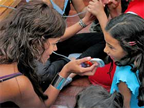
Phone as Musical Instrument
Paving the way for more news about Bogota...
Erik Sandelin and Magnus Torstensson from Unsworn have presented at the Bogotrax festival in Bogotá their new Ophonine Pophorn software. The Ophonine is the first in an upcoming series of applications that transform your mobile phone into various musical instruments. With the Ophonine you can record and play sound loops with a press of a button.
First you have to download the Ophonine Pophorn software which will be available for free in May 2007. After that it works like this: press and hold the button to record a sound loop, using the microphone of the handset. When you let go of the button the loop is played back repeatedly - through the phone speaker or via an audio cable - until another sound has been recorded. Demo.
The Ophonine Pophorn is based on Unsworn’s installation, the Four Ophones.
After Bogotrax (which ends today) Unsworn will continue its Colombian Pophorn Tour with events in Medellin, as part of the Pixelazo festival.
Top image by Bogotrax' photos. More mobile phone as a musical instrument: musical tones played depending on how far away the hand is from the camera; the HandyDandy, Dialtones, Sinfonietta ringtone concert. [blogged by Regine on we-make-money-not-art]
Posted by jo at 06:13 PM | Comments (0)
Upgrgade! Sofia

The Bulgarian Identity in Europe
Upgrade! Sofia :: Place: Main Hall, Goethe Institute Sofia, 1 Budapest Street :: Date: TODAY at 19:00.
After two months of absence Upgrade Sofia returns with a new kind of event. This time we have Veronika Tzekova doing a presentation on the topic "Identity Jamming" and the guest artist from Germany Wolfgang Kemptner presenting the project "Wet Interviews 2". Both presentations are united by one topic - Bulgaria and Europe. These presentations will be used as a tool to form a discussion about the Bulgarian identity in Europe, one hot topic right now. Are we part of the Europe? Nothing has changed, but things aren't quite the same after Bulgaria entered the European Union in January 2007. How does that affect our personalities and changes our point of view, even on a artistic level? Are we Europeans really?
Posted by jo at 11:19 AM | Comments (0)
February 25, 2007
Upgrade! Vancouver

Outdoor Social Videosharing in the Built Environment
Upgrade! Vancouver: In partnership with Upgrade! International, Upgrade! Vancouver is launching a series of outdoor screenings of local and international art videos. Appropriating the functional model of online videosharing sites such as Youtube, we are creating a series of exploratory events that translate social videosharing into the analogue environment of the urban street.
Video programmes are curated by individual Upgrade nodes and screened outdoors in the built environment of cities including Vancouver, Paris, Montreal, Belgrade, Seattle, Scotland, Skopje, Chicago, Boston, Amsterdam and Istanbul. Videos will travel between cities, being screened locally and internationally. The social software aspect of these events is explored through a deliberately low-tech model in which flyers containing contact information for participating artists will be circulated at the screenings, with the intention of encouraging people in these cities to develop individual connections. The series will launch in Vancouver in March, 2007. For more information, to submit work, or to get involved: Kate Armstrong : kate at katearmstrong dot com. Boston artists can contact jo at turbulence dot org directly.
Posted by jo at 05:52 PM | Comments (0)
February 24, 2007
Sakura_mapping system

Call for Participation
[posted by Yukihiko Yoshida] Sakura_mapping system is a mapping system that can make visualization of "Sakura (Cherry blossom) front" on satellite image. "Photograph of cherry blossoms" and the location information are contributed with mail. You can see it with Google Maps and Google Earth. (Sorry, Text is Japanese only) http://mapping.jp/map/sakura_gmap.html http://mapping.jp/sakura_mapping.kmz
You can participate by sending the cherry blossoms image with mail. Please add GPS information to exif header of the image. map07[at]mapping.jp We are waiting for the contribution from countries other than Japan.
Cherry blossoms are national flowers in Japan. This is a non-profit-making project, co-sponsoring of arbitrary group "Green photon" and "Committee of Earthday Tokyo". It is possible to participate from all...cellular phone with GPS, usual cellular phone, and PC. In Japan, the location information is judged from the mail text when there is no GPS information.
Posted by jo at 04:03 PM | Comments (0)
Museum of Contemporary Art Antwerp [MuHKA] lectures
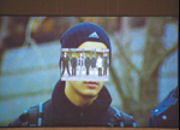
KEYWORDS/CULTURE
MuHKA lectures: KEYWORDS/CULTURE :: THU 03.01 8 PM Paul Gilroy and Steve McQueen :: THU 03.22 8 PM Rudi Laermans and Lieven de Cauter :: THU 04.12 8 PM Adrain Rifkin and Sudeep Dasgupta :: THU 05.10 8 PM Maria Hlavajova and Rosi Braidotti :: A conversation between Martha Rosler and Susan Kelly took place in October 2006.
MuHKA presents a series of dialogues on the term culture as a keyword around which individuals and societies produce, contest and share meaning, bringing together several leading figures working in this field.
In his book Keywords: A Vocabulary of Culture and Society, Raymond Williams gives a precise and useful account of the words that are instrumental in shaping our understanding of culture and society. Words, which although familiar, he believed, would benefit from further clarification; not in order to impose a finite meaning on them, but instead to describe their development, adaptation and translation between times and places and their relationship to other words. In his definition of ‘culture’ Williams describes this word as one of the two or three most complicated words and elsewhere as the original difficult word. It can simultaneously refer to: [1] intellectual, spiritual and aesthetic development [2] the way of life of a people, time or place and [3] artistic works or the output of aesthetic practices. According to Williams its complexity stems from the fact that the word culture plays an equally important role in a number of different areas of exper ience [art being one, society being another] between which it occupies an awkward place.
By way of elucidation Williams traces the etymology of ‘culture’ back to its roots in plant or animal husbandry [to cultivate or to tend]; how it came to refer to the development of manners and the intellectual faculties, how it was extended to include more generalised social processes and how through its links to civilisation, class and civil values it acquired a contested status. The formulation and maintenance of cultural elites and the culture wars that saw previously excluded groups gate-crashing the citadel. Today the term ‘culture’ is deployed for a combination of progressive, bureaucratic and reactionary causes. As a remedy for social exclusion, for the empowerment of sub and counter cultural groups, as an instrument of government policy, and in the xenophobic ring-fencing of cultural values and norms on ethnic, religious and linguistic grounds.
Williams believed that the awkward position that the word ‘culture’ occupies somewhere in-between social and artistic categories, rather than being a problem, instead produces a range and overlap of meaning that is the source of its significance. Indicating a complex argument about relations between general human development and a particular way of life, and between both and the works and practices of art and intelligence.
This lecture series at MuHKA will take the slippage that finds ‘culture’ sitting in-between, artistic, social and theoretical discourse as its point of departure and consider the following questions:
[1] Rather than divide culture into neat partitions such as art, politics and lifestyle can we approach it as a continuous field with many intersecting points? [2] How can we best challenge cultural norms which are exclusive and prescriptive and aim for a culture that is convivial and cosmopolitan? [3] Rather than accepting culture as commodity or policy objective, is it possible instead to imagine a culture that is always undisciplined, flexible and in motion?
SPEAKERS
PAUL GILROY
Paul Gilroy [1956] is a Professor of Social Theory at the London School of Economics. He has an extensive interests in literature, art, music and cultural history as well as in the social sciences. He is best known for his work on racism, nationalism and ethnicity and for his original approach to the history of the African Diaspora. His theories of race, racism and culture were influential in shaping the cultural and political movement of black British people during the 1990s. His books include Ain’t no Black in the Union Jack [1993] The Black Atlantic [1993] and After Empire [2004]. Gilroy’s current research projects include a study of the moral economy of blackness in the twentieth century, a volume on the social and technological dynamics of popular music, and a comparative and historical consideration of colonial government.
STEVE McQUEEN
Steve McQueen [1969] is a film maker and video artist based in Amsterdam. He became interested in film as an art student at Goldsmiths' College, London. On graduating in 1993 he spent a year studying film at the Tisch School of the Arts in New York. From his first major film, Bear [1993], exhibited at the Royal College of Art in 1994, McQueen achieved swift success on an international stage with a body of distinctive work. His black-and-white silent films, in which he often appears, are characterized by their visual economy and by the highly controlled environment in which they are projected. This minimalist and anti-narrative approach has been seen as an alienation technique, underlining his exploration of formal film language as well as popular cinematic convention. He was the winner of the 1996 ICA Futures Award and the 1999 Turner Prize.
RUDI LAERMANS
Rudi Laermans [1957] is a professor of cultural sociology and sociological theory at the Catholic University of Leuven and guest teacher in social and cultural theory at P.A.R.T.S, the Brussels based dance school of A.T. De Keersmaeker. He has published widely within the fields of social and cultural theory, sociology of the arts, cultural policy, and contemporary dance. His projects include a research into art organisations from a sociological perspective, the globalisation of the contemporary art world, culture and research in Flanders and the question of cultural heritage.
LIEVEN DE CAUTER
Lieven de Cauter [1959] is Belgian philosopher and the initiator of the The Brussels Tribunal. He works at the Department of Architecture and Urban Design [ASRO] at the University of Leuven and is professor in the philosophy of culture at several art schools and universities including RITS and P.A.R.T.S in Brussels, the University of Antwerp, and the Willem De Kooning-Academy. He is currently guest professor at the Berlage Institute in Rotterdam. He is author of The Capsular Civilization: on the city in the age of fear [2004] and co-editor of an extensive anthology of key texts on twentieth century architecture.
ADRIAN RIFKIN
Adrian Rifkin is Professor of Visual Culture & Media at Middlesex University. He is the author of Street Noises – Parisian Pleasure 1900-1940 [1993] and Ingres Then, and Now [2000]. He has researched and written widely on cultural and art history and on topics ranging from popular music and opera to Kantian aesthetics and gay subjectivities, and is currently preparing a series of extended studies on this latter subject under the title of Hyperventilation, the search for a banal beauty, which will involve a queer lacanianism. He is also working on a series of articles on Richard Wagner including on Wagner’s techno heritage. He was previously Editor of the Journal of the Association of Art Historians.
SUDEEP DASGUPTA
Dr. Sudeep Dasgupta [1967] is Assistant Professor in the Department of Media and Culture at the University of Amsterdam. His current research and teaching interests include: aesthetics and migrant subjectivity, art history and contemporary visual analysis, and the relevance of postcolonial theory for media studies. His fields of research also include British cultural studies, Frankfurt School critical theory, film and television studies, postcolonial theory, postmodernism, feminist and queer theory. He has published articles on globalization and national identity, queer theory and postcolonial studies, the global dimension of Hindu fascism, cultural politics and film, and is editing a book on transnational culture and the politics of identity. He is editor of Constellations of the Transnational: Modernity, Culture, Critique [2005].
MARIA HLAVAJOVA
Maria Hlavajova [1971] is a curator, the artistic director of BAK, Basis voor Actuele Kunst in Utrecht, and the program director of Tranzit, an initiative in Bratislava, Prague, Vienna and Budapest. In her work, Hlavajova engages in critical practice that both recognizes the profound connection between art and knowledge, and relates to issues that are urgent in current cultural and political conditions. Her projects often evolve in “parts” or “episodes,” which allow for the concurrent exploration of specific issues from different perspectives and in various forms. Hlavajova’s interests are interdisciplinary, with a focus on exhibitions and examining the contemporary in aesthetic context. Hlavajova was co– curator of Manifesta 3. She is commissioner for the Dutch Pavilion at the 2007 Venice Bienniale.
ROSI BRAIDOTTI
Rosi Braidotti [1954] is professor of women's studies in the Arts Faculty of Utrecht University and scientific director of the Netherlands Research School of Women's Studies. She has published extensively on feminist philosophy, epistemology, poststructuralism and psychoanalysis. She serves as an advisor to the journals: Signs, Differences and The European Journal of Women's Studies. Rosi Braidotti’s research and writing concerns feminist philosophy and cultural studies/studies of popular culture. She is especially interested in poststructuralism and psychoanalysis, theories of sexual difference and the history of feminist ideas. Her research focuses on the work of Gilles Deleuze and Luce Irigaray. Currently she is working on the politics of feminist postmodernism from a multicultural perspective and on the history of scientific teratology. Her publications include Transpositions: On Nomadic Ethics [2006] and Baby Boomers: Vite parallele dagli anni Cinquanta ai cinq uant’ anni [2003].
MARTHA ROSLER
Martha Rosler is an artist based in New York. She works in various media including photography, video, installation, and performance. Her work in the public sphere concerns everyday life, media, architecture and the built environment issues which are seen from a feminist perspective. She has participated in Documenta, Kassel, the Whitney biennial and exhibited at the Institute of Contemporary Art, London; the Museum of Modern Art, New York; the Dia Center for the Arts, New York; and many other international venues. A retrospective of her work in 2000 was shown at the New Museum and the International Center of Photography in New York and toured to five European cities. Her writing has been published widely in catalogues and magazines and she has published ten books. She lectures extensively nationally and internationally and teaches at the Mason Gross School of the Arts at Rutgers University, in New Brunswick, New Jersey and the Staatliche Hochshule fur Bildende Kunst – Stade lschule - Frankfurt am Main.
SUSAN KELLY
Susan Kelly is an artist, writer, PhD student and lecturer in Fine Art at Goldsmiths College, London. Her work is concerned with the relationship between art, rhetoric and the political and how various live situations and movements investigate and activate these relationships. Her work has been included in exhibitions at the National Centre for Contemporary Art, St. Petersburg, Russia; the Prague Biennial; Van Abbe Museum, Eindhoven; Kunstihoone, Tallin; Mercer Union, Toronto; The Lenin Museum and Muu Ry, Finland; Art in General and LMCC, New York; Krasnoyarsk Museum Siberia; pm Gallery Zagreb and Project Arts Centre Dublin. She has also published articles in Public Culture, the Journal of Visual Cultures, Social and Cultural Geography, Chto Delat?, re-public art.net and Kunstforum. She is a graduate of the Whitney Independent Study Programme New York, and the University of Leeds, UK.
Lecture-series organised by Grant Watson [curator MuHKA] :: Museum of Contemporary Art Antwerp [MuHKA], Leuvenstraat 32 2000 Antwerpen :: T +32 [0]3 260 99 99 :: info[at]muhka.be
Posted by jo at 04:01 PM | Comments (0)
ENCLOSURE, EMANCIPATORY COMMUNICATION AND THE GLOBAL CITY

Call for Proposals
ENCLOSURE, EMANCIPATORY COMMUNICATION AND THE GLOBAL CITY: AN INTERNATIONAL CONFERENCE OF THE UNION FOR DEMOCRATIC COMMUNICATIONS :: Hosted by the School of Communication, Simon Fraser University :: October 25-28, 2007 :: PROPOSAL DEADLINE: MARCH 15, 2007.
The field of culture and communication manifests struggles between contradictory tendencies. On the one hand, pressures from capital and state sometimes promote various forms of /enclosure/ -- the private appropriation, suppression or marginalization of socially-produced public expression. Enclosure comes in many guises: the commodification of information; concentration and hyper-commercialism in media industries; the corporatization of universities; restrictive "intellectual property" regimes; or market authoritarianism as a mode of governance.
On the other hand, progressive forces, from artists and academics to broad social movements, are not only resisting such enclosure, but developing practices and policies that prefigure/ emancipation/ -- new ways of re-organizing culture and communication democratically. These include struggles over alternative media, state cultural policies, communication rights, reform of media and cultural institutions, audience empowerment, urban public space, and much else.
At the nexus of changing national cultures and policies, of transnational migrations and markets, of media flows and audiences, of consumption and surveillance, the /global city/ is emerging as a key site for such contestation.
The Union for Democratic Communications invites proposals, from artists, activists and media scholars, for presentations, roundtables, workshops and panels that examine and critique the relationship between forces of enclosure and emancipation, especially in the context of the global city (broadly defined). Other topics relevant to democratic communication are also very welcome.
The keynote address will be delivered by Mike Davis, author of /City of Quartz/, /Ecology of Fear/ and, most recently, /Planet of Slums/. Other featured speakers, including Dan Schiller, Nick Dyer-Witheford and Dee Dee Halleck (UDC Smythe Award recipient), will be complemented by presenters on a wide range of topics, video and other media presentations, and interaction with local activist and artistic groups concerned with democratizing communication. The conference coincides with Vancouver's annual Media Democracy Day, featuring an Independent Media Fair at the city's architecturally acclaimed public library.
For the first time, the UDC conference will be held in downtown Vancouver, Canada, hosted by Simon Fraser University's School of Communication; co-sponsors include the SFU Institute for the Humanities and the British Columbia Libraries Association. Vancouver is about 120 miles north of Seattle, and offers direct flight connections to many cities in Canada and the US. Vancouver is surely a 'global city': Canada's "gateway to the Pacific" and host to the upcoming 2010 Winter Olympics, perched amidst spectacular mountain and coastal scenery and recreation, but also home of Canada's poorest urban district and historically an incubator of influential social movements.
Proposals are invited for both individual papers and panel or workshop sessions. Individual paper proposals should include a title, a brief (maximum 250 word) abstract of the presentation, and contact information including name, title, institution, mailing address, telephone, fax and email address. Panel session proposals should include titles, contact information, and a brief (maximum 250 word) abstract for /each/ panel member; they should also include a short (maximum 100 word) description of the overall panel theme and contact information for the panel chair. Proposals from artists for individual presentations or panel sessions should also include samples of the work to be presented. Please identify any audio-visual needs in your proposal as we may not be able to accommodate later requests.
All proposals should be submitted by email to udc2007[at]sfu.ca in the form of a Word or PDF attachment.
Posted by jo at 02:17 PM | Comments (0)
Do It With Others (DIWO): E-Mail-Art at NetBehaviour

A Collaborative Exhibition at HTTP Gallery, London
Hi DIWOists,
The Furtherfield crew has been discussing ways to get the most out of the co-curating session on Sunday when we will discuss and experiment with ways of exhibiting the contributions at HTTP gallery (don't forget the opening is next Thursday).
Other known contributors to this process in the gallery on Sunday are Frederik Lesage and james[at]jwm-art.net, others are welcome. Please check back with the list at 1.30 on Sunday for details of thewebcast and public chat room where you can join the discussion online. Until then you can view a gallery floor plan and tech spec here.
So here is a summary of our considerations, proposals and a number controversies for your feedback!
CONSIDERATIONS:
1) How to Survey the Contributed Materials for the Curation Process: There have been over 600 posts to NetBehaviour since the start of this project and we have 2-5pm on Sunday to review and discuss how to present contributions. The main ways that we have for looking at work is:
- through our mailboxes
- through an index of attachments that can be view browser here
Your Suggestions Please: We would like your suggestions for any other (reasonably straight forward) way to order materials for review.
2) Categories - How to Order and Discuss Materials.
It would be useful to have some broad themes or categories to discuss. Here are a couple of possible categories with examples (and these really are just examples) of what we mean.
- Threads - discussions, exchanges, actions and responses eg Sachiko Hayashi's 'The Other Half',
- Collaborations and remixes eg RandomLab's reblogging and remixing, Michael Szpakowski's remix of Thomson and Craighead's 'Additions' image
- Digital becomes Material eg Sim Gishel has sent a 'Will Work For Food' vehicle, brian[at]netartguy's currency could be laser-printed as actual currency, Other works proposed for print, Other works actually sent to HTTP etc
- Proposals/ Instructions- eg Ant Scott's installation proposal, Glorious Ninth's Love Potions
- Generative/machine Art- eg. Sim Gishel's data-mining, ARN's generative pngs
- Stand alone streams - movies, soundfiles and images eg images by Clive McCarthy, lem urtastic - movies by Lizzie Hughes, Alan Sondheim - mp3s by james[at]jwm-art.net
- Texts eg Janedepain's recent 'Poetic Terrorism and Guerrilla Art in the 21st Century' and technical discussions.
PROPOSALS:
1) We propose that the main projection consists of a Mailbox containing a DIWO archive for searching by gallery visitors. This would be organised into themed directories that would coincide with the categories listed above. PLEASE SUGGEST: more or other categories.
2) We propose that we highlight and exhibit some 5-8 works (made by individuals or collaboratively) in the form of objects, printouts, projections and sound. These would be up for discussion and debate from this point - to be decided on Sunday.
CONTROVERSIES:
1) The question of selection - how do we create an exhibition in a physical space that communicates the DIWO spirit?
- how do we highlight a selection of works?
- how do we stay true to the open principle of including all submissions?
2) Contextualisation
- do some works need contextualising in order to be accessible to gallery visitors eg should some works be displayed with titles, artist, date, materials, description of process etc?
- if so how, and who does it?
3) Is everything that has been posted to NetBehaviour since February 1st considered a submission to DIWO?
- including announcements and reblogging?
4) A number of people have proposed works in private emails to Marc or myself- should these be included under the rules of submission?
Whoever wants to contribute to the curation of this show- share your views here on the list or come along on Sunday ttp://www.http.uk.net/DIWOcurating.shtml
Let's DIWO!
: ))
Ruth [via netbehaviour]
Posted by jo at 12:01 PM | Comments (0)
VideoDance2007

Call for Submissions
VideoDance started seven years ago as an international dance film festival, but soon it widened up to include more kinds of experiment on movement and the moving image. Celebrating this year its 7th edition, it welcomes your entries on dance films, experimental film using movement as its main material, performance, video-performance, video-installations and live improvisation on image and sound. VideoDance2007 will take place in Athens and Thessaloniki from May 18 to 25. Deadline for submissions is March the 10th (10/03/2007).
VideoDance gained its reputation as a mind-expanding festival at the crossroads of new media, enhanced cinema, visual arts and performing arts, thanks to its subversive and visionary programming. The festival is considered to be a thought provoking place of encounters between artists from different backg! rounds a nd the audience.
You may submit any kind of experimental movement based film, and also any dance film (fiction, stage-studio recording, camera re-work, documentary, choreography for the camera etc.), produced between 2004 and 2007.
You may also submit your projects: performance, video-performance and other experimental projects, installations or video-installations based on body and movement, live audiovisual improvisation on electronic music and image.
Please download the entry forms and conditions of participation at VideoDance2007 or ask for them to videodance (@) filmfestival.gr
Please e-mail the form first and then send a printed copy along with your films or projects on DVD.
Christiana Galanopoulou
VideoDance artistic director
Thessaloniki International Film Festival
9, Alexand! ra's Av.
114 73 Athens
Greece
T: 0030210 87 06 000
F: 0030210 64 48 143
E: videodance @ filmfestival.gr
A few more details about VideoDance:
VideoDance was founded by its actual artistic director, Christiana Galanopoulou. It is funded a! nd organ ised since 2000 by the Thessaloniki International Film Festival (www.filmfestival.gr), one of the major film institutions in Greece, part of the Greek Ministry of Culture. The festival is non competitive and non-commercial. However, it supports and encourages the production of dance films in Greece, through a funding scheme, project|exchange. For information on the festival’s past editions, please click on ARCHIVE at your right in the initial page of the site. The festival collaborates with several dance and film international festivals, archives and cultural institutions and it is a member of the Dance and Media Festivals International Network (www.media-dance.com).
Posted by jo at 11:44 AM | Comments (0)
Two New Books
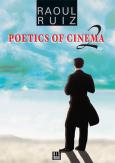
Poetics of Cinema + Narrativity
Poetics of Cinema 2 by Raoul Ruiz: “Eleven years separate these lines from the first part of my Poetics of Cinema. Meanwhile the world has changed and cinema with it. Poetics of Cinema, 1 had much of a call to arms about it. What I write today is rather more of a consolatio philosophica. However, let no one be mistaken about this, a healthy pessimism may be better than a suicidal optimism. Following his research in Poetics of Cinema, 1 on new narrative models as tools for apprehending a fast-shifting world, Raul Ruiz with Poetics of Cinema 2 makes an appeal for an entirely new way of filming, writing, and of conceiving the image. Read more >>
USA) DAP : dap[at]dapinc.com (http://www.artbook.com); (UK) Art Data: tim[at]artdata.co.uk (http://www.artdata.co.uk); (Australia) BAM: manicex[at]manic.com.au (http://www.manic.com.au); (Belgium, Luxemburg) : UD-Actes Sud: (a.raaekers[at]actes-sud.fr); (Switzerland): Servidis: commercial[at]servidis.ch (http://www.servidis.ch); (Canada) Prologue/ Lemeac: (p.st-aubin[at]lemeac.com); Other countries : CELF : celf[at]celf.fr (http://www.celf.fr/org.htm).

Narrativity: How Visual Arts, Cinema and Literature are Telling the World Today by Audet René, Romano Claude, Dreyfus Laurence, Therrien Carl, Marchal Hugues: To tackle the question of narration in its ruptures and mutations in an age of media culture and influences of videogames – where the ludic and interactive principle is an important element – is a way to draw up an inventory of the Nineties, a time when art starts to function like some kind of editing table on which the artists can recreate daily reality. Through that reflection on time, the question is to show how its new languages and new ways of writing are representative of the contemporary imaginary expressed in it and to reaffirm that the work of art is an “event” before being a monument or a mere testimony, an event which constitutes an experience drawing in the spectator. Read more >>
Posted by jo at 11:23 AM | Comments (0)
February 23, 2007
This Just In…
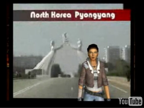
AI-Based Mashup at Seven
The work of AI-oriented Northwestern University grad students has been interesting for quite some time (1 2 3) — and here’s a new project to add to the list. Nate Nichols and Sara Owsley, in Kristian Hammond’s InfoLab, have created a system called News at Seven, that intelligently and autonomously combines news text, images and video from the Web, related commentary from the blogosphere, avatars from Half Life 2, speech synthesis, and broadcasting via YouTube, to create a daily short newscast. It’s an AI-based mashup.
Exploring the archives, I think they only recently tuned the system to create a tighter shot on the news anchor, which is a good thing. I kind of like the remote camera for their “blogosphere reporter”, a guy standing against throngs of bland voices in a snowy dystopian wasteland. (A somewhat harsh characterization of the blogosphere perhaps, and more a product of the limited number of avatars available in the Half Life 2 engine, but amusing nonetheless.)
Lots of interesting papers by this group to be found on their site. [blogged by Andrew on Grand Text Auto]
Posted by jo at 06:17 PM | Comments (0)
Experimental Gameplay: Toward a Massively Popular Scientific Practice
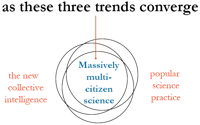
Massively multi-citizen science is almost here
Can a game developer be nominated for a Nobel Prize in one of the sciences by the year 2032? That's my plan, which I presented this past weekend at the annual meeting of the American Association for the Advancement of Science. You can download the slides from my talk, or read the related research paper (hot off the press!), or peruse some related links, on my AAAS webpage here. (Or see what Newsday took away from it here.)
My goal over the next decade is to support the development of a massively multi-citizen science through massively collaborative games (think: alternate reality games with real-world data embedded inside.) So in the near future, when the most creative, collective-intelligence gamers are grinding away 10, 20, 30, or more hours a week, they're grinding on real scientific research problems wrapped inside a yummy fictive or fantasy shell.
Yes, I am calling for a truly popular scientific research practice that engages the global public in hands-on, brains-on collaboration, via sites Citizen Science and Amazon's Mechanical Turk and through immersive, story-driven play. Amateur participation + a creative commons for science literature + the stickiness of a well-designed game and well-told story = radically interdisciplinary mash-ups accessible to lay people and productive of real scientific insight.
Sound crazy? No way. This is seriously possible, and plausible. Here's three reasons why:
1) Science practice itself is increasingly leaning toward a kind of collective intelligence, amateur participation. You can read about it in the incredible Institute for the Future report: Delta Scan: The Future of Science and Technology, 2005-2055.
2) Meanwhile, there is no doubt -- as I argue in my new 50-page case study for the MacArthur foundation -- that alternate reality gamers are doing real CI investigations that would fully prepare them for real-world collaborative research. Their gameplay is already fundamentally a CI scientific effort to undertand fake (fictive) data. I'm just proposing that we shove some real scientific data in there, while they're at it.
3) And perhaps most importantly, as Sean Stewart - the original and most esteemed alternate reality storyteller around - has famously said: "I do NOT assert that [alternate reality gaming] is the first, or greatest, example of massively multi-player collaborative investigation and problem solving. Science, as a social activity promoted by the Royal Society of Newton's day and persisting to this moment, has a long head start and a damn fine track record.... We just accidentally re-invented Science as pop culture entertainment."
So, yes, If this sounds interesting, get the slides. And here are a couple of other sites to get you thinking: "Fostering Scientific Habits of Mind in the Context of Online Play" and MacArthur Spotlight on Digital Media & Learning.
If you want to propose a data set, scientific problem, or research focus for a massively multi-citizen science game, or if you want to be notified when there's such a game to be played, email me at jane @ thenameofthisblog dot com. [bblogged by Jane on Avant Game]
Posted by jo at 06:00 PM | Comments (0)
Upgrade! Paris

Second Life
Upgrade! Paris SL :: Who: ALAIN DELLA NEGRA and KAORI KINOSHITA with MARIE LECHNER as moderator :: When: 2 march 2007 at 1 PM - PST :: Where: Michinaga-Lichty Arts Center, Han Loso (65, 31, 137), SECOND LIFE :: Live on Radio WNE.
Alain Della Negra and Kaori Kinoshita are artists, working on virtual worlds. They present their last documentary about “Second Life” univers and users. For those who wish to live in this virtual world, “Second Life” offers the chance to create, manage and develop their own alternate reality. With these kinds of possibilities, and a population that is in constant growth, “Second Life” has political ramifications. Who decides the rules applied in this virtual world? What laws, what measures need to be defined? Where is the frontier between the virtual and the real, and how is it transmuted? This documentary aims to elucidate the porous nature between real and virtual worlds.
The Upgrade! Paris sessions are organized by Incident.net. They are public and monthly. Artists, researchers, architects, theorists present during one hour their recent work. Partners: RYBN, CITU, Ars Longa, Upgrade! International.
Posted by jo at 04:26 PM | Comments (0)
Upgrade! Montreal

Rapid!Fire!
Upgrade! Montreal :: !RAPID!FIRE! SESSION! :: In the spirit of community exchange and ageless potluck, UpgradeMTL presents the first in a series of !RAPID!FIRE! sessions dedicated to presenting fresh work in the technology arts.
It's first come, first serve. The formula is simple: present, perform and show-and-tell your work; receive feedback from artists, curators, freaks & geeks. Ask questions, get answers, seek technical expertise, trade and sample concepts, files and stuff in a friendly atmosphere of collective energy. Expect socializing and cheap beer.
Presentation is organised in advance with a maximum of 4 presenters per session. Yes that is… FIRST COME FIRST SERVE to milk the public brainwaves. Each of the 4 presenters will have 15 minutes to exhibit their work, followed by questions, discussion and much merriment. There will be a projector, soundsystem and net connection. Bring your own laptop or let us know in advance if you need one.
:: PROPOSALS :: email [[ tobias @ upgradeMTL . org ]] Please include the following: name, telephone, URL, short project description (200 words max), short bio (200 words max) and a snappy title. First come, first serve.
:: LOCATION / DATE & TIME ::
March 15th, 2007 . 19H00 – 22H00
StudioXX [ http://studioxx.org ]
338 Terrasse St.Denis
(just south of Sherbrooke)
UpgradeMTL :: Rapid!Fire!:: is presented by StudioXX and hosted by tobias c. van Veen, Angela Dorrer and Kyd Campbell. Thanks to StudioXX for the space.
Posted by jo at 03:56 PM | Comments (0)
Trebor Scholz

Podcasts of my lectures on Sociable Web Media
This semester I will publish selected lectures for my Sociable Media course. Podcasting is great but it is also a bit petrifying to hear my Germano-British accent. Listening to it, I had to confront my occasional generalization but it's a rich pesentation that, I think, will be worth your while. You can subscribe to this podcast series of lectures. If you listen to it in Itunes or Jukebox you'll miss the presentation slides). Alternatively, you can download the video of the first lecture here (34 MB, 45 mins, m4B file opens in Quicktime or VLC). [posted by Trebor on collectivate.net]
Posted by jo at 08:23 AM | Comments (0)
February 22, 2007
Turbulence Spotlight
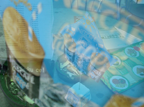
"Zeno Boundary" by Kevin Hamilton
Turbulence Spotlight: Zeno Boundary by Kevin Hamilton :: "Zeno Boundary" collects portraits of places regarded as public, created according to a prescribed photographic system. Images uploaded by contributors are dynamically animated into a looped sequence of pans and zooms through the space. The project originated in Spring 2006 as part of the Mobile Studios project, in cooperation with curators of the 13 Kubikov collective in Bratislava, Slovakia. After touring with Mobile Studios through Eastern Europe, the project continues as part of the 2007 Depauw Biennial Exhibition, in Greencastle, Indiana.
Kevin Hamilton currently teaches at the University of Illinois, Urbana-Champaign, where he is appointed to the Painting/Sculpture and New Media programs. Recent work has included co-organization of a symposium series about Walking, and the creation of interactive artworks for gallery and public settings. His scholarship includes research on manifestations of absence in contemporary and historical telecommunication technologies, and development of new methodologies for interdisciplinary collaboration. Kevin has exhibited or lectured at festivals and art institutions in Spain, Holland, Slovakia, Hungary, Canada, and the United States.
Posted by jo at 06:10 PM | Comments (0)
[iDC] Second Life and activism, etc.
![]()

Activism + Social Transmission
Second Life may or may not be overhyped, and may or may not be the future of the web, but I thought I'd share my experiences with it as I've worked on a documentary about political activism in SL. I've been surprised at how much I'm starting to appreciate its possibilities.
I've taken to heart Clay Shirky's critique that SL has been overly hyped by its creators, and I've been especially interested in Ethan Zuckerman's criticisms of a virtual Camp Darfur, which he argued is an inadequate tool for publicizing such a large scale tragedy; last May he wrote, "given that roughly 100,000 people log into Second Life in a given month - compared to roughly one billion using the Internet as a whole - I suspect people trying to call attention to global issues are better off making a website than a 3D space."
Nevertheless, many people are finding SL useful as a space for activists and organizers to model behavior and create idealized versions of things that are, in reality, broken. The folks I know best that are doing this are associated with RootsCamp, a progressive group/conference that emulates the open-source BarCamp idea of the "unconference."
Ruby Sinreich and Andrew Hoppin developed RootsCampSL, a weekly meeting in Second Life for RootsCampers. You might wonder why people would want their avatars to meet once a week when listservs, online groups, or wikis seem like suitable tools for helping us collaborate (and maybe we haven't even really figured out how to squeeze the best uses out of them yet). But as Ruby explained it at a RootsCamp conference in Washington, D.C late last year, Second Life is different even than instant messaging or IRC or wikis in that it offers embodied collaboration. Instead of getting frustrated with people talking over each other, or wondering if you or someone else is being addressed, in SL you can simply turn to an avatar and address them directly, or initiate a private chat, or walk away from the group.
A group called Doctors for Clark -- doctors who supported Wesley Clark for president in 2004 -- meets this way. They're spread all over the country so it's impossible for them to meet in the flesh, so they do the next best thing and meet in SL.
On the day the new Congress was sworn in I attended a press gathering at the Virtual Capitol Hill (it's a transparent building), and before a congressman from California swooped in (well, his avatar did) I chatted with people who really think that SL is turning into a legitimate platform for political communication and organization. Some of them were at a war protest at the same spot a few weeks later, dancing around and waving signs and typing slogans of protest and peace. It was wacky, but it was sincere.
I met a man who runs a peace and justice center at Better World Island that was one of the most moving pieces of protest art I've seen since the start of the Iraq war. The center is actually a semi-transparent, two-level house with images of children, deserted shoes, and ruins on its walls. When you touch these images you are given notecards with emails written to and received from Iraqis that the curator, Bruce Wallace, has befriended. They tell terrible stories of daily life in Baghdad, and they are personal and heartfelt. It's an art installation that moves beyond the space of Second Life and resonates strongly in the real world.
I also met a woman who runs the Center for Water Studies, also on Better World Island. The purpose of the center is to model endangered habitats to call attention to their real-world counterparts; it's actually quite beautiful and magical. The woman, who's avatar's name is Delia Lake, took me on a tour of the place and I saw moose and small animals on the ground, birds in the sky, and schools of fish in the water. She even took me for a ride on a giant Orca! The more I describe this, the crazier it sounds; I know this. It sounds crazy to me. But I think that this platform has helped me experience a certain empathy for these causes and the people behind them that I've never felt viewing standard web pages.
Although I haven't experienced it myself, I know that educators have had similar kinds of breakthroughs in SL as well. They describe being able to model behavior and situations in a way that lets students have a closer, truer experience than other mediated teaching methods allow.
I'm doing my best to maintain a healthy skepticism about it all. Is Second Life really a social platform that could eventually rival MySpace in size and outdo it in scope and influence? Is it paving the way for future apps that will change our relationships with technology and our assumptions about social media? Right now only about 40 avatars can be in any one place at any time or else the whole things crashes. Most people are there for sex or to dress up like gothic tigers or whatever. All of this serious stuff happens on the periphery and may be a passing fad. But what if it isn't?
I would love to hear about your experiences with SL -- your triumphs, failures, or complaints.
-Josh Levy
www.personaldemocracy.com
www.techpresident.com
www.levjoy.com
I've been using in Second Life for about 8 months now. I first became interested in it as one model of online relational communities with MySpace/Friendster/Facebook being another dominant style. Since then, I've been very active in it as an artist -- generating 2D prints and also a member of an 8-person performance art group called Second Front.
Overhyped or not, hard to tell. But, it holds promise in pushing new social transmission models.
Consider this: Second Life has an appeal that MySpace doesn't in that it breaks with the standard (including Web 2.0) style of online activity. These involve a passive or semi-active webspace with content that gets updated on an hourly, daily, weekly basis. Any sort of immediacy is done through IM. Old hat.
SL becomes useful in that it offers re-spatialization of activity and a feeling of presentness. The universe it creates is similar to ours in the local sense: avatars consume space; only one can be in a doorway at a time, etc. But, it also offers super-hero powers: you can fly, teleport, etc. The technology is crude and does hit huge lag points. But, intuitively, it resonates.
Creating a sense of space that we are familiar with, yet with expanded exploratory powers offers something unique. The Orca ride that Joshua talks about pushes ourselves into chance encounters that draw people into environments like Second Life.
As far as social activism, its hard to tell how this will pan out. Mass publicity is still best done through e-mails and websites. But, unique experiences that make people laugh and form deeper bonds -- this is where Second Life can excel.
Back to social transmission. One aspect of SL that I find interesting is that people create their unique avatars and after a little while, they pretty much stick with the look of their character. They develop communities and friendship networks -- places to go and things to do. But in a world where you can change skin color, gender and even species, you'd think there would be more experimentation. But, not so much.
The other transmission element is from the SL user to the non-user. I find in personal conversations that many people are fascinated by the descriptions I provide. I've demonstrated the Second Life in a couple of talks and afterwards, there are always a few who immediately sign up. Many more ask questions. Others remain skeptical. It certainly provokes a reaction.
There is something to Second Life: linked to attachment to a simulated-physical being in re-spatialized zones and the immediacy of information flow. Any sort of successful social/political activism will have to address the inherent characteristics of Second Life vs. websites, emails and more traditional forms of fundraising and awareness.
~ Scott Kildall
website: http://www.kildall.com
Second Front blog: http://slfront.blogspot.com
More proof I suppose that secondlife is the model T of virtual space. Not as fast or slick as some of the other options available... clearly not as good on gas. (Although I note that the KWH comparison was made against a worldwide average and not the average of someone who is currently using said computer and has the financial support to purchase broadband.)
But this model T is making it so that every (well connected and video encarded) computer user can, for most I would guess just once or twice, go in and consume some '3D' space. I'm also interested by the Wii talk, and with the motion sensor controller (the first of many no doubt) it does offer the chance to meld first and second life as it were.
The issue with many of the critiques that i've seen of our model T is that they criticize the first real success of a new way of doing things for having all the failings of a trailblazer.
Yes. It is bloated. It runs on too much power. The interface and designs are limited. It is run by a company which profits (one would assume) from running the environment. It slows down, depending on who you talk to somewhere in between 15,000 and 38,000 concurrent users. It's proprietary. The things created inside are not portable. All true.
But it does win at being first to come to the public domain. It's allowing people like me to apply for research grants that are going to explore how to interface 2D and 3D digital domains. (if you'll pardon the expression) We are going to take some students in and see what they do... It's a project that no one would have funded for me in Croquet. No matter how good that particular dream promises to be.
I'm not sure what the value of 'virtual space' will be pedagogically. In the interim its greatest value is allowing us to try out a few ideas, to get some funding and some leeway to poke our noses in. To talk to some people about their experiences. To help, perhaps, in the development of the next generation of 3D spaces, by contributing what we've learned.
I wonder, finally, if there is a research group that is accepting educational research from virtual space already out there... if not... I'd be more than willing to start one.
cheers. dave.
Very Interesting conversation...
As a researcher, teacher, (and until yesterday - just a hiatus) an art center administrator in SL, I have the following reflections:
I think that SL is part success, part Ponzi scheme. If you read the Official Guide, there is pretty exaggerated optimism across the board, and it is inherent across the media, website, etc. Linden has done a great job of evangelism.
This is not to say that, phenomenologically speaking, that SL is not a significant moment in net society. In many ways, SL mimics the early Web and art community the early Rhizome list, with a fairly tight-knit bunch of early adopters (I have had an account for 4 years, but only active on since November). There are interesting possibilities going on out there, and whether it is lasting isn't really mo concern. The fact that SL has hit a Gladwellian Tipping Point is important itself.
As one of the co-founders of the Second Front (of which Scott is as well) performance group, we have been doing very interesting things with gestalt, happenings, and identity manipulation. The tension between people and their avatars is something amazing to look at and manipulate. In many ways, I feel very Duchampian about recontextualizing my own identity in terms of avatar and location. It's very strange that at one moment, I'm talking to people like Alan Sondheim and folks connected to groups like General Idea, and then on the next breath, you have a horny newbie soccer mom who is asking for a quick romp in the hay. Really surreal.
As an educator, I think that I like to stick closer to things that SL is especially good at, like Machinima, spatial narrative, algorithmic experiments. Although I am learning a lot of new tools, like scripted podiums and viewscreens, the thing that I think has the most potential are things like live videocasts, avatar performance, streaming audio, and external links. In this way, I think that people do get a better haptic feel for 3D space, and once you get the hang, it's really intuitive. I do think having a concurrent distance environment can be really useful, but there is no way I want to have a solely SL-based classroom.
Overall, I think that SL has mastered the micropayment, has integrated scripting, animation, real-time navigation, and so on in a way that has gotten compelling enough in its open-endedness to make it really robust. The thing that I wonder about is why it took off and not There.com or AlphaWorlds - perhaps toolset. And although Second Front members first met in places like The Palace and OnLive Traveller years ago (therefore not the 'first' of its kind, even if you consider There) SL is at a convergence point, and is at the right time, with a robust enough set of tools, seamless economics (that get a little too ubiquitous at times), and a really compelling social component.
Two major beefs with SL are that it can be an immense money/time sink, and that I feel like the time dilation in-world is pretty toxic. What I mean is that a week feels like a month - so much tends to happen. I went in to talk to a friend one night, and she chided me that I had not said hello for weeks, when it had been 5 days. Secondly, people tend to want you to IM Immediately, and if you're buying property, doing a performance, we need to do it tonight, tomorrow or the next day - next month is unthinkable. It creates an environment in which the virtual world takes increasing parity with the physical, and I personally do not want to sit in front of a monitor all my nights chatting - keyboarding day and night is just not healthy. It promotes the Partial Attention problem, and further chains us to our chairs.
I want to go bicycling once in a while.
Therefore, SL has a great set of tools, an amazing PR campaign, but the big argument I have with any 'early adopter' story like mine is that I have found that we keep hoping that the next technology will solve our problems. I feel like technology often begets more technology and although it has true use value, it's still the human equation that makes the difference.
Activism? As far as dissemination of info, in a multi-modal way, SL can be incredibly compelling. Possibly, due to its current visibility, it could be a tactical media tool (the National Front has a zone, o_0 ). But as far as activism is concerned, I think that feet-on-pavement is still superior to just about everything. To say that we're going to be terribly effective on a fairly elite private net with fairly specific technical and educational requirements leaves that project rather circumspect - more so than protestors negotiating with the police in DC about where they could protest. I feel like protest in SL is too much in the Fishbowl.
The real power of it is when it starts bleeding out into RL. That might seem like a contraditction from my last sentence, but I'm already seeing memes pop out here and there.
I'll leave it at that.
Off to RL-heavy New Orleans for the weekend.
Welcome to the crash zone.
Patrick Lichty
- Interactive Arts & Media
Columbia College, Chicago
- Editor-In-Chief
Intelligent Agent Magazine
http://www.intelligentagent.com
Dear Colleagues, the following event might be of interest to you:
Massively Multi-Learner , 22 March, 2007
Location: University of Paisley, Paisley
http://www.ics.heacademy.ac.uk/events/displayevent.php?id=142
Growing numbers of people now spend large parts of their leisure time inhabiting immersive on-line 3D virtual worlds, known variously as MMOs (Massively Multiplay Online), MMORPGs (MMO Role-Playing Games) and MUVEs (Multi-User Virtual Environments).
A growing number of academics and practitioners are realising that such environments also have strong potential as the Virtual Learning Environments of the future. This workshop aims to showcase the emerging theory and practice of teaching and learning in MUVEs - from studies of how users engage socially in virtual worlds to practice based case-studies of teaching and knowledge transfer and the emergent pedagogies of the 3D internet, and its relation to the web-based learning technologies of the present.
The role of learning within guilds
Carl Potts, University of Salford
The significance of community within MMORPGs. I share the view of Mulligan and Patrovsky that 'players come for the game and stay for the community'. My talk will explain briefly how players are organised with these communities using World of Warcraft as an example. It will focus on the role of learning and dissemination of knowledge within these communities, and potential for the development of transferable skills.
Putting the Real in surreal - How scientific simulations can be used in a
virtual world
Mike Reddy, University of Wales, Newport
This presentation is not about how to reproduce the real experience of f2f or campus based learning. Rather, this discussion is about how to use situated simulations as a teaching tool in a wide variety of scientific disciplines: Games development students are using Second Life as an adaptable prototyping tool for 1st/3rd person games; Design students are engaging in product trials and aesthetic design, such as wearble technology; Science students are attempting to recreate scientifically plausible scenarios, such as our Nasa CoLab sponsored Mars terraforming simulation, Project Aria. The aim of this and future work is to enable students to get their virtual hands dirty. Building is the best way to learn.
Programming Playground
Mike Hobbs, Anglia Ruskin University
The explicit aim is to get second year computing students to design and implement interactive artefacts in Second Life to demonstrate simple programming concepts for use by novice programmers. The hidden agenda is to kindle a sense of discovery, ownership and fun in a subject that can seem abstract and remote.
Integrating Second Life into Design for Digital Media
Annabeth Robinson, Leeds College of Art and Design
How second life can help to directly support or simulate art / design progression of skills and profesionalism throughtout a 3 year degree program. Annabeth will also discuss virtual worlds from her perspective as a practicing artist in Second Life.
Developing visions of schome (the education system for the Information Age)
Peter Twining, Open University
Peter will briefly explain what schome is (not school - not home - schome - the education system for the Information Age), before going on to outline why and how we are using Second Life to enhance our thinking about schome. See http://www.schome.ac.uk/ for further info.
Virtual Learning Environments and Virtual Worlds: The Sloodle Project
Jeremy Kemp, San Jose State University
As mainstream educators slowly get to grips with the enhanced potential of using web-based virtual learning environment, others are forging ahead with 3D virtual environment. This presentation will outline where the web-based environments provide support for learning that may be lacking in richer 3D environment - and introduce the Sloodle project which aims to integrate the web-based and the 3D virtual learning environments.
Social Networking in Virtual Worlds
Aleks Krotoski, University of Surrey
Much has been made about the marketing potential of social networks in virtual worlds (the popularity of branded advertising in Second Life attests to that), yet how do participants learn from one another in casual and social contexts in online environments? This presentation explores what it means to be "close" in a dis-proximate space, and how the ethics of analysis must take into consideration the meanings of networks in these conceptual places.
Integrating Games Based Learning into the Classroom
Helen Routledge, TPLD
This session presents a case study on the educational game EDUTEAMS and shares Routledge's experiences of integrating the software into class times of 50-minutes or less with the effect of delivering understandable bit size chunks and visible learning gains among pupils as well as how the games are assessed by teachers along national curriculum guidelines. Both the pupil and teacher perspective will be discussed as well as the essential elements required to make effective use of games in the education system and the benefits of TPLD's approach. The ideal scenario will be explored and real life examples presented from schools around the UK that used this methodology.
Knowledge Transfer and Public Engagement in Virtual Worlds
Dave Taylor, National Physical Laboratory
Dave has been working on the use of Second Life for Scientific Communication and Technology Knowledge Transfer. He will describe Second Life's three emerging Knowledge-based continents: Info Islands, NMC Virtual Worlds and the SciLands where NPL are one of the founder members. He will also examine the extraordinary effectiveness of Second Life for facilitating collaboration between small and large organisations and the general public, and the benefits for technological knowledge transfer between researchers and industry.
You can find information about travel and accommodation at the following
link: http://cis.paisley.ac.uk/livi-ci0/paisley-travel.html
Dr Andy Miah | email[at]andymiah.net | http://www.andymiah.net
Reader in New Media & Bioethics
School of Media, Language & Music
University of Paisley
Ayr Campus, KA8 OSR, Scotland, UK.
[t] +44 7962 716 616 [f] +44 1292 886371 [e] email[at]andymiah.net
The Second Life (SL) buzz sounds just like the tech-salvation propaganda that surrounded the telegraph, the BBS, and later mailing lists. Rheingold and Lessig gave lectures in SL, 70 universities built a "campus" on the island, non-profits are storming in, businesses are opening up, avatars are exchanging "real life books" in SL, people set up galleries (but where is the audience?), performance groups do their thing, and avatars demonstrate against the war. It's a stunning social experiment.
But not for a second do I buy the argument that synchronous virtual worlds like Second Life are the future of the net. Nevertheless, I'm quite interested in SL as a model for civic participation and cultural production. Environments like Second Life are one emerging aspect of networked sociality and I am curious to hear more about the amateurs who, on the proprietary grounds of SecondLife, are willing to give their immaterial labor away for free. We discussed that before with Amazon.com.
The always amazing Henry Jenkins writes: "I take my good news where I can find it and for the moment, the coverage of SL, bad though it often is, is helping Americans in general adjust to the idea that there may be something positive to be gained by having an active fantasy life on line." But SL is not just an all-American phenomenon. Just look at attempts of re-branding Africa, for example. There are, of course, obvious limits to the use of such environments in developing countries as it takes high-powered computers and a whole lot of bandwidth to have a decent experience in SL.
Particular examples of participatory culture may fade but networked participation will not go away.
Jenkins: "And for the moment, the debate about and the hype surrounding SL is keeping alive the idea that we might design and inhabit our own worlds and construct our own culture. That's something worth defending."
My main question to Jenkins and all of you concerns the relationship between this virtual world and "first life." Do these virtual worlds merely provide an inconvenient youth with a valve to live their fantasies of social change (elsewhere), or do they, in some measurable way, fertilize politics in the world beyond the screen?
Trebor
Second Life
http://secondlife.com/
Get A First Life
http://www.getafirstlife.com/
Teaching experiments in SL
http://www.cnn.com/2006/TECH/11/13/second.life.university/index.html
A Western shot in SL
http://bellsandspurs.com/_video/
"More than 70 universities have built island campuses in Second Life"
http://news.com.com/2100-1032_3-6157088.html
Lynn Hershman screens new film in SL
http://lynnhershman.com/newprojects.htm
Avatars Against the War
http://lotusmedia.org/post-protest-processing
Re-branding Africa in SL
http://annansi.com/blog/2007/01/africas-second-life/
Images of Activism in SL
http://www.flickr.com/photos/venicevandal/sets/72157594474252794/
from giselle beiguelman:
But not for a second do I buy the argument that synchronous virtual worlds like Second Life are the future of the net.
I agree. Nevertheless is a very interesting art space. SL has a curious cybrid format. I mean a space between on and off line networks that can be used as new layer of our territorial experience. I'm working now on a new project conceived for SL, exploring its potential as a cinematic space and the resources its inhabitants can use in order to get different points of view (flying, zooming etc).
It seems to me that the cinematic experience you have there announces in some ways what can be the the migration from machines of motion to machines of vision, or the new cinema. Peter Weibel wrote some years ago a long essay on digital images that could be a point of departure for that discussion:
"The nineteenth century was obsessed with motion - with illusions of motion, and with machines of motion. There were two kinds of machines of motion: the first tried to analyze motion, the second to synthesize motion. The analysis of motion was the task of the camera; the synthesis of motion was the task of the projector. The evolution of cinema in the nineteenth century can be attributed to two major trends: firstly, to the progress in experimental physiology and psychology leading to the Gestalt psychology, and secondly, to the advances in machines attempting to adapt and transfer the physiological mechanism of perception into machines capable of the visual simulation of motion and - herein lies the problem - not into machines of perception.
Therefore, what we know as cinema today is in fact already a reduction of the nineteenth-century principle that began to investigate machines of vision, but finally reduced them to machines of motion. There is the moving-image industry with its motion pictures, that is to say: the Hollywood system. Its code is a legacy of the nineteenth century, and reduces the initial exploration of machines of vision to machines of motion. Only the avant-garde cinema of the 1920s, 1950s and 1960s maintained the original intention of creating machines of vision. Classical cinema, therefore, already diminished the initial enterprise, which was about perception. Perception was reduced to the perception of motion, and remained on the retinal level because there was no pursuit of the question of how our brain perceives the world. People constructed machines with a kind of graphic notation - "la methode graphique" (Etienne-Jules Marey) - of motion. This method can be said to be still valid, tragically enough, today.
What Marey did was to analyze, and deconstruct, motion with his famous graphical method. It made no difference whether a drawing machine was used or, as in the case of Eadweard Muybridge, a photographic machine. Both Muybridge and Marey soon realized that it is not enough to analyze motion, but many other machines had to be used in order to project, to synthesize, motion. We may conclude this interpretation with the fact that cinema was invented in the nineteenth century. The twentieth century merely turned the nineteenth-century inventions into standardized mass media - including television, which became a consumer apparatus. As a side-effect, we simultaneously turned this machinery not only into mass media, but also into art, an individual approach.
Cinema is a writing of motion (cinematography); it is just a machine that simulates motion for the eye. The avant-garde, from Dziga Vertov to Steina and Woody Vasulka , kept to the initial idea: machine vision - not machine motion. Vertov gave us the term Kinoglaz , the camera eye. With the advent of video (Latin: I see), it was clear that we had to make a paradigmatic shift from imitating and simulating motion to imitating and simulating vision with the help of machines. We had to change from cinematography (the writing of motion) to what I would call the writing of seeing: opsigraphy, from the Greek word opsis (as in "optics"). Or even to opsiscopy, the seeing of seeing - in other words, the observing of observing mechanisms. In cyberspace, for example, when you see yourself and your actions as an image, you are already in opsiscopic space. You are observing yourself in a picture that you observe; it is an observation of the second order. In fact, cyberspace is the beginning of opsiscopy: of machines that see how we see."
In short, I think SL can be considered an opsiscopic space that allows to transcend sometimes the basic descriptive movements we do in our FL (First Life) and because of this points to new directions in the digital arts field in general and digital images in particular.
giselle beiguelman
from Steven Shaviro:
This past week, I gave a brief-talk-plus-demonstration at my University, to an audience much of which was librarians, about the educational potentials of Second Life. I painted a picture that was not untrue, but that perhaps was rosier than is fully justified. As the real-life audience in an auditorium watched it all on a big screen, I conducted a lively but quite short discussion with a bunch of folks within Second Life about how new media were changing both what was being studied and learned, and how it was being studied and learned. People in both the RL audience and the virtual audience seemed to like it; though in the former case this was probably more due to the wow! factor than to anything I (or anybody else) actually said (or typed).
I only bring this up by way of approaching Trebor's question: Do these virtual worlds merely provide an inconvenient youth with a valve to live their fantasies of social change (elsewhere), or do they, in some measurable way, fertilize politics in the world beyond the screen?
I think that we are reaching the point where people can do pretty much any of the things they do in their "first lives" in virtual worlds like Second Life as well. This is not to say that the two are the same, of course; there are obvious and vast differences (e.g., people in different physical locations can engage in real-time interaction in Second Life, and have the sensation of a sort of shared 3D space -- though it's cartoony, it still gives a certain feeling of 'thereness' that other media, even more naturalistic ones like two-way video chat, fail to do; on the other hand, and just as obviously, a conversation in Second Life is likely to consist mostly of one-liners, rather than the extended essayistic reflection we can indulge in on a mailing list like this one; not to mention that the anonymity, combined with the ability to simulate actions that you could never do in "real life" contribute to a kind of puerile and feverish fantasy atmosphere).
But still, overall, Second Life is connected enough to "first life," and mirrors it closely enough in all sorts of ways, that we can pretty much do "there" the same sorts of things -- especially collaborative, social things -- that we do "here." The virtual libraries in Second Life, for instance, are quite interesting and might even, at some point, become truly useful (though of course, a lot less people use them than use the SL sex clubs or combat simulations). Some of the artist exhibitions in Second Life, as well as some of the spaces which are themselves, in effect, art works, are quite good and worth exploring.
As for politics: a protest against the Iraq war in Second Life is little more than an empty symbolic gesture; but one might cynically argue, especially given the tendency of the media to ignore them, that real-world protests against the war , however many people they draw, are at this point little more than empty symbolic gestures either.
On the other hand, I don't think that one could find any equivalent in Second Life of political organizing that takes place in "first life": if only because the people in Second Life are a fairly narrow, self-selected and affluent, group.
But beyond this, the thing that really gets me about Second Life, and that seems to me to be the most important thing one can say about it, is how *commodified* the whole experience is, and how SL is dominated by notions of creativity, coolness, entrepreneurship, and so on... all of which relate undamentally to advertising and commerce and making money. It seems to me that Second Life, and other MMOs (massively multiplayer online worlds or games) need to be understood in the terms of political economy (of an at least quasi-marxist sort) before they can be made sense of in any other way. And that, in this sense, they are little different from any other aspect of what has variously been called the society of the spectacle, the network society, or the new world order of neoliberal globalization.
Yes, the new media are many-to-many instead of one-to-many like the mass media that dominated most of the twentieth century; but I fear that the call or incitement to participate, to get involved, to be creative, largely means that we are being asked to be entrepreneurs of ourselves, and thus work ever harder to facilitate our own exploitation.
I am being rather hyperbolic, perhaps. But if anyone is interested, I've put online a recent essay of mine in which I address these points in (hopefully) less of an off-the-cuff manner:
http://www.shaviro.com/Othertexts/MMOs.pdf
S
Steven Shaviro
http://www.shaviro.com
THE PINOCCHIO THEORY:
http://www.shaviro.com/Blog/
from Charlie Gere:
Trebor
I think your invocation of previous new media hype in relation to SL is very timely, and your question about whether it is a safety valve for fantasies of social change most pertinent. But I think the problem of academic hype about SL is even worse than you suggest and seems to be encapsulated by the statement from Henry Jenkins you quoted to the effect that "... for the moment, the debate about and the hype surrounding SL is keeping alive the idea that we might design and inhabit our own worlds and construct our own culture. That's something worth defending."
To be honest I don't see why. It would seem to me obvious that trying to make some sense of and find ways of mitigating the violence and unjustice in the complex world and culture we already necessarily inhabit, not least bodily, is far more pressing and considerably more worth defending than any supposed capacity to 'design and inhabit our own worlds and construct our own culture'. This seems to me to be at best a license for mass solipsism and at worse something like the kind of thinking that undergirds much totalitarianism, as well as an evasion of our responsibilities to the world as we find it. Such a fantasy seems to be at play in both the relentless construction and assertion of 'identity', a drive that militates against proper social solidarity, and thus plays into the hands of those sustaining the status quo, as well as the fantasy entertained by the Bush government that the Middle East can just be redesigned as if in some video game
Apart from anything culture is not something that can simply be constructed. It is something we are thrown into and which we can only at best try to negotiate our relationship with. Culture necessarily involves other people and prior existing structures. Has Jenkins considered what it would mean if everyone felt free to 'construct their own culture'. Even if such a thing were possible, it is certainly not desirable, especially if we have any hope to produce a properly participatory culture.
Frankly as far as I am concerned SL is really just a kind of cultural pornography, and is to the real business of culture what masturbating is to sex with another person. I like masturbation as much as the next man, or indeed woman, but I don't make the error of mistaking for something it isn't. Apart from anything else it lacks precisely the element that sex has, that of involving a proper, embodied, responsibility to someone else and to the potential consequences of the act itself.
Charlie Gere
From A. G-C:
On the Second Life, I would want to say four things:
1. The question is not to know what it is worth "symbolically" but the influx and the variety which compete as ubiquitous society to it indeed deserve to ask questions from fields such as: ergonomics, simulation, digital sociology, languages (linguistics and semiotics).
2. Nevertheless, the second critical point, without going to the psychology either in the sociology, or in the languages, is simply the question of the real time because the time all the contrary of the space, is not double, it is barely unit (on earth). The time spent by playing an executive simulation of the life, raises a true problem of entropy of fictitious time in the material life; And thus results a lack of time to face the material conditions of the life, except for the persons among whom it is the job or the position to navigate and to create on Internet.
It defines an expert frame of the researchers, not the release to the empirical research (what is the only available way of research more the help of the stochastic disposition into our randomized actual times -- that one being reinvented by the researchers of exact sciences with impact in the
life): it is thus even there a dissolution of the democracy including of meta politics (according to which the agreed fact would be that the fantastical passage to the playful virtual act would be an increased reality
-- that is not sure in matter of power). The only very power in such a game can being who know the tech languages and observe the digital abstract tracks.
3. It is maybe interesting that left the communications censored on Internet can hide in such a device, under the shape of a feigned community which does not look like the one who hides under these features, or then economic observers for the study of markets?
Why not also secret services, for example - and blow: who observes as fake player or fake artist? Who thinks that he/she is anonymous under his mask? Otherwise the one who puts a lot in an addictive way.
4. There is a macro phenomenon which succeeds the micro computing diverse multiples (addition of singularities) on internet, it contribute in the big hypermedia supra community as MySpace, YouTube, etc... (But I mean may be any of us of have still evocate it).
Here the Second life, exactly the set which as game corresponds to Google earth increasing MySpace in a plastic second reality in real time, as the representative identification of techno-mass - exactly something as real from the active part of the real players through their personal computers as a mass in a dynamic stadium as large as possible - till the increasing worlds -, interactive hypermedia as techno-multiculturalism in mobility (here multiculturalism is to be hear as virtual genre) online.
From Ricardo Dominguez:
Virtual terror strikes Second Life
by Glenn Chapman Sat Feb 24, 11:54 AM ET
SAN FRANCISCO (AFP) - In an explosive display, virtual-world banes now mirror the havoc of the real one as terrorists have launched a bombing campaign in Second Life.
People controlling animated avatar members of a self-proclaimed Second Life Liberation Army (SLLA) have set off computer-code versions of atomic bombs at virtual world stores in the past six months -- with their own manifesto.
The SLLA claims to be an "in-world military wing of a national liberation movement" devoted to replacing the rule of Second Life creator Linden Labs with a democracy representing the nearly four million residents.
"As Linden Labs is functioning as an authoritarian government the only appropriate response is to fight," the SLLA said in a message on its website at http://secondlla.googlepages.com.
"When the SLLA succeeds in its aims it will disband and hand power back to the political wing of the movement."
Creative dissent is welcomed in Second Life as long as it doesn't interfere with the ability of other residents to enjoy the virtual world, according to San Francisco-based Linden.
Second Life said it stopped charging a tax on items created by residents after avatars fashioned in the images of American revolutionaries recreated the Boston Tea Party in the virtual world about three years ago.
Since then, website users adept at manipulating computer codes have engineered mischief including a "push gun" that blasted other avatars back when fired, according to Linden.
"We do the utmost to ensure the protection of creative expression, within certain bounds," Linden marketing director Catherine Smith told AFP on Friday.
"Ultimately, instances in which residents engage in simulated violence will have to be taken on a case-by-case basis."
The virtual bomb blasts in Second Life explode in hazy white balls, blotting out portions of a screen and battering nearby avatars, animated figures that are residents' proxies in the virtual world.
The disruptions are brief and do not cause lasting damage in Second Life, according to Linden.
Residents are given free rein in Second Life, as long as they don't harass or interfere with other avatars in what is referred to in-world as "griefing."
SLLA bombings have been viewed by Linden as "mock terrorism" done in fun to catalyze debate about the in-world power structure.
"We believe recent events involving SLLA protest lack malicious intent," Smith said. "Resident reaction to such attacks has been decidedly tongue-in-cheek."
The SLLA website demands that Linden give Second Life residents "basic rights" by going public and allowing each avatar to buy a share of stock at a set price.
In instances where residents feel harassed by the SLLA, Linden will dole out temporary banishment or other such penalties as outlined in the virtual world's written terms of service, according to Smith.
iDC -- mailing list of the Institute for Distributed Creativity iDC[at]bbs.thing.net http://mailman.thing.net/cgi-bin/mailman/listinfo/idc
List Archive:
http://mailman.thing.net/pipermail/idc/
Posted by jo at 03:56 PM | Comments (0)
February 21, 2007
Networked Proximity - Section 5
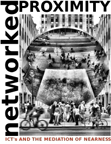
Networks and Social Change
The third of Mills’ criteria specified the necessity to transform opinions into action even against, if necessary, the prevailing system of authority. Although a thorough examination of the relationship between technology, agency, power and social change is beyond the scope of this study, I would like to make some general observations regarding the potential for using networks to promote social change. This attempt is relevant because if, as Mills (1956) suggests, a mass cannot really claim the agency to contest the prevailing authority, then to the extent that networked ICT’s are said to transform publics into masses, they can be said to stand in the way of authentic social change.
At the center of this issue are the ways in which networks in capitalist societies commodify social participation. Borgmann (2004), for instance, rightly points out that commodification is the distinguishing feature of the online social interactions that networks make possible. "To commodify something economically is to pull something that is outside of the market into the market" (p. 64), or in other words, to transform things with no monetary value into things with monetary value —or commodities— through their subordination to the logic of capitalism. Borgmann suggests that the commodification of the social happens when a social practice is taken out of its localized context and offered in a re-packaged format online. Thus, chatting becomes online chatting, dating become online dating, etc. Borgmann attempts to establish that networked sociality robs communities of their original meaning and commodify the cultural production of social space:
The Internet is culturally commodifying by its nature. It frees us from the limitations of space and time... What happens in fact is that commodification reduces ourselves and those we encounter on the Internet to glamorous and attractive personae. Commodification becomes self-commodification, but shorn of context, engagement and obligation, of our achievements and failures, of our friends and enemies, of all the features that time has engraved on our faces and bodies—without all that we lack gravity and density. (p. 64)
Continue reading "Networked Proximity - Section 5" » [blogged by ulises on ideant]
Posted by jo at 04:02 PM | Comments (0)
Guerrilla Lighting
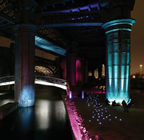
Switched ON London
Graffiti Writing to Guerrilla Lighting, yes it seems everyones a rebel these days, even the director of BDP lighting, Martin Luptn who has assembled a crack team of local lighting designers, architects, interior designers and manufacturers, all of whom are keen to draw attention to the possibilities, and importance of, lighting in the urban environment.
Under the guidance of a team leader, each member will take part in creating transient lighting designs by using high powered torches, battery powered LED projectors, luminous dot lights and an array of gels and filters. Instructed to be in a specific position and at a given distance from their target, the teams will simultaneously light up various aspects of the Pool of London’s architecture on cue at the sound of an air horn, creating a dramatic spectacle. The installation will photographed, the lighting turned off and then the team move on to the next site. It has been organised as part of Switched ON London which is a seven night celebration of the relationship between light, architecture and the city consisting of temporary lighting installations and a series of light related events with an overall concept theme of ‘theatre’. London’s first festival of light is currently running from the 8th to the 16th February. More details on the other installations to come… [blogged by Ruairi on Interactive Architecture dot Org] Related >>
Posted by jo at 02:15 PM | Comments (0)
SplineGraft - Krets
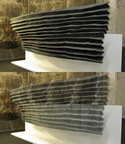
Controlled by a Genetic Algorithm
The SplineGraft project sets up a reactive environment in which sound dampening panels are continuously reshaped by a network of actuating devices, triggered by user movement. The panels are grafted into an existing environment, supported by structural racks allowing a range of different configurations. The SplineGraft can be set in different overall shapes independent of its behavior. The different parts are grafted onto each other; the profiled polyurethane panels are articulated by the configuration of the structural racks. The texture of this primary form is reshaped in real time by the control system integrated in the structural racks; a continuous form finding process with emergent patterning effects. In return, the spline ridges of the panels disperse these transformations horizontally.

Structure
The supporting structural racks are assembled from cnc-milled clear acrylic units, each integrating the actuating mechanisms, milled tracks for cabling and etched nickel brass conduits for inter-unit connectivity. The angle between each structural component can be set in five different positions, allowing the rack to be set at a convex or concave configuration, while maintaining conductive links between each part. Each rack of five units is controlled by a micro controller, steering the integrated actuators in the form of dual shape memory alloy wires. The central intelligence of each rack communicates with neighboring racks through radio.

SplineGraft behavior
The behaviour of the SplineGraft is controlled by a genetic algorithm; a computer program that simulates and compresses the geologically slow processes of natural selection to nanoseconds of computational time, in order to evolve solutions to specific problems. The Spline Graft algorithm is in this way trying to emit patterns of movement which stimulate occupation of the space it has been grafted in to. The matching of sensor readings and motor reactions in an apparently intentional way by the Spline Graft, transforms architecture into a cybernetic agent involved in the making and production of space.

SplineGraft materials
CNC-milled acrylic structural components with integrated wiring, machined polyurethane foam, etched nickel brass conductors, IR Movement Sensor, custom made PCB Cards, AVR Atmega8 Microcontrollers, Radio Modules, diverse electronic components, Flexinol® shape memory alloy actuators with protective Teflon tubes. SplineGraft was developed by Krets partners Pablo Miranda and Jonas Runberger. A full list of credits are available on the project website.
My thanks to Chris aka Pixelsumo for the tip. [blogged by Ruairi on Interactive Architecture dot Org]
Posted by jo at 12:51 PM | Comments (0)
Pamphlet
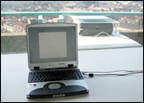
Instant Public Print
The need for physical print could be said to be 'instinctual'. In fact how paper can still trigger our inner instinct to read is at the core of the 'Pamphlet' installation by Helmut Smits. It consists of a laptop, software and a printer placed on the edge of a building window. People can type a message on the laptop. By pressing the "˜send' button a pamphlet is printed and dropped from the 10th floor by the printer. The falling down paper and the resulting 'pamphlet' on the street symbolizes the relatively short distance from the personal production to the public enjoyment of a printed product, and how the traditional product parameters has been disrupted. The fascination of take-away paper is the same at the base of newspapers that are starting to stretch their role and nature with downloadable and printable last minute editions. These are highly customized on one key factor: the updating time. They are meant to be read offline, so enjoyed with a relative calm, but with the most stretched and feverish time of production. This is part of a larger need: to put the virtually and real-time produced content out of the screen to affect real life or be enjoyed in it." - Neural.
Posted by jo at 12:22 PM | Comments (0)
Evasions of Power Conference

Architecture, Literature and Geo-Politics
Slought Foundation: Evasions of Power Conference :: Philadelphia :: March 30-31, 2007 :: Poster (PDF) :: Brochure (PDF)
"Evasions of Power" is a series of events exploring the relations between architecture, literature and geo-politics. Departing from the usual academic convention of presenting knowledge in the form of straightforward talks or presentations, this project will include a series of roundtable discussions, debates and interventions of varying duration, with an integrated online presence.
These events reveal an array of understanding about the consequences and implications of "spatial practice" today, with presentations by distinguished artists, architects, theorists, and curators whose work explores urban zones, state borders, enclaves, and extra-territorial sites throughout the world. The conference will explore the following questions: how are questions of politics, conflict, and human rights articulated today in fields such as architecture and literary study? How is power theorized? How is power evaded? How can institutions aspire not just to accumulate power but also to evade power and certain forms of authority? What practices and forms might such an institution occupy, invent or build?
The "Evasions of Power" project contributes to an ongoing discourse about human rights, war, extra-territoriality, and political and social enclaves. "Evasions of Power" continues these efforts and will be of interest to scholars and practitioners in fields ranging from art, literature, and political philosophy, to architecture, design, and urban studies.
The proceedings have been jointly organized by Srdjan Jovanovic Weiss, Aaron Levy, and Katherine Carl, on behalf of Slought Foundation and the Department of Architecture, Penn School of Design, in conjunction with the Centre for Architecture Research, Goldsmiths College, London, the Department of Art History, University of Pennsylvania, the Department of English, University of Pennsylvania, and Eastern State Penitentiary historic site and museum, Philadelphia. Major support for Evasions of Power has been provided by the Graham Foundation for Advanced Studies in the Fine Arts.
Posted by jo at 11:17 AM | Comments (0)
Vectors: Journal of Culture and Technology in a Dynamic Vernacular

Perception
Vectors: Journal of Culture and Technology in a Dynamic Vernacular is pleased to announce the launch of its Winter 2007 issue devoted to the theme of Perception.
Our fourth issue of Vectors examines the sensory, phenomenological, and epistemological stakes of perception at different moments of history and in varied geographies, paying special attention to the cultural, ethical and ideological stakes of what, how, and when we perceive. Featured scholars include Sharon Daniel, Eric Faden, Anne Friedberg, Perry Hoberman, Donald Hoffman, Caren Kaplan, Laura Marks, and Trevor Paglen. Vectors is produced by editors Tara McPherson and Steve Anderson, co-creative directors Erik Loyer and Raegan Kelly, and programmer Craig Dietrich.
Vectors is an international peer-reviewed electronic journal dedicated to expanding the potentials of academic publication via emergent and transitional media. Vectors brings together visionary scholars with cutting-edge designers and technologists to propose a thorough rethinking of the dynamic relationship of form to content in academic research, focusing on the ways technology shapes, transforms and reconfigures social and cultural relations. We only publish works that exceed the boundaries of print.
Posted by jo at 10:52 AM | Comments (0)
MonkeyBook
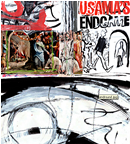
The work of Alex Itin at Monkeytown
The Institute for the Future of the Book presents: The work of Alex Itin -- at Monkeytown: An evening of motion pictures on four big screens, plus delicious food and drink, celebrating 2 years on the world wide web at IT IN place (and Flickr, Vimeo, YouTube....) :: Wednesday, February 28th, 7:30pm seating :: $10 minimum.
Since 2001 Brooklyn painter Alex Itin has been exploring what it means to be an artist in the age of digital reproduction. Working first on digital books integrating painting, audio and video, Itin moved onto the Web in February '05 at IT IN place as artist-in-residence at the Institute for the Future of the Book. Here he began to explore mixed media in a networked context. Work of the past two years combines blazing low-res images of paintings and drawings with text, photographs, short films, video quotations, animated GIFs and audio mashups -- all within the constraints of the scroll-like form of a blog. In his second year, Itin began to explore new trails out of the blog, establishing a presence on social media sites like Flickr, YouTube, Vimeo and MySpace. Through these networked rovings Itin has found a larger audience for his work, attracting new readers back to IT IN place where the media fragments are reassembled.
Recently, Itin has been organizing "The Library," a collaborative project bringing together dozens of artists from online social media communities, particularly Flickr and Vimeo. In the project (a sort of exquisite corpse-Ray Johnson exercise) one artist takes a physical book and in some way alters it. They then send it by email to another artist in the network who, in turn, completes the work and mails it back. Images of these collaborative works are posted in a gallery on Flickr and often showcased on IT IN place. To celebrate its second anniversary, IT IN place will relaunch on February 28th with a spruced up design and an innovative new graphical interface to its by-now enormous archives -- a feature that will unlock the vault of stellar work Itin has produced over the past two years.
Monkeytown:
58 N 3rd St
(btw. Kent & Wythe)
Williamsburg, Brooklyn 11211
Directions:
From the L Train:
1. Exit at the Bedford stop (the 1st stop in Brooklyn).
2. Walk 4 blocks south on Bedford,
3. Make a right on N. 3rd St. (west)
4. Walk an additional 2 and 1/2 (west) on N 3rd. Monkey Town is halfway down the block on the left.
!!Reservations a must!! http://www.monkeytownhq.com/reservations.html phone: 718.384.1369
Posted by jo at 10:50 AM | Comments (0)
Mapping the City
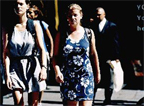
flâneur + dérive
Mapping the City :: 16 February – 20 May 2007 :: Stedelijk Museum CS, Post CS Building, 2nd floor, Oosterdokskade 5, 1011 AD Amsterdam, NL :: Tel. +31 (0)20 5732.911 :: Participating artists: Doug Aitken, Francis Alÿs, Stanley Brouwn, Matthew Buckingham, Philip Lorca diCorcia, Guy Debord/Asger Jorn, Ed van der Elsken, Valie Export, Lee Friedlander, Dan Graham, Frank Hesse, Douglas Huebler, William Klein, Saul Leiter, Sol LeWitt, Sarah Morris, Bill Owens, Martha Rosler, Ed Ruscha, Willem de Ridder en Wim T. Schippers, Beat Streuli, Jeff Wall.
‘Mapping the City’ focuses on the relationship between artists and the city from around 1960 to the present day. The group show revolves around the way in which artists perceive urban space. The emphasis is on the city as social community, on behaviour, poses, and urban rituals.
Two ideas are at the heart of the exhibition: the flâneur, a type first described by Charles Baudelaire around 1850, and the activity of dérive, a practice coined by Situationist Guy Debord. The exhibition begins in the late nineteen-fifties when Debord published his Theorie de la dérive (1958). Another jumping-off point is Stanley Brouwn’s famous series This way Brouwn. Starting in 1962, Brouwn started asking random passers-by for directions in getting from point A to point B. He gave each route that people drew for him the title This way Brouwn.
From the late nineteen-sixties and early nineteen-seventies onwards, many artists adopted the city as their workspace. Similar to Brouwn, themes such as walking through the city, chance, and grappling with our everyday environment are also integral to the work of Douglas Huebler. Others, like Martha Rosler, subject the metropolis to critical scrutiny. In her piece The Bowery in Two Inadequate Descriptive Systems Rosler employs photography and text to analyze the underbelly of New York society. For Austrian artist VALIE EXPORT, the city was ‘still a male space’. With her Tapp- and Touch Cinema (1968), she invited the viewer to a 'tactile experience that is the reverse of inauthentic voyeurism'.
Another theme in the exhibition is ‘street photography’. From the nineteen-fifties onwards, photographers like Ed van der Elsken, William Klein and Saul Leiter, injected post-war photography with a freshness and immediacy. For instance, Klein’s unpolished, experimental style caused quite a furore and inspired a generation of young photographers. His photo diary of New York figured people, children, parades, litter and an aggressive, alien, lonely urban landscape cluttered with raucous billboards.
Contemporary art
The core of Francis Alÿs' activities revolves around the many walks he has taken through the centre of Mexico City since the early nineteen-nineties. Alÿs’ Collection of Ephemera includes numerous drawings, photos, notes, maps and objects that relate to his walks in the ten-block radius around his studio in the historic centre of Mexico City.
The Heads of Philip Lorca diCorcia and the street scenes by Beat Streuli can be seen as contemporary variants of classic street photography. Their photographs capture the manifestly vacant expressions on the faces of anonymous passers-by.
A biography of Florida’s sun-drenched capital, Sarah Morris’ video work Miami presents the city’s various facets as the hub of the tourist industry, drug and illegal immigrant trafficking on a more or less equal footing. The film installation A Man of the Crowd by Matthew Buckingham is based on the similarly-titled short story by Edgar Allan Poe. The result is a tense mini-thriller set in the streets of Vienna. The video piece by Doug Aitken, Electric Earth, is pervaded by a powerful sense of estrangement. This overwhelming video installation projected onto eight huge screens confronts us with the modern city as though it were the remains of an alien civilization.
Posted by jo at 10:48 AM | Comments (0)
VICTORIA VESNA
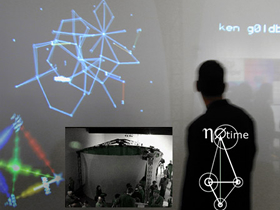
Interview
"Victoria Vesna (1959, Washington D.C. ) is an artist, a lecturer, and the chair of the Department of Design | Media Arts at UCLA, School of the Arts and Architecture . Her work can be defined as experimental creative research that resides between disciplines and technologies. Since the ‘80s she has been exploring digital and virtual worlds and the relationship between art and science.
New realities are generated by the meeting among artistic, humanistic and technological disciplines. Victoria Vesna is also the Director of the brand new UCLA Art|Sci Center and of the UC Digital Arts Research Network . She realized 16 personal works, she exposed hundreds of collectives, she published more than 20 researches and she has been participating in various conventions for years. She has an extremely strong and dynamic but also rigorous and creative personality. Her research is mainly aimed at exploring the relationship between art and science in an innovative and appealing way.
Victoria Vesna always works with researchers, artists and scientists. She recently collaborated with the scientist James Gimsewski ( Feynman Prize in nanotechnology in 1997, Physics Institute Duddell Prize in 2001, elective member of the Royal Academy of Engineering) with outstanding outcomes.
Silvia Scaravaggi: I would like to point most on what are your project nowadays and the way you are working on them. Talking about your recent activity on art-science and nanotech, how you and James Gimsewski started your collaboration? Why did you choose to go deep inside this matter?
Victoria Vesna: In 2001, I was co-organizing a conference called “From Networks to Nanosystems” with my colleagues from the UC Digital Arts Research Network ( UC DARnet ). Each campus had one lead person who was in charge of creating special interest panels – I organized a panel of Nanotech and Culture. My interest stemmed from studying natural systems and form, more specifically the work of Buckminster Fuller . Through that exploration, I came to find out about the discovery of the third carbon molecule, the buckminsterfullerene, or buckyball. I read a fascinating article by Donald Ingber about certain patterns reappearing in natural systems and the tensegrity systems where this molecule was brought up again. Then I found out that the microscopes they use to study molecules are not optical but “feel” the surface and then translate the data to image. This, in addition to the idea of building ‘bottom up' rather than ‘top down' is revolutionary and I found it very exciting." Continue reading VICTORIA VESNA'S INTERACTIVE EXPERIENCE by Silvia Scaravaggi, DigiMag.
Posted by jo at 10:24 AM | Comments (0)
Natural Car Alarms
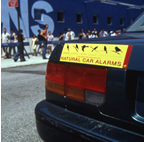
A Chaotic, jungle-y effect
Natural Car Alarms--by Nina Katchadourian--is a project consisting of three cars rigged with modified car alarms whose typical six-tone siren has been replaced with a similar one made only of bird calls. Some of the bird sounds are shockingly electronic in character; others are very bird-like in the quality of their sound, but very alarm-like in their patterning. While on an artist's residency at Caribbean Contemporary Arts in Trinidad during summer of 2001, I decided to travel to a small coastal town called Grand Riviere for a few days. This place was known for its natural beauty and wildlife, including giant leatherback turtles that came up onto the beaches there to lay their eggs during a brief window every year. Trinidad hosts an incredible variety of plant and animal life, and is particularly well known as a bird watcher's paradise.
During my time in Grand Riviere I decided to spend an afternoon hiking with a local guide who took me far up into a remote mountainous area in the rainforest. We climbed up narrow mountain paths into areas thick with vegetation that surrounded and disoriented me. It was an environment unlike any I had ever been in before. Stopping to take a breather on the way down the mountain, I suddenly heard a very familiar noise in the midst of all unfamiliar natural surroundings: a car alarm. I stood listening to it for a few moments before things snapped back into context and I realized that this sound couldn't possibly be a car alarm. It was in fact a bird.
I'm a great believer in misunderstandings as fruitful starting points for art works. Moments of confusion can be incredibly expansive mental spaces, where you hover in a kind of vastness, trying to extend this state as long as possible until some clue provides context, or some bit of information anchors you once again to what's actually going on, delineating and determining what you should be understanding about things. Most people have had the experience of sleeping in an unfamiliar place and for a moment having no idea where you are when you wake up. Standing there in the rainforest was a bit like this: I tried to stay with both interpretations of that sound for as long as I could, but I also made a mental note to remember the error for later.
In Spring 2002, SculptureCenter was finishing renovations on their new exhibition space in Long Island City and wanted to commission a work that didn't need a roof over its head. I proposed a project called Natural Car Alarms: a flock of three cars, each outfitted with a different car alarm modeled on the ubiquitous six-tone siren so common in New York City cars. Although they would behave just like the real thing, the alarms would all be composed of bird sounds.
I contacted the Macauley Library of Natural Sounds at the Cornell Lab of Ornithology. They were known for having a vast archive of animal sounds, and agreed to work with me on the project. I sent them a recording of a car alarm from a screaming car on my street one day, and they set about finding bird calls that roughly matched those sounds. A few weeks later, I had a CD in hand with 33 different birds on it and I set to work to edit the sound.
Each car had a different alarm soundtrack, and each alarm had six different birds, so there were 18 birds involved in all. The choices were tough. I wanted to find a good balance of sounds that were both shockingly alarm-like but also distinctly still bird-like in their quality. Almost as important as matching the sounds was finding a patterning that mimicked the swooping cries and punctuated honks of the familiar six-tone siren. They also needed to be as loud, intrusive, obnoxious and surprising as the real thing. Ideally, I wanted to replicate some of the ambiguity I had experienced in the forest, where the urban and the natural were suddenly very continuous. Car alarms were after all a completely natural part of the Long Island City landscape where the piece would be shown.
The piece was shown at several locations during the summer and fall: MoMA QNS, PS1, Socrates Sculpture Park, and Sculpture Center, where the flock came home to roost at SculptureCenter's opening of their new space. In each case, the cars were parked adjacent to one another and left there for the day. The alarms ran on timers, not synchronized to another in any particular way. There were moments were one car was screaming and another would seem to respond a few minutes later, and occasional moments when all three cars would go off at once — a completely chaotic, jungle-y effect.
Posted by jo at 09:45 AM | Comments (0)
February 20, 2007
The Wreckers:
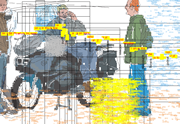
public looting becomes public art
The Wreckers: public looting becomes public art (that loots the Internet): The Wreckers, by Daev Miller, is an online tool that pulls (or loots) RSS feeds and user comments from the Internet into a computer script, mixes them together, splits them up and converts into shapes and lines. The more user comments entered, the richer the work becomes. Miller's own illustrations are pulled into this mix, and finally the computer script outputs a drawing. This computer output is what he'd describe as a collaborative debate 'mashup' drawing. People's thoughts and arguments are turned into almost random patterns, with just little hints of meaning. Like a conversation out of earshot.
The core of Miller's work is illustrated stories: satirical and socio-political - using traditional media as well as online and networked media. His works aim to exploit the online medium, especially: collaborative, networked, computer generated. The Wreckers is a progression of his past recent works which integrate networked data into stories and illustrations.
Please see Miler's blog for further details of his work. email: dave.miller.uk[at]gmail.com. Related 1, 2.
Posted by jo at 03:56 PM | Comments (0)
Botanicalls

The Plants Have Your Number
A small group of plants in a building in New York City is quietly exchanging information. Botanicalls--a project of a team of four students at the ITP program at NYU--allows thirsty plants to place phone calls for human help. When a plant on the botanicalls network needs a lot or a little water, it can call a human and ask for exactly what it needs. When humans phone the plants, the plants orient callers to their habits and characteristics, including how they like to be watered and cared for. Call 212.202.8348 to hear more about each of the plants.
Botanicalls opens a new channel of communication between plants and humans, in an effort to promote successful inter-species cohabitation and understanding. How? Plants call people about their needs. People can call the plants to understand them better. The project originally spawned from completely non-technical conversations about indoor container gardening and the air-filtration qualities of common houseplants. Our concern about bringing plants into the ITP community was their chance of survival-- high-paced technologists seldom have time to stop and smell the flowers, let alone water them. 'But, what if,' we wondered, 'the plants could call us and tell us what they needed when they needed it? If they assigned us tasks, would this alters or engages us,' and the project was born.
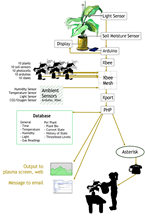
The Botanicalls project is fundamentally about communication between plants and people. We are empowering both by inventing new avenues of interaction. Plants that might otherwise be neglected are given the ability to call people and request assistance. People who are unsure of their ability to effectively care for growing things are given visual and aural clues.
The goals of this project:
1. Keep the plants alive through an interdependent relationship with co-habiting humans by translating the communication protocols of the plants (leaf habit, color of foliage, droop, etc) to more common human communication protocols (email, voice phone calls, digital visualizations, etc). More than keeping individual plants alive, we want to keep the system and project alive.
2. Make a connection between people and plants. Explore/enhance/create/visualize people's emotional connection to plants, the ways plants help humans, how caring for a shared resource can create sense of community, how natural life is a valuable counterpoint to our technical environment.
3. Gather data, create a complex and dynamic network, documentation for do-it-yourself style propagation of the project, record process. [via]
Posted by jo at 02:54 PM | Comments (0)
Now Art Grant

Call for Applications
Artists creating work that engages dialogue about current social issues will receive grant funds (minimum $500), three months mentorship by damali ayo, a second mentor who has specific experience in the project field, and the exposure to ayo's mailing list of over 3000 people.
Now Art holds that the primary role and responsibility of art is to mirror the dilemmas of society to its citizens, offering a catalyst for change and development; evolves as society evolves; values the artist's use of a wide range of media; integrates contemporary and emerging technologies; prizes the power of individuals to effect change, discarding divisions between personal and political; honors and engages the work of its predecessors, recognizing that art builds upon art.
Now Art Grants combine the small donations of many individuals and make these available to artists whose work creates art that catalyzes social change. These artists often work with no pay and slim budgets because the activist nature of their work is often dismissed as "not fine art" or because art remains devalued as a viable career choice by society. Members of the damali ayo and now art mailing lists donate any amount they choose to the grant pool. This money is combined and granted to artists who show their commitment to social change through their work.
The art created by Now Art Grants will have a component that is delivered directly to those who have donated the grant funds as a direct return of the funders' investment.
To be chosen to receive a Now Art Grant, the artist/art must:
* Take place outside of a gallery or limited-access space.
* Engage a wide audience in a dialogue about a current social issue.
* Have a component that delivers an aspect of the art directly to those who have funded it.
* Show ability to fully accomplish the proposed project over six months.
* The artist will be rigorously researched by the Now Art selection committee so that artists will not be required to spend critical art time writing extensive applications or budgets.
Projects can be created specifically for this grant money or can already be in process, as long as they are completed within the six month time frame. Money can be used for any aspect of the project including artist fees. Mentoring helps to assure the success of the project. Artists should send their project ideas and a short bio to nowart[at]damaliayo.com.
Grants will be made on a rolling basis. All artists who sign up on ayo's "now artists" mailing list at damaliayo.com or myspace.com/nowartists artists will receive regular information about various grants and support for artists engaged in social change.
Make a donation, ask a question, join the mailing list and apply by contacting nowart[at]damaliayo.com
Now Art is a mentality that art must be current, accessible and an agent of dialogue and social change. Many members of my audiences expressed frustration that they could not see my work, as it was housed in a gallery in one city often out of reach. I agreed. I dropped my art gallery and have devoted myself to creating art that provides accessibility, impact, and ways for individuals to participate and experience the work.
Now Art is immediate, accessible, participatory, low-cost, and deals with current issues that we face as a community/society. When you participate you create a dynamic moment- something that happens in the "now" and hopefully generates a cascade of thought and change for the future. I will send you concepts, instructions and sometimes even a full kit to enact each work. Your collaboration is what makes it work. Let's make art together. We're really going to have some fun. Sign up >>
Posted by jo at 02:08 PM | Comments (0)
The Next Layer or:
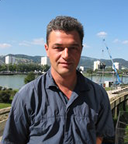
The Emergence of Open Source Culture
The Next Layer or: The Emergence of Open Source Culture :: Draft text for Pixelache publication, Armin Medosch, London/Vienna 2006-2007
First we had media art. In the early days of electronic and digital culture media art was an important way of considering relationships between society and technology, suggesting new practices and cultural techniques. It served as an outlet for the critique of the dark side of computer culture's roots in the military-industrial complex; and it suggested numerous utopian and beautiful ways of engagement with technology, new types of interactivity, sensuous interfaces, participative media practices, for instance. However, the more critical, egalitarian and participative branches of media art tended to be overshadowed by the advocacy of a high-tech and high-art version of it. This high-media art conceptually merged postmodern media theories with the techno-imaginary from computersciences and new wave cybernetics. Uncritical towards capitalisms embrace of technology as provider of economic growth and a weirdly paradoxical notion of progress, high-media art was successful in institutionalizing itself and finding the support of the elites but drew a lot of criticism from other quarters of society. It stuck to the notion of the artist as a solitary genius who creates works of art which exist in an economy of scarcity and for which intellectual ownership rights are declared.
In the course of the 1990ies media art was superseded by what I call The Next Layer or, for help of better words, Open Source Culture. I am not claiming that the hackers who are the key protagonists of Open Source Culture are the new media artists. Such a claim would be rubbish as their work, their ways of working and how it is referenced is distinct from media art. I simply say that media art has become much less relevant through the emergence of The Next Layer. In the Next Layer many more protagonists come together than in the more narrowly defined field of media art. It is much less elitist and it is not based on exclusivity but on inclusion and collaboration. Instead of relying on ownership of ideas and control of intellectual property Open Source Culture is testing the limits if a new egalitarian and collaborative culture.
In the following paragraphs I would like to map out some of the key components of Open Source Culture. It has been made possible by the rise of Free, Libre and Open Source Software. Yet Open Source Culture is about much more than just writing software. Like any real culture it is based on shared values and a community of people.
Open Source Culture is about creating new things, be they software, artefacts or social platforms. It therefore embraces the values inherent to any craft and it cherishes the understanding and mastery of the materials and the production processes involved. Going beyond craftmanship and being 'open source', it advocates free access to the means of production (instead of just "ownership" of them). Creativity is not just about work but about playfulness, experimentation and the joy of sharing. In Open Source Culture everybody has the chance to create immaterial and material things, express themselves, learn, teach, hear and be heard.
Open Source Culture is not a tired version of enforced collectivism and old fashioned speculations about the 'death of authorship'. It is not a culture where the individual vanishes but where the individual remains visible and is credited as a contributor to a production process which can encompass one, a few or literally thousands of contributors.
Fundamental to Open Source Culture's value system is the belief that knowledge should be in the public domain. What is generally known by humans should be available to all humans so that society as a whole can prosper. For most parts and whereever possible, this culture is based on a gift economy. Each one gets richer by donating their work to a growing pool of publicly available things. This is not a misguided form of altruism but more like a beneficial selfishness. Engaged in a sort of friendly competition everyone is pushing the whole thing forward a bit by trying to do something that is better, faster, more beuatiful or imaginative. Open Source Culture is a culture of conversation and as such based on multiple dialogues on different layers of language, code and artefacts. But the key point is that the organisation of labour is based on the self-motivated activity of many individuals and not on managerial hierarchies and 'shareholder value'.
Open Source Culture got a big push forward with the emergence of Linux and the Internet but we shouldn't forget that it has much deeper roots. History didn't start with Richard Stallmans problems with a printer driver. The historic roots could be seen as going back to the free and independent minded revolutionary artists and artisans in 19th century. More recently, it is based on post-World-War-II grassroots anti-imperialist liberation movements, on bottom-up self-organised culture of the new political movements of the 1960ies and 1970ies such as the African American civil rights movements, feminisim, lesbian, gay, queer and transgender movements, on the first and second wave of hacker culture, punk and the DIY culture, squatter movements, and the left-wing of critical art and media art practices.
In terms of the political economy, Open Source Culture could mark an important point of departure, by liberating the development of new technologies from being dictated by capital. The decision of what should be developed for which social goals is taken by the developers themselves. Technological development is not driven by greed but by deep intrinsic motivations to create things and to be recognized for ones contribution. Despite that, Open Source Culture is not an anti-capitalist ideology per se but has the potential to change capitalism from within and is already doing so.
Open Source Culture needs to be constantly aware of capitalisms propensity to adapt, adopt, co-opt and subjugate progressive movements and ideas to its own goals. The 'digital revolution' was already stolen once by the right-wing libertarians from Wired and their republican allies such as Newt Gingrich and the posse of American cyber-gurus from George Gilder to Nicholas Negroponte. More recently adept Open Source Capitalists have used terms such as Web 2.0 and social software to disguise the fact that what those terms are said to describe has emerged from open source culture and the net culture of the 1990ies and the early 2000s. Once more the creativity of the digital masses is exploited by alliances between new and old tycoons. The Next Layer emerges at a time when capitalism is stronger than ever before and it emerges at the very heart of it. This is the beauty of it. It cannot be described in a language of mainstream and underground. Open Source Culture is the new mainstream which is what capitalist media are doing their best to hide, scared by the spectre of communism as well as commonism. We don't need to ressort to the language of the Cold War and its dichotomies, howver.
The Next Layer contains not only a promise but also a threat. It emerges at a time when the means of suppression and control have been increased by rightwing leaders who try to scare us into believing we were engaged in an endless 'war on terror'. With their tactics they have managed to speed up the creation of a technological infrastructure for a society of control. The general thrust of technological development is coming from inside a paranoiac mindset. 25 years of neo-liberalism in the American lead empire have degraded civil liberties and human values. The education system has been turned into a sausage factory where engineers are turned out who construct their own digital panopticons. Scary new nano- and bio-technologies are created in secret laboratories by Big Science. And the bourgeioise intelligentsia meanwhile has stood still and does not recognize the world any more but still controls theatres, publishing and universities. In this situation it is better if Open Source Culture is not recognized as a political movement. The Next Layer will find ways of growing and expanding stealthily by filling the niches, nooks and crannies of a structurally militant and imperialist repressive regime from which, given time, it will emerge like a clear spring at the bottom of a murky glacier.
* The Next Layer is a book project by Armin Medosch about Open Source Culture. It has been supported by Franz Xaver and the Medienkunstlabor Graz in 2006. Passages of this text are informed by an extensive study into free software hackers and open source activists. Materials will be released in due time at http://theoriebild.ung.at/
Armin,
Interesting text. The formulation of a high art version of media art is particularly relevant at the current moment, as more and more media artists are trying to cross over into the commercial art world, getting gallerists and selling their work as commodities.
While I understand your critical view of "high art", I wonder if you have considered an economic model for artists to survive without some form of commodification. While Open Source is clearly a viable and attractive model, most of its proponents live from other means of income or are supported by academic institutions. At the moment, many media artists are reliant on the media art "ghetto" of publicly funded festivals, but it rarely pays enough to support a family or plan a long life.
I do find it ironic that one has to subscribe to the construction of value through scarcity, when the digital object is by its nature infinitely reproducible. But if value cannot be constructed, how are artists supposed to pay their rent without taking "real" jobs? Even if YouTube etc. should find a licensing model for paying authors for their work, I doubt it will put food on the table for most artists.
Or should your text be read as saying that the role of "artist" is simply redundant , in favor of a more egalitarian model of "culture producers" not depending on institutions for support?
-marius [posted on SPECTRE]
FROM NETTIME: http://www.nettime.org
Kimberly De Vries wrote:
<...>
Well, give how poorly American students are (allegedly) doing in science, maybe this threat has a limited future, in the US, that is. But I wonder, if remaining unrecognized is so important, wouldn't it be better not to draw attention with articles like this? I hope this doesn't sound like heckling, but in fact large corporations and also some political groups have really gone after people/companies/groups they saw as threats. Should we actually behave in a more conspiratorial way in order to protect the Open Source movement? Anyway, it sounds interesting. When do you expect it to be finished and released?
Thanks,
Kim
<...>
From: Armin Medosch:
Hi Kimberley
thanks for your your detailed feedback. this text is a draft and some phrases or sentences are not as well considered as others. I definitely dont want to sound paranoid because I am not. Maybe I get carried away a bit rethorically at the end but I dont really see the need to 'hide' the political content. what I try to say, the beauty is, it happens anyway, even if it is not being seen as that.
From a European point of view I dont think there are political witchhunts for people in academia going on, not yet at least. But what does the job pretty well of weeding out the baddies, the not so ideologically well adjusted, are 'self selecting' economic measures. ma courses closed down for low student numbers, cuts, etc. it is one of the ironies particularly here in Britain that much talkied about values of education get systematically undermined by the way the system is constructed.
The intended book will still take a while. This text is an attempt of getting a meta-view, away from the detail. I have made interviews with free software developers and artists and I will make them accessible on the theoriebild.ung.at wiki, at least in excerpts, slowly and bit by bit, cause its lots of work to edit them into some consumable shape.
regards
Armin
From: kanarinka:
[...]
I am reading an interesting book ("From Counterculture to Cyberculture: Stewart Brand, the Whole Earth Network and the Rise of Digital Utopianism") which is not line with what you are saying above and goes against the commonly held assumption that "capitalism" commodified an otherwise pure cultural force. The author Fred Turner tracks how computer technology became "liberating" and how digital utopianism was always hand-in-hand with various forces: corporate, market-driven, scientific, and institutional. He also shows how Wired came out of leftist libertarian New Communalist politics and long practices (on the part of Stewart Brand) of creating networked spaces of social utopianism, discussion and exchange between various actors.
From: Alexander Galloway
[...]
Thanks for this interesting polemic. First a minor point: can you please qualify the "we" in "First 'we' had media art"? Who is the we? One can only assume that by "we" you mean happy-go-lucky nettimers? The sorts of people who attend net art conferences? Lefty westerns in Euramerica who hand out Ubuntu disks on the street? I think I know who you mean, but some precision in your clarion call would be helpful.
A more thorny problem however is this question of "the new." This strikes me as inadequate for any progressive polemic today. If you maintain this position, fine, but you will have to make your peace with a number of formidable socio-political critiques that have emerged in recent years. I'm speaking of the growing list of authors and critics who recognize that "the new" is precisely the location of exploitation and valorization in today's economy, not an escape from it.
Armin's post recalls the German romantic poet Friedrich Schiller who in 1795 in his "On the Aesthetic Education of Man" put forward a notion of play as integral to human evolution and liberation. But by the early twentieth century, Adorno is on record critiquing this position: "Playful forms are without exception forms of repetition," wrote Adorno in his "Aesthetic Theory." "In art, play is from the outset disciplinary [and] art allies itself with unfreedom in the specific character of play. [...] The element of repetition in play is the afterimage of unfree labor" (pp. 317-318).
The work of Pierre Bourdieu would also undermine your position. There are certainly reasons to be skeptical of his work, but one must admit that Bourdieusian theory essentially scuttles any notion that intellectuals or knowledge workers are "creating" and working in communities free from capitalization and exchange. Bourdieu's pseudo-deterministic "fields" of cultural production indicate that there are indeed new modes of capital that exist entirely within the superstructure.
Similarly, Alan Liu's "The Laws of Cool" would also cast doubt on your claims. While I find his reading of digital art unsatisfying, his assessment of knowledge work and capitalist cultures of creativity is excellent. In my view it's the best book on the subject, at least the best one that doesn't treat creativity and "the new" as simply a question of political economy (as someone like Manuel Castells does). For Liu it is entirely a question of aesthetics and cultural production. Liu also does the extremely valuable task of providing an overview and critique of recent management theory. This body of literature--exemplified by Tom Peter's 1992 book "Liberation Management"--also casts doubt on your credo due to its explicit endorsement of "chaos," "flexibility," "change," "innovation," "diversity," "the next" as central virtues of the new economy. The management consultants know that creativity is highly valorizable. In my view this mode has been hegemonic in the economy since the 1990s, and central but not yet dominant since the 1970s. (The work of Hardt and Negri on immaterial labor is also important here, but this material is likely more familiar to nettimers.) Technology-wise, Google, Flickr, Myspace, youTube, del.icio.us, etc. are all examples of what you call "playfulness, experimentation and the joy of sharing," but I hope we can admit that all these are at the same time extremely shrewd new models for production and exploitation. (Example: Google makes money based on lots of very small amounts of unpaid "creative" labor performed by billions of web users. This is what exploitation looks like under
post-Fordism.)
Additionally, there are a number of people in art history who suspect the uninterrogated category of "the new." I'm thinking of Rosalind Krauss' "The Originality of the Avant-Garde" and Peter Burger's "Theory of the Avant-Garde."
But on the other hand, there are a number who agree with you about the essentially liberatory and progressive nature of "the new." Derrida and others from the '68 generation would be important figures here. But in the contemporary debate, McKenzie Wark's book "A Hacker Manifesto" might be the best endorsement of the resistive and progressive nature of "the new." In his view, hackers are those who "produce new concepts, new perceptions, new sensations, hacked out of raw data" (p. 2). Wark's work is extremely evocative in general, yet this point is problematic for the reasons hinted at above.
Perhaps it might help to divide the rhetoric of your piece between (1) creativity, play, and the new, and (2) the gift, the public domain. The second group of terms strike me as still fundamentally corrosive for capitalist valorization (even if capitalism might still rely on "common" entities like protocols or natural resources to grow and prosper). Furthermore, I think you can make your same argument, while avoiding pie-in-the-sky proclamations about the miraculous advent of "the new" or the liberatory potential of the knowledge labor of the creative classes.
Finally, in this age of dotcom boosterism, I'm surprised you selected a phrase like "The Next Layer" to describe your project. This sounds more like a Vista service pack, no?
... with warm regards from the evil empire,
- -ag
From: Kimberly De Vries
Hey Armin,
I don't mean you should hide it, but maybe mention/document some examples when you talk about various covert deals made between groups--just claiming they exist won't convince a reader who doesn't already agree, and I assume you would like to persuade them.
I think in the US, at least, people are sometimes so reluctant to believe these things that you have practically club them over the head with evidence.
[...]
I think that is a problem in the US as well, especially since educations has been underfunded since probably the 70s--perhaps not coincidentally the point at which it was most closely allied to civil rights and anti-war movements.
And now in Arizona, a state-level House committee has approved legislation that would ban any public school educator or college professor from advocating for or against a political candidate in class, or advocating for a social, political, or cultural issue that is part of a partisan debate. If this passes, I can't imagine what they will talk about or write about in History class, or composition, or really any of them. I guess we can all just switch to multiple choice tests.
[...]
Perhaps you should make that aim explicit and say more about how it will help? I'll be interested to see the interviews. How many people have you spoken or will you speak to?
Best,
Kim
From: Kimberly De Vries
Armin,
Sorry for being unclear earlier. I was thinking of passages like this:
"The 'digital revolution' was already stolen once by the right-wing libertarians from Wired and their republican allies such as Newt Gingrich and the posse of American cyber-gurus from George Gilder to Nicholas Negroponte. "
And this:
"The education system has been turned into a sausage factory where engineers are turned out who construct their own digital panopticons. Scary new
nano- and bio-technologies are created in secret laboratories by Big Science."
In the US, some people will nod in agreement when reading this, but by no means all, and probably most people would question many assumptions implicit in these statements.
I personally agree that coding really can't help but be political, given the current debate about copyrights and IP, etc. (among other things) and also with your ultimate proposal that the cocoa coop and hack-lab should unite. I am just pointing out that some of these underlying assumptions will probably provoke considerable resistance in some readers. You might persuade more of them if you unpack those genral statements a bit and offer some concrete examples.
Best,
Kim
Posted by jo at 02:01 PM | Comments (0)
ACM Multimedia 2007
![]()
CALL FOR ENTRIES AND PAPERS
ACM Multimedia 2007: Interactive Art Program :: 23-29 September, Augsburg, Germany :: CALL FOR EXHIBITION ENTRIES AND PAPERS :: ACM Multimedia 2007 is the premier annual multimedia conference, covering all aspects of multimedia computing. The ACM MM Interactive Art Program seeks to bring together the arts and multimedia communities to create the stage to explore, discuss, and push the limits for the advancement of both multimedia technology through the arts, and the arts through multimedia technology.
This fourth version of the Interactive Art Program will consist of an art exhibition and a conference track. We invite artists working with digital media and researchers in technical areas to submit their original contributions to the following tracks:
1. Multimedia art exhibition: I / Other / Group :: We seek artworks that use multimedia to explore issues of self-exploration, self-presentation towards another, the self in a group or the group as a self. We particularly seek interactive multimedia works that by combining multiple media, technologies, and novel technical ideas, realize strong artistic concepts that give a new perspective on the topic of the exhibition. Deadline for submission to the Art Exhibition: May 8, 2007 ::
2. Conference track: we solicit papers describing interactive multimedia artworks, tools, applications, and technical approaches for creative uses of multimedia content and technology as well as technical approaches for the management of art-related media collections. Emphasis will be given to novel works that use a rich variety of media and those that are interactive, particularly works that exploit non-conventional human-computer interfaces or sensors in new and emerging areas. We strongly encourage papers with a strong technical content written by artists. Papers may be long (10 pages) or short (2 to 4 pages). Long papers are presented in front of an audience and short papers are presented in poster format. Deadline for full papers to the Arts Program Conference Track: May 8, 2007. Deadline for short papers to the Arts Program Conference Track: June 1, 2007.
Accepted papers and art works will be published in the ACM Multimedia Conference proceedings.
Important Dates
May 8, 2007 Long papers and art exhibitions submission deadline.
June 1, 2007 Short papers submission deadline.
June 20, 2007 Authors notification.
July 20, 2007 Camera-ready papers due.
Program Chairs
Alejandro Jaimes, IDIAP Research Institute , Switzerland
(Alex.Jaimes[at]idiap.ch)
Frank Nack, University; Claude Bernard Lyon 1, France
(frank.nack[at]liris.cnrs.fr)
Thomas Rist, FH Augsburg, Germany (tr[at]rz.fh-augsburg.de)
Curatorial Committee
Annet Decker, Montevideo, Amsterdam
Anne Nigten, V2_, Institute for the Unstable Media, Rotterdam
Prof. Robert Rose, time based media, Faculty of Design, Augsburg
University of Applied Sciences, Augsburg
Posted by jo at 09:00 AM | Comments (0)
Upgrade! New York

Jillian Mcdonald + Jamie O'shea
Upgrade! New York: Jillian Mcdonald and Jamie O'shea :: Eyebeam, 540-548 west 21st street (bet 10 & 11 Ave) :: Thursday, February 22, 7:30 PM.
Famous for "Me and Billy Bob," Jillian McDonald will present old and new work which focuses on the subcultures that drive the celebrity and horror film industries. She'll show a DVD, some quicktime files, a data-driven web project, and more dvd.
Jamie O'Shea will perform an extraordinarily efficient art experience. An entire performance, narrated by Corey Sullivan, will take place within 1/5 of a second. Jamie's automated memory process will create an indelible, and effortless, impression of this instant. Jamie writes:
"This Thursday, at 8:22:22 on 2/22, we will be presenting a 1/5th of a second performance, perhaps the most efficient art experience currently available. The automated memory process will be narrated by Corey Sullivan, and take place precisely on time in reference to the official U.S. time for the Eastern time zone. We guarantee that your memory of this instant will be indelible and effortless."
Upgrade! is an international network of gatherings concerning art + tech + community. Eyebeam supports the creation, presentation and analysis of new forms of innovative cultural production. Founded in 1997, Eyebeam is dedicated to exposing broad and diverse audiences to new technologies and media arts, while simultaneously establishing and demonstrating new media as a significant genre.
Posted by jo at 08:56 AM | Comments (0)
THE THIRD MIND PROJECT
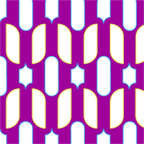
Call for Audio and Visual Art
THE THIRD MIND PROJECT :: A number of devices exist that stimulate the mind of the user by visual and audio signals. The fundamental principle applied to each is that a particular train of visual and aural pulses leads to different states of mind. These states include, for example, deep relaxation, heightened creativity and heightened awareness. Often, the aim of the device is to allow users to learn faster or relax deeper, but artists have extended the experience with such device into the realm of art. The Dream Machine, conceived in the early sixties by Brion Gysin, is a mechanical device that is viewed with eyes closed as it rotates at 12 HZ around a light source located inside it. The light, coming against the eyelids as the device rotates, effortlessly produces a relaxed state of mind. This occurs, because the optical nerve is stimulated and alters the brain's electrical oscillations. Gysin referred to the effect as "interior visions" and in his words the effect of the Dream Machine can be described as a projection of dazzling lights and celestially colored images whirling around inside one’s own head.
CALL VISUAL
The Digital Art Weeks 2007 (DAW07) invites Visual and to submit their work to the theme of the Digital Mandala. For the "refit" of the Dream Machine for the 21st Century, Visual Artists are asked to submit static or animated images in the form of "Digital-Mandalas" that are relevant in content and effect to the theme of "inner visions". The Digital-Mandalas will be projected on to the walls of the gallery space and will be dynamically synchronized to the 12 HZ flickering frequency of the Dream Machine. This flickering is then used to drive computer programs that will subtly modulate attributes of the image dynamically to gently arouse news states of mind. In this manner the inner visions of the Dream Machine become outer visions within the installation.
CALL AUDIO
The Digital Art Weeks 2007 (DAW07) invites Audio Artists to submit their work to the theme of "Today’s Ohm: The 60 HZ Hum". Audio Artists are asked to submit works of approximately ten minutes or so in length in .aif format that are relevant in content and effect to the theme of "the 60hz hum is the electronic ohm of our times". Submitted works will be projected into the space using a stereoscopic loudspeaker system from the company StereoLith® of Switzerland. The play back of the submitted works, although thought and experienced as independent works themselves, will naturally enhance the psychedelic effects of the Dreammachine environment further. Note: The submitted images and audio works will be presented in an installation type situation in which the public may experience using the dream machine up close and afar during the Closing Event of the festival. All artists will be listed in the program.
DEADLINE: Friday, 2nd March 2007. Notification of acceptance of proposals will be sent out on or before Friday, 2nd April 2007. For more information regarding the call please write to: daw-perfs[at]inf.ethz.ch
Posted by jo at 08:55 AM | Comments (0)
WIRED MADNESS
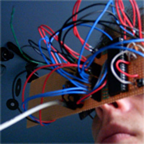
Call for Proposals
CALL: WIRED MADNESS :: Deadline: Friday, 2nd March 2007 :: Wired madness has broken out! Regardless of the mode of expression, this new era of performative art is upon us. This has been revealed recently in many cases: the use of an embedded persistence of vision display to flag a taxi, or the nerdy need to extend alternate-reality games into the real world, or even ironically be more close to the military's command and control digital networks to be employed on unsuspecting audiences by trained insurgent-performers using computational and conceptual couture as a 'secondary skin' in the act of creating the newest New Media art experiences for them.
The Digital Art Weeks 2007 invites Performing Artists to submit proposals in connection with wearable technology and the arts. We are seeking works that empower the performer in an explosion of the boundaries of the body and link the audience into the virtual of technologically animated space. Any form of immersion should trigger critical observation in the mind of the audience in order to counter act the most logical form of evolution in the 21st century enabled by technology: Intelligence without morals. A series of performances during three evenings will be organized in partnership with the Cabaret Voltaire of Zurich.
Notification of acceptance of proposals will be sent out on or before Friday, 2nd April 2007. For more information regarding the call please write to: daw-perfs[at]inf.ethz.ch
Posted by jo at 08:54 AM | Comments (0)
Visual Music Marathon
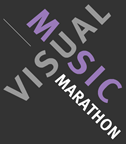
12-hour screening of time-based art works
NORTHEASTERN UNIVERSITY TO HOST VISUAL MUSIC MARATHON: BOSTON, Mass. - Northeastern University will host the first-ever Visual Music Marathon, a 12-hour screening of time-based art works that reflect the convergence of musical composition and animated images, as part of this year's Boston Cyberarts Festival. The Marathon will be held on Saturday, April 28 from 10am to 10pm, in the University's Raytheon Amphitheater, located in the Egan Research Center on Forsyth Street.
"Visual music is an interdisciplinary artistic genre with roots dating back hundreds of years," says Northeastern professor Dennis Miller, the event's artistic director and principal curator.
"The emergence of film and video in the 20th century allowed this genre to reach its full potential, with Walt Disney's Fantasia serving as a groundbreaking example. The artworks we are screening all take a modern perspective on this idea."
Northeastern has received over 300 artist submissions for the Marathon, representing works from 34 different countries. The Marathon will showcase historic and new works, as well as live video performance art. All new works presented at the Marathon will be included in a special permanent collection that will be housed in Northeastern's Snell Library. Larry Cuba of the Iota Center, Los Angeles, and Bruce Wands of the New York Digital Salon and School of Visual Arts will also curate portions of the event.
The Visual Music Marathon is a joint effort between Northeastern's Department of Music and the Multimedia Studies Program. For a preview of works to be shown at the event, visit www.music.neu.edu/vmm/schedule.html.
###
About the Boston Cyberarts Festival: The 2007 Boston Cyberarts Festival will take place from April 20 to May 6 at museums, galleries, theatres, universities, and public spaces in and around the Boston area. The Festival is the first and largest collaboration of artists working in new technologies in all media in North America, encompassing visual arts, dance, music, electronic literature, web art, and public art.
About Northeastern: Founded in 1898, Northeastern University is a private research university located in the heart of Boston. Northeastern is a leader in interdisciplinary research, urban engagement, and the integration of classroom learning with real-world experience. The university's distinctive cooperative education program, where students alternate semesters of full-time study with semesters of paid work in fields relevant to their professional interests and major, is one of the largest and most innovative in the world. The University offers a comprehensive range of undergraduate and graduate programs leading to degrees through the doctorate in six undergraduate colleges, eight graduate schools, and two part-time divisions.
Posted by jo at 07:57 AM | Comments (0)
February 19, 2007
Twingly Screen Saver
Twingly Screen Saver is visualizing global blog activity in real time. Download!
Posted by jo at 06:33 PM | Comments (0)
Amebeats
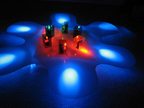
Music production through haptic interface
Amebeats is a project by Melissa Quintanilha that allows “people to mix sounds by manipulating physical objects instead of twisting knobs or clicking on a music production software“.
The amoeba shaped board has little boxes in its center that when moved to the arms, activate different sounds. My interest in music and design merged to create a haptic interface (based on touch) that allows people to use gesture to mix sounds with their hands. My inspiration for this robotic installation came from going to parties and seeing DJs create the music on their tables, but no one knowing what they do to make the sounds. Generating music using gesture allows for a much more expressive way of creation. [blogged by Nicolas on pasta and vinegar]
Posted by jo at 06:17 PM | Comments (0)
love_potion

DIY installations
love_potion is a distributed artwork that uses borage plants, seeds, scents, magic spells and networked technologies. All of its elements are featured on the glorious ninth website and can be woven together by us or by you, inside a gallery space or as DIY installations in our homes, gardens or public spaces.
You can join our invisible network of tactical gardeners by preparing your own love_potion made from borage, an herb that reputedly drives away sorrow, uplifts the spirits and when shared with others nurtures compassion and peace. Follow the potion recipe, find out how to grow your own borage, download the glorious ninth sound and visuals (or make your own) and put together a love_potion DIY installation.
Posted by jo at 05:54 PM | Comments (0)
In-Site Montréal

Hotspot Interventions
In-site Montréal: Curator’s statement by Michelle Kasprzak :: In-Site Montréal is a collection of site-specific art presented on the portal pages of five wireless internet (Wi-Fi) hotspots in Montréal. Artists Nicolas Fleming, Maria Legault, and Virginie Laganière have created artworks that may be viewed when users of the free service provided by Île Sans Fil log in to their accounts at the selected hotspots.
The five hotspots are rooted in specific spaces, each one with its own unique properties. The In-Site Montréal project grew out of a desire to augment the experience of place for Wi-Fi users, offering an additional layer of information within the hotspot environments. The artworks that are presented on the portal pages are inventive responses to the characteristics of the spaces that the hotspots inhabit.
“The window appears to look out onto a dataspace that continues beyond the borders of the window itself. [...] But the illusion quickly wears off. The window starts to feel more two-dimensional, more like a piece of paper than a portal. The view-space appears to flatten out, to the point where the window and the data contained within the window merge.”i
Here Steven Johnson is describing the effects of using a scrolling window on a computer screen for the first time, and I am referring to it (ever so slightly out of context) to illustrate a point about the works that are being presented within In-Site Montréal. The users of the Île Sans Fil wireless network are, arguably, all hardened internet users, for whom the complexities of scrolling windows and portals and most other graphical user interface-related things are trivial.
However, since they have reached the secondary stage that Johnson refers to, where the “window and the data contained within the window merge”, there are certain expectations for an experience that can keep pace with their ability to leap from hyperlink to hyperlink.
Portals, by and large, are clumsy. The portal that occasionally pops up on my screen, which is associated with my Hotmail account, assumes I am interested in all manner of celebrity gossip and sports scores, and regional news for an area that is 45 miles to the west of where I currently live. But the works presented as part of In-Site Montréal are not attempting to form part of a portal experience that would guess the preferences of each user. The works are dealing directly with the particularities of the site where the hotspot is, which is a small enough area to be clearly defined as a common element in each user’s experience. For the elite users, something at last may jump out at them from this flattened dataspace where things feel as twodimensional and familiar as a piece of paper. Instead of the usual hurried clicking to get past a familiar “roadblock” and get to the destination they intended to go to, they may now feel that the artists of In-Site Montréal have added an observation on their local café, library, or artist-run centre that matters, that they can respond to, that strikes them out of their reverie.
“A provisional conclusion might be that in advanced art practices of the past thirty years the operative definition of the site has been transformed from a physical location —grounded, fixed, actual— to a discursive vector—ungrounded, fluid, virtual.”ii
Parts of this definition of site – fluid, virtual – are key concepts that that In-Site Montréal works with. The layer of information that floats on top, as a meta- layer to the usual experience of café users in the Île Sans Fil network is meant to be something a bit fluid, virtual and unexpected. The only definition that it does not fit is that of “ungrounded”, precisely because it is the grounding in the site that sets this project apart. Maria Legault’s interventions with her Free Sugar project may be considered particularly grounded in the sites in question. She worked with two locations, Studio XX and Café Utopik, and developed an extension of her Free Sugar project around both locations. At Studio XX, a feminist art centre that primarily consists of an office space and computer lab, she created a performance event entitled the Free Sugar Salon, that was open for anyone to attend and have the holes in their lives filled with pink pudding. She filled cracks in the architecture of Studio XX with pink icing, and then turned her attention to the attentive public that arrived at the studio, counseling them and filling their mouths with pink pudding to console them. At Café Utopik, a café/bar that regularly hosts bands and spoken word events, she conducted a surreptitious intervention, filling crevices and holes in the architecture and surrounding environment of the Café with pink icing, and documenting it in photographs. Both of these projects are presented on the portal pages of Studio XX and Café Utopik as video documentation of these actions.
Artist Virginie Laganière focused on two very different areas: the Jean-Talon Market and the area around the popular meeting place, Café Utopik. Her site-specific video pieces were shot with regular video cameras, as well as custom camera rigs attached to her body. She then manipulated the footage further in the editing suite, adding her own compositions as soundtracks and prolonging moments that happened oncamera, providing us a moment to reflect on their significance. She specifically chose to document moments where people were not as present in these spaces, and where the patterns of movement in the “off-peak” hours would become more apparent.
Through her augmentations in the editing suite, she also aims to create a piece of work that allows us to see beyond our usual clouded and harried view of the urban environment, and enjoy a view of the built environment that is tranquil, constructed, and part of an aesthetic experience. In particular, her video piece presented on the portal page of the Jean-Talon Market, usually a place so buzzing with activity as to be nearly impossible to navigate, was shot in the very early hours of the morning, when market stall owners are setting up. This meditative and slow period of the Market’s activity is hidden from most of the Market’s patrons, and Virginie’s artful editing brings out the poetry in the stasis of these moments.
Nicolas Fleming's performance art videos also present us with an alternate view of our public spaces. His work is presented at Café Kafeïn and Laïka, because of both the subject matter that he chose and the locations that he performed in. At Laïka, an extremely popular and hip bar/restaurant/club, he presents se traîner, a piece wherein he drags himself out of his apartment (which is within the same building complex that Laïka is in) and down the stairs to an escape portal – an automatic garage door. Throughout the performance he can be heard grunting with the strain of moving himself in such an unconventional way, and by the end of this performance, he is clearly exhausted. Users viewing this video must marvel about this strange and strenuous test to his body, that took place in relative secret behind the scenes of the Laïka’s festive décor. In the other piece, traîner un dj, Fleming travels to Île Sainte-Hélène to encase a dj in a canvas sac, and drag him along the pavement, with the sounds of Piknic Electronique (Montréal’s outdoor summer dance club) pounding in the background. This work is presented at Kafeïn due to the dj culture that is resonant there; the dragging of a dj must be somewhat humourous to the clientele.
Telematics is a term used to designate computer-mediated communications networking involving telephone, cable, and satellite links between geographically dispersed individuals and institutions that are interfaced to data-processing systems. It involves the technology of interaction among human beings and between the human mind and artificial systems of intelligence and perception. The individual user of networks is always potentially involved in a global net, and the world is always potentially in a state of interaction with the individual.iii
The virtual spaces that In-site Montréal inhabit are amorphous areas around several accepted gathering places such as cafés, galleries, markets, and bars. They are perhaps places where as an internet user, you may intend to use the opportunity of connectivity to the network to look outward, to read news of distant places or connect with friends far away through e-mails and online social networking sites. The art practice of telematics in particular addresses the creative possibilities when two parties are connected over distance to communicate. In some way, the pieces presented on the portal pages of Île Sans Fil’s network as part of the In-Site Montréal project present something that is almost anti-telematic, in that the works look inward rather than outward. In the case of this project, a connection to someone across the globe is not sought, it is shunned in favour of a further examination and rumination on the details of the local environment. A local resident, who is perhaps used to the culture at Café Utopik, may be best able to chuckle at the video of pink icing being added to the sign above the door. This intense inwardlooking that these pieces commit to is the essential point of the project. Instead of seeking to look outward and connect with others who are in a radically different geographic space, In-Site Montréal hopes to reconnect locals with their own space, through the language of culture, compelling users of the network to turn their gaze inward enough to consider the cultural resonances that are possible.
- Michelle Kasprzak, 2006/2007
i Steven Johnson "Interface Culture: How New Technology Transforms the
Way We Create and Communicate" 1997 Harper Collins, New York. Pg 86
ii Miwon Kwon, One Place After Another: Notes on Site Specificity, October 80 (Spring
97): 95.
iii Roy Ascott: “Is there love in the telematic embrace?”
http://www.receiver.vodafone.com/07/articles/03_page01.html
Posted by jo at 04:05 PM | Comments (0)
Monika Sosnowska

Loop
Monika Sosnowska's Loop :: February 16 – May 6, 2007; Tu – Su 10am – 5pm; Th 10am – 8.00pm :: Opening, February 15, 2007, 6.00pm :: Curator: Adam Budak :: Kunstmuseum Liechtenstein, Städtle 32, FL-9490 Vaduz :: Tel: + 423 235 03 00 :: mail[at]kunstmuseum.li
The Kunstmuseum Liechtenstein in Vaduz is pleased to announce the opening of a first large-scale museum exhibition of Monika Sosnowska, entitled “Loop”. In her installations that echo the formal language of constructivist avant-garde, minimal and conceptual tendencies of the 60s and the 70s as well as a heritage of modernist architecture, Monika Sosnowska constructs a physical and conceptual labyrinth, a post-narrative, inner world of spatiality, staged in a sequence of interventions that emphasize space’s virtualities and potentials. Here, in this complex and powerful investigation of a spatial perception, a particular surgery is being applied to a body of space and its cultural articulation, architecture.
The space and its parameters: size, dimensions, scale, plans, topology are being altered, shifted and possibly confused and manipulated in order to generate a very unique, unusual experience of spatial habitat and to sharpen our perception of it, outside of a common reality and its habits. With her intimate geometry, Sosnowska experiments with our senses and emotions, making us aware of psychosomatic, hidden qualities of s pace which in her highly performative installations are personified and animated. Between Kafkaesque oppression and a desire to liberate space, there is a sublime and uncanny spatial environment, rendered – sometimes very playfully - on the edge of dream-like imagery and an everyday familiar experience.
Sosnowska’s monumental architectural intervention, Loop, developed especially for the Kunstmuseum Liechtenstein in a collaboration with one of the architects of the museum building, Christian Kerez - as a flexible but controlled space with its deconstructive drive and the rare processings of memory - is an attempt to confront modernist universalised patterns and to escape dimensions in a radical act of constructing a subjective space, a sensual, partly oneiric, mental shell of contemplation and desire. Welcome to a seance of a phenomenological spatio-therapy.
Monika Sosnowska was born in 1972 in Ryki, Poland. She studied at the Academy of Fine Arts in Poznan and the Rijksakademie in Amsterdam, and currently she lives and works in Warsaw. Her recent exhibitions include shows at MoMA, New York, Galerie Gisela Capitain, Freud Museum Vienna, Serpentine Gallery London, De Appel in Amsterdam. Sosnowska participated in Manifesta 4 (Frankfurt), 8th Istanbul Biennale, Venice Biennale 2003. Monika Sosnowska will represent Poland at the forthcoming Biennale in Venice.
The catalogue, published on the occasion of the exhibition, contains text contributions by Will Bradley, Christian Kerez, Friedemann Malsch, Anthony Vidler, Jan Verwoert and Adam Budak as well as a rich visual material, including installation shots from the Kunstmuseum Liechtenstein exhibition.
Monika Sosnowska’s “Loop” is accompanied by the programme of the following events:
Thursday, March 8, 2007, 6.00pm
“About Monika Sosnowska’s Loop”
Christian Kerez, architect, professor of architecture, ETH Zürich
Conversation
Thursday, March 15, 2007, 6.00pm
“Experiencing Architectural Spaces”
Konrad Wiesendanger, architect, Luzern
Lecture
Thursday, March 22, 2007, 6.00pm
“Last Year in Marienbad”, 1961, dir. Alain Resnais
Screening
Thursday, March 29, 2007, 6.00pm
“Spaces, Cinema, Feelings. About the Work of Monika Sosnowska”
Jan Verwoert, art critic and writer
Thursday, April 26, 2007, 6.00pm
“Loop”
Monika Sosnowska in conversation with Adam Budak, exhibition curator
Posted by jo at 01:06 PM | Comments (0)
THE LAST SUPPER : ABOVE THE SKIES
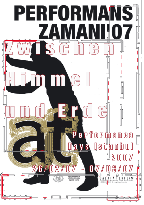
Call for Applicants
Performing Days Istanbul 2007 :: THE LAST SUPPER: ABOVE THE SKIES :: An audiovisual installation by Alexandra Reill, production: kanonmedia/Galata Perform :: 03/03/2007, 22:00.
A Last Supper is taken by the visitors of the Performing Days Istanbul 2007 - a dinner as frugal as feeding as it is with its apple on the plates of a table with thirteen seats. The looping screening of the film Above the Skies creates a stringent sacral character for this multicultural dinner where a chair is missing and where the shades of visitors become part of the scenario.
Traces of Moorish, Jewish and Catholic culture of the Middle Ages form the visual framework for a search on the inner essence and character of human suffering in life, putting the viewer in a trance-like state of slowed down introspection. Opulent Baroque versus Gothic and Muslim transparencies. Empty Jewish quarters maintained like museums for tourists' looks. A Europe place as proof for imperialistic approaches.
What does suffering mean. What does suffering mean in a lifetime. What is the sense of conflict, the sense of separation. Impressions of life, always doubled to keep the option to look through things. A journey from the Earth to the Skies and back, at a table where a chair is missing in the round.
With remixes of Middle Age chorals out of the times of Alfonso X El Sabio (1221-1284), Elisabeth the Catholic (1410-1563), the Nasrid Dynasty (1410-1563) and the Jewish culture.
Posted by jo at 12:31 PM | Comments (0)
Remote Presence: Streaming Life

Call for Applicants
Remote Presence: Streaming Life :: Workshop Call for Applicants :: Presented by John Hopkins as part of the pixelache 2007 "Architectures of Participation" Festival and in collaboration with Artists' Association MUU :: Dates: March 21-23 & 26-31, 2007 :: Location: MUU gallery & Media Base, Lönnrotinkatu 33, Helsinki, Finland :: Hours: 1030 to 1630
In the ubiquity of networked media spaces where we distribute our wireless lives, what happens to our creative processes? How may we build a functioning architecture of participation for productive collaboration and interaction between the Self and Others? This dynamic workshop will bring participants to a new state of awareness about their own creative practice. It will accomplish this through an exploration of human collaboration and connection within the space of networks. It explores conceptual and practical issues around creative engagement, finishing with the hands-on production of a live and online streaming-media network event with global participation.
The workshop is open to anyone from any discipline with an interest in collaboration and creative engagement at both a local and remote scale. There are NO technical background requirements. People with previous experience in streaming media, performance, digital audio and video, VJ work, etc, who wish to push their practice to a new collaborative level are also welcome.
On Saturday, 31 March, the final day of the workshop will be a live & online event. Workshop participants will not only develop digital content for the event, but will also help facilitate all aspects of it including the technical infrastructure, the local ambience, and the remote coordination.
A maximum of 15 participants will be chosen from local and international applicants with the idea to bring together a wide spectrum of cross-disciplinary energies.
THE WORKSHOP IS FREE OF CHARGE.
Those interested will need to send their:
NAME:
LOCATION:
EMAIL:
Along with your reasons for interest in the workshop and a brief background (studies, creative work, activities) to: neopixel[at]pixelache.ac. DEADLINE for Applications 5 March 2007.
Posted by jo at 12:27 PM | Comments (0)
February 16, 2007
The Bigger Picture + Urban Screens Conference
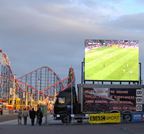
Call for Proposals, Papers and Projects
The Bigger Picture Commissions 2007 + Urban Screens Conference, Manchester 07 :: Call for Proposals, Papers and Projects :: 1) The Bigger Picture Announces International Call for Major Public Realm Commissions :: 2) Urban Screens Conference Manchester 07 Call for Papers :: 3) Urban Screens Conference Manchester 07 Call for Projects.
THE BIGGER PICTURE :: INTERNATIONAL CALL FOR MAJOR PUBLIC REALM COMMISSIONS: National UK commissioning and production partners: Cornerhouse (Manchester), ENTER_ (Cambridge), Lumen (Leeds) & Site Gallery (Sheffield), with support from BBC, funded by Arts Council England :: DEADLINE FOR PROPOSALS Friday 30 March 2007 :: to be launched at Urban Screens Conference Manchester 07.
The Bigger Picture exhibits artists’ film & video and interactive / participatory screen based projects on Big Screen Manchester, UK. Utilising this unique screening space, The Bigger Picture is able to present a host of artists’ works to large and diverse audiences reaching beyond the traditional gallery context. Cornerhouse, working in partnership with BBC and Manchester City Council, delivers The Bigger Picture’s curated programmes, whilst additionally commissioning and touring large outdoor screen-based programmes.
The Bigger Picture is inviting proposals for the production of exceptional new public realm works to be launched on Big Screen Manchester at the time of the Urban Screens Conference Manchester 07 (11&12 October), and to tour to partner city Big Screens and public sites throughout 2007/8. Four new works will be commissioned, each with an attached fee of £5000 (7400 EUR / 9700 USD) based on an agreed budget, of up to £10,000 for production (14,900 EUR / 19,500 USD).
This is a significant opportunity for film, video, new media and cross-disciplinary artists to explore unique new ways of creating and exhibiting work for a public context. Each National Commissioning partner will lead on the production of one new work. Partners are particularly encouraging proposals of the following nature:
- Interactive and participatory new work
- Interdisciplinary new work (combined arts, performing arts, audiovisual)
- Evolving or expanded work
- New media and streaming technology
- Film & Video
Artists previously commissioned by The Bigger Picture include Christine Molloy and Joe Lawlor (desperate optimists), Kartoon Kings (Simon Grennan and Christopher Sperandio), plus Paul Melia, Hilary Jack, The Light Surgeons, Adele Prince and Louise K Wilson.
For more information on how to submit, including key information, guidelines & submission form, and BBC technical specifications, see >>.
Deadline for proposals 30 March 2007.
Big Screen Manchester, is part of a UK Big Screen network, operated by the BBC.
CALL FOR PAPERS – Closing date: March 2, 2007
The next Urban Screens Conference focuses on the development of non-commercial content for big urban displays such as LED, LCD, plasma screens, media façades and projections onto buildings.
What characterises these huge displays as media platforms in urban space and which particular spatial and social situations do they create? How are they perceived? How does creative content flow from this?
We will discuss:
- urban screens as channels for alternative public broadcasting in times of Web 2.0, YouTube, increasing broadband rates and Creative Commons.
- which interactive and participatory applications could enrich urban life beyond simple entertainment.
- which linear artistic productions such as animations, video, film or text suit a presentation in public space.
- how displays can be integrated into the urban environment in meaningful ways.
- which economies drive and limit both the implementation of urban screens in public space and the commissioning of creative content.
- the evaluation of creative content with regard to how it is perceived.
For the Urban Screens Conference we are looking for proposals for papers that deal with the above mentioned topics or other related fields of research.
HOW TO SUBMIT
Please email proposals for papers in the form of a 500 word max abstract and your/the presenter’s CV by March 2, 2007 to info[at]manchesterurbanscreens.org.uk
CALL FOR PROJECT PROPOSALS – Closing date: March 2, 2007
The conference is accompanied by an inspiring programme of public events and exhibitions, including screening programmes as well as performance-based and participatory art projects which make use of the BBC Big Screens Network. We are looking for existing and potentially adaptable projects which employ one ore more permanent or temporary screen.
We are particularly interested in projects:
- exploring web-based content and streaming media
- connecting screen audiences in various places
- interactive and participatory works using bodily interfaces and ubiquitous communication devices
- text pieces, video and animation which suit airing on urban screens
- performance-based works including audiovisual performance/VJing
For detailed information on the BBC screens’ system please see www.manchesterurbanscreens.org.uk
HOW TO SUBMIT
Please send project proposals in the form of a project description, illustrative material and the author’s CV by March 2, 2007 to:
CORNERHOUSE
Urban Screens Conference
70 Oxford Street
Manchester M1 5NH
United Kingdom
Posted by jo at 07:35 PM | Comments (0)
19th ANNUAL SUBTROPICS FESTIVAL
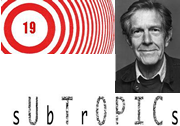
THE WORK AND LEGACY OF JOHN CAGE
[photo by rex rystedt] Produced by iSAW and presented in partnership with Carnival Center for the Performing Arts 19th ANNUAL SUBTROPICS FESTIVAL LOOKS BACK AT THE HISTORY OF EXPERIMENTAL MUSIC THROUGH THE WORK AND LEGACY OF JOHN CAGE :: February 23 – March 4, 2007 :: nineteen concerts, outdoor events, panel discussions, oral history projects and installations about musical pioneer JOHN CAGE, his accomplices and contemporaries at the Carnival Center for the Performing Arts, Deluxe Arts and in Miami Beach.
The festival features seminal pieces and new works by New York School Composers JOHN CAGE, EARLE BROWN, MORTON FELDMAN and CHRISTIAN WOLFF (performing), as well as CONLON NANCARROW, JAMES TENNEY, LAMONTE YOUNG and others. Plus, a full day of FLUXUS and a 14-hour-long performance of VEXATIONS for piano by the French composer ERIK SATIE (1866-1925).
This year’s Subtropics Marathon feature guest artist MARGARET LANCASTER on flute as well as performances and works by South Florida composers and sound artists JURAJ KOJS, JUAN CARLOS ESPINOSA, RENE BARGE, ARMANDO MARTINEZ, and more.
Also scheduled are the installation CAGE: RELEASED IN MIAMI, the film BASCHET: THE TRANSFIGURATION OFDAILY LIFE and the oral histories project INDETERMINACY TOO. For detailed information about the artists and programs, please log on to subtropics.org.
Posted by jo at 07:02 PM | Comments (0)
You Are Not Here
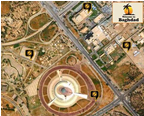
Reviewed by Luís Silva
"From a strict physical, corporeal point of view, ubiquity is an ontological impossibility. For as much as one would like, being in two places at the same time, for instance, the city of New York and the city of Baghdad, is not possible to accomplish. Only electrons, netart and god have the uncanny ability to present themselves in several places in one given moment.
You Are Not Here departs from and builds itself from this inability. Developed by Thomas Duc, Kati London, Dan Phiffer, Andrew Schneider, Ran Tao and Mushon Zer-Aviv and inviting people to “explore Baghdad through the streets of New York”, YANH presents itself as an urban tourism mash-up. Not only can you be in two places at the same time (the ubiquity concept we departed from), but also both places become interconnected in a psychological enactment of a meta-city. The underlying mechanism is pretty simple: users (the so-called meta-tourists) are invited to download and print on one side of a sheet of paper a map of Baghdad and on the other side a reversed map of New York. As soon as that task is accomplished the exotic sightseeing can begin. Scattered around New York are YANH street-signs that provide warned explorers (those who printed the map) as well as random passers-by the telephone number for the Tourist Hotline, where audio-guided tours of contemporary Baghdad destinations in NYC can be listened to." Continue reading You Are Not Here - You Are Not Here by Luís Silva, Furtherfield.
Posted by jo at 05:17 PM | Comments (0)
Turbulence Spotlight:
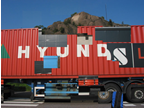
Algorithmic Montage 2: A Walk with David Bohm
Turbulence Spotlight: Algorithmic Montage 2: A Walk with David Bohm by David Crawford :: Needs Flash player.
"David Joseph Bohm (born December 20, 1917 in Wilkes-Barre, Pennsylvania, died October 27, 1992 in London) was an American-born quantum physicist, who made significant contributions in the fields of theoretical physics, philosophy and neuropsychology, and to the Manhattan Project." (Wikipedia) The audio in this video comes from an interview that F. David Peat conducted with David Bohm.
David Crawford studied film, video, and new media at the Massachusetts College of Art and received a BFA in 1997. In 2004, he received an MSc from Chalmers University of Technology. Crawford is currently a PhD candidate at the Faculty of Fine and Applied Arts at Göteborg University, Sweden.
Posted by jo at 10:40 AM | Comments (0)
Cities as Billboards
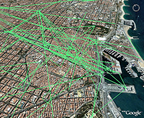
Urban Spam in "Unsold" Space
The train of thought that I started as I discussed Fabien Girardin's Flickr heatmaps a few posts back, and which led me to thinking about mining consumer line-of sight data to target advertising, seems to be continuing here in a recent New York Times article about how advertisers are now looking to use what they would consider "unsold" space to place their messages. This phenomenon even has a name, urban spam.
But why just post the same ad for everyone to see? Why not use an individual viewer's line of sight as they travel as a "channel" into which to project ads and messages where blank space exists? Fabien's recent post, illustrated here, shows the "traces" left by Flickr photographers as they transit Barcelona. Where his heat maps showed the locations of single images, the traces follow the path the photographer takes through the city, or his visual corridor, if you will. [blogged on Smartspace]
Posted by jo at 09:48 AM | Comments (0)
Proboscis
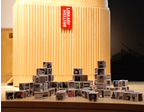
London As We May See It
On Wednesday February 14th 2007 Proboscis presented a new 'map' of London as part of "Uncharted Territories: the Brave New World of Mapping" at the British Library, London.
London As We May See It is the city re-imagined through a landscape of 105 StoryCubes. Each one has 5 pictures taken in a particular street or place (as well as an image of the street sign). The StoryCubes can be assembled together – connected – in any way in three dimensions to describe the route of a walk, or the places one has lived or worked in. They can describe experiences one has had across the city or the places in which one has made friends, had trysts with lovers or where we seek solace and rest from the manic energy of the city. These cubes could also be used to create a shared map between a community or group of friends - ever evolving and changing with each person's contribution.
The pictures used in the map were all contributed to the group photoblog The Way We See It. Thus the map is organic and can grow alongside the photoblog, adding new StoryCubes as new streets are photographed and 'mapped'.
"London As We May See It" is the beginning of a new series of collaborative mappings of places and communities in the UK and abroad by Proboscis. As such we hope it could be the basis of or model for a tool of engagement within a community, or across different communities, combining the ease of new digital technologies, for capturing and sharing images, with familiar technologies (print / paper based) that result in tactile and tangible spaces of their own for telling stories and sharing knowledge and experiences. More pictures and details are available here. Buy your own Blank StoryCubes here.
Posted by jo at 08:51 AM | Comments (0)
February 15, 2007
Mute Vol 2 #4

Web 2.0 – Man's best friendster?
Mute Vol 2 #4 - Web 2.0 – Man's best friendster? :: Web 2.0’s democratisation of media produces a wealth of new perspectives. Some of those formerly excluded from the public sphere have the chance to make their voices heard. But this wave of participation is as important for business as it is for the newly included. Mute's Web 2.0 special uncovers the work in social networking and, behind the 'dotcommunist' spin, a centralisation of the means of sharing. Texts by Giorgio Agostoni, Olga Goriunova, Dmytri Kleiner & Brian Wyrick and Angela Mitropoulos. Additional articles by Brian Ashton, John Barker, Paul Helliwell and Merijn Oudenampsen
Swarm Forms: On Platforms and Creativity by Olga Guriunova :: Will the ‘hive mind’ of social networking replace classical forms of knowledge production? Comparing Web 2.0 and small-scale, self-run cultural platforms, Olga Goriunova maintains the possibility for originality in both contexts, while identifying how the same old commercial and institutional pressures still operate.
The Long Tale by Giorgio Agostoni :: Web 2.0 relies heavily on identikit forms of self-representation and sociability. Parallel to the ‘authentic’, self-promoting personae of MySpace, multi-user virtual worlds such as Second Life (SL) appear to offer a more malleable, playful version of life online. But as the imperatives of commercial exchange penetrate deeper into the networked imagination, is the gap between RL and VR what it used to be? Giorgio Agostoni reverse engineers material from across the net to construct a fictional readymade suspended between self-reinvention and self-management.
Posted by jo at 03:18 PM | Comments (0)
UPGRADE! BOSTON

Jesse Pearlman Karlsberg + Deb Todd Wheeler
UPGRADE! BOSTON: Jesse Pearlman Karlsberg + Deb Todd Wheeler :: WHEN: February 15, 7 pm :: WHERE: Art Interactive, 130 Bishop Allen Drive, at the corner of Prospect Street, Cambridge. Free parking in the lot on the corner or take the T to Central Square and walk 1 block.
Jesse Pearlman Karlsberg is a sound artist, composer, and shape note singer whose work explores the intersections of technology and tradition. His output encompasses installation, music for live performance, tunebooks, web design, audio tours, and transmission arts. Jesse’s current work investigates the history and practice of Sacred Harp singing and the geological, social, technological, and religious history of upstate New York. Jesse is the cofounder of the “Society for a Subliminal State” and editor-in-chief of the Society's newsletter, “Subliminal Statements.” His work has been performed and exhibited at art and historical venues internationally and throughout the Northeast.
Deb Todd Wheeler is a sculptor, inventor, and media artist. Using the vernacular of the 19th century, a time when art and science were more closely linked, she investigates alternative avenues for power that reflect our growing concern with sustainability today. She is a recipient of a LEF Contemporary Work Fund Artist grant in inter-media, a Massachusetts Cultural Council Grant in Sculpture and Installation, and the Artist Resource Trust Grant. She is on the Graduate Faculty of the Art Institute of Boston, and also teaches in the 3D department at Massachusetts College of Art.
Upgrade! Boston is curated by Jo-Anne Green for Turbulence.org in partnership with Art Interactive. It is one of 22 nodes currently active in Upgrade! International, an emerging network of autonomous nodes united by art, technology, and a commitment to bridging cultural divides. If you would like to present your work or get involved, please email jo[at]turbulence.org.
Posted by jo at 03:08 PM | Comments (0)
Many, many maps:
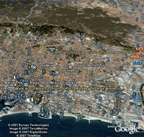
Empowerment and online participatory mapping
"The convergence of public participatory mapping and cybertography is having far-reaching impacts through a variety of creative applications. This paper presents three different types of Internet mapping applications — Google Earth and Google Map API, Common Census, and a design exercise in Second Life — with a public participatory geographic information system (PPGIS) and cybercartography perspective. Each of these examples empowers users in a different way. The spatial applications and the supporting information that is being made available through Internet map applications represent a unique set of examples of the democratization possible through Internet applications." Continue reading Many, many maps: Empowerment and online participatory mapping by David L. Tulloch, Frist Monday, Issue 12
Posted by jo at 02:54 PM | Comments (0)
Art Center Nabi @ ARCO, Spain
Intermediae-Minbak
Art Center Nabi of Korea and Intermediae of Spain jointly present Intermediae-Minbak project at ARCO 2007, Madrid Spain. Interaction of unique culture and people takes place at Minbak (Korean word for accommodation for temporary home stay), which an entire space can serve as a place for vivid cultural exchange. Ten Korean media artists and approximately fifty Spanish students from five art colleges in Bilbao, Cuenca and Valencia meet one another at Intermediae-Minbak, a soft platform where they can exchange ideas. The works themselves function as a medium and help those who gather to stimulate each other’s creativity through common experience, and forge a new relationship.
Wind by Ji-hoon Byun brings in the wind of Pusan in real time to cause the screen installed at Minbak to flutter, while A Garden by Minha Yang invites the guests of Minbak to an interactive digital garden with the Oriental mystique. People overcome the limit of language difference and newly start to communicate via the visualization of sound through Sound Talking by Kichul Kim. They also allow their bodies, and furthermore their thought and culture, to mingle with each in a hope to become one in Love Shaker 2.0 by Joon Kim and Seungjoon Choi.
Stories of Your Life & Others (ver. Madrid) by Sengtak Seo, Seungjoon Choi, Jaekwan Park, Junghoon Lee provides an opportunity to make ties in other dimensions through avatars which freely move around simulated spaces of Intermediae and Art Center Nabi. Communication initiated through the medium of the metaphorical works will develop into more direct interaction at workshops. Meanwhile, a series of events that take place at Minbak along with other events at ARCO 2007 will be extended outside the exhibit space by a project titled Delivery_ARCO.zip by Woosuk Jang, Taejoong Kim and Yangachi. The separate online project is a kind of combination of Internet broadcasting and web arts.
Posted by jo at 11:56 AM | Comments (0)
Upgrade! Istanbul

re-construction of space
Upgrade! Istanbul: re-construction of space with Murat Germen + Burak Arikan :: 22nd of February 18:00 :: santralistanbul will host this meeting at Istanbul Bilgi University, Dolapdere Campus, Z-04.
Space is usually defined / experienced as a physical entity; yet, we recently began to observe that the notion of ‘space’ can exist / be perceived / used as a non-physical organism by means of interactive media and virtual environment applications in the computer platform. Such creations bring new definitions of “space” and can be named as “informational space” or “cognitive space”. As a result, it is possible to talk about a process of re-constructing space. While Burak Arikan pursues this process by creating pieces involving computer networks and using the concepts of connectivity, collectivity; Murat Germen follows a similar path within the realm of digital photography and also computational design studies that he conducts with colleagues from Sabanci University.
Upgrade! Istanbul is a monthly gathering for new media artists, academicians, practitioners, curators and for all of the other actors of digital culture, organized by NOMAD and hosted by santralistanbul.
Posted by jo at 11:02 AM | Comments (0)
A LEAP INTO THE VOID:
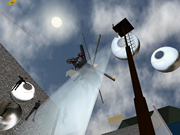
INTERVIEW WITH SECOND FRONT
"A LEAP INTO THE VOID: INTERVIEW WITH SECOND FRONT" by Domenico Quaranta; Commissioned by Rhizome.org.
At first sight they may appear like a pop hybrid between the X-men and the Four Horsemen of the Apocalypse, reviewed through the exaggerated and postmodern aesthetics of a virtual world such as Second Life. Quite the contrary. They are the first performance art group in Second Life: serious guys, practicing artists, curators and academics in real life, who decided to sound out the performative possibilities offered by a public virtual space that is growing at an impressive rate and being filled up by media agencies, stores, products, brands and inhabitants.
Second Front officially formed on November 23, 2006, gaining new members up right until the last few days. Now they are: Wirxli Flimflam aka Jeremy Owen Turner; Tea Chenille aka Tanya Skuce; Man Michinaga aka Patrick Lichty; Alise Iborg aka Penny Leong Browne; Tran Spire aka Doug Jarvis; Great Escape aka Scott Kildall; Lizsolo Mathilde aka Liz Pickard; Gazira Babeli aka CLASSIFIED. The attention of “in world” media comes fast, even if Second Front doesn't seem to work much on communication: its very first performances are set up, unannounced, in public spaces, for a little, unconscious audience. Then, almost immediately (January 5, 2007) comes the big intervention scored at Ars Virtua Gallery – the most notable contemporary art gallery in Second Life – for the opening of the visionary installation by the American artist John Craig Freeman (JC Fremont in Second Life). And may other performances...
Saying that Second Front is opening new paths in an unexplored territory is not rhetorical; and the loose, immodest and a little bit punkish way in which they do it is definitely unrhetorical. Their key feature is openness: openness and plurality of visions and perspectives, quite blatant in this interview (where almost each one of them decided to give his/her answer to the same question); they are open about a wide range of interventions, from reenactment to improvisation to code performing; open about different ways of shaping their work for the art audience, from prints to video to live broadcasting. They are growing up before our very eyes. And, rest assured, they hold good things in store.
DOMENICO QUARANTA: What is Second Front?
MAN MICHINAGA: Second Front is an international performance art group whose sole venue is the online world, Second Life. Second Front has members from Vancouver, St. Johns, Chicago, New Orleans, and Milan (to name a few), and works with numerous artists from around the world.
WIRXLI FLIMFLAM: As of January 14th, Second Front received official legitimacy from The Ava-Star tabloid (owned by Die Zeit in Germany) as the “first performance art group in Second Life”. This basically makes us the in-world equivalent of Fluxus – perhaps we could also be nicknamed “SLuxus”. This sudden rush from formation to celebrity has been quite fascinating since Second Front officially formed on November 23, 2006. As for a more detailed idea of what Second Front is all about, some people in Second Life might confuse us with a “performing arts” group rather than a “performance arts” group. We are not a circus act nor a dance or a theatre troupe although our artistic practice might superficially resemble those other performing acts at times.
TRAN SPIRE: Second Front is a network of performance interested artists exploring new and different environments, specifically the online 3d animated game world of Second Life. The members have come together through a myriad of personal relationships that existed during the early days of the group’s formation. This dynamic has morphed and mutated to include and involve variations on membership based on who is available and what presence can they perform with the others.
DQ: What does it mean, for you, to make performances in Second Life? Do you make rehearsals or do you prefer improvisation? Do you work with code or do you simply make what all other avatars do?
ALISE IBORG: So far we have done both. I think it depends on what kind of performance we wish to make. If it is better improvised we will probably do that. Each has its advantages and disadvantages. With prerecorded performances, we can fine tune and edit out things we don't want the audience to see. But with improvised performances, the work takes on a life of its own fueled by the creative energy of our players which really shows through. Also, many times, it's the surprises and unintended actions that make the work really come alive!
MAN MICHINAGA: Performing in Second Life gives Second Front the opportunity to work at scales they would not normally be able to work in if done in the physical world, and often has the opportunity to play to a wider audience. Our level of preparedness is dependent on the context for the event. In regards to whether we use code or not, Second Front is using a growing set of code-based interventions in its performances, thanks to our techno-doyen, Mama Gaz Babeli. In regards to our avatars, and props, almost nothing we use is ‘standard’, but some of us retain a few basic props like specific wings, or even old beginner’s props like hair as a sign of their past as newcomers to Second Life.
WIRXLI FLIMFLAM: When we rehearse and plan scripts for major public performance events, we still have to rely on individual improvisation. Nothing is ever entirely scripted so each member can do their “own thing” and have breathing room yet at the same time not be confused as to what they should be doing. We use scripts and rehearsals etc. as a guide to help the performing member to feel secure with the thematic manner with which they wish to improvise. This allows for group cohesion both on an optical and practical level.
GREAT ESCAPE: Second Life offers a unique space for performance. Without the normal constraints of the body ― the usual center of performance - and without a traditional audience, we can try and do things that have been previously thought to be impossible.
TRAN SPIRE: Performing in Second Life introduces variables and situations that complement and push further the understanding and comprehension that the members of the group share as a sense of what is real. By engaging the contrived space of an online gaming environment the challenges to perform are exaggerated by the parameters that persist as the interface with the context, the others members of the group, audiences and the templates of performance as an art medium. All of the tropes of performance are available to the group to use at will, hopefully to ends beyond the surface of what may appear evident around us.
GAZIRA BABELI: The real performance starts with login, the rest is performance record. The avatar just tries to forget being a code.
DQ: Do you prefer, for your performances, a public space or an art venue?
MAN MICHINAGA: Second Front chooses its venues to fit the context of the piece and the performance. In the case of Border Control, it was done at Ars Virtua, therefore the context was that of an art space. For our Breaking News and Abject Apocalypse pieces, these were context specific (the Reuters building and the Star over the Christmas Tree at the US’s NBC Rockefeller Plaza), and were performed in situ, with the product being the documentation.
WIRXLI FLIMLAM: Personally, I prefer a large and well-known public venue that is not usually within the context of high-art. So for example, IBM, Sears, American Apparel, Wired, and Reuters are all great examples of the kind of venues I think are really inspirational for me. Again, this is a personal preference and not necessarily reflective of Second Front as a group.
GREAT ESCAPE: It depends on the nature of the performance. An art venue is interesting because it brings Second Life into the physical space. I think it is ideal to broadcast the performance at an art venue while engaging a specific site in Second Life.
GAZIRA BABELI: In art venues you can be welcomed with cheers, in public spaces with bullets. I prefer the latter, as death doesn’t exist.
DQ: What kind of audience are you looking for? Do you think that a performance in Second Life could be displayed also in the real world?
MAN MICHINAGA: We are interested in reaching out to audiences who are interested in Second Life, and are curious of the possibilities that avatar-based performance art can have. Currently, Second Front is performing in hybrid venues, such as simultaneous events in its home, the BitFactory in Han Loso, and in physical spaces, like Vancouver’s Western Front, and Chicago’s Gallery 416. We do hope that in addition to our performances in Second Life, Second Front can have exhibitions of its performances, imagery, video, and ephemera in the physical as any and all possible media. We do not wish to be limited by media, and also wish to spread our curiosity to the widest possible audience.
GREAT ESCAPE: One thing I think we’re looking to do is to question the underlying assumptions of Second Life and what it means to be a virtual being in that space. A dominant trend in Second Life is to shop, make friends online and participate in a virtual economy. We think this can be a venue for unique artistic expression. In this way, anyone in Second Life is an appropriate audience. The possibilities for the space haven’t been fully explored as of yet and so I think people are much more receptive to performances that they might be in real life. Because it is so new, we can have a huge affect on people’s thinking.
TRAN SPIRE: I like the idea that the notion of an audience is being blurred by my own participation in this group. I am conscious of the fact that during all the stages of our performances from pre-production planning emails to after-party videos, I am both a performer with the group and an audience to the many things taking place. Anything that contributes to challenging this space and dichotomy between creator and audience I think is an interesting thing to pursue.
ALISE IBORG: We are looking for open-minded audiences who are not afraid to be part of the performance. And absolutely, Second Front could be displayed in the real world. The term that I use to describe this intervention into the real world, is 'virtual leakage'. I define virtual leakage as a two way exchange between the virtual and the real, through which new hybrid meanings can be made. Meaning-making can no longer operate within the hermetic cases of the real vs. virtual, but instead, becomes a back and forth exchange in which ideas migrate by osmosis. While we as Second Life avatars become more real in the virtual world, so too, that we as human inhabitants of the real world become more virtual. In my opinion, there is an amazing opportunity for Virtual Reality (VR) to stake its own territory but in order for VR to produce meaning that breaks from the real and from past artistic social practices, and to become a medium that produces singular works, the binary of the real vs virtual must be dismantled. Only then, will we be able to look at VR not as a simulation of the real, but as a simulation of itself.
GAZIRA BABELI: I prefer an unaware audience, an audience who does not necessarily have to understand what’s going on. Second Life is a real world.
DQ: Can you tell me something about the performances you had till now? How did your approach changed from the first one?
MAN MICHINAGA: Like any experimental troupe, we are always learning, and this affects our performance process. In addition, for Breaking News, many of us were only recently active, so our first performance was a really interesting experience. In short, Breaking News was an absurdist play on the 18th Century idea of the Town Crier, played out in the latest of 21st Century news facilities. By shouting out non-sequiteur, moment-to-moment headlines, Second Front hoped to perhaps jam the usual flow of information in the Reuters space, and possibly (ridiculously enough) barge into Adam Reuters’ office itself! On the second occasion, we did get an audience, as passers-by stopped and sat to listen to our tabloid headlines. Of course (we assume) they did not take us seriously. For Border Control, we knew we would have an audience, and that we would need to fill a fairly set period of time with detailed orchestration, we experimented at the BitFactory, rehearsing a series of vignettes that fit the context of JC Fremont & Rain Coalcliff’s Mexican Border installation. The first act, “Border Patrol” was a Dada-esque performance of the increasing militarization of the borders throughout North America. Following that, “Red Rover” was a play on the creation of a border in the traditional children’s game, but in our case the border decided to break down the audience instead of the other way around. Lastly, the final act, “Danger Room” was a piece that was intended to inspire a gestalt of danger and chaos in the age of Terror, but unexpectedly, chaos erupted and the sim actually crashed, whether by our actions or a combination of us and the audience isn’t really clear.
The approaches for the two pieces are quite different, as one is ad-hoc and the other following a set choreography and set. Are we changing? Of course; it wouldn’t be interesting if we weren’t. We learn new things each performance, and while certain things get easier, we then try to push the envelope harder in other areas.
TRAN SPIRE: I like to think that part of the script of each performance is written in the code of the place or environment in which it is situated. This lets the content be influenced by not only the art or non-art context but also by the different terrains that can exist in the real life as well as Second Life.
DQ: What do you think about art in Second Life? Is performance the only possible way to make art out there?
MAN MICHINAGA: Absolutely not. While Second Life has limitations like any medium, the members of Second Front are excited to see individuals working in many different forms of expression, such as live music, ‘painting’, sculpture, even fireworks and aerial ballet. While Second Life is relatively new, the possibilities for expression in virtual worlds has yet to be fully explored. That’s why Second Front was created!
WIRXLI FLIMFLAM: Context is extremely important here. Part of what makes Second Life itself is the fact that every moment seems like part of a performance. The fact that everything can be customizable in Second Life as well as the fact that just about any object can be wearable enhances my personal impression that performance art is the most “authentic” medium of Second Life in that Greenbergian sense.
GREAT ESCAPE: Right now, the Second Life galleries are mostly replicating paintings and sculpture, enhanced with visual effects in Second Life. These are what you’d expect with the first generation of art-making in any new medium. I think that what we’ve seen so far in Second Life is only a glimpse of what the future holds.
ALISE IBORG: Absolutely not. Second Life has offered the ability for anyone to create in VR which means that there is boundless possibilities for creativity and unprecedented work. In my opinion, VR is in itself a new medium but what is unique about VR is that through its technology, it can create work that can free itself from past art practices, though, there is also amazing avenues of creation by referencing precedent artists and works, For instance, our Last Supper performance appropriates one of the most canonic religious events by producing an event of binging and purging art itself!
GAZIRA BABELI: Second Life is a frame-space which can include all sorts of artistic perversion. I call it performance, anyway. But if you find a better definition, please let me know.
DQ. What is your relationship with your Real Life counterpart?
MAN MICHINAGA: There really is none. Patrick Lichty does not exist. Only I am real, and I control him. On a more serious note, the relationship between Man and Patrick is completely in line with my RL life. I am very sensitive to context, and the way I act in one context may be very different from another. In Second Life I feel that one has to be “Larger than Life”, and that's what Man is – He’s a big dark, figure – part angel, part rock star, part architect, part actor. That is, all the things that Second Life gives the individual more freedom to be if they so desire. I think that most of Second Front do this with great effectiveness and aplomb. My greatest concern is “the risk of the Artist”; that is, the bleed between worlds that I take by making potentially controversial art in Second Life. I think that Second Life is the first place where we can say that sometimes our action online DO matter, and this is very perplexing.
GREAT ESCAPE: I think that the avatar Great Escape occupies a strange nook in my subconscious. In many ways, Second Life operates as a fantastical dream state. We can fly, teleport and pick up houses and cars. My avatar has purple skin and fire out of his hair. When I go to sleep at night, images of the other Second Front members often fill me head. So for me, my avatar is embedded in my psyche, rather than an extension of my self.
WIRXLI FLIMFLAM: In a lot of ways, the relationship between Wirxli and Jeremy is much more closer than one might think from first seeing me. I did intentionally want to make Wirxli more of an alien than human or perhaps as a kind of first-generation “post-human”. I was also reading up about the stereotypical shaman in most cultures who is gender-ambiguous... so in this case, there is a slight departure here from my Real Life self.
TRAN SPIRE: I prefer to triangulate, dimensionally shift my relationship to each of the entities constituting themselves as versions of me. Therefore, I am waiting for the two to have a discussion and then ask me to join in on the conversation. I am interested to hear what they come up with and how they define themselves in regards to existence in a spatio-temporal plane, and whether they recognize each other.
GAZIRA BABELI: My body can walk barefoot, but my avatar needs shoes.
LINKS:
Second Front - http://slfront.blogspot.com/
Gazira Babeli - http://gazirababeli.com/
The BitFactory - http://patricklichty.com.thing.net/bitfactory.html
Ars Virtua Gallery - http://arsvirtua.com/
Imaging Place - http://imagingplace.net/
Domenico Quaranta is an Italian art critic and curator focused on New Media Art. He is the author of the book Net Art 1994 – 1998: La vicenda di Äda'web (Milan 2004) and, together with Matteo Bittanti, the editor of GameScenes. Art in the Age of Videogames (Milan 2006, http://www.gamescenes.org/). He curated several exhibitions in Italy, including: GameScenes (Turin 2005), Radical Software (Turin 2006), and Connessioni leggendarie. Net.art 1995 – 2005 (Milan, 2005). He teaches “Net art” at the Accademia di Brera in Milan.
Posted by jo at 10:55 AM | Comments (0)
February 14, 2007
Hello, World!

Land to Google Earth
Hello, World! is a work of land art in the real world (here be exact) designed for the virtual world of the software Google Earth:
A Semacode measuring 160 x 160 meters was mown into a wheat field near the town of Ilmenau in the Land Thuringia (Germany). The code consists of 18 x 18 bright and dark squares producing decoded the phrase “Hello, world!”. The project was realized in May 2006 and photographs were taken of it during a picture flight in the following month.
For full photographic documentation of the work see the Flickr stream here. Note for examples of work connecting virtual and real in differing ways see the work of Aram Bartholl, particularly Plazemark and Map. [blogged by Garrett on Networked Research]
Posted by jo at 06:22 PM | Comments (0)
Networked Accessories and More
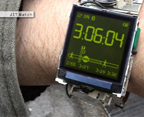
Interview with Martin Frey
Gizmodo Gallery: Networked Accessories and More with Martin Frey :: Interview/Article by Jonah Brucker-Cohen
In the rapidly changing world of consumer electronics and portable devices, a trend is occurring amongst artists and designers to embed social problems and concerns into these objects to shift their intended focus and intent. Taking this credo to an extreme with his work into technologically enhanced objects and accessories is German artist/designer Martin Frey. From creating a watch that keeps track of time and positioning data to guide you towards your destination with his "Just in Time Watch" to integrating GPS and motors into the soles of hiking boots with "Cab Boots", Frey is interested in the connections and clashes between physical realities and digital data displays. Gizmodo recently caught up with Frey to discuss his wide variety of projects and take on the future of interactivity and how designers of technologically enhanced consumer products often expect too much of an investment from their users.
Posted by jo at 05:58 PM | Comments (0)
WOW in real life!
German artist Aram Bartholl did a “World of Warcraft” performance in public space where he had his name follow him over his head. Watch the video above.. he also recently did more of these installations in Gent, Belgium at the Vooruit. See pics . I also did an interview with Bartholl for Gizmodo that can be read here. [blogged by Jonah on coin operated]
Virtualizing the Physical by Greg L: We've had several discussions in the past about comingling virtual world technologies with physical spaces to form augmented realities. (E.g. 1, 2, 3, 4) To give credit where it's due, Jerry Paffendorf has often chimed in with some great links and interesting comments on this topic. (E.g. 1, 2, 3) From time to time, we've also discussed the increasing technological viability of virtual-real mashup games like Human Pac-Man. Continue reading "Virtualizing the Physical" on Terra Nova
Posted by jo at 05:52 PM | Comments (0)
Programmable Media:

Open Platforms for Creativity and Collaboration
Programmable Media: Open Platforms for Creativity and Collaboration :: A symposium organized and presented by New Radio and Performing Arts, Inc., hosted by Pace Digital Gallery :: Date: March 2, 2007 :: Time: 10 am to 3:30 pm :: Venue: Multipurpose Room, 1 Pace Plaza, Pace University :: Contact: Helen Thorington (newradio[at]turbulence.org); Jillian McDonald (jmcdonald2[at]pace.edu). Registration is encouraged: email turbulence at turbulence.org.
In July 2004 the not-for-profit media organization New Radio and Performing Arts, Inc. began the networked_performance blog to chronicle observations that internet based creative practice is expanding due to the ready availability of wireless, mobile, and GPS computational devices and the emergence of the programmable web. We observe that artists, designers and researchers working in digitally networked and programmable environments are increasingly making projects that are media platforms, tools and services which are open and contingent upon participation and the contribution of content to realize them.
Programmable Media: Open Platforms for Creativity and Collaboration, hosted by Pace University, will explore two forms of current practice. First, the creation of original software to create tools and services for creative and social use, such as a freely available 3-D drawing tool and musical instrument, or a public commons meta layer conceived as a continuous public space for collaboration. Second, the creation of original work using the tools available within open platforms such as Second Life and MySpace to build community and raise awareness.
PARTICIPANTS: John (Craig) Freeman, Tom Igoe, Cary Peppermint, Amit Pitaru, Michelle Riel, Helen Thorington, and Mushon Zer-Aviv and Dan Phiffer.
SCHEDULE
10:00 - 10:45 am: Introduction: Social Coding: Tools, Platforms, Systems
Helen Thorington: Turbulence.org's networked_performance blog
Michelle Riel: Siting this Symposium in current practice
Q&A (audience)
10:45 - 11:00 am: Transition
11:00 am - 12.20 pm: Roundtable 1
Mushon Zer-Aviv + Dan Phiffer: The Social Space of the Net: ShiftSpace
Amit Pitaru: Sonic Wire Sculptor
Tom Igoe: Networked Objects: Email Clock & Air Quality Meter & others
Discussion (with moderators)
Q&A (audience)
12.20 - 2:00 pm: lunch break
2:00 - 3:20 pm: Roundtable 2
Cary Peppermint: The Performative Space of the Net
John (Craig) Freeman: Particapatory Installation Art in Second Life
Michelle Riel: Responsive Soft-Biological System
Discussion (with moderators)
Q&A (audience)
Participant Biographies:
John (Craig) Freeman is an artist and educator who uses digital technologies to produce place-based virtual reality and site-specific public art. The virtual reality work is made up of projected interactive environments that lead the audience from global satellite images to immersive, user navigated scenes on the ground. As one explores these virtual spaces, the story of the place unfolds in a montage of nonlinear media. Freeman's work has been exhibited internationally. He has recently introduced it into the 3-D graphical world of Second Life. Freeman is currently an Associate Professor of New Media at Emerson College in Boston.
Tom Igoe teaches courses in physical computing and networking, exploring ways to allow digital technologies to sense and respond to a wider range of human physical expression. Coming from a background in theatre, his work has centered on physical interaction related to live performance and public space. His current research focuses on ecologically sustainable practices in technology development. Along with Dan O'Sullivan, he co-authored the book "Physical Computing: Sensing and Controlling the Physical World with Computers," which has been adopted by numerous digital art and design programs around the world. He is working on another book on networked objects, for O'Reilly Media, due out in 2007. Projects include a series of networked banquet table centerpieces and musical instruments; an email clock; and a series of interactive dioramas, created in collaboration with M.R. Petit. He has consulted for The American Museum of the Moving Image, EAR Studio, Diller + Scofidio Architects, Eos Orchestra, and others. He is a contributor to MAKE magazine and a collaborator on the Arduino open source microcontroller project. He hopes someday to work with monkeys, as well.
Cary Peppermint is a conceptual artist who works with digital technologies and performance art. He is assistant professor of art at Colgate University where he teaches courses in the theory and practice of digital art. Cary is known for his website "Restlessculture.net." which serves as a platform for his ongoing series of networked performances. His latest works engage the concepts of wilderness, space, the American frontier, and environmental ethics and explore how new media technologies both limit and expand our conceptions of nature and the environment, questioning how we live and make art with and in nature. Cary has curated international exhibitions of digitally infused eco-art including, “Technorganic” and “Wilderness Information Network” which both took place in the upper Catskills of New York state. He has been the recipient of numerous awards, including a Franklin Furnace Performance Grant, Experimental Television Workshop Grant, and NYSCA's Decentralization Grant. His work is in the collections of the Walker Art Center, Rhizome.org at the New Museum for Contemporary Art, The Whitney Museum of American Art, and Computer Fine Arts.
Dan Phiffer is a new media hacker from California, interested in exploring cultural dimensions of inexpensive communications networks such as voice telephony and the Internet. Drawing on his computer science background, Dan's software projects seek to provide meaningful creative opportunities through intuitive user interfaces. Dan now lives in Brooklyn, New York and is pursuing a Masters from NYU's Interactive Telecommunications Program.
Amit Pitaru is an artist, designer and researcher of Human Machine Interaction (HCI). Amit cross-palliates his work between a wide range of fields; As an artist, he develops custom-made musical and animation instruments, and has recently exhibited/performed at the London Design Museum, Paris Pompidou Center, Sundance Film festival and ICC Museum in Tokyo. Amit is also a designer with particular interest in Assistive Technologies and Universal Design. He is currently commissioned by the MacArthur Foundation to write a chapter for an upcoming book on his recent work - creating toys and software that are inclusively accessible to people with various disabilities. As an educator, Amit develops curriculums that focus on the coupling of technology and the creative thought process. He regularly teaches at New York University's ITP and Cooper Union's Arts department.
Michelle Riel is associate professor of new media and chair of the Teledramatic Arts and Technology Department at California State University Monterey Bay. Riel collaborates with turbulence.org on the networked_performance blog, documenting and presenting on emerging work that is both networked and live. She is an award winning designer and NEA commissioned net artist. Her current work, antSongs, is a responsive music system collaborating with ants to explore issues of sustainability, community, and globalism.
Helen Thorington is an award winning writer, sound composer and media artist. Thorington is founder and co- director of the independent media organization, New Radio and Performing Arts, Inc., whose projects include the national weekly radio series, New American Radio, Turbulence.org (1996-present), and the networked_performance blog (2004-present). Thorington publishes and presents internationally on these projects. She is currently teaching in the Department of Arts and New Media at Emerson College.
Mushon Zer-Aviv was born in Israel in 1976. He has been involved in and initiated cross-media projects in art, design, comics, animation, online culture and media activism. Co-founder of Shual.com design studio. A teacher at Shekar College of Design & Engineering. An active contributor to Pixelsurgeon.com, Exego.net and Maarav.org.il online magazines. Curated BD4D Tel-Aviv and started Upgrade! Tel-Aviv events, both series aimed at creating and developing the Israeli new-media creative network. Mushon is currently studying at NYU’s Interactive Telecommunication Program.
Posted by jo at 12:12 PM | Comments (0)
Temporal Interference
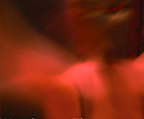
An Exploration of Space and Memory
Temporal Interference: Jane Franklin Dance explores the space memory occupies in a collaboration with digital artist Bryan Leister and composer Gina Biver. This time based performance installation can be seen at Warehouse Theater during two weekends, February 24 - 25 and March 3 - 4. The concept is to explore aspects of space and memory, and how it can effect those around us. Using live video, electroacoustic software and a Theremin, dancers will carve out an environment of sound and color. Biver's compositions will be reinterpreted as the dancers move through space, creating a unique experience of media and modern dance. The media installation will be available for audience interaction between performances.
There will be three performances each day, and will feature several dancers, live video, sound and interactive sculptural elements. For advance tickets and more information visit: http://bryanleister.com/ti/ Read a review >>, and another.
Posted by jo at 11:24 AM | Comments (0)
Lines of Flight

Screenshot - Triptych: Motion Stillness Resistance by Peter Horvath
Lines of Flight :: Opening Reception Friday, February 16, 4-7PM :: Exhibition Tour Saturday, February 17th, 1-4PM :: Hunter College Main Campus 695 Park Ave. NY, NY 10021 :: Main Lobby, West Building and 543 Hunter North Building :: 212-650-3415 :: Curated by: Celina Jeffery and Gregory Minissale.
Artists: Rafael Lozano Hemmer :: Thomson and Craighead :: Peter Horvath :: David Crawford
Lines of Flight addresses the following themes: the lines between technological, scientific and artistic practices from differing cultural perspectives; the negotiated status of the (networked) artist as an agent interacting and transacting in a global context; the flight from the self in collective creativity; spatial mediation suggested by open, interactive, and real time systems; mediation between inclusions and exclusions, insiders and outsiders; and processes of taking flight from the gravity of digital capitalism, digital privilege, and stratification.
Sponsored by: The Leonardo Education Forum, The Hunter College MFA in Integrated Media Arts and Film and Media Department, The Savannah College of Art and Design and Bitforms Gallery.
Directions:
By Subway
The #6 train stops directly under the College at the 68th Street Stop. Major transfer points for the #6 train are: 14th Street-Union Square, 42nd Street -Grand Central, 51st Street & Lexington Avenue, and 59th Street & Lexington Avenue. There is an entrance to the school in the Subway station.
Room 543, Fifth Floor Hunter North
Enter the North Building at the 69th street entrance (between Park and Lexington Avenues). Take the elevators on the left to the fifth floor. Make a left through the double doors. Make a right and proceed to the end of the hall. Room 543 is on the right.
Posted by jo at 11:14 AM | Comments (0)
Furtherfield Blog

Making, Curating, and Translating New Media
The Furtherfield Blog: A shared space for personal reflections on Media Art practice: making it, curating it, translating it.
The Furtherfield blog is a place for Media Arts practitioners to intuitively explore their practice together as it occurs, to develop understanding and to learn, without the pressure to formulate complete arguments or to come up with answers. The blog was set up in Autumn 2006, initially as a place for informal, day to day exchange between members of the Furtherfield.org team, including editor/reviewers. We discovered that this format suits some people more than others and invited a couple more to join. The Furtherfield blog is not intended as a platform to promote particular projects. Instead bloggers explore their own perspectives on their own terms; personal thoughts, emotional responses and critical intentions that are rarely publicly discussed elsewhere in such detail.
Regular Furtherfield bloggers so far, are: - Camille Baker, Ruth Catlow, Aileen Derieg, Marc Garrett, Mark Hancock, Patrick Lichty and Lauren A. Wright.
Posted by jo at 10:37 AM | Comments (0)
Futuresonic +
![]()
CALLS FOR SUBMISSIONS
MOBILE MUSIC TECHNOLOGY :: FOURTH INTERNATIONAL WORKSHOP :: AMSTERDAM, THE NETHERLANDS, 6-8 MAY 2007 :: CALL FOR SUBMISSIONS :: Submission deadline: 12th March 2007
Combining music and mobile technology promises exciting future developments in a rapidly emerging field. Devices such as mobile phones, Walkmans and iPods have already brought music to the ever-changing social and geographic locations of their users and reshaped their experience of the urban landscape. With new properties such as ad hoc networking, Internet connection, and context-awareness, mobile music technology offers countless new artistic, commercial and socio-cultural opportunities for music creation, listening and sharing. How can we push forward the already successful combination of music and mobile technology? What new forms of interaction with music lie ahead, as locative media and music use merge into new forms of everyday experiences?
Scheduling and registration fees will be coordinated with Futuresonic to allow participants to easily attend both events.
THE MAP DESIGNERS :: AT FUTURESONIC 2007 / SOCIAL TECHNOLOGIES SUMMIT :: MANCHESTER, UK, 10-12 MAY 2007 :: CALL FOR SUBMISSIONS
A special event by the British Cartographic Society & Society of Cartographers, focusing on the interface between cartography and cutting edge design. It will draw together map hackers, artists, cartographers, DIY technologists, architects, game programmers, bloggers and semantic web philosophers.
To ensure that we have as wide a range of contributors as possible, we would like to invite suggestions and papers on any of the above subjects for consideration. Please email details of suggested papers or any suggestions for contributions to lynda.bailey2[at]virgin.net.
On behalf of the Map Designers Group of the British Cartographic Society, and the Society of Cartographers.
FUTUREVISUAL AT FUTURESONIC 2007 / SOCIAL TECHNOLOGIES SUMMIT:: MANCHESTER, UK, 10-12 MAY 2007 :: FINAL CALL FOR SUBMISSIONS :: Deadline reminder: Thursday 15th February 2007.
Futurevisual is a celebration of all things audiovisual, with a focus on audiovisual projects which emerge from, reference or are inspired by the transfusion of visual media and visual technologies within music culture, and the mixing of visual culture and music culture.
Futurevisual forms the centrepiece of Futuresonic Live at Futuresonic 2007 in Manchester/UK, and a dedicated space - the Futurevisual Lounge - will be available at the main festival venue for Futurevisual screenings. A selection of works will be shown at partner festivals in South Korea and Brazil, and as part of The Bigger Picture, Big Screen Manchester on a 25 square metre video screen with full sound system situated in Exchange Square, a public area regenerated after the IRA bomb in 1996, that has an estimated daily footfall of 50,000 people.
EVNTS 2007 AT FUTURESONIC 2007 / SOCIAL TECHNOLOGIES SUMMIT :: MANCHESTER, UK, 10-12 MAY 2007 :: FINAL CALL FOR SUBMISSIONS :: Deadline reminder: Thursday 15th February 2007
EVNTS is a strand of the Futuresonic festival which enables artist groups and event organisers to participate in the festival. Since its introduction in 2005, EVNTS has grown into a community of people who each year return to give the festival an extra edge.
Futuresonic now invites anyone working in music or media arts to take part in EVNTS 2007, with the EVNT Competition offering financial support for a limited number of events. Open to any programmer, curator, promoter, label or artist group anywhere in the world, with the focus on ground breaking and new events as well as one-off or adventurous events by established event organisers. Awards of GBP 1,000 and GBP 250 are available for people to stage an event as a part of EVNTS via the EVNT Competition. Proposals will be judged by an independent panel of music, arts and industry figures.
Posted by jo at 10:25 AM | Comments (0)
February 13, 2007
When 1st Life Meets 2nd Life:
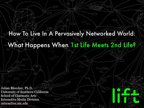
The 1685 Pound Avatar and the 99 Ton Acre
A Second Life avatar produces 1,685 pounds of CO2? And an acre of real estate in Second Life produces 99 tons of CO2? What gives?
One of my pet research projects has been to find ways to establish effective, playful bridges between 1st life and 2nd life. What is 1st Life and what is 2nd Life? By 2nd life, I'm not referring to the virtual world run by Linden Labs. For me, "2nd life" is an evocative metaphor that counterpoints the normal, human, physical, material world, which I refer to as 1st life. I'll grant that the language lacks precision, but I'm relying a bit on my own assumptions, which I think are fairly well-shared, as to what counts as a digital, networked, social environment. 1st life is then the non-networked, non-digital social environment.
The presentation — titled When 1st Life Meets 2nd Life I gave this week at Lift07 started with a reminder as to the material basis of 2nd life. There is "stuff" that undergirds digital networks — indeed every digital bit owes its life to some sort of material. Atoms compose digital data. There's that stuff that we're never really aware of unless we spend time working in the data center facilities where all of the Internets take physical form. 2nd life and its digital networks are made of heavy material — copper cable, steel racks to hold servers, rubber or plastic insulated power cabling, cooling systems, human labor, billions and billions of integrated circuits and the effluvia of the toxic chemicals expelled during their production, shipping and decomposition, etc. Our participation in this materiality probably ends at about the time when we discard the cardboard box and styrofoam packing of the shipping material in which our new computers arrive.
But this is more than the William Mitchell bits & atoms thesis. It's not just the equivalence, but the precise nature of that material — what kind of stuff are we talking about? It's not just the composition of digital bits, but what physical material, in the use of digital bits, of digital networks, of our PC's, web and game servers, is produced.
Perhaps the most unsettling material characteristic of our 2nd lives is considering the resources necessary to maintain them. Whether emailing, googling, blogging, uploading videos, downloading music — everything — this owes a measurable and material debt to first life. When one computes the amount of power — normal 1st life electricity — that is consumed to maintain our 2nd lives it becomes clear what that debt is. Or when one computes how many tons of CO2 emissions result from the production of that electricity, assuming the majority of our power comes from plants that burn something that produces CO2 as a consequence of producing electricity.
I started running these numbers after reading a very interesting and thought-provoking discussion on Nicholas Carr's blog where he computed these figures based on some public figures he found pertaining to Linden Lab's Second Life environment. One could run the same numbers for any other digitally networked activity, like emailing or web surfing or whatever.
What's particularly appealing about choosing an online world like Second Life as my example is that it's underlying metaphor is 1st life. Email would be another good example, as postal mail requires energy that exhausts CO2 in its processing and delivery. But Second Life has more PR these days, so I'll use that as an example.
Second Life itself captures many of the important characteristics of 1st life and uses that to convey a sense of familiarity for the users. There is property in Second Life, waterways, buildings, etc. It's a 3D virtual world that is largely modeled on commonly held assumptions about what counts as 1st life. What it doesn't convey to its users is any kind of Second Life representation of the ecological cost of that Second Life world, which would be very cool — Second Life CO2 emissions, for instance, to correspond to equivalent estimates about how much CO2 is emitted in 1st life.
I was shocked at the numbers on Carr's blog, so I computed them myself to check the math. I revised some of his assumptions, so my figures are significantly more conservative than his. (I'd even go so far as to say that my figures are unrealistically low, because a more rigorous analysis would include estimates about the power consumption of the ancillary network devices between the user's computer and the data center.) I also culled from comments in Carr's blog post to refine some of the assumptions, especially the remarks from Second Life employees who have direct access to some of the power consumption figures.
There are a few additional assumptions I've made, mostly pertaining to what I think is a more realistic assumption as to how much power a typical home PC uses, and how often one might actually play Second Life.
Carr assumes that a home PC consumes 120 watts, which I think is much too low — I assume 300 watts, based on looking at the technical specifications of a mid-range Dell computer, and I also compute the power consumption of an LCD display. I also don't assume, as Carr does, that someone playing Second Life is playing 24 hours a day — I assume, averaged over a year, they will play eight hours per day. Some days they won't play, others they may invest 12 hours. I think 8 hours is a fair assumption.
I've also used the assumption that 1.35 pounds of CO2 is emitted per kWH of electricity produced.
A Linden Labs employee measured the power consumption of their servers and came up with the figure of 175 watts (energy per hour) with the server running at full-tilt. I assume that the servers basically run at full-tilt 24 hours a day, seven days a week, and that servers of this sort make demands on the data center for cooling, power distribution, ancillary resources like lighting, operations center energy costs, keeping the candy and pop machine running in the break room, etc., at an equivalent of 50% of their nominal energy use. So, a 175 watt server actually needs 175+87.5 watts of energy to function in a data center.
I came up with the following figures:
Power Consumption Per Avatar Per Year (Second Life Servers): 153 kWH
Power Consumption Per Avatar Per Year (Home User's PC): 1,095 kWH
Total Power Consumption Per Avatar Per Year: 1,248 kWH
CO2 Emissions Per Avatar Per Year (Second Life Servers): 207 lbs (94 kilos)
CO2 Emissions Per Avatar Per Year (Home User's PC): 1,478 lbs (670 kilos)
Total CO2 Emissions Per Avatar Per Year: 1,685 lbs (764 kilos)
Second Life is composed of regions that have a correspondence to normal 1st life acres. I've learned that there are 16 acres per region, and there are 4 regions per server, so there are a total of 64 Second Life acres per server. That means the power consumption per Second Life acre is 16.8 kWH, or 147,168 kWH per Second Life acre per 1st life year. And that means that 23 pounds of CO2 is produced and exhausted into the 1st life atmosphere per Second Life acre per hour, or 198,677 pounds (90,118 kilos) per Second Life acre per year.
Some equivalence for perspective:
In 2003, the per-capita power consumption in the United States: 13,242 kWH
In 2001, the per-capita power consumption in Iceland: 26,947 kWH
In 2001, the per-capita power consumption in Keyna: 118 kWH
(World Resource Institute, EarthTrends — http://earthtrends.wri.org)
Every year, every Avatar in Second Life produces CO2 emissions equivalent to a typical, honking, bloated, arrogant SUV driving 1,293 miles, based on the assumption that this kind of SUV generates 1 lbs of CO2 per mile.
If serving this page took the CPU on my modest web server .1 second to serve to you, it probably consumed .004 watt (assuming my clunker consumes 100 watts + 50 watts for overhead)..it works out to about 6 micrograms of CO2, not counting whatever your PC contributed to the production of CO2. Okay, I'm getting carried away, but you get the idea.
Why do I blog this? I find this kind of analysis fascinating and revealing. It is the kind of bridge between 1st life and 2nd life I am trying to build, where the semantic link between what goes on in our 2nd life worlds is made plain in its correspondence to 1st life. 2nd life activities are not the clean, sustainable, whole-earth friendly activities the Bay Area, Web 2.0 crew may think they are. Despite the important evolution of human social formations that have arisen, the messiness of the 1st life remains. Maybe there should be a little eco-meter on the dashboard of Second Life, World of Warcraft and, whatever — YouTube and my blog. I'd be interested in computing the same figures for World of Warcraft. I suspect they're probably equivalent, although I'd probably bump up the average hours of play per WoW character quite a bit. I would need to know the distribution of simultaneous characters per server, or number of servers per instance, as well as some sense as to how much power is consumed by whatever server they may use. It's about provoking some thinking about the material contingencies of our online activities. I won't really quibble about the numbers. Someone's going to want me to adjust something this way or that — the accuracy of the figure will be forever elusive, so I'm not interested in debating that, or tweaking some of the numbers. The point is — there is a debt paid for our online lives and we rarely think about it. How can we start to introduce the material aspects of this activity more directly? That is my goal here. [blogged by Julian on techkwondo]
Posted by jo at 04:41 PM | Comments (0)
Wake Up and Hide
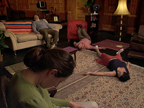
Art that Leaves
Art that leaves the room when you come in by Alastair Sooke; a review of Gary Stevens at Matt's Gallery, London, Telegraph.co.uk,/a>; In pictures: Gary Stevens at Matt's Gallery.
More often than not, works of art stay still. Not so the latest piece by British performance artist Gary Stevens. Wake Up and Hide, his two-screen video installation at Matt's Gallery in east London, is a fiendishly tricksy work that reacts to the viewer. When you walk into the gallery, you see a bunch of larger-than-life people silently staring at you from two almost identical oak-panelled interiors.
That in itself is fairly disconcerting, like wandering into a party to be confronted with a sudden, deathly hush. But it's nothing compared to what happens next. As soon as you make a noise – a cough, a footstep, a rustle - everyone on screen scarpers. On the left (Hide), five performers hurry to hide around the room: behind a bookcase, under the stripy sofa, wrapped up in a red plush curtain.
On the right (Wake Up ), another five leap up with cartoonish mannerisms – arms windmilling, grimacing expressions of exaggerated surprise – before sprinting out of shot like the slapstick Keystone Kops (Stevens's inspiration).
And that, believe me, is far, far more uncomfortable, like turning up at a party to find that your arrival prompts a rush for the door. People talk about portraits with eyes that follow you around the room, but I can't think of any work of art that actually leaves the room when you come in.
Stick around and stay quiet, though, and the 10 performers gradually return. In Hide, they re-emerge one by one, heads popping up from pieces of dark, heavy furniture like meerkats sniffing the wind for danger in an Attenborough doc.
In Wake Up, they come back looking tense, backs and necks ramrod-straight.
Then, if you do nothing, they start to unwind. In Hide, they gain confidence, venturing into the open, sizing each other up with sly, slanting looks. In Wake Up, their stiff postures begin to droop until, like melting snowmen, they seep on to the floor.
But make a noise, picked up by one of four sensitive microphones rigged up in the ceiling, and both videos jumpcut to another segment of film.
As before, one load of performers suddenly disappears around the room. The others vamoose. It's like playing peekaboo or grandmother's footsteps.
To create such a technical tour de force, Stevens uses tech-geek wizardry. Each time a sound triggers footage of the performers scurrying away, a computer selects one of five subtly different "narratives" tailored for both screens.
In one loop, a performer plays the piano; in the next, another starts to smoke.
Assuming you let them, of course. At first, Wake Up and Hide makes you feel unpopular: I tiptoed around to avoid disturbing the people on screen.
But as you figure out how the sound-sensitive installation works, you begin to clap or talk loudly so that the actors scramble at your beck and call. The piece provokes a strange, vaguely omnipotent rush.
That said, you can never get them to do exactly what you want. Which means that Wake Up and Hide functions as a witty satire of our interactive, press-the-red-button, you-decide-who-goes age.
In Stevens's world, we – the spectators – are blunderers, clumsily controlling the work only to disrupt it. If we send the performers skittering, we won't discover how the films unfold when left to play undisturbed.
And if we stay quiet so that the films unspool, then, really, the performers are the ones controlling us. It's a situation that would send Jade Goody's mind into meltdown. Until March 18. Information: 020 8983 1435
Posted by jo at 03:54 PM | Comments (0)
Audio Kinematics
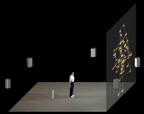
Virtual Audio Sculpture
Audio Kinematics, by Jost Muxfeldt, works with the idea of kinematic relations on the level of sound: a virtual audio sculpture. It utilizes the spatial relations and proportions of a mechanical structure to determine various parameters of a sound composition, and creates a kind of virtual kinetic sound sculpture.
MobileThe motions in the current realization are based on the principle of a mobile. This principle is base on a binary tree structure combined with circular motions. Since the motions of the individual nodes are always circular, they can over time be described with a series of sine waves added to each other . The motion of one node is thus described by the amplitude modulation of the sine wave of the parent node. Thus the motion is closely related to one of the most basic principles of audio synthesis.
The entire structure allows for a total sound experience in which the progression over time is determined on the one hand by the choice of the actual sound components, and on the other hand by the distance and motion of these components in relation to the listener. The listener becomes the center of an sound environment whose shape and timbre changes over time by means of its specific spatial mechanics.The motion is simultaneously projected on a screen so that the listener can follow the mechanics of the sound visually as well. [via]
Posted by jo at 03:31 PM | Comments (0)
Slamdance Post-Mortem:
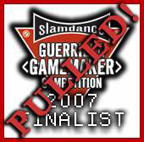
A Discussion about Games as an Expressive Medium
Time: Wednesday, February 14, 6-8pm :: Location: USC's Robert Zemeckis Center for Digital Arts (RZC), Room 201 Zemeckis Media Lab (ZML).
Join Danny LeDonne (Super Columbine Massacre RPG), Sam Roberts and Peter Baxter (Slamdance Festival), Kellee Santiago and Jenova Chen (flOw, thatgamecompany), and Tracy Fullerton (EA Game Innovation Lab) in an open discussion about the recent controversy surrounding the Slamdance Guerilla Gamemaker Competition. The pulling of LeDonne’s Super Columbine Massacre RPG from the contest resulted in a protest which saw over half the festival finalists pull their own games from the competition, the IMD pulled our own sponsorship of the event in support of the protest, and the festival ended with the remaining finalists voting to forgo all awards in light of the protest. At the root of this controversy lie several important questions: Are games an expressive medium? Should they be protected as “speech” under the First Amendment? Should we hold them to a different standard of content then media such as films, literature, painting or theatre? Where can provocative, independent games be seen and celebrated if not at venues such as Slamdance? Bring your opinions and be ready to participate. This may be the most important issue facing independent gamemakers in the coming years. [posted by sfisher on USC Media Division]
Posted by jo at 03:16 PM | Comments (0)
Bits, Bytes and the Rhetoric of Practice
![]()
Call for New Media Artist Statements
NMC Call for Papers :: Spring Edition, 2007 :: Theme: Bits, Bytes and the Rhetoric of Practice: New Media Artist Statements :: In this edition of media-N we invite new media arts practitioners to submit personal artist statements and examples of their practice. The commentary (no more than 500 words) should describe the work and contextualize it within the field of new media practice and ideas. In addition, include a short biographical statement (no more than 100 words) at the end of your artist statement.
Event reviews: The editorial board also invites proposals for reviews of exhibitions, events, festivals, conferences, etc. See examples of reviews in the current issue.
Submission deadline: April 30 2007 :: Paper format and media format: We seek artist statements of no more than 500 words, with an additional biographical statement of no more than 100 words. Please use a standard word-processing program such as Microsoft Word. PC and Mac versions are both acceptable. You may use italics, boldface, and diacritics, but do not use HTML tags. It is best to send the review as an email attachment in Microsoft Word. Please do not cut and paste the review into the body of an email, as formatting may be lost or changed in the e-mail transmission.
Include no more than 20 examples of artwork (this could be still images, video clips, audio clips, etc, as applicable.) Media Formats: jpeg, avi, swf and additional formats on case by case basis (mov/mpeg/wav/aiff). Be sure to attach these files separately as well as in the body of the text.
[·] Media-N author's agreement is available from the 'Copyright Statement' link
[·] Send manuscripts via email to: Rachel Clarke, Editor in Chief (rclarke[at]csus.edu)
Posted by jo at 12:10 PM | Comments (0)
IDEOLOGY of the IMAGINARY in the 21st century
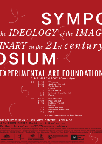
Exploring Cross Issues of Art, Culture and New Media
IDEOLOGY of the IMAGINARY in the 21st century: a symposium and exhibition project exploring cross issues of art, culture and new media :: 1st and 2nd MARCH, 10am - 4pm :: MERCURY CINEMA, Lion Arts Centre, North Tce, Adelaide. ADMISSION FREE. LIMITED SEATING. PLEASE REGISTER: Email your name, address, and how many attending to info[at]eaf.asn.au
Despite the numerous "tech-specific", or "future looking" events, appearing daily on the world stage, it is worth noting that we are almost at the end of the first decade of this century, and yet the discourses which we are using are quite old - postmodern at its best!
The Symposium is therefore aimed at defining the concepts and processes characteristic for the beginning of the 21st century. Some of the themes the speakers are urged to visit: What are the decisive theoretical and practical developments of this decade? How has the ideological framework of images shifted in the 21st Century? How can we measure the real power of these images? Are some aesthetic categories or concepts of the late 20th century already obsolete? Are there new categories appearing on the horizon?
Bio-technology and other wireless, or less so, technologies are offering themselves to us quite openly, but perhaps more important are the hidden, underlying processes in our society, which we seem to constantly neglect.
Symposium convened by Melentie Pandilovski
SPEAKERS: Andreas Ströhl . Tania Fraga . Mark Pesce . Melentie Pandilovski . Paul Majkut . Hélène Frichot . Anna Munster . Friedrich Kirschner + video appearance by Roy Ascott.
ROY ASCOTT \ Syncretic Strategies: A pioneer of cybernetic and telematic art, Ascott is an internationally renowned artist, theorist, and educator. Roy Ascott is the founder and President of the Planetary Collegium, the Director of its CAiiA-Hub, and Professor of Technoetic Art in the University of Plymouth, England. He is Visiting Professor in Design|Media Arts at the University of California Los Angeles. AscottÅfs work has been shown at the Venice Biennale, Centre Pompidou Paris, Ars Electronica Linz, V2 Holland, Milan Triennale, and European Media Festival, Osnabrck.
TANIA FRAGA \ Envisioning Possibilities for Computer Art & Design: Tania Fraga is a Brazilian architect and artist. She holds a PhD on the Communication and Semiotics Program at the Catholic University of Sao Paulo (PUC) with a Post Doctoral at CAiiA-STAR. She was Professor and Co-ordinator of the Graduation Studies of the Art Institute at University of Brasilia, Brazil, from 1987-2004 and member of the Advisory Research Committee of the Banff New Media Centre in 2003, Canada. She was Visiting Scholar at the Computer Science Department at The George Washington University, Washington DC, 1991/1992 and Artist-in-Residence at The Bemis Foundation, USA, 1986, with a grant from the Fulbright Commission.
HÉLÈNE FRICHOT \ An Ethico-Aesthetics for Wet Architectures: Helene Frichot is a senior lecturer in architectural design and theory at RMIT University, Melbourne, Australia. While architecture is her first discipline, she holds a PhD in Philosophy from the University of Sydney. Helene co-curates the RMIT University Architecture + Philosophy Public Lecture Series
www.architecturephilosophy.rmit.edu.au
FREIDRICH KIRSCHNER \ Playing games differently: Friedrich Kirschner is a filmmaker, visual artist and board member of the Academy of Machinima Arts and Sciences. He re-purposes computer games to create animated narratives and interactive performances. His work has been shown at various international animation festivals and exhibitions, including the ZKM Karlsruhe, the American Museum of the Moving Image in New York, the Ottawa international Animation festival and the Seoul Media Art Biennale. He also published machinimag, an online magazine focussing on the development of the emerging art form of machinima moviemaking. www.zeitbrand.net
PAUL MAJKUT \ Cool Media, Cold Consequences: Paul Majkut, an award-winning investigative journalist, is Professor of Literature in the College of Letters and Science, National University, San Diego, California, and international lecturer. Majkut has twice been awarded a Fulbright Scholarship.
ANNA MUNSTER \ Crowds, Power and Portable Media: Anna Munster is a writer, artist and lecturer in the area of electronic and new media arts and is a Senior Lecturer at the College of Fine Arts, University of New South Wales.
MELENTIE PANDILOVSKI \ The Fundamental Change: Melentie Pandilovski is the Director of the Experimental Art Foundation. He was initiator and Director/Curator of the annual Skopje Electronic Arts Fair, the first internet and media art manifestation in the Balkans, and has written extensively on the present state of media arts and the future of technology and arts.
MARK PESCE \ Appropriations and Distributions: One of the early pioneers in Virtual Reality, Mark Pesce is a writer, researcher and teacher. The co-inventor of VRML, Pesce is the author of five books and numerous papers on the future of technology. He is currently an Honorary Lecturer at the University of Sydney, and is a judge on The New Inventors a nationally syndicated ABC television program in Australia. He maintains several blogs, including Hyperpeople, which deals with the enormous changes in media, and Yeschaton, which tracks developments in the sciences. He is currently working on a film-Man with a Movie Tube-drawn entirely from appropriated YouTube clips. His Sydney consultancy, FutureSt, develops media strategies for a rapidly changing technological environment.
ANDREAS STRÖHL \ Apparatus Images-How the Apparatus Swallows Meaning and Projects Ideology Andreas Ströhl was Director of Cultural Program of the Goethe Institute in Prague until 1997 and since 2004 has been Director of the Munich International Film Festival.
EXHIBITION
TANIA FRAGA, Responsive Membrane :: 2 MARCH - 5 APRIL (11 - 5 Tuesday - Friday, Saturday 2 - 5)
LEV MANOVICH, Soft Cinema :: 2 MARCH - 5 APRIL (11 - 5 Tuesday - Friday, Saturday 2 - 5)
Presented in conjunction with the Symposium The Ideology of Imaginary in the 21st Century in association with the 2007 Adelaide Film Festival.
Curated by Melentie Pandilovski
This project has been supported by the Australian Government through the Australia Council, its arts funding and advisory body.
EXPERIMENTAL ART FOUNDATION curates its exhibition program to represent new work that expands current debates and ideas in contemporary visual art. The EAF incorporates a gallery space, bookshop and artists studios.
Lion Arts Centre North Terrace at Morphett Street Adelaide * PO Box 8091 Station Arcade South Australia 5000 * Tel: +618 8211 7505 * Fax +618 8211 7323 * eaf[at]eaf.asn.au * Bookshop: eafbooks[at]eaf.asn.au * http://www.eaf.asn.au * Director: Melentie Pandilovski
The Experimental Art Foundation is assisted by the Commonwealth Government through the Australia Council, it arts funding and advisory body and by the South Australian Government through Arts SA. The EAF is also supported through the Visual Arts and Craft Strategy, an initiative of the Australian, State and Territory Governments.
Posted by jo at 11:42 AM | Comments (0)
February 12, 2007
Marginalia in the Library of Babel
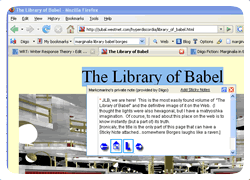
Diigo Fiction
Marginalia in the Library of Babel [in progress — alpha release]: "It starts with Borges. It always starts with Borges, the god of our hyperlinked souls. I fight the solitude of the vertigo he has imagined for me, and yet I may have finally found a way out of the labyrinth.
At night, I search for Borges, alone, hunched in the solitary chamber of an internet browser. If I was not seeking him, I’d be seeking myself. And I already know where I am and the speck size of my shadow on the Web."
Diigo Fiction: Marginalia in the Library of Babel: [This post offers context for a work-in-progress entitled Marginalia in the Library of Babel. alpha release.] Let us write stories in the margins of the Web: The web is becoming ours to write with. Whether supplying, ranking, or reviewing its contents or reordering the web with our folksonomic tagclouds, we are becoming the owners of more than just our Craig’s list and Ebay possessions. We are orchestrating this web and making of it what we will. Jeremy and Matt Kirschenbaum have reported on the moments when the tagclouds become art (see inset image made via TagCrowd.com). And now the web pages themselves have become our surfaces, our building blocks. Here’s how… More >> [blogged by Mark Marino on WRT]
Posted by jo at 06:08 PM | Comments (0)
What is the Avatar:
![]()
Fiction and Embodiment in Avatar-Based Singleplayer Computer Games
In this study I will suggest a theory of the avatar in singleplayer computer games1, and discuss how avatar-based games are different from other kinds of computer games as well as from other kinds of media. I believe that a closer study of the role of the avatar will cast light on some of the central aesthetic parameters that structure both how we play and why we play computer games.This knowledge will also have potential implications for our understanding of other formats and genres in the wider domain of digital media and culture. The notion of the avatar that I am suggesting is not concerned with playable characters as a vehicle of communication and self-expression, but addresses how players engage with singleplayer gameworlds through fictional and vicarious embodiment. This approach connects computer game avatars to a broader category of avatars, from radio-controlled model planes to Lego men and paper dolls. In computer games, the vicarious body can take different forms; a character, a racing car, a rolling ball, a camera, a gun.
The emphasis on the role of the avatar also reflects a theoretical concern with the notion of embodiment and the notion of fictionality in computer games. My general claim is that the concepts of ‘fiction’ and ‘representation’, as these are typically being employed in game research and analysis, should be critically discussed and revised. Game studies needs a new concept of fiction, which can better account for the relationship between play and simulation, and which is more sensitive to the distinctive characteristics of computer-simulated and screen-projected gaming environments. This re-orientation needs to question the assumption that ‘fiction’ is synonymous with recounted (or diegetic) fiction, and it needs to be able to address the different mechanisms of embodied interaction and corporealized pleasure that are involved in computer game play. My analysis of avatar-based play in computer games is meant as a step in this direction2. Continue Reading What is the Avatar: Fiction and Embodiment in Avatar-Based Singleplayer Computer Games by Rune Klevjer’s [via]
Posted by jo at 02:58 PM | Comments (0)
Net(works): Art and Pre-Existing Web Platforms
![]()
Call for Papers
Net(works): Art and Pre-Existing Web Platforms: Call for Papers - Southeastern College Art Conference :: October 17-20, 2007.
Beyond using the internet as a way to show representations of visual and performance work, artists have been using pre-existing dynamic content web sites as the actual site of the work. One of the first projects of this nature included Keith Obadike selling his blackness on eBay. More recently, Cary Peppermint’s Department of Networked Performance, an educational situation, uses MySpace as its host. The Gif Show also used MySpace, appropriately, as a parallel site for a curatorial project in real space about the aesthetics of low-bit production. A public art competition and gallery shows have suddenly been popping up in Second Life, a virtual world created by users and inhabited by their avatars, which interact with each other in real-time.
Questions raised may include, but are not limited to: How are artists currently using these and similar spaces? Are these projects considered interventions, or otherwise? Are these spaces appropriate for undergraduate education projects? How do real curatorial spaces intersect with these virtual spaces? What do these spaces, with or without the art world, mean within visual culture contexts? Please propose your presentation as it pertains to any field - practice, history / theory / criticism, museum studies, and/or education.
Patrick Holbrook, Georgia College & State University :: Email: patrick.holbrook[at]gcsu.edu
Posted by jo at 02:28 PM | Comments (0)
February 10, 2007
Emergency Room
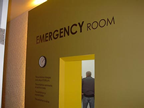
The Current Pulse of the World
Emergency Room at PS1/MOMA - ER NYC :: February 8 - March 19, 2007 :: Opening Reception: February 11, 2007 12-6pm :: Raphaele Shirley, Lee Wells, and Paul Middendorf exhibit new collaborative works and installations.
Everyday there are topics which seem ignored or under represented by the media, such as the war, genocide, global warming and more. It is important to keep finding clues and links which would reveal new evidences on the reality we are living in. It is important to seek and redefine what constitutes the news as it seems to the mainstream media is fairly myopic (using censorship through omission) about what is really going on around us. The emergency room group will be replicating the idea of a set format, as the news media have which will be the base structure, image, the pictorial context of expression. Working to generate an iconic image, logo and memorable framework, the images will be disfigured or added to on a daily basis, creating a log, a trail, of emergency events. Fragments of paper, written notes, video, and performance will unfold a picture for the public. The transient and fast paced environment coupled with the premise of the installation is a great opportunity to experience a new form of artistic expression, experimenting and focusing intensely on the moment and the current pulse of the world.
Raphaele, Lee, and Paul are artists who are specializing in political critique, public interventions and collaborations. The triangle created between these artists will generate a dialogue, a smoke signal path, and a critical exchange related to what constitutes the news and how this can be expressed within this context. Varying in mediums used, alternating freely between live video, internet, performance, painting, photography and installation according the needs of the moment we will document everyday, each day at PS1. Using the fabric of the city as our palette of expression and source of news, bringing back to Emergency Room fragments of urgency and emergency. Emergency Room is a constantly evolving collaborative exhibition conceived and led by artist Thierry Geoffroy, a.k.a. Colonel.
Emergency Room is motivated by a desire to learn what other artists think about current affairs from varied international perspectives under strict time constraints. By providing a physical space in which artists can display works made in reaction to current events, Emergency Room takes the pulse of the artistic community today. On each day of the exhibition, artists will install new work in response to the events of the last 24 hours, an arrangement that recalls daily news cycles. The artworks stay on view until the next morning when they are moved to an adjacent archive space and replaced by new work.
Participating Artists: Jaishri Abichandani, Kamrooz Aram, Victor Ash, John Avelluto, Toby Barnes, Bill Beirne, Niels Bonde, Steven Day, Mike Estabrook, Frank Franzen, Charley Friedman, Nancy Friedmann, Deborah Grant, Jean de Piepape, Jens Haaning, Sophie Hjerl, Vandana Jain, Amy Kao, Lasse Lau, Shaun Leonardo, Peter Lind, Caroline Lund & Thorbjørn Reuter Christiansen, Al Masson, Marc Mer, Paul Middendorf, Mac Premo, Lisi Raskin, Susanne Schuricht, Raphaele Shirley, Lisa Strömbeck, Henrick Vibskov, Lee Wells.
Biographies
Paul Middendorf is living and working in Portland, Oregon as an artist and curator. In 2000 Paul received his BFA from The School of the Art Institute of Chicago and began launching his career as a painter. Currently Paul works as Director and Founder of Gallery Homeland. He has shown nationally and internationally, and most recently produced and performed in Scratching the Surface in Portland Or, Lifeboat-Miami for Art Basel's International Art Fair, Lifeboat-Hamptons for The Scope Art Fair, and was co-curator for Waterways, an Istanbul Biennale project. Paul is still an active artists and curator working across the globe. www.manifestartistry.com
Raphaele Shirley lives and works in NYC. She specializes in collaborative projects and Public Art installations and events. She has exhibited nationally and internationally in interventionist projects such as ³Waterways² and ³Two Continents and Beyond² in the Venice (2005) and Istanbul Biennales (2005) and has shown recently in the Art Basel Video Lounge curated by Michael Rush. She has co-created several experimental projects including PAM Perpetual Art Machine and The New York International Fringe Festival. She works in diverse mediums ranging from sculpture to photography, video and sound.
Lee Wells is an artist, exhibition organizer and consultant currently living and working New York. He has been exhibited internationally for over 10 years, including the 51st La Biennale Di Venezia, Contemporary Arts Center in Cincinatti, Museo d'arte Moderna e Contemporanea di Trento e Rovereto and most recently included in the Art Basel Miami Beach Video Lounge curated by Michael Rush. He is a co-founder and director of IFAC-arts, in addition to co-founding, [PAM] the Perpetual Art Machine. www.perpetualartmachine.com, Cinema-Scope director for Scope Art Fairs and site editor for www.rhizome.org at the New Museum of Contemporary Art.
Posted by jo at 06:38 PM | Comments (0)
Meme: Romanticism
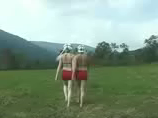
5 Cinematic Productions
Meme: Romanticism :: Organized by Michele Thursz :: February 16, 2007- March 31, 2007 :: Opening Reception, February 16, 6:00-8:00 pm :: Gallery Hours: Wed. through Sat., 12-6 PM :: EFA Gallery, EFA Studio Center, 323 West 39th Street, 2nd Floor, New York, NY 10018 (between 8th and 9th Avenues) :: Artists: Tobias Bernstrup, Jeremy Blake, Claudia Hart, Michelle Handelman, Reynold Reynolds and Patrick Jolley, and Carlo Zanni.
Meme: Romanticism examines five artists' cinematic productions that utilize technological aesthetics, cultural symbolism, historic compositions, and narratives to expose the conceptual underpinning of Romanticism. The exhibition will be set up like a theater, with viewing times allocated by length of the video. The room will have a sound system and projection with seating for the viewer's comfort, so they may enjoy the works. The waiting area will be set up as a traditional gallery space with prints derived or inspired by the films, but still functioning as unique objects.
The exhibition includes the artist collaborative feature film Sugar and prints by Reynold Reynolds and Patrick Jolley; Mantis City, a video and print by Tobias Bernstrup; Winchester Trilogy, videos and print by Jeremy Blake; The Possible Ties Between Illness and Success, an interactive video and prints Carlo Zanni; This Delicate Monster, video and prints by Michelle Handelman; and The Swing, 3-D animation and prints by Claudia Hart.
Romanticism as a movement emerged in the late 1700s. Artists took a stance against formal aesthetics to define art as a place for sentiment, nature, and the play of the imagination. This was an idea of art in which individuals shared their subjective realities with the public. Since that time, technologies of representation have advanced from still to moving images, from early cinema to Hollywood films to personal computers and the Internet. A social medium of representation unfolded with the capability to archive and to edit histories, identities, and geographies. These capabilities allow the public to participate in fantastic situations. Movies became popular because they reflect the dreams, fears, or fantasies of a mass public. The impact of Hollywood film and mass media is intriguing sociologically: How does consumer culture affect the personal? How does it effect the way people define their own identities?
Artists of the 50s and 60s started using the machinery of commercial culture to create and engage a broad public. This tendency was later identified as "Pop". Today's contemporary artist raises the ante of the Pop aesthetic by creating works that reflect our communal experiences. Communality is the key to the success of the movies and mass media; both use the tactic of bringing together a general consensus and the popular. The market and the media are based on the human need to shareempathy, opinion, and historymaking the media generative by the public and the media reflecting back and forth on each other.
In the contemporary art context these cinematic or communal works become the romantic concept of the Gesamtkunstwerk, the total work of art. The exhibited works are cinematic and poetic by the nature of their production and their narratives. They reference historic compositions to create an emotional outlook on nature. These works are also a good index of the values and needs of our society because they are invested in our cultural life. In them the hierarchies and histories of art making is deconstructed and reapplied to these artists' craft and aesthetics, aligning theirs artistic intention with the ideas of romanticism.
Meme: Romanticism suggests that Romanticism was more than a formal movement of the past but successful in changing and adapting with the times and the exigencies of historyand with the needs contemporary art making.
Michele Thursz is an independent curator. Recently she has been appointed as the director of NY Projects, an international art advisory and production company. Her previous projects include Post Media Network; Post Media is a term and action demonstrating the continuous evolution of uses of media and its effect on artists practice, and culture-at-large. Thursz' recent curatorial projects include Thread, Wood Street Gallery, Pattern: Modernism as Mediator, Borusan Gallery, Istanbul, Cine-O-matic, The New Museum, public.exe: Public Execution, Exit Art, NYC, and Democracy is Fun, White Box, NYC. Contact: michele.thursz[at]gmail.com
This exhibition is presented by the EFA Gallery, a program of The Elizabeth Foundation for the Arts. With additional support from The Helen Keeler Burke Charitable Foundation, Peter C. Gould, Materials for the Arts, and Carnegie Corporation Inc. and many generous individuals.
The EFA Gallery is a curatorial project space. Through the gallery, The Elizabeth Foundation for the Arts supports the creative work of independent curators. Curators build the framework in which we understand artists and the art they make. At their best, they redefine how we look at culture. The Elizabeth Foundation for the Arts believes in the essential importance of art in a civil society. The value of the artist's creative spirit is not limited by age, race, nationality or acceptance by others.
DAILY SCREENINGS, Wednesday through Saturday:
Winchester Trilogy: 12PM, 2PM
Mantis City: 1PM, 3PM
This Delicate Monster: 1:30PM, 3:30
Folly & Error: 1:40PM: 3:40
The Possible Ties Between Illness and Success: 1:50, 3:45PM
Sugar: 4-6PM
The Swing and the prints are in the main gallery.
ROUGH DRAFT OF VIDEO SYNOPSISESavailable at meme-romanticism.blogspot.com
For further information:
Elaine Tin Nyo, Director
T. 212-563-5855 x203, F. 212-563-1875
elaine[at]efa1.org
Posted by jo at 12:07 PM | Comments (0)
February 09, 2007
Virtual Muckraker Interviewed By MIT Brain
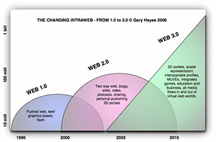
Henry Jenkins + Peter Ludlow
MIT’s Henry Jenkins has a great interview with our Muckraker-in-Chief over at the Second Life Herald, Peter Ludlow (aka SL’s Urizenus Sklar). In fact, it’s the first part of a two-part interview, the second part of which should be coming tomorrow. [UPDATE: Read part two.] There’s great stuff here on the importance of “local” or “community” journalism to virtual worlds. Tomorrow we’ll hear from Peter on the current debate that’s raging over Second Life, and more on governance in virtual worlds. Recommended reading. [posted by Mark Wallace on 3pointD]
Posted by jo at 06:03 PM | Comments (0)
iSummit 2007
![]()
Call for Artists in Residence
Artists in Residence program launched for iSummit '07
At this year's Summit (Dubrovnik, Croatia: 15-17 June, 2007), iCommons will be launching a new and improved Artist in Residence program, based on the success of last year's undertakings by Nathaniel Stern, the Artist in Residence at the iSummit 2006. This year's program will be bigger and better – we'll be expanding the program to include more artists, more collaboration and a dual exhibition – in a physical space at the art workshop, Lazareti and in a virtual gallery in Second Life.
Essential to the success of the program is, believe it our not – you. We would like you to suggest an artist from your country, whom we will consider when awarding the residency. Or even better, if you are an artists, don't be shy, add your name too. All you need to do is go here and add an artist's name.
Based on the suggestions from the community, we'll be picking two artists from the Croatian region and three international artists to participate in the residency. We're looking for artists who produce both in the physical and digital world; individuals who engage with copyright in some way - either by using Creative Commons licenced content as their inspiration, or by licencing their work under CC; or artists who simply challenge the boundaries of copyright law.
During the residency, the artists will be exploring different themes around what it means to be an artist creating in a digital world. The following topics will be investigated during the residency, and a workshop will be run by the artists at the Summit, based on the following themes:
• Different working modes: how do artists work with open content in their medium?
• Different presentation methods: what is the archival value of art made available online?
• Sustainability models: how do artists embrace 'copyleft' but still manage to pay the rent?
Nathaniel Stern will be coordinating the artists in their conceptual journey. The residency will officially start two to three weeks before the Summit, as a 'virtual' residency over e-mail or chat, when all the artists will start conceptualising and discussing these themes. The artists will arrive in Dubrovnik one week before the start of the Summit, so as to begin the hands-on work of creating their masterpieces.
The deadline for suggestions on potential participants for the Artists in Residence program is Monday 12 February.
Assistant to the Executive Director: iCommons
+27 11 327 3155/3201 (Office)
Skype/Aim: danielafaris
Posted by jo at 05:38 PM | Comments (0)
The Future of Electronic Literature

Invitation to Attend
The Future of Electronic Literature: A Symposium of the Electronic Literature Organization and the Maryland Institute for Technology in the Humanities (MITH) :: Keynote speakers Kenneth Thibodeau (NARA) and N. Katherine Hayles (UCLA) :: Thursday, May 3 :: McKeldin Library, Special Events Room (room 6137), University of Maryland, College Park :: co-sponsored by the University Libraries, Department of English, and Human-Computer Interaction Lab. $20 (plus lunch) for those who are not affiliated with either the ELO or the University of Maryland.
Participants: Sandy Baldwin (West Virginia University), Laura Borras Castanayer (Universitat Oberta de Catalunya, Spain), helen DeVinney (University of Maryland), Neil Fraistat (University of Maryland), Bertrand Gervais (Université du Québec à Montréal), Juan B. Gutierrez (Flordia State University), N. Katherine Hayles (UCLA), Rob Kendall (Independent Writer and Scholar), Matthew Kirschenbaum (University of Maryland), Margie Luesebrink, aka M.D. Coverley (Irvine Valley College), Mark Marino (University of Southern California), Talan Memmott (Indepenent Writer and Scholar), Nick Montfort (University of Pennsylvania), Scott Rettberg (University of Bergen), Susan Schreibman (University of Maryland), Stephanie Strickland (Independent Writer and Scholar), Thom Swiss (University of Minnesota), Joe Tabbi (University of Illinois-Chicago), Kenneth Thibodeau (National Archives and Records Administration), Jill Walker (University of Bergen), Noah Wardrip-Fruin (UCSD).
Registration and additional information: http://www.mith2.umd.edu/elo2007/
Open Mic/Mouse: There will be an open mic/mouse on the evening of Wednesday, May 2, starting at 6:15 in Art/Soc 2203. Many of the symposium attendees will be reading/performing from their current and favorite works of electronic literature, and everyone will be welcome to take a turn at the mic/mouse. A great way way to encounter this exciting body of writing for the first time. Free and open to the public, no registration required.
Further information: helen DeVinney, Managing Director, ELO hdevinney[at]gmail.com or (301) 314-6545. Press contact: Matthew Kirschenbaum, Associate Director, MITH: mgk[at]umd.edu or 301-405-8505.
Posted by jo at 05:18 PM | Comments (0)
The > I4 < International Conference
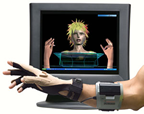
Interactivity / Information / Interfaces / Immersion
I4: Interactivity / Information / Interfaces / Immersion :: International Research Conference, J W Goethe University, Institute of Cultural Anthropology and European Ethnology :: Organized by the Research Network for Media Anthropology / FAME, Frankfurt :: October 24–26, 2007.
Even before the emergence of social software, web logs and wikis, it was clear that digital communication technologies are, in essence, complex social software programs with the power to change people’s perception, the way people experience their environment, their ability to abstract, their rules of trust, and much more besides. Whereas the 1980s and 1990s were marked by “quasi-social” connections between people that occurred en passant, by strategies of urban artistic “repurposing” (Digital Amsterdam), by a conspiracy of Internet-using consumers, and by a user-based cyber society, the situation has now changed fundamentally.
There has been a shift from technology-driven systems to media-driven systems and then to user/project-generated content. As the empiricism of the artificial becomes a global given, social, cultural, economic and political frames of reference are shifting. Countless new and unparalleled means of modeling social factors are emerging within a mesh of agencies around the world. Digital natives – those who have grown up with computer and internet applications – have spawned a societal and cultural paradigm shift. Societal and cultural geography is being extended by a global scenography of cultural artifacts. However, this raises important issues concerning the logic of the continuity of interaction, of a reliable and sustained presence, of adaptive learning and abstraction – issues that have become social markers in the programming, utilization, and onward development of applications, platforms and environments.
Increasingly, today’s designs and programs for digital worlds face the challenge of delivering complex, multisensory, transcultural, and global interaction capabilities in a robust technology-based environment. The changes are creating a need for the explicit modeling of human collaboration and cultural interaction which, increasingly, is causing software production to move out of the high-tech niche of computer science and media design into the realm of cultural and social anthropology. At the same time, there is a growing need to know more about the logic of construction (v. Glaserfeld) of culture and to be able to apply that knowledge. The need for explicit and programmable cultural concepts is moving closer to the science of the artificial as proposed by Herbert A. Simon and echoes Norbert Elias’s call for the scientific presentation of a developmental theory of abstraction.
Clearly, it would be wrong to assume that explicit, programmed models for collaboration, the creation of cultures, abstraction and artificial environments can eradicate the complexities of chance relationships, interaction, imagination, fiction, routine, or forgetfulness. Nonetheless, the possibilities they offer will be changed fundamentally by the emergence of programmed worlds and environments. All over the globe, artificial cybernetic spaces are something now taken for granted. Computer technology is designed to be ubiquitous, and the direct control of computers by means of brain waves is supplanting control by means of a pointing device or the human eye. Presence and telepresence, key concepts in earlier research, are receding into the background with the advent of computer technologies which can be inserted under the skin, into clothing, and into the eyes and ears or can generate realities in their own right without which the frames of reference of today’s and tomorrow’s realities will become meaningless. Ten years ago, S. Jones asked, “Where are we when we are online?” and J. Meyrowitz noted “being elsewhere.” Electronic games, e-sports, and around a billion people working in countless local area networks all exist in a vireality (M. Klein). What are the living, communication and working circumstances in these virealities? How should virtual spaces be designed in order to provide sufficiently complex environments for perception, design, decision-making, routine, trust, etc.?
The > I4 < International Conference addresses the emergence of complex collaboration and community software.
We assume that all human sensory and mental capabilities and the ability to abstract, conceive and implement things are, and have been, involved in the development of human ability to use media.
The concept of media encompasses perception, abstraction, storage, rules for the retention of information – of texts and holytexts, the great sagas, manifestations of cultural memory – and progression beyond existing knowledge paradigms. It is impossible to determine how perception and interaction will impact on media, either qualitatively or quantitatively. If the notion of a uniting organization is seen as a selection method or principle, the weight of these ideas becomes clear. They show that every form of interactive reciprocity is a selector and that the uniting force of interactivity lies in the definition of selection, distribution and retention criteria. This applies to methods of hearing, reading, writing, tasting, thinking, making music, and much more besides.
Increasingly, we expect and demand more from media – more information, more breadth of choice, more freedom of choice, more world, more closeness, more entertainment, more biography, more community: We want media to address us, entertain us, inform us. This is about more than consuming media. Our sense of reality has long since been subsumed into a sense of media; our sense of reality is embodied in our sense of media. We take the world presented through media seriously, we recognize the reality of information; we trust the information and the rules that make it credible.
The conference will be devoted to questions surrounding digital environments and the technology-based generation of cultural patterns in four areas: Interactivity / Information / Interfaces / Immersion. We invite submissions which explore these issues and offer answers to such questions as:
What connections can we currently identify between software development and cultural evolution? What significance can be attached to co-evolutionary processes in perception, abstraction, forms of virtualization, digital technologies and communication capabilities? What kinds of virtual spaces are developing? How are digital communication spaces influencing urbanization processes and the architecture of buildings? What significance does game software have in creating new social and cultural contexts? What kinds of cooperative and collaborative processes are developing? What are the defining properties of an explicit model of social constructs in a technology-based media environment? How are means of digital communication influencing children’s and adults’ living spaces and interior architecture? How can a transition from the idiocy of the masses and the knowledge of the crowd into a knowledge-generating virtual community be explained? Can we see signs of an emerging virtual civilization? How will network-integrated community building be important in the future? How are learning and the structure and legitimation of knowledge changing?
Please submit ideas for topics and papers (500 words max.) by March 31, 2007
Initiators and contacts:
Prof. Manfred Faßler
FAME – Frankfurt/ Research Network for Media Anthropology, Institute of Cultural Anthropology and European Ethnology J W. Goethe University fasslermanfred[at]aol.com
Dr. Mark Mattingley-Scott
Institute of Cultural Anthropology and European Ethnology
J W. Goethe University
scott[at]de.ibm.com
Posted by jo at 05:06 PM | Comments (0)
After convergence, what connects?
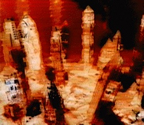
Call for papers
:: fibreculture :: has established itself as Australasia's leading forum for discussion of internet theory, culture, and research. The Fibreculture Journal is a peer-reviewed journal that explores the issues and ideas of concern and interest to both the Fibreculture network and wider social formations. Papers are invited for the 'After convergence' issue of the Fibreculture Journal, to be published early in 2008. Guest editors are Caroline Bassett (Sussex, UK), Maren Hartmann (Bremen, Germany) and Kate O'Riordan (Lancaster/Sussex, UK).
Everything that arises does not converge. A more variegated landscape emerges as processes of digitalization, crystallizations of an intrinsically technological-social, continue re-shaping cultures and re-working societies, not in their image, but into something new. It is increasingly obvious that there is no digital behemoth, no single form, no single function, no New World Order. Rather a series of reconfigurations, reformulations, new functions, new contents, new spaces, new grounds, new uses, have emerged and are emerging within global media networks.
There are guidelines for the format and submission of contributions at http://journal.fibreculture.org. These guidelines need to be followed in all cases. Contributions should be sent electronically, as word attachments, to: Guest editors: Caroline Bassett (c.bassett[at]sussex.ac.uk), Maren Hartmann (maren.hartmann[at]uni-bremen.de), Kate O'Riordan (k.oriordan[at]lancaster.ac.uk).
In response to the (not unexpected) non-arrival of the unifying beast, which is to say in response to the perceived exhaustion of convergence (or the re-definition of its limits), new disciplinary islands are being declared with 'keep out' and 'invented here' signs all over their beaches. In other words there has been a balkanization of techno-cultural investigation. Thus gaming scholars define themselves against internet scholars, or film scholars, locatives stand distinct from screeners. Particular groups of sub-specialists claim particular modes of inquiry: ethnographers for everyday life, speculative theory for digital art, for instance. Indeed, entire vocabularies, originally invoked in a spirit of general experimentation, are now corralled, restricted and defended by particular groups. If these vocabularies often seize up in the process, refusing to say more than they were meant to say, and in particular refusing the unorthodox connections between the empirical and the speculative, the possible and the desirable, that gave them their energy in the first place, nobody seems to notice.
So, there is no behemoth. At the same time we insist that connections are produced and so a question we consider worth addressing is not what unites digital forms as one, but what connects them together as many. Further we want to explore how these connections are made. We are less interested in doing that through mainstreaming a particular critical approach (which is to say drawing different areas back under one critical umbrella, making that the connection), than we are in trying to think about exploring/defining/critiquing some of the shared characteristics of different digital media formations. We believe that despite the exhaustion of convergence metaphors, and the rise of disciplinary sub-divisions, these connections remain crucial.
Papers addressing but not limited to the following topics are welcome:
* Media/Medium Theory
* Difference between and specificity of New Media forms
* Issues, Limits, Problems of Convergence.
* Re-thinking the vocabulary of Affect/Emotion/Perception
* Histories of New Media Theory
* 'Technology and Cultural Form' revisited?
* Methodologies
Deadlines:
* 250 word abstracts: due February 28th 2007
* Completed Paper: due September 30th 2007
* Expected Publication: February 28th 2008.
Posted by jo at 04:39 PM | Comments (0)
Giant Painting Machine
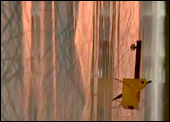
Generative Sound/Painting
Giant Painting Machine (Milano) :: mylar, ink, motors, wood, mounting hardware, electronics (2006)
Giant Painting Machine is a simple electro-mechanical system built largely from found parts and scrap materials. It paints complex and dynamic abstract images on four transparent walls by tracing continuous, cycling paths across large sheets of clear mylar. Because GPM is a wiggly mechanical device, the nature of its brush strokes is constantly changing, and its conceptually smooth, arcing lines are full of smudges, drips, and wobbles.
Simple switches and a DC motor controller guide the paintbrush across the canvas. The path of the brush is determined by the relationship of the dimensions of the canvas to the speeds of the motors. The speeds of the motors constantly ramp up and down, resulting in curved, rather than straight, lines. The brushes are filled with acrylic inks in various colors. Mixing decisions are made on the fly, with each wall focused on a certain color.
GPM was first commissioned for a large jewelry fair. We installed four hand-shaped metal detectors that could be used to influence the paths of the paint brushes. When metal jewelry was placed on one of the hands, the corresponding brush changed direction. The generative sound for GPM was created with a customized, self-modifying version of Larry Polansky's Anna's Music Box software.
Giant Painting Machine (Milano) was commissioned by MUR and the MORE Jewelry Fair in Milan, Italy. It ran eight hours a day for four days during Fashion Week 2006. [via Neural]
Posted by jo at 09:34 AM | Comments (0)
Second Life

Energy Consumption of an Avatar
From Energy Consumption of an Avatar in Second Life: He quotes Philip Rosedale, the head of Linden Lab, the company behind the virtual world: "We're running at full power all the time, so we consume an enormous amount of electrical power in co-location facilities [where they house their 4,000 server computers]. We're running out of power for the square feet of rack space that we've got machines in. We can't for example use [blade] servers right now because they would simply require more electricity than you could get for the floor space they occupy."
If there are on average between 10,000 and 15,000 avatars "living" in Second Life at any point, that means the world has a population of about 12,500. Supporting those 12,500 avatars requires 4,000 servers as well as the 12,500 PCs the avatars' physical alter egos are using. Conservatively, a PC consumes 120 watts and a server consumes 200 watts. Throw in another 50 watts per server for data-center air conditioning. So, on a daily basis, overall Second Life power consumption equals:
(4,000 x 250 x 24) + (12,500 x 120 x 24) = 60,000,000 watt-hours
or 60,000 kilowatt-hours
Per capita, that's:
60,000 / 12,500 = 4.8 kWh
Which, annualized, gives us 1,752 kWh. So an avatar consumes 1,752 kWh per year. By comparison, the average human, on a worldwide basis, consumes 2,436 kWh per year. So there you have it: an avatar consumes a bit less energy than a real person, though they're in the same ballpark.
<...>
UPDATE: In a comment on this post, Sun's Dave Douglas takes the calculations another step, translating electricity consumption into CO2 emissions. (Carbon dioxide, he notes, "is the most prevalent greenhouse gas from the production of electricity.") He writes: "looking at CO2 production, 1,752 kWH/year per avatar is about 1.17 tons of CO2. That's the equivalent of driving an SUV around 2,300 miles (or a Prius around 4,000)." [posted by Felix Stalder on nettime]
Posted by jo at 08:48 AM | Comments (0)
February 08, 2007
My First Second Life Dance Performance
On Sunday night, while watching the Super Bowl, I attended the premiere performance of Second Life Ballet's "Olmannen" in the Second Life virtual world. I wrote about this upcoming performance last week.
Well, I had to give myself a crash course in Second Life to attend this performance because I've never experimented with this virtual environment. But just about everything went wrong on the computer and software side for me, which I'll explain more about below.
But first, here is background about the Second Life Ballet performance so you can have an idea of what an avatar dance performance is like:
- The program guide for the performance of "Olmannen: An Original Ballet."
- A news piece from OspreyTherian, uploaded to YouTube, recaps the Sunday night performance. You can see the dancers in the background for a few seconds, which gives you a glimpse of what dancing is like in this virtual world: More >> [blogged by Doug Fox on Great Dance]
Posted by jo at 07:29 PM | Comments (0)
2006 Alternate Reality Games White Paper

Performance Art
"[...] Beyond games and texts about games, performative art has sometimes used ARG strategies to break Brecht's "fourth wall." The traditions of performance art and guerrilla theater have, in retrospect, resembled ARGs in this way. This historical connection suggests a possible ideology for ARGs, in terms of performance art’s political and psychological activism. One may detect a trace of this in Jane McGonical’s account of ARG players wanting to participate in the war on terror11. Ray Johnson’s Zen-like practice of sending his art to galleries and correspondents is relevant here. As depicted in the biographical documentary How to Draw a Bunny (2002), Johnson’s mail art struck recipients as puzzles to be solved. The boundaries of each piece, like a good ARG puzzle, had to be determined in the course of exploration – what was a pun, what a bagatelle, what connected to which external referent?
Performative art can also intertwine an artist’s content with everyday life beyond either street theater or the gallery. For examples, Janet Cardiff has developed her Walks series since 1991. The audience experiences sounds through portable recorders as they walk through locations, the contents of which are largely or entirely native, rather than created as part of the project. As the description of a 2005 instance reads, Cardiff creates augmented realities: interactive works where visitors are asked to touch, listen and move through environments layered with visual and aural narratives. At a less avant-garde level, historical reenactments resemble both ARGs and performance art. Their encampments, fairs, spectacles are not as intrusive to outsiders as performance art can be, since they are formally and clearly demarcated. But the plunging down a rabbit hole of ARG play, the sense of immersion into a world extending very far beyond one’s ability to encompass, is a key part of the reenactor experience. Summoning up a historical moment, be it the seventh century, the American Civil War, or Jane Austen’s time, literally creates an alternate reality within our own..." Read 2006 Alternate Reality Games White Paper [PDF]. [via]
Posted by jo at 06:53 PM | Comments (0)
1001 nights cast
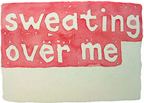
February 10: Performance #600
1001 nights cast will reach another milestone this Saturday: Performance #600 from Sydney on 10 February at 7.53pm which is: 5:53pm in Perth :: 8:53am in London :: 9:53am in Madrid, Paris and Berlin :: 11:53pm in Beirut, Jerusalem and Istanbul :: 3:53am in New York, Toronto and Bogota :: 12:53am in Los Angeles.
If you'd like to read any past stories please go to the new FASTER archives pages.
Since the half way mark was passed in early November, these new contributors have written for the project: Kristin Hannaford (Central Qld); Sam Twyford-Moore (Newcastle, NSW); Kate Richards (Sydney); Cecilia Berth (Sydney); Myo Sei Murphy (Sydney); Sam Grunhard (Japan); Folake Shoga (UK); Lesley Stern (San Diego); Adam Possamai (Sydney); Cathy Naden (Vancouver); Eileen Myles (San Diego); Mary Paterson (London); Colin W Gore (Sydney); M John Harrison (London); Beth Jackson (Brisbane); Josephine Starrs (Sydney).
The project will be moving again to the northern hemisphere, departing Sydney and arriving in Los Angeles on night 666 (April 17)! Stay tuned for time change updates.
Posted by jo at 06:30 PM | Comments (0)
Digital Art Weeks 2007
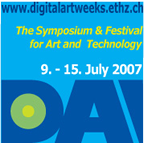
THE CITY AS AN INSTRUMENT
THE CITY AS AN INSTRUMENT: The call concerns itself with the use of the city as an expressive instrument or place of artistic practice. This may vary from art whose subject is the city to art, which is actually performed in a city. Special attention is given to telematic art practices in which activities within the city bring about changes and responses at another open or closed space.
Interactivity may take place between the open and closed space in equal relationship, but in many projects in this area the activities often take place within the open space, (City Streets, a Park, Parking Lot, Public Building) and "consumed" in the closed space (Movie theater, Gallery, Living Room, Bar, Toilets)
CALL: The Digital Art Weeks 2007 invites Artists to submit proposals for open public spaces. We are seeking works that use any form of networking that either connects performers within the space used or connects them in some form between spaces used.
DEADLINE: Friday, 2nd March 2007._Notification of acceptance of proposals will
be sent out on or before Friday, 2nd April 2007. For more information regarding the call please write to: daw-perfs[at]inf.ethz.ch or http://www.digitalartweeks.ethz.ch
Posted by jo at 06:26 PM | Comments (0)
Digital Art Weeks 07

B.I.O.: To Be the Input or the Output is the Question
B.I.O.: To Be the Input or the Output is the Question: In the popular sci-fi film The Matrix, the human being is reduced to a copper-top battery with an output of 1.5 volts. In regard, tapping the human body as an output has become an interesting way to "power up" performance and stage presence in the electronic music and new media art genres.
Creating controllers that respond to brainwaves, galvanic response and heart rate have brought us innovations in creating and performing art with voluntary and with an involuntary signals. The performers activities on stage are therefore expanded and at the same time ironically reduced to near non-activity on stage. Further, using biofeedback brings the artist into the realm of using the human body as an input whose output is clearly linked.
The DAW07 invites artists to submit work that concentrates on the use of sensors systems that take their inputs from the human body and whose outputs are then transmapped to audio or video sources. Any type of interface that is designed to use human body signals to control outside sources and artworks that use such transmapping falls into the call's profile.
DEADLINE: Friday, 2nd March 2007. Notification of acceptance of proposals will be sent out on or before Friday, 2nd April 2007. For more information regarding the call please write to: daw-perfs[at]inf.ethz.ch or Digital Art Weeks 07.
Posted by jo at 06:22 PM | Comments (0)
February 07, 2007
lifelogging

On The Record, All the Time
On The Record, All the Time: Researchers digitally capture the daily flow of life. Should they? By SCOTT CARLSON, The Chronicle of Higher Education.
The first day I came home with a digital audio recorder hanging around my neck, along with a sign that said "Warning: This conversation may be recorded," my wife shook her head in a way that conveyed deep embarrassment. Then she said: "Have you ever heard of Nixon?"
On the train to work, my fellow commuters did double takes and snickered. People sat down next to me, then got up and moved to another seat. One woman saw my sign and hushed her friends: "Look, he's recording." Another fellow told me that someone was going to beat me up over my little stunt. Once a conductor gave me such a severe look that I thought he would throw me off the train at the next stop.
In the grocery store, clerks asked me if I was doing some kind of crazy university study. Sort of, I replied. "You're recording your life all the time?" people said. "Why would anyone want to do that?"
Good question. I had been asking a handful of researchers the same thing. Many of them are documenting all their conversations, movements, ideas, and correspondence through audio recorders, digital cameras, GPS trackers, pedometers, brain scanners, and other gadgets. The data they collect are mainly fodder for research, as they try to figure out how people might organize and make use of a deluge of information collected in business, medical, and social settings.
But they also predict that in the future everyone is going to be "lifelogging" — continually recording images from their vacations, conversations from business meetings, and even intimate confessions to friends.
"I fully believe that we will all be wearing this stuff all the time," said Mark T. Bolas, a visiting associate professor in the film school at the University of Southern California, as he hung a digital voice recorder around his neck when we met a few months ago. "The day before you die, your kids are going to look at you, when everybody else is doing this, and say, You mean you didn't record when you were growing up? You're just going to die and all of this is going to go away?"
Jim Gemmell, who leads lifelogging projects for Microsoft Research, says that we will one day glean information from our own lives the same way we now get information from Google.
"The personal corpus is going to enable you to be more reflective and come up with better ideas," he says.
If that sounds unreal, step back and consider how many digital pictures you took last year compared with how many photographs you took 10 or 20 years ago. Consider that the latest cellphones are equipped to record video and track your location. Think about the countless lives already documented on Web sites like Flickr, MySpace, YouTube, and Facebook.
A laboratory at Queen's University at Kingston, in Ontario, is working on a camera that starts recording when its wearer makes eye contact with another person — one of many lifelogging projects in academe. Later this year, major electronics companies will start selling gadgets and tools specifically designed for lifelogging, says Alex Pentland, a professor in the Massachusetts Institute of Technology's Media Lab and a pioneer of wearable computing. His lab is supported by some of those companies, and he is working on lifelogging tools that can decide, on the fly, whether a moment is worth recording.
But as they push into a future that is totally on the record, lifeloggers are also pondering and fretting over how this technology will alter society. What can lifelogging do for us? Could it improve scholarship? What are the legal risks? And how will lifelogging affect personal relationships, private conversations, and family histories?
I wanted to find out for myself. I went to an electronics store and bought a digital voice recorder for $100. I set up a time to talk with a lawyer who knew something about wiretapping (I had no desire to be a test case for lifelogging lawsuits), and I began to contemplate how life might change after I pressed Record.
***
Lifeloggers trace their history back to 1945, when Vannevar Bush, a prominent American scientist, wrote an essay for The Atlantic Monthly called "As We May Think." Scientists deal with an increasingly unmanageable trove of data and other information, Mr. Bush wrote, but technology could help. Mr. Bush imagined scientists wearing little cameras on their heads to record lab work. He conjured an image of a desklike machine that could store thousands of pages a day in microfilm. He called his device a memory extender, or "memex" — a term that some researchers use today to describe their own suite of lifelogging tools.
In the 1990s, MIT's Media Lab began dabbling in lifelogging through wearable computers, under the direction of Mr. Pentland and other researchers. Steve Mann, an associate professor of computer engineering at the University of Toronto who was once Mr. Pentland's student, wrote about his experiences wearing various recording devices in his book Cyborg. "One day," he wrote, "we will all feel naked without our wearable computers."
In the early 2000s, the federal Defense Advanced Research Projects Agency embarked on lifelogging research of its own. However, the project coincided with newspaper reports about the Total Information Awareness project — a huge government database that would have tracked Americans' electronic lives — which was causing angst among privacy advocates and the public. Darpa backed off and recast its grants to concentrate on lifelogging for soldiers on the battlefield.
Around the same time, Microsoft Research took up lifelogging with a project called MyLifeBits, which is devoted to figuring out how to store vast amounts of lifelogged information and how a lifelogger might find important kernels in a pile of chaff. The project's guinea pig is Gordon Bell, a 72-year-old computer engineer and entrepreneur who is recording every conversation he has, snapping pictures of every event he attends, saving every e-mail message he sends or receives, and even tracking himself through GPS, then archiving that information. So far, he has amassed some 160 gigabytes of data, more than the hard-drive space on most people's computers.
Mr. Gemmell says he has found that a lifelogger can home in on a recorded event — a conversation about a new idea with a colleague at a conference, for example — by associating it with other memories. He says it is not possible to search for specific words or phrases in an audio record, the same way you might search a document, to find a specific detail, at least not yet. But you might remember that the conversation happened in a specific city, on an overcast day, during the conference's opening reception. You could use GPS records, weather data, and your calendar entries to triangulate and the find the digitized "memory."
"We have so many little hooks in our memories, and we think associatively, so the more we bring in to the corpus, the more we find it's possible to find something," Mr. Gemmell says. In 1945, Mr. Bush said traditional library indexing, an "artificiality" based on letters and numbers, wouldn't work for his memex. Instead, the awesome "intricacy of trails" of memory would lead people to information.
***
But once you store all that stuff, what do you do with it? Microsoft Research offered grants of money and equipment to find out what university researchers could come up with. The proposals that came in surprised Mr. Gemmell.
Many of the winning projects deal with health. Doctors already record physiological data, like heart rhythms, through mobile devices, but researchers imagine that lifelogging tools could give physicians an even clearer picture of the factors influencing a person's health. Lifelogging itself could even be a form of therapy.
For example, Anind Dey, an assistant professor of computer science at Carnegie Mellon University, is using digital photos to try to exercise and improve the memories of early-stage Alzheimer's patients. He uses a lifelogging device invented by Microsoft Research called a SenseCam — a little black box, with a fisheye lens, that hangs around a lifelogger's neck and automatically snaps a picture about once a minute. A day recorded by a SenseCam looks like a stop-action film.
In the research, Mr. Dey is trying to figure out which visual cues are useful in prompting memories, and whether he can add other cues — like the day's temperature or information about an event — to trigger stronger ones.
Other researchers, like Alan F. Smeaton, are trying to find automated ways to navigate lifelogging data. Mr. Smeaton, a professor of computing at Dublin City University, in Ireland, specializes in video, and his research team has created programs that can scan video and automatically find, say, action sequences. They are now recording their days with SenseCams and creating programs that will scan the pictures to find significant changes in activity, which will help locate the most interesting events.
Along the way, his researchers have recorded the significant and the banal. One has an entire record of the first time he met his girlfriend and of their first date. Now and then a researcher forgot to cover up the camera when going to the restroom. Half-joking, Mr. Smeaton says he should invent a "bathroom detector or a white-tile detector" among the video-processing programs, so he can cut those scenes out of the record.
People have become accustomed to surveillance cameras that are used to combat terrorism in Ireland and England, he says, so he found that wearing the SenseCam was not controversial. But when he started dabbling in audio recording, many people objected, even the young geeks and techies in his department. "We had to have a 'whoops' button that deleted the previous minute," he says.
***
Audio lifelogging is socially taboo, legally treacherous, and, occasionally, emotionally jarring.
Daniel P.W. Ellis, associate professor of electrical engineering at Columbia University, knows this from having recorded his daily life for almost two years. About half the people he met were uneasy or annoyed when he told them he was recording them. His wife banned logging at home because she found it "creepy," he says.
Like Mr. Smeaton, Mr. Ellis is developing ways to pluck out useful clips from all that audio. Through analysis of the background noise, he is able to figure out where he was at any particular time — walking on the street, lecturing in class, meeting in his office, riding in the elevator, and so on. Then he can match that analysis with his electronic calendar to get a fairly accurate diary of what he was doing and whom he was talking to over the course of weeks or months. He can also click on the calendar entry and listen to the audio.
He sees his system as a powerful organizational tool, like an automated datebook. He recently met with officials at Google about his work, but nothing has come of it — yet. "They were interested," he says. "Some people there obviously felt that it fell within their scope."
Lately he has become interested in keeping the recorded conversations private. He has found that he can scramble the voices so the conversations are unintelligible but the speakers are still recognizable to the computer.
Privacy is not an abstract issue for him. His recordings, now archived on a pile of compact discs, sit on a bookshelf in his office. He took them out and set them on the table as he discussed his work.
"There are times when I think we're out of our depth here," Mr. Ellis says. "There are things that you don't want people to know about you and things you don't want to know about yourself."
Once, for example, Mr. Ellis and his wife got into an argument as they were leaving for vacation. That night he realized he had recorded the fight, which is somewhere in that pile of discs. "I never went back to listen to it, but there exists that recording of me being an asshole," he says. "I don't particularly like the idea of that existing."
On another day, his toddler fell down some stairs and hit his head on a stone floor. Mr. Ellis and his wife rushed their son to the hospital, and as Mr. Ellis was talking with the doctors about his son's condition, he realized that he was recording the whole event.
"We were in the waiting room, making conversation, and the doctor said, 'What's that on your belt?' I said, 'Oh, that's my MP3 player,'" Mr. Ellis says. "For all kinds of reasons, it didn't seem like something I wanted to raise at that point. When you're in that situation, it's like, Please just help me. I don't want to threaten you at all."
His son was fine, but Mr. Ellis has no desire to relive the memory. "The whole sequence of him falling exists in these recordings — him freaking out, and us saying that we've got to get him to the hospital. That's something that I've never gone back to listen to. I could, but it would be too upsetting."
I told Dan Ellis that I was planning on recording my own life for a few weeks, and he said that I would learn what he was talking about firsthand. Before I left, he offered to process my recordings when I was done.
***
If you're wondering whether lifelogging is legal, the answer is that it seems to be — at least in most settings, most of the time.
Emilio W. Cividanes, a lawyer in Washington who specializes in wiretapping issues, told me that I needed to consider wiretapping and eavesdropping laws when it came to recording my life. In most states, you need the consent of at least one party when recording conversations, but in 12 states, including Maryland, where I live, you need the consent of both parties.
However, says Mr. Cividanes, the laws in most states say that people in public places should not necessarily have an expectation of privacy, and therefore may be recorded, even without their consent. (Lifelogging in Illinois, Massachusetts, and Oregon would be risky, as those states have both strict laws for consent and no allowances for recording in public, he says.) Any legal case would rest on facts and circumstances, he explained.
I decided to play it safe and hang a sign around my neck announcing my recording to the world.
I was a freak. At the farmers' market, the man who sells Communist Party newspapers picked me out right away. "So if I told you my name" — and he told me his name and some information about himself — "you would record all of that?"
"I just did," I said.
Out in public, no one asked me to turn off my recorder, but few people went out of their way to talk to me. In the office, colleagues asked me to turn off the recorder every other day, usually to relate a juicy bit of gossip or gripe about some office drama. Journalists are accustomed to the conventions of going off the record, even in private life.
My wife, who is also a journalist, banned recording at home for the first week because she said I acted like I was "on stage." I had noticed that, too. I never really forgot that the recorder was on, and now and then I sensed I was talking differently, as if to a crowd. I consciously avoided saying things that might be deemed politically incorrect or downright gross, although some of that slipped out and into my memex.
One weekend I got tired of wearing the recorder and put it in a drawer. I felt liberated in a way that is hard to describe. That Sunday I found myself pacing the house and whispering to no one — something I often do when I'm alone and trying to work out ideas for stories I'm writing. I realized I rarely did this when I had the recorder on. It was like I was afraid someone would catch me acting schizophrenic.
But I'm probably the only person who will ever listen to the recordings, so what was I worried about?
Jeffrey Rosen, a law professor at George Washington University and an expert on privacy, explains my anxiety through a concept from Jewish law called hezzek re'iyyah, or "the injury caused by being seen." Jewish law says that the mere possibility of unwanted observation, even if no one is really watching, injures a person's sense of privacy.
"It's the uncertainty about whether our intimate moments are going to be observed that makes us more inhibited and less likely to let down our hair," Mr. Rosen says.
We act differently depending on whether we're with our family, our friends, or our business associates, a social flexibility "necessary to cultivate the bonds of intimacy," Mr. Rosen says. "If the goal of the lifeloggers is to record real life in intimate and formal contexts, they would have to be defeated in some respects because the candor would dry up."
Anyone who has ever thought seriously about privacy would shudder at the thought of a lifelogged world, Mr. Rosen says. "The standard techno-positivist enthusiasm — that this is inevitable and that we should get used to it — is wrong and dramatically understates the social cost of this sort of technology," he says. Louis Brandeis, the Supreme Court justice who wrote the most famous treatise on privacy in American law, "would be turning over in his grave," Mr. Rosen says.
Science fiction has warned us of this future. In his Hugo Award-winning book Hominids, Robert J. Sawyer created a parallel universe in which Neanderthals (that world's dominant and highly advanced humanoid species) wear recorders on their arms that upload data to an "alibi archive." The society is free of crime, but even innocent people face punishment if they don't have alibis.
The Final Cut, a 2004 film starring Robin Williams, depicted a near future in which microchips implanted in human brains record everything a person sees and hears from birth. After death, a "cutter" edits those memories into a flattering biopic for friends and family, finding and deleting disturbing images of, say, spousal abuse or child molestation. "How can you handle it?" a retired cutter says to a workaholic colleague. "People lying to each other, manipulating each other. The obscenity!"
Lifelogging researchers are well aware that their work treads philosophically, socially, and legally treacherous territory, and they take steps to protect their data. Mr. Bolas, of Southern Cal, considers other people's words their property, and he stores his files on a hard drive that is off the network and safe from hackers.
But who knows what the future holds? Leana Golubchik, an associate professor of computer science at the University of Southern California, has raised a nightmare scenario among lifeloggers in which authorities can subpoena details about private lives from lifelogging archives. Others have wondered whether lifelogging copyrighted information, like going to a movie, or picking up songs on the radio, could put someone at risk for infringement.
The lifeloggers have grappled with how technology and society might adjust to their new world. Perhaps lifeloggers could program their gadgets to record only those people who grant permission, and the machines could scramble everything else. Perhaps society will just come to accept pervasive surveillance and the end of plausible deniability.
At the same time, the researchers are interested in how lifelogging might change society in positive ways.
"Nobody could ever lie again," says Mr. Bolas. "Nobody could ever commit a crime again." In the lifelogged future, "a verbal contract is just as good as a written contract."
Jane Greenberg, an associate professor of information and library science at the University of North Carolina at Chapel Hill, is studying the ways that undergraduates use lifelogging tools to enhance their learning in a biology course. She imagines that lifelogging would allow her to be more productive, to reflect on her work, and to review forgotten ideas from the past.
There might be personal and historical advantages, too — something Ms. Greenberg and her colleagues wonder about together. "Wouldn't it be cool to have your grandfather's memex?" she says. "And wouldn't it be cool to have your memex and hand it down to somebody? This is me, these are my recordings."
Or, she wonders, what if future world leaders or other important figures had memexes? "It would be interesting if our president had one on," she says.
***
My father frequently tells a sentimental story about a day when he, as a 6-year-old, woke up before dawn to find my grandfather getting ready for his job on the kill floor at a meatpacking plant in St. Paul. My father asked my grandfather if he liked to work. "Not really," my grandfather replied flatly. "But there are just some things you have to do to take care of your family."
My father cherishes that memory for what it says about my grandfather's sense of loyalty and duty. Of course, it may have never happened. My father could have imagined it as a boy and later come to believe it was a memory. There was no recorder hanging around my grandfather's neck, so we'll never really know — and we may not want to.
In his book Mystic Chords of Memory, Michael Kammen, a historian at Cornell University, points out that people are in a constant process of forgetting, recasting, and re-remembering their histories to reflect and reinforce their values and beliefs.
In a lifelogged world, people would probably continue to romanticize the past, Mr. Kammen says in an interview, but lifelogging would operate as a reality check on some events.
He points out that technologies for recording everyday life go back as far as George Eastman's Brownie camera, which came on the scene more than 100 years ago. "Microhistory of individuals and families is not a new phenomenon, but [lifelogging] is a fascinating example of new technologies making it possible to do this in a deeper and richer way," he says. "What these people are doing is going to be a treasure trove for historians."
That is not a universally held point of view among historians, however. Jill Lepore, a professor of history at Harvard University, says some of the appeal of her profession is the intrinsic mystery of people and the stories she can pull together from scant evidence.
"There is no part of the sensibility of total recall of the minutiae of my life that appeals to me, and encountering another human being through that medium as a researcher feels a little unsavory," she says.
"If I could know what George Washington was thinking when he wrote his will, emancipating his slaves — sure, I would like to know that," she says. "Would I want him exposed to me in a way where I couldn't even have the curiosity of that question? ... It seems horrible."
Even if lifelogging catches on — and Ms. Lepore is skeptical — she wonders whether the records would be of any use to historians. Statesmen and other important figures are not likely to leave an unfiltered archive behind, she says. "Those are the people who historically burn their papers or have their wives burn them when they die."
***
I thought I would erase my electronic memory when I was done with my experiment. Over a few weeks I had amassed a mess of files — some stored at home, some at the office — that amounted to about 200 megabytes for each recorded day. The files contained a lot of dead air, as the recorder captured me typing, driving, or walking. But the files also contained embarrassing moments and secrets that belonged to me and my friends. I decided I could not send them to Mr. Ellis at Columbia for processing. I knew that destroying them would be the safest thing to do.
But so far, I haven't had the will. The recorder had captured funny stories and moments that were worth saving. It had logged night after night of reading books to my 4-year-old son before bed and some of the funny things he said out of the blue, and may never say again. Somewhere in its memory is the moment I heard my baby daughter say her own name clearly for the first time — I just haven't been able to find it yet. I wondered whether my kids would want a record of a day in the life of their father when they got older.
Mr. Ellis said he experienced a "nostalgia effect" when he listened to some of his old lifelogs, and even after just three weeks I felt it. On the weekend I left the recorder in a drawer, my wife and I got to talking about what our son was like when he was a baby, and we realized that even after a few years we couldn't remember what he looked like or sounded like, or the things he said when he first started babbling. It was one of the few times I regretted not wearing the recorder more often.
In the end, I saved my lifelogs onto a disc, then hid them in my home. Maybe someday I will comb through them, pick out the good parts, and destroy the rest. Unless an audio-scanning program for lifeloggers hits retail shelves soon, that project could take weeks. For now, I'll hold these memories close.
SOME NOTABLE MOMENTS IN RECORDED LIFE
1900s: The Brownie camera makes photography available to the masses.
1940: President Franklin D. Roosevelt begins recording press conferences and some meetings.
1945: Vannevar Bush, a prominent American scientist, predicts a time when scientists will be photographing their lab work and storing their correspondence in a machine called a "memex."
1960s: Presidents John F. Kennedy and Lyndon B. Johnson record meetings and phone conversations for posterity, which later provides hundreds of hours of programming for C-Span.
1969: The microcassette goes on the market and becomes the voice-recording medium of choice.
1973: An American Family, documenting the domestic drama of the Louds, is the first reality-TV show.
1973-74: President Richard Nixon releases the Watergate tapesjust some of more than 3,500 hours of conversations that he had recordedwhich leads to his resignation.
Late 1970s: Steve Mann, a professor at the University of Toronto, begins dabbling in wearable computing.
Mid-1980s: Fitness nuts are wearing stretch pants and leggings, along with wristwatch-sized devices that measure heart rate and blood pressure. The heart monitors can cost $200 or more.
1991: The first Webcam goes online.
Mid-1990s: Cellphones, digital cameras, and the Internet become commonplace.
1995: Gordon Bell, a computer engineer and entrepreneur, gets involved with Microsoft Research and begins work that will lead him to record various aspects of his life for the MyLifeBits project.
1999: Microsoft Research invents prototype SenseCams, cameras that hang around the neck and continuously snap pictures.
2000: Scrapbooking has a renaissance, leading to new retail stores devoted to a hobby industry now worth $2-billion.
2003: MySpace debuts. 2004: The Final Cut, starring Robin Williams, describes a future where memories are recorded on implanted chips. The Defense Advanced Research Projects Agency drops a lifelogging project amid a furor over privacy. A workshop on the "Continuous Archival and Retrieval of Personal Experiences" convenes at Columbia University.
2005: YouTube appears.
2006: Nokia releases Lifeblog 2.0, which allows people to upload audio notes, photographs, location information, and other records of life events to a database.
Posted by jo at 01:28 PM | Comments (0)
Gemotion
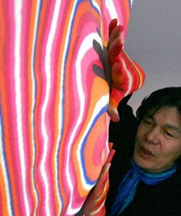
Shows Video in Living 3D
Gemotion is a soft, ‘living’ display that bulges and collapses in sync with the graphics on the screen, creating visuals that literally pop out at the viewer.
Yoichiro Kawaguchi, a well-known computer graphics artist and University of Tokyo professor, created Gemotion by arranging 72 air cylinders behind a flexible, 100 x 60 cm (39 x 24 inch) screen. As video is projected onto the screen, image data is relayed to the cylinders, which then push and pull on the screen accordingly. “If used with games, TV or cinema, the screen could give images an element of power never seen before. It could lead to completely new forms of media,” says Kawaguchi.
The Gemotion screen will be on display from January 21 to February 4 as part of a media art exhibit (called Nihon no hyogen-ryoku) at National Art Center, Tokyo, which recently opened in Roppongi. [blogged on Pink Tentacle]
Posted by jo at 12:46 PM | Comments (0)
0100101110101101.org's
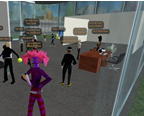
3 classic performances at Ars Virtua!
Chi5 Shenzhou sent me a TP (TelePort) to Ars Virtua and the audience as well as the critics and artists were already milling about while gathering their energy and nerves waiting for the retro-performance-bonanza to begin...
Hey there performance art fans!
Today was a special day in that the reknowned con-ceptual artists, Franco and Eva Mattes aka. 0100101110101101.org were back at Second Life's Ars Virtua for another arousing round of exhibitions! This time their retro-performance trinity was being broadcast (possibly projected) into a contemporary art museum in Trento (Italy) known as the Galleria Civica d'Arte Contemporanea.
For this day (evening in Italian time), Franco and Eva focused on remediating the classics of performance art. If you scroll down the blog a bit, you will realize that they remediated a previous performance remediation by myself and Great Escape... How Postmodern is that! More >> [blogged by Jeremy on Wirxli FlimFlam's Second Life Blog]
Posted by jo at 11:50 AM | Comments (0)
Visualizing Memory in Architecture
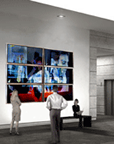
Collision of Memory
Chicago-based artist Lincoln Schatz has been drawing attention with his large-scale generative art installations that visualize memory. The artist has recently been commissioned by Dallas developer Billingsley Company to create one of the largest new media works ever installed in a public space. Due to open on March 29, Schatz's Collision of Memory will be a permanent installation that flanks each side of the entrance to the elevator area of One Arts Plaza, a $125 million multiuse structure, the first of four residential and office buildings on over 10 acres at the eastern edge of the Dallas Arts District. From that moment onwards, two high definition cameras will record the edifice's lobby activity, on a daily basis, during a minimum of 8 years. Selected according to specific chance operations, segments of the footage will be displayed on two 9 x 9 foot video walls in four overlapping layers: one from the last two minutes and three from a distant time period. While standing between the two screens, viewers will see themselves along with visual memories of that place. Continuously washing over one another in painterly portraits of individuals and the surrounding environment, these images relate past and present in uncanny ways, creating a non-linear impression of history. - Miguel Amado, Rhizome News.
Posted by jo at 11:37 AM | Comments (0)
V2_Lab presents

Test_Lab--Dancing-around-technology
Test_Lab: Dancing around technology (presentation) :: February 22, 2007 20:00-23:00 :: admission: free :: reservation: press[at]v2.nl.
Over the last decades, most artistic disciplines have been introduced to technological developments. In many artistic fields, the technologies introduced have been fully integrated in the artists' daily practices resulting in an integration that often makes it hard to imagine the field ever existed without them. However, in the field of performing arts (physical artistic expression such as dance and theatre) this integration did not evolve as naturally. Although many attempts have been made at adopting new technologies in these fields, the marriage between the two was often forced, resulting in what was rather a combination of technology and performing arts than integration of the two.
One of the main aRt&D themes of the V2_Lab is the development of sensor and actuator technology for the fields of performing arts and human-machine interaction. This Test_Lab aims to bridge the different needs of and approaches to technology between performing artists and soft-, hardware designers. This will be realized in this edition of Test_Lab through the testing of two projects that are currently under development in the V2_Lab; Soft(n) and Body In Bits And Pieces. A theoretical presentation by Armando Menicacci will further elaborate on the theme. Both the two projects and the presentation are described below. Soft(n) is the working title for an interactive public art-experience developed in a collaboration between Thecla Schiphorst (Director of the Whisper[s] research group, School of Interactive Arts and Technology, Simon Fraser University, Vancouver) and V2_Lab, within the framework of the Passepartout consortium.
This project is based on exploring emerging network behavior through interaction between a group of soft networked objects. It takes place in a social urban setting; a café or lounge. The work incorporates the design of a group of interactive soft objects, each containing a specially designed and custom-engineered multi-touch soft input surface, motion detectors, an ability to output movement (vibration), light, sound and physical deformation, and communicate wirelessly to each other. The project includes the development and testing of an interaction model based on input heuristics of touch and movement. An earlier version of the project recently won the Gold Exhibition Award at the ITEA 2 symposium.
Body In Bits And Pieces (BIBAP) is an interactive Internet project initiated by Carolien Hermans (Director of DansLab, Amsterdam) and is funded by the Nederlandse Omroep Stichting (NPS) and the Stimuleringsfonds voor Nederlandse Omroep Producties. A prototype of the project was developed in collaboration between Danslab (Carolien Hermans and Benjamin Scheers) and V2_Lab. The aim of the project is to integrate a dance movie in an interactive Internet application and to create an interface that requires physical interaction to enhance the immersion of the user. The project combines physical expression in two ways; by cleverly integrating dance movie clips in the application and by enabling control over the application by body movement of the user. Armando Menicacci is the director of MediaDanse (University Paris-VIII / ANOMOS, Paris). Menicacci will present how the body movement analysis theory and practice developed in University Paris-VIII lead to new relationships between dance and digital technology in some contemporary artworks and fundamental researches created and conducted by his research group. By doing so, he will show how MediaDanse forms a structure of exchange between the fields of academic and technological research, networks of artistic creation, cultural action, and the general public.
Test_Lab is a bi-monthly public event hosted by V2_ (Institute for the Unstable Media, Rotterdam)
Related links:
ANOMOS: www.anomos.org
Whisper[s] research group: whisper.surrey.sfu.ca
Dampf_Lab: dampf.v2.nl
V2_Lab: lab.v2.nl
Posted by jo at 10:55 AM | Comments (0)
Upgrade! Tel Aviv-Jerusalem

On Sound 2
Upgrade! Tel Aviv-Jerusalem :: February 13, 2007, 8:00 pm :: Barbur, Shirizli st. 6, Nachlaot, Jerusalem :: Free Entrance On Sound 2: Two presentations: Tom Tlalim (IL/NL): "Quantasonic" (Tlalim / Johansons) >> Live Performance >> Eran Sachs: "Critical Narrative and the Semantics of Sound Installations" (IL).
Tom Tlalim - computer musician, composer and improviser. Created unconventional musical structures, explores noise overdrive and feedback in the digital domain. He holds MA from the Royal conservatory of The Hague, the Netherlands, where he lives and works since 2000. Tlalim has performed extensively in Europe and outside of it, among others at ResonanceFM (UK), Huddersfield contemporary music festival (UK), Piksel FLOSS event (NO), BimHuis(NL), Night of the unexpected (Paradiso, NL), State-X new forms (NL), Gaudeamus live electronic festival (NL), Audio Art Festival (PL), Int. Oud festival (IL), Cerkno jazz festival (SLO).
He co-curates events in collaboration with POW ensemble, TAG, Noisecape festival, Edits and presents UCON - a radio show together with Jan Truetzschler radio.sampleandhold.org, Tlalim has collaborated with many artist and musicians including Joseph Bowie, father of the funk-noise combo Defunkt, DJ DNA of the Urban Dance Squad, composer and sonologist Richard Barrett, noise artist Gilles Aubry, visual/sound artists Voldemars Johansons, Joost Nieuwenburg, saxophonist Keir Neuringer, turntablist Takuro Mitsuta Lippit a.k.a DJ sniff, dutch improviser Luc Houtkamp and others.
Quantasonic: development of the installation by Voldemars Johansons and Tom Tlalim: a performance and composition environment for organization of audiovisual processes using n-dimensional space as a control metaphor. The environment introduces a novel approach to control over masses of data deriving from granular synthesis concept, according to which all matter, including sound and light, comprises of particle motion in space. This concept is applied to abstract data structures which are interpreted as particles in a multidimentional space and rendered as sound and image. The process results in a dynamic audiovisual landscape in which the spectator is invited to experience an immersive data field.
Space is a basic concept and entity used in the QS environment due to its familiarity to human perception largely by visual means. Any organization of matter in a space, physical or virtual, complex or simple, can instantly be recognized as a structure or form (abstraction process), thus greatly reducing the number of parameters involved in the perceptual process.
Within the framework of the project, we are aiming to develop an audiovisual installation that summarizes our recent experimentation and discoveries in using information structures as source for synchronous visual and acoustic content. Based on the notion of space, sound, and vision as the basic essential domains that constitute human understanding and perception, we are searching for ways to present anonymous data structures and place them within the context of audiovisual space.
Performance: “Impulse - stretch - feedback – resonance” :: 15'-20' long :: Tom Tlalim – Computer, Microphone, pedals:
The piece draws influence from gestalt ideas regarding perception, pattern recognition within etc. Physical/practical processes related to the performance techniqe, decision-making and the various limitations of the instrument, make the raw material to be transformed during the structure of the piece.
Eran Sachs: Critical Narrative and the Semantics of Sound Installations" :: Eran Sachs works as composer, improviser, sound-artist and curator in Jerusalem. As an improviser Sachs has collaborated with Oren Ambarchi, Thomas Koener, Marc Behrens, Achim Wollscheid, @c and many others, mainly playing his self-developed system, the No-Input-Mixer, which he has been playing since 1998. He plays this machine regularily in the Doom-Dub-Noise outfit Lietterschpich and John Zorn's "Cobra" improvising ensemble in Israel. He has presented his works and compositions in such festivals as Sonorities (Belfast), Transmediale (Berlin) and Theaterformen (Hannover), as well as spaces and platforms such as Sonic Square (Brusseles), Podewil (Berlin), Melkweg (Amsterdam), Israeli Cinemateques, Kulturbunker (Cologne), Muffathalle (Munich), Sonic Process, Heara and many others. His work "Studio" with sculptor Eytan Ronel was awarded the Excellence Award by the NY International Fringe Festival.
Sachs is also has collaborated extensively with sound artist Sebastian Meissner (Klimek, Random INC.), with whom he has recently released “Into The Void” (on Sub Rosa), a reflection on the old abandonded Jewish quarter Kazimierz in the city of Krakow. His works have been released on Mille Plateaux and Sub-Rosa, as well as various labels in Israel. As a sound-artist his works tend fuse the sonic with the political, as in the case of "Yannun Yannun", which portrays the harrasment of Palestinian villagers by fanatic right-wing settlers. He founded and managed the Yad-Vashem bookstore - the only holocaust dedicated bookstore in Israel.
Posted by jo at 10:42 AM | Comments (0)
February 06, 2007
Takashi Matsumoto on
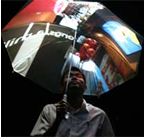
Ubiquitous Content + Pileus: The Internet Umbrella
"[...] "Ubiquitous Content" is an idea of a new design objective of our lives in the post-PC era. In 20th century, a notion of media contents has been meant contents like movies, music, animations, video games etc. Figuratively speaking, such contents were entities supplied in containers designed as "boxes". But now, a spread of networks and a realization of ubiquitous computing technologies are going to change those styles of media. The container is not like a "box" any more: It will change its forms freely to give us advanced computer augmentations in a specific context and it will be sometimes invisible embedded into our environments. It is more appropriately called Ubiquitous Media and it will be a new style of media. When we design such Ubiquitous Media, we need to think about the container as our environments in which many things are cooperating rather than a single hardware, a single software or a single standard. Users will not need to be conscious of those medias, therefore such containers emerge for users as "their lives" themselves. "Ubiquitous Contents" are contents for such media. Those must be "experiences" in "their lives".
As Ubiquitous Content project focuses on our lives and experiences, all things in our everyday lives are targets of the design. The 10 Laboratories of KMD are working on this wide subject from different perspectives....
Pileus is the most exciting project for me right now. This work is designed in a team with Sho Hashimoto, who has a unique engineering skill in the lab. We started this project in a kick-off camp of a spring semester in 2006. the initial concept and the first scenario movie were completed in just 3 days of the camp.
We have many rain in Japan. So the umbrella is one of the closest article of everyday use, but it is also a bulky article in such a climate. Traditionally we have been feeling many kinds of air and mood in a rainy day, and we wanted to expand that feeling to be more fun and vivid with the re-design of an umbrella. From that perspective, we came up with the idea of umbrella to take photo-logs and to browse internet contents in a rain. Me and Sho already took notice of that we can provide many kinds of services in a real world with Web2.0, and also had a technological vista to mash-up those with a mobile hardware. Additionally, it was another target that this can be the first example of a hardware mash-up to indicate a new economic solution for mobile gadgets joining into an economy of Web 2.0. We do not want a small "Cellphones" (Smartphones, whatever) squashing up many functions inside, but we re-designed an object of everyday use from scratch to be mashed-up with web services.
At the end of last year, we founded a spined-off LLC for the project, and we are thinking how it will go a business exit.
As the ideology of the design of Pileus, we would like to show that design is not about its shape any more; an apt assortment of modules and interactions are more important factors for the design. So, our prototype is showing off the circuits to see how modules are combined rather than covering it. Some people suggest us to give a beautiful surfaces for it as a "design", but that is not what we want to do now, we are meticulous about the interaction of information visualizations on the screen though. Fortunately, this rugged look is loved by many audiences at demo sites.
As an exclusive info, we have builded a new version of Pileus with GPS. A new function with GPS is geo-tagging of photos taken by Pileus. It will help to users to check and share records of their walks in the rain. Another function is a map display of an area. This will be used for a big-screen navigation in an umbrella, and it will be able to show local pictures and local ads are loaded on the umbrella. Of course, this function is also realized by a mash-up technique. Now we are using Yahoo! Maps API, but we may switch it to Google Maps API because Japanese map on Yahoo! maps has bad scale ratio. We are going to go an experiment in a city in a rain, however, unfortunately we have had few rainy days this year yet... [ from Regine's interview on we-make-money-not-art]
Posted by jo at 01:07 PM | Comments (0)
Sei Personaggi Part 2
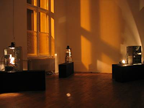
a play in computers
WHERE IS A STAGE CHARACTER IF NOT IN A PLAY? The theatre author Luigi Pirandello holds his fantasy responsible for the six characters visting him, the ‘Sei Personaggi’: father, daughter, mother, son and two little children. An ’operational accident’ as he calls it, as their family drama is not worth it, to be shown on stage. As a start, they discuss their claim with Pirandello himself and later on with the theatre director in Pirandello’s play ‘Six Characters in Search of an Author’. They are playing and explaining themselves to achieve their quest. Their drama is supposed to be turned into a play to concretize them.
Without a play, these figures are ‘alive’ and not existent at the same time. Their scenes are written inside of them and ‘force’ the family to search for a stage and an audience. Their attempt fails in Pirandello’s play, he is leaving them indeterminated.
Sei Personaggi Part 2 by Valentina Vuksic: In the continuation of the 'Sei Personaggi’s' search, the characters are played by computer processes. Reading passages of the manuscripts, the programs mutually control each other according to the signs they are processing. A particular kind of machinic dialogues is being evolved inside the computing systems. Instead of actors, disused hardware affects the course of the play.
Time beating processors and working memories determine time and space of this fictitious, not visible stage, which spreads over the interiors of the networked machines. Microphones follow the fleeting trails of the characters inside the systems’ kernels. [via we-make-money-not-art]
Posted by jo at 12:52 PM | Comments (0)
Dorkbot Second Life
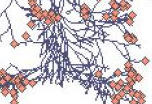
Wirxli Flimflam and Ian Ah
Finally! The first dorkbot meeting in-world can be announced: It will take place on Sunday 18th February at 2-3 PM PST (LA, East Coast North America) = 5-6 pm EST (NY, West Coast North America) = 11-12 pm CET (Berlin, Europe) = 7 - 8 AM (19th) (Tokyo). I am very looking forward to it, as Wirxli Flimflam aka Jeremy Turner from Second Front and Ian Ah Canadian artist and thinker have confirmed to take part at this little historical event.
Both are quite experienced with art (not design) and culture in Second Life so I am sure it will be a nice talk. We will first gather at my place (rhizomatic in SL: http://slurl.com/secondlife/Sand/177/16/151) and then move further to Ian Ah’s special movie screening lounge which is on Sugar Mountain (Odyssey Island).
Further readings:
http://rhizomatic.wordpress.com/
http://dorkbot.org/dorkbotsl/
http://www.we-make-money-not-art.com/archives/009304.php
Best and I hope I will see ur avatars there!
Shintaro Miyazaki aka Maximillian Nakamura
Posted by jo at 11:43 AM | Comments (0)
Sarai Presentation
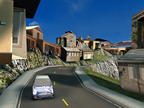
The Scalable City by Sheldon Brown
The Scalable City: An Artist's Presentation by Sheldon Brown :: 4:30 P.M., Wednesday, 7 February 2007 :: Seminar-Room, Sarai-CSDS, 29, Rajpur Road, Civil Lines.
Sheldon Brown, Director of the Center of Research in Computing and the Arts and Professor of Visual Arts at the University of California San Diego, will discuss and demonstrate his current project - The Scalable City. The Scalable City is an interactive extrapolation of the cultural condition arising from the interaction of users, data and algorithms. As our world becomes increasingly characterized by this equation, we find ourselves inhabiting the artifacts of these relationships. The Scalable City generates its urban environment via the choreography of these artifacts.
Brown's work in general examines the relationships between mediated and physical experiences. This work often exists across a range of public realms.
The Newsletter of the Sarai Programme, 29 Rajpur Road, Delhi 110 054. Info: dak[at]sarai.net. Directions to Sarai: We are ten minutes from Delhi University. Nearest bus stop: IP college or Exchange Stores. See Calendar and Newsletter online:
Posted by jo at 11:24 AM | Comments (0)
Upgrade! Skopje

Generative Art Lecture
Upgrade! Skopje: Generative Art Lecture [as part of the BaseLine programme] :: Lecturer: Goran Kocov (MK) :: Thursday, February 8, 2007, 8:00 pm :: press to exit project space :: Curators: Elena Veljanovska and Antonio Dimitrov :: organization: Line I+M [initiative and movement].
After the lecture, there will be a presentation of the works made at the Generative art workshop, held from 26-28.01.2007 in Skopje. This event is part of the OFF program of the project Consumer vs. user*, which Line initiative and movement will develop in next 6 months.
The lecture will follow the tendencies of generative art from the very beginning, through minimalism influences, kinetic art, geometrical abstraction, abstract expressionism and the most of all conceptual art and it's representatives Hans Hacke and Sol Le Vit. Works, or maybe more important, tools created by John Maeda, Casey Reas or Benjamin Frey, are great examples for the magical connection of complexity and simplicity, interaction and automatization, the moving spirit of zero's and one's. Actually, very often, the work of generative art is toll by itself, capable of self realization through a kind of Hofstadter's magical circle. Further on, to complete a wider picture of the generative art and it's different way of approach and creation, Kocov will present the work and achievements of Tomas Briks, Tom Harden, Theo Bart etc.
After the lecture, the follow up will be the presentation of the works created during the three day workshop, that was held in Skopje, at the end of the last month. The workshop was divided in two main parts, theoretical and practical. In the first part, participants had lecture about the origin of Generative art. In the second- practical part, they were introduced in the program Processing, and it's practical use, in which they acquire experience and created it's own works.
Goran Kocov is born 1977 in Skopje. Studies at the university "Cyril and Metodius", in the department of history of art and archaeology. During the studies, he slowly forms the basics of his work in the wonderful connection of digital technology, art and Information Technology. In the same period, concentrated on the music production with software tools, publishes two compositions on music compilations "Macidonia 999" and "Macidonia 2000". Also works as a sound engineer on various TV, radio and movie projects, like "The Judge" from Zaneta Vangeli. As the time passes, visual arts join the sound art and music as his primer interest, and from the Information Technology free software and programming play the bigger role in his creative life. In the new millennium, he works as a programmer, beta-tester and consultant on various personal, commercial and non- commercial projects, all connected with audio/video software, collaborating, among the others with the software giant NVidia.
In the studio "Dream factory" works 3D modeling and animation, video design and compositing. Also he has previous experience as an editor of the movie pages of the magazines: Student's word and Urban magazine. In 2004, had lecture at the Faculty of natural sciences, Skopje entitled "Hollywood freeware". At this moment he is working as technical director in the studio for visual effects "Vertigo", where he just finished the visual effects of the Macedonian movie "Papokot na svetot".
Consumer vs. user* is a six months course that will include lecturers from Macedonia and Europe (United Kingdom, France and Italy). The seven lecturers participating in this project have a previous professional and theoretical background and practical expertise in the area in question.
The main goal is to educate a group of young creative people that are interested in learning in the fields of new media art: history of sound art and hardware; and technology: how to use open source tools, production, publishing/internet publishing, radio technology and VJ- ing. The workshops together will accomplish the basic knowledge and offer a practical usage and sustainability of the young future artists.
Consumer vs. user includes six workshops in a period of six months. The duration of these workshops can vary from 1 to 3 days. Here, besides the basic theoretical presentation, the participants will be involved in series of practical activities in an adequate environment and with adequate equipment.
Consumer vs. User OFF program consists of 6 events that will take place after each workshop. The aim of these events is to present the ideas to a wider audience, in order to develop their knowledge and get more familiar with the whole terminology of new media art.
1. Generative art ::: lecturer: Goran Kocov (MK) ::: duration: 3 days ::: date: 26-28 January 2007 :::
2. Sul Suono [about sound] ::: lecturer: Enrico Glerean (IT/UK) ::: duration: 3 days ::: date: 23-25 February 2007 :::
3. Analog synthesis ::: lecturer: Vlatko Kaevski ::: duration: 1 day ::: date: 30 March 2007 :::
4. Record labeling ::: lecturers: Dave Howell (UK) and Philippe Petit (FR) ::: duration: 2 days :::date: 28-29 April 2007 :::
5. Video world ::: lecturer: Marija Bozinovska ::: duration: 3 days ::: date: 25-26-27 May 2007 :::
6. Radio city ::: lecturer: Antonio Dimitrov (MK) ::: duration: 2 days ::: date: 22-23-24 June 2007 :::
*The name of the project is adopted from the Andrew Duke concept Consumer vs. User
This project is supported by: Swiss cultural programme, Macedonia- Pro Helvetia
Upgrade! Skopje is monthly gathering of new media artists and curators. Upgrade! Skopje will organize presentations, exhibitions, workshops, discussions, sound performances, dj and/or vj gigs, video presentations… with general aim for promotion and development of new media art practices, through various kind of exhibiting and performing. Meetings can take place on various locations in Skopje like: clubs, cafes, galleries or studios. We think that is very important to find different space, appropriate to each kind of events, building different type of audience for each of them, establishing collaboration with various scenes, building stronger scene, community and networking.
Upgrade! Skopje is opened for every artist that is travelling this way to present his work here, get promoted and become introduced with the local scene with aim to develop collaboration/communication. Upgrade! Skopje is organized by Line – initiative and movement.
Posted by jo at 11:16 AM | Comments (0)
The 21st Annual Conference of the SLSA

Call for Papers and Proposals
CODE: The 21st Annual Conference of the SLSA (Society for Literature, Science, and the Arts) :: Nov. 1-4, 2007 :: Portland, Maine (USA) :: Call for Papers and Proposals :: Proposal Deadline: March 15, 2007 :: Topic: CODE.
Plenary Speakers: N. Katherine Hayles, UCLA; Brian Massumi, Université de Montréal :: Biological and algorithmic, protector of secrets and porthole to mysteries, universal and singular, code is an invitation to thought. Code can be “wet” (genetic, organic, human), “dry” (digital, mathematical, logical), something in-between, neither, or both (linguistic, symbolic, religious, moral, legal). Code is the meeting ground of strange bedfellows, the cipherer and decipherer, the domain of law and its subversion, communication and privacy. Code is about patterns, sequences, systems, translations, substitutions. It can bind, trick, and free. Modern technologies are affording us more and more keys to unlock nature’s code and more opportunities to manipulate it.
We welcome paper and panel submissions that explore any type / aspect / nature / culture of code in any period of history. Also welcome are submissions on any aspect of science's relationship with literature and the arts, including ones presented in nontraditional formats (such as film/video, performance, music, or visual art).
For more information, please see http://www.slsa07.com/
From the Organizer:
Artist presentations are most welcome, although they need to be part of a panel and the artist is asked to discuss his or her work for about 15 mins. Each panel has 3-4 presenters, who each present for about 15 mins, and then there are 15 mins for Q&A. So, we would need a brief proposal (250 words) and a title from each person; or a proposal for a panel (150 words) with title: http://www.slsa07.com/callforpapers.html; or a completed panel (150 word description) and the names of the participants and the titles of the presentations.
We will have 3 rooms in the hotel dedicated to displaying the artworks of participants on the panels. One room will have 2D and 3D art, one will have digital art, and one will have sound art. Here's the link describing these rooms and the submission requirements.
We will also have a book exhibit.
Posted by jo at 11:00 AM | Comments (0)
The Oracle of Elsewhere
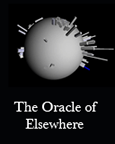
World Cities Browser
The Oracle of Elsewhere, by Ian Wojtowicz, explores current events happening in major urban centers around the world. It functions as both an information visualization and as a collage generator. The work's first screen shows a rotating 3D model of the earth displaying cities as extruded blocks. The height of each block indicates city density, and width represents land use. Color is also used to convey information: varying shades of blue show where news is currently increasing. Because this map is connected to live data from Google, it changes with the fluctuation of world events. At the time of this writing, for example, a ferry disaster in Indonesia insured that Surabaya was most noticeable city on the map.
The Oracle also has a sculptural element that enables people to interact with the 3D model manually. A reconfigured standalone globe allows the computer model to be rotated by physical interaction. It brings the work out of the confines of the computer screen and into a real collaborative conversational space. [via Rhizome]
Posted by jo at 10:41 AM | Comments (0)
F L U X L I N E S
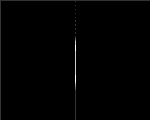
37 Short Fluxus Films
F L U X L I N E S, by Luca Lunk Leggero, is a personal rework of "37 Short Fluxus Films" in which 384x500 pixels videos become 550x1 pixels videos: LINE 01 ( Nam June Paik - Zen For Film )
LINE 02 ( Dick Higgins - Invocation of Canyons and Boulders )
LINE 03 ( George Maciunas - End After 9 )
LINE 04 ( Chieko Shiomi - Disappearing Music for Face )
LINE 05 ( John Cavanaugh - Blink )
LINE 06 ( James Riddle - 9 Minutes )
LINE 07 ( George Maciunas - 10 Feet )
LINE 08 ( George Maciunas - 1000 Frames )
LINE 09 ( Yoko Ono - Eye Blink )
LINE 10 ( George Brecht - Entrance to Exit )
LINE 11 ( Robert Watts - Trace #22 )
LINE 12 ( Robert Watts - Trace #23 )
LINE 13 ( Robert Watts - Trace #24 )
LINE 14 ( Yoko Ono - One )
LINE 15 ( Yoko Ono - Eye Blink )
LINE 16 ( Yoko Ono - Four )
LINE 17 ( Pieter Vanderbeck - Five O'Clock in the Morning )
LINE 18 ( Joe Jones - Smoking )
LINE 19 ( Erik Andersen - Opus 74 Version 2 )
LINE 20 ( George Maciunas - Artype )
LINE 22 ( Jeff Perkins - Shout )
LINE 23 ( Wolf Vostell - Sun in Your Head (Television Decollage) )
LINE 24 ( Albert Fine - Readymade )
LINE 25 ( George Landow - The Evil Faerie )
LINE 26 ( Paul Sharits - Sears Catalogue 1-3 )
LINE 27 ( Paul Sharits - Dots 1 & 2 )
LINE 28 ( Paul Sharits - Wirst Trick )
LINE 29 ( (unnumbered) Paul Sharits - Unrolling Event )
LINE 30 ( Albert Fine - Dance )
LINE 31 ( John Cale - Police Car )
LINE 36 ( Peter Kennedy & Mike Parr - Flux Film 36 )
LINE 37 ( Peter Kennedy & Mike Parr - Flux Film 37 )
LINE 38 ( Ben - Je ne vois rien, je n'entends rien, je ne dis rien )
LINE 39 ( Ben - Le Traversee du port de Nice a la nage )
LINE 40 ( Ben - Faire un effort )
[via Random]
Posted by jo at 08:33 AM | Comments (0)
February 05, 2007
Clay Shirky
![]()
Second Life, Games, and Virtual Worlds
"[...]Here we arrive at the furthest shores of speculation. One of the basic promises of virtual reality, at least in its Snow Crash-inflected version, is that we will be able to re-create the full sense of being in someone’s presence in a mediated environment. This desire, present at least since Shamash appeared to Gilgamesh in a dream, can be re-stated in technological terms as a hope that communications will finally become an adequate substitute for travel. We have been promised that this will come to pass with current technology since ATT demoed a video phone at the 1964 World’s Fair.
I believe this version of virtual reality will in fact be achieved, someday. I do not, however, believe that it will involve a screen. Trying to trick the brain by tricking the eyes is a mug’s game. The brain is richly arrayed with tools to detect and unmask visual trickery — if the eyes are misreporting, the brain falls back on other externally focussed senses like touch and smell, or internally focussed ones like balance and proprioception.
Though the conception of virtual reality is clear, the technologies we have today are inadequate to the task. In the same way that the theory of computation arose in the mechanical age, but had to wait first for electrics and then electronics to be fully realized, general purpose virtual reality is an idea waiting on a technology, and specifically on neural interface, which will allow us to trick the brain by tricking the brain. (The neural interface in turn waits on trifling details like an explanation of consciousness.)
In the meantime, the 3D worlds program in the next decade is likely to resemble the AI program in the last century, where early optimism about rapid progress on general frameworks gave way to disconnected research topics (machine vision, natural language processing) and ‘toy worlds’ environments. We will continue to see valuable but specific uses for immersive environments, from flight training and architectural flythroughs to pain relief for burn victims and treatment for acrophobia. These are all indisputably good things, but they are not themselves general, and more importantly don’t suggest rapid progress on generality. As a result, games will continue to dominate the list of well-populated environments for the foreseeable future, rendering ineffectual the category of virtual worlds, and, critically, many of the predictions being attached thereunto." From Second Life, Games, and Virtual Worlds by Clay Shirky, Many-to-Many.
Clay Shirky, Beth Coleman, and Henry Jenkins have decided to coordinate simultaneous blog posts discussing Second Life.
Henry's post, A Second Look at Second Life, responds directly to some of Clay's previous criticisms of SL press coverage, but shifts the focus: "I care only a little bit about the future of virtual worlds. I care a great deal about the future of participatory culture. And for the moment, the debate about and the hype surrounding SL is keeping alive the idea that we might design and inhabit our own worlds and construct our own culture. That's something worth defending." [via]
Posted by jo at 07:00 PM | Comments (0)
Web 2.0 in just under 5 minutes
[via]
Posted by jo at 06:07 PM | Comments (0)
NOEMA

IDEAS
Identity, Transformation, and Digital Languages: a conversation with Ali Zaidi Antonio Pizzo: Motiroti is a London based international arts organisation founded by Ali Zaidi and Keith Khan in 1996. Zaidi describes himself as Indian by birth, Pakistani by migration and British by chance. Together with his art companion, he has been working with traditional art craft and new digital media in public events and performance. They have growth steadily during the years, and they were commissioned the Commonwealth Section of the Queen's Jubilee Parade in London on 2002. Now they are a well know art organization and, after Khan left, Ali Zaidi is the only artistic director. His work has always being about identity and cultural displacement, confronting a world that struggle against globalisation and homologation. The way he approaches art blurs the boundaries between films, theatre, performance, and it rather focuses on the communality of the experience. Most of the time he makes a heavy use of digital technology, bringing out what one could call digital communal performance.

The Creative Common Misunderstanding by Florian Cramer: Whatever stance one may adopt, the name "Creative Commons" is misleading because it doesn't create a commons at all. A picture released, for example, under the Attribution-ShareAlike license cannot legally be integrated into a video released under the Attribution-NonCommercial license, audio published under the Sampling License can't be used on its soundtrack. Such incompatible license terms put what is supposed to be "free content" or "free information" back to square one, that is, the default restrictions of copyright - hardly that what Lawrence Lessig, founder of the Creative Commons, could have meant with "free culture" and "read-write culture" as opposed to "read-only culture." In his blog entry "Creative Commons Is Broken," Alex Bosworth, program manager at the open source company SourceLabs, points out that "of eight million photos" posted under a CC license on Flickr.com "less than a fifth allow free remixing of content under terms similar to an open source license. More than a third don't allow any modifications at all."
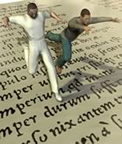
Ready for Action by Jordan Crandall: We have a critical vocabulary to understand the power of media in terms of its ideological effects. Yet we lack a vocabulary to understand the power of media otherwise: that is, in terms of its ability to transmit affects. During at least the last forty years, criticism has focused on the social and cultural construction of knowledge. It has directed attention toward the conditions that make meaning possible. It has been useful for debunking beliefs, powers, illusions, essentialist truths. But for the reasons pointed out here, it only gives us half the picture: the world of form, rather than that of force. Language, rather than readiness. Speech, but not the screech. How, then, can we expand the language of cultural analysis in order to account for this affective dimension of readiness? And, further, how can we use this orientation to generate a reinvigorated, performative politics? Might we speak of an “affective critique”? Or is the term “critique” no longer useful at all?
Posted by jo at 05:28 PM | Comments (0)
A Million Penguins: A Wiki Novel

Collectively Creating a "believable fictional voice"
"...The novel, A Million Penguins, went live on Thursday and its first lines are already being written, edited and rewritten by enthusiasts on http://www.amillionpenguins.com. Penguin, which embarked on the project with a group of creative writing and new media students, says it is using the novel as a test of whether a group of disparate and diverse people can create a "believable fictional voice".
"This is an experiment. It may end up like reading a bowl of alphabet spaghetti," Jeremy Ettinghausen, head of digital publishing at Penguin UK said, adding there were no plans as yet to publish the completed work. "We are not making any predictions. It would be utterly fantastic if we could at the end create a print remix."" More >>
Also see Ethical guidelines page for wikinovel: http://www.amillionpenguins.com/wiki/index.php/Ethical_guidelines
Blog-- Penguin editors' notes on the novel in progress, thinking about
the project as it goes along: http://www.amillionpenguins.com/blog/ [via]
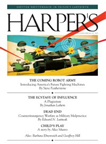
Collective Authorship
The February 2007 issue of Harper’s has a great series of essays on the theme of collective authorship that make it well worth picking up if you see it on the newsstand.
First is a complaint from Ian Jack about the trend among American writers toward thanking (in print) ever wider circles of friends and acquaintances. While acknowledging the mythical status of the popular image of the writer in solitude, and admitting that writing is often a cooperative act, he worries that this indicates a deeper trend toward the “industrialization” of the production of literature.
Such industrialization is the central vision of a manifesto by Sergei Tret’iakov, a Russian avant-garde writer who died in Stalin’s purges, calling for the “deindividualization and deprofessionalization of the writer.” Tret’iakov argues that small cliques of professional writers are no longer adequate “to keep up with the tempo of the present” and envisions a kind of literary assembly line, on the model of the newspaper, where specialized teams focus on first collecting, then processing, then testing the literary object being produced. I was struck by how this three-tier system echoed some other triads I’ve heard lately: Collect, Curate, Consume, or Create, Synthesize, Consume. “Testing” may at first seem to be quite different from “consuming,” but when you consider that contemporary digital media companies often use their consumers as testers, you see that they are just two sides of the same coin, as are “collecting” and “creating.”
Collecting as creating is illuminated beautifully by “The Ecstasy of Influence,” a remarkable collage text by Jonathan Lethem. As someone who has read a lot of writings on “free culture,” and not knowing the nature of what Lethem had created, I found myself wondering why Lethem was repeating so much tired rhetoric. Yet it flowed beautifully, and I enjoyed reading it. I was truly surprised when I reached the “key” to the piece at the end and realized what a virtuoso performance I had been experiencing. [blogged by Ryan Shaw on sindikkaeshin]
Ben Vershbow on "A Million Peguins":
The problem with A Million Penguins in a nutshell is that the concept of a "wiki-novel" is an oxymoron. A novel is probably as un-collaborative a literary form as you can get, while a wiki is inherently collaborative. Wikipedia works because encyclopedias were always in a sense collective works -- distillations of collective knowledge -- so the wiki was the right tool for reinventing that form. Here that tool is misapplied. Or maybe it's the scale of participation that is the problem here. Too many penguins. I can see a wiki possibly working for a smaller narrative community.
All of this is not to imply that collaborative fiction is a pipe dream or that no viable new forms have yet been devised. Just read Sebastian Mary's fascinating survey, published here a couple of weeks back, of emergent net-native literary forms and you'll see that there's plenty going on in other channels. In addition to some interesting reflections on YouTube, Mary talks about ARGs, or alternative reality games, a new participatory form in which communities of readers write the story as they go, blending fact and fiction, pulling in multiple media, and employing a range of collaborative tools. Perhaps most pertinent to Penguin's novel experiment, Mary points out that the ARG typically is not a form in which stories are created out of whole cloth, rather they are patchworks, woven from the rich fragmentary litter of popular culture and the Web:
Participants know that someone is orchestrating a storyline, but that it will not unfold without the active contribution of the decoders, web-surfers, inveterate Googlers and avid readers tracking leads, clues, possible hints and unfolding events through the chaos of the Web. Rather than striving for that uber-modernist concept, 'originality', an ARG is predicated on the pre-existence of the rest of the Net, and works like a DJ with the content already present. In this, it has more in common with the magpie techniques of Montaigne (1533-92), or the copious 'authoritative' quotations of Chaucer than contemporary notions of the author-as-originator.
Penguin too had the whole wide Web to work with, not to mention the immense body of literature in its own publishing vault, which seems ripe for a remix or a collaborative cut-up session. But instead they chose the form that is probably most resistant to these new social forms of creativity. The result is a well intentioned but confused attempt at innovation. A novelty, yes. But a novel, not quite.
Posted by jo at 05:11 PM | Comments (0)
4th International Workshop in Mobile Music Technology 2007
![]()
Call for Proposals
MOBILE MUSIC TECHNOLOGY :: FOURTH INTERNATIONAL WORKSHOP :: AMSTERDAM, THE NETHERLANDS, 6-8 MAY 2007 :: Submission deadline: 12th March 2007.
Combining music and mobile technology promises exciting future developments in a rapidly emerging field. Devices such as mobile phones, Walkmans and iPods have already brought music to the ever-changing social and geographic locations of their users and reshaped their experience of the urban landscape. With new properties such as ad hoc networking, Internet connection, and context-awareness, mobile music technology offers countless new artistic, commercial and socio-cultural opportunities for music creation, listening and sharing. How can we push forward the already successful combination of music and mobile technology? What new forms of interaction with music lie ahead, as locative media and music use merge into new forms of everyday experiences?
This series of annual workshops began to explore and establish the emerging field of mobile music technology in 2004. This fourth edition of the Mobile Music Workshop in 2007 offers a unique opportunity to participate in the development of mobile music and hands-on experience of cutting-edge technology.
This year’s workshop is hosted by STEIM and Waag Society in Amsterdam, The Netherlands, and partners with the Futuresonic Festival in Manchester, England, taking place later the same week. The programme of the workshop will consist of keynote presentations from invited speakers, peer-reviewed paper presentations, poster sessions, in-depth discussions about the crucial issues of mobile music technology, demos of state-of-the-art projects, break-out sessions and live events. Registered participants will take part in hands-on sessions conducted by leaders in the field. In addition to traditional presentation sessions, the programme includes events open to a general audience, facilitating the presentation of artworks and technological breakthroughs to a wider public.
The Mobile Music Workshop sets the stage for a collaboration that brings together leading institutions in both experimental electronic music and mobile media. STEIM (the studio for electro-instrumental music) is a centre for electronic music production well known in the performing arts. STEIM promotes the idea that Touch is crucial in communicating with electronic and digital arts technologies, a vision that over the years has given birth to physical, sensor-based musical instruments. Waag Society is a research and development institute in the fields of networked art, education and creative industries. Waag develops platforms for artists to reach society through networked collaboration, media streaming, and locative media.
CALL FOR PARTICIPANTS AND WORKS
We invite practitioners, artists, designers, hackers and researchers from all areas, including music, technology development, new media, sound-art, music distribution, cultural/media studies, locative media and industry to submit work and register to attend. Don't miss this chance to help shape the mobile music landscape of the future! Participants are encouraged to submit their work in mobile music technology to the categories below. The partnership with the Futuresonic Festival allows those coming to Europe to make a single trip to attend both events.
* Papers
We invite submissions of workshop papers presenting new projects, approaches or reflections exploring the topic of mobile music. Potential submissions could include but are not limited to mobile music systems or enabling technologies, interface design, legal issues, user studies, ethnographic fieldwork, social implications, art pieces and other areas relevant to mobile music.
Accepted paper authors will be given a time slot during the workshop for presentation and discussion of their work. Format: up to 8 pages in ACM SIG publications format (shorter papers welcome). For templates, see http://www.acm.org/sigs/pubs/proceed/template.html
* Posters
We also invite the contribution of posters that document work-in-progress projects or ideas in similar areas of mobile music technology as the papers.
Posters will be on display during the duration of the conference. We will arrange a poster presentation session where attendees will be able to discuss the works with the authors. Format: 2 pages in ACM SIG publications format
* Demonstrations
We also invite submissions of work to the demo category. Besides encouraging paper and poster presenters to bring a demonstration as a complement their presentation, we encourage submissions of stand-alone demos of mobile music systems or enabling technology. Their implementation should be ready enough to be demoed, and will possibly be shown to the general public during open sessions depending on their robustness. Format: 2 pages in ACM SIG publications format.
SUBMISSIONS
Please email your submission as a PDF file in the appropriate format to submissions[at]mobilemusicworkshop.org In the subject line, state MMW SUBMISSION followed by PAPER, POSTER or DEMO and the name of the main author. Submissions will be peer-reviewed by a committee of international specialists in the fields of mobile music, interactive music, and locative media.
DEADLINES
Submission deadline: 12th March 2007
Notification of acceptance: 2nd April 2007
Registration deadline: 16th April 2007
Final submission deadline: 16th April 2007
REGISTRATION & FEE
This year’s workshop will have both closed sessions for registered participants and sessions open to the general public. The number of participants for the closed sessions of the workshop is limited to 50 places. Accepted submitters are given priority, other participants are accepted on a first-come first-served basis. Registered participants will have automatic access to all sessions of the workshops. The closed sessions of the workshop will be charged both a regular and a reduced student fee, similar to the last edition’s fees.
Registration deadline: 16th April 2007
The open sessions will be advertised in more detail closer to the event. The fee for the open sessions will be event-based. Scheduling and registration fees will be coordinated with Futuresonic to allow participants to easily attend both events.
ORGANISERS
* International Steering Committee
Atau Tanaka (Sony CSL Paris, France)
Frauke Behrendt (University of Sussex, UK)
Lalya Gaye (Viktoria Institute, Sweden)
* Local Organising Committee
Kristina Andersen (STEIM, The Netherlands)
Robert van Heumen (STEIM, The Netherlands)
Ronald Lenz (Waag Society, The Netherlands)
MORE INFORMATION
For more information about the previous and up-coming workshops, the ACM SIG publications format as well as travel and accommodation information, please consult: http://www.mobilemusicworkshop.org/
Posted by jo at 11:13 AM | Comments (0)
February 04, 2007
The Garthwaite Center for Science and Art

Call for Work and Proposals
As this call for submissions goes to press, the National Climatic Data Center in Asheville, N.C. (NOAA) announced 2006 was the warmest year on record for the U.S. The Cambridge School of Weston will open its doors to The Garthwaite Center for Science and Art, a sustainable science building and art gallery, in the fall of 2007.
For the building's first exhibition season, we are reaching out to artists and scientists alike who explore issues and themes related to global warming. The exhibition will run from November 2007 through the first week of February 2008. Further details will be announced. All media will be considered; however, large work may not be able to be accommodated.
In addition to exhibiting works of contemporary art and science, we also invite proposals from individuals who would be willing to partake in a symposium on global warming, or otherwise are willing to work with our students in some capacity. Submissions should include examples of work via slides or digital media, a resume, along with any appropriate written proposal or documentation.
Please include a S.A.S.E., for the eventual return of materials, and contact information. Do not send large files digitally at this point. Send all materials to Todd Bartel, The Cambridge School of Weston, 45 Georgian Road, Weston, MA, 02493. The deadline for submissions is April 30, 2007. For questions please contact tbartel[at]csw.org
Posted by jo at 12:24 PM | Comments (0)
UpStage: a web-based venue for live online performance
![]()
Open Walk-Through
The UpStage team have had a good holiday and are now ready to launch into what will be a busy six months. The launch of UpStage 2 is scheduled for the first week of July and we are planning a festival of performances in UpStage to mark the occasion. More on this to come, but if you are interested in the idea of creating a short performance for the festival, start thinking about it now and come along to the open sessions to learn about the new features.
The first open walk-through for 2007 will be this coming Wednesday, 7 February at 9pm, NZ time. Convert to your local time here. We will be on the Swaray stage, so audience members should come directly to http://upstage.org.nz:8084/stages/swaray; if you'd like to log in and participate as a player, you must email me for a log-in as we need to make sure you aren't all trying to use the same guest log-in. Then you can log in at http://upstage.org.nz:8084/.
We are now using the alpha version of UpStage 2, so you can experience the new features and enhanced interface (and help us identify bugs - this is the ALPHA version after all!).
helen varley jamieson
UpStage project manager
helen[at]upstage.org.nz
UpStage: a web-based venue for live online performance
Posted by jo at 11:47 AM | Comments (0)
February 03, 2007
Timo Kahlen
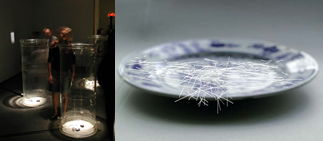
Ephemeral Media
left : "Media Dirt", 2004. Sound installation based on ephemeral, interfering radio waves at KIASMA National Museum of Contemporary Art in Helsinki, Finland // right : "UR", 2006. Net art / interactive sound piece. Courtesy Ruine der Kuenste Berlin.
Sound and media artist Timo Kahlen (*1966, living and working in Berlin) has been nominated for the German national "Sound Art Prize 2006". He has been working with immaterial and ephemeral media (light, sound, wind, radiation) for more than twenty years. As part of his nomination, he has been invited to present selected sound installations at the Ruine der Kuenste Berlin, at the Skulpturenmuseum Glaskasten Marl and at the "SoundART 2006" special exhibition of the ART COLOGNE fair. For a detailed documentation of his experimental work see http://www.staubrauschen.de/soundsc.htm
From April 27 - April 29, 2007, a new selection of web-based, generative sound works by Timo Kahlen will now be presented at "The Sonic Image": 2007 Totally Huge New Music Festival Conference in Perth (AUS). These include "Sound Drift" (2005 in collaboration with Ian Andrews) and "ping tschae tschae" (2005) and, for example, "UR" (2006).
For 2007, Timo Kahlen is currently preparing exhibitions in Berlin, Chemnitz and Milano.
Posted by jo at 02:48 PM | Comments (0)
Networked Theatre of the Oppressed
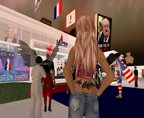
Second Life Theatre Group Meeting
Networked Theatre of the Oppressed :: First informal Second Life theatre group meeting in Bootlab Berlin :: Sunday February 6, noon (brunch time, 12.00 h) :: Tucholskystraate 6.
The dictatorship of the bourgoise melodrama stage has been an inspiration to living theatre, Brecht, Boal, and many. By combining the poetics of storytelling, digital narrative and network performing, the ghostly streets of Second Life become an open stage where the practice of everyday life becomes the raw material for political intervention thru classical drama, literature and net.art techniques. It is time for the triple alienation of the cyburbian multitudes!
Second Life's publicity is generated outside of the internet based on old media PR, circumventing the rest of the net. It is a newbie honeypot, or a themepark for cyberspace history most of all it is a "opera buffa" a theater of vulgarities, and shallow motivations, certainly more reality than what the cultural institution of the theatre has to offer today.
In our first 2 hour practise meeting we want to discuss possibilities of stage design, choreographic moves, myths and topoi, requisites and figurines, sketches of existing 3d datasets and scripting knowledge, we want to identify interesting text resources and invite people researching the field, detecting possibilities for a theater of net.art 2.0 etc. pp. not just revolting but playing with the zombie cybermyths of SL.
The Second Life can not be lived rightly...
- - how can you have virtual sex and no virtual communism?
- - between underworld and purgatory, spaces for the organized networks of
death
- - did 1995 avatar utopia needed lindon economy to reach the masses.
- - there are more than 3 million condemned waiting for liberation.
- - come and sacrifice your pets at a pergamon temple.
- - a virtual world is impossible. lindon dollars are halluzinogenic.
- - california dreaming, do you feel the network effect?
- - zoylent green is us!
- - instalaremos la primera antena zapatista de radio insurgente y la
otra campa??a en second life.
http://bootlab.org
http://possibleworlds.org
Posted by jo at 11:29 AM | Comments (0)
February 02, 2007
SummerBranch
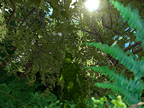
Truth and Artifice in Nature
Summerbranch is a new commission by igloo that explores movement and stillness in nature. Using camouflage and other disguises, a person or a computer character can blend into a ‘natural’ environment captured and treated through the moving image. This installation uses the tools of the military-entertainment complex, computer gaming, motion capture, 3D environments and special effects to question what is truth and what is artifice in our attempts to reproduce nature. Through the creation of a computer generated virtual world, Summerbranch seeks to address this by the use of disguise in dance and movement. IGLOO not only investigates the role of the ‘real’ in virtual environments but also that of the reproduction of nature in the history of art and particularly landscape work.
Summerbranch is the result of a 2 month residency at ArtSway in the New Forest. The exhibition is created for 3 gallery spaces. A series of intermedia works which can stand alone as individual installations or together as a site specific install comprising 3 parts: Virtual environment, Video installation, a set of Lenticular Prints & Wallpaper. [via Rhizome]
Posted by jo at 02:39 PM | Comments (0)
Dispatx Art Collective
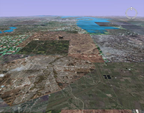
Tools of a Socialised Internet
Dispatx is a curatorial platform that provides the tools of a socialised internet for the development and presentation of contemporary art and literature. It was created in 2004 by Oliver Luker, Vanessa Oniboni and David Stent. The website functions both as a rigorous concept-space for the exploration of the creative method - the organisational process which translates creative vision into creative product - and as an exhibition space for concluded works.
Visitors are invited to interact with the working processes of contributing artists presented online and to create unique private collections of finished works in My Dispatx. For each edition we publish themes for exploration that are open to the interpretation of collaborating artists. From the moment a theme is announced, the process of selection for collaborative projects and concluded works is open.
Selected projects are developed over a period of 5 months in the Studio. Their evolution can be observed in Make, where users can comment on the progress of each artist. When projects are finalised they are collated together and published in the Show section of the following edition, where the content is processed and presented by genetic algorithms.
We have provided a series of tools specifically for the visitor, allowing you to create private collections, leave comments, and subscribe to RSS feeds for the projects that interest you the most. To familiarize yourself with these changes, please take the site tour.
Erika Lincoln has started posting on Dispatx's website about a new work in progress titled "Liquid Prairie". The project deals with walking and mapping (in stages) the Red River Floodway; a 46km diversion around the City of Winnipeg. You can follow along over the four months and watch the snow melt and the water flood the prairie. There are also 18 other projects being showcased as well. [via Rhizome]
Posted by jo at 02:32 PM | Comments (0)
Shall These Bits Live?

A Trip Report from New Media and Social Memory
"The title here plays on an old essay of Jerome McGann’s, “Shall These Bones Live?” In a more recent publication he delineates what he terms “the scholar’s art” : “Scholarship is a service vocation. Not only are Sappho and Shakespeare primary, irreducible concerns for the scholar, so is any least part of our cultural inheritance that might call for attention. And to the scholarly mind, every smallest datum of that inheritance has a right to make its call. When the call is heard, the scholar is obliged to answer it accurately, meticulously, candidly, thoroughly” (ix). Last week I spent two days in Berkeley, attending the New Media and Social Memory symposium and associated project meetings at the Berkeley Art Museum/Pacific Film Archive, sponsored by the NEA-funded Archiving the Avant-Garde project, part of the Variable Media Network. The central problem addressed by the symposium was the documentation, preservation, and recreation of digital, or more precisely variable works of art—works, in other words, not embodied exclusively in physical artifacts, but which are either digital and therefore possessed of a logical ontology separate and distinct from the work’s instantiation in any one particular hardware system, or digital and physical hybrids. What follows is something of a trip report, based on my notes, and also a little of my own thinking about the scholar’s art in a world where bits, not fossilized artifacts, are increasingly the basis of inherited cultural data.
The program was held in the theater at BAM/PFA. It’s a nice space, but power outlets were in conspicuous short supply—I was lucky enough to have gotten there early and so I camped the only one I could find, which was down near the front of the room. By the time things got underway a little after 10:00 I’d guess there were 60-70 people in the room. More arrived over the course of the day. The first keynote was Stewart Brand, introduced by WIRED’s Jane Metcalfe (who described the preservation problem as how to derive a collectible artifact from variable media art). Brand, of course, is one of the old-time West coast digeratti, speaking here in his capacity as guiding light of the Long Now Foundation, best known for projects such as the 10,000 Year Clock and the Rosetta Project. Brand mentioned the origin of his own interest in digital preservation as the Getty-funded Time and Bits meeting, held back in 1998, pointing out that ten years from now we’ll surely still be meeting to address these same questions (a throwaway line, but to me raising the interesting question not just of how much practical progress has been made, but how stable or contiguous our underlying conception of the preservation task has actually been). Brand then proceeded to reread a paper entitled “Creating Creating,” originally delivered in 1992 at the Passadena Cyberarts festival, a tactical choice intended to make the point that the more things change the more they stay the same. In the paper, he characterized new media art as a movement with “no tradition, no masters” (I’d take issue with that); he said that play looks like invention, and that the artist can catch a “free ride on novelty of medium.” The flip side of this is that the cutting edge is “all blade, no handle”; that is, artistic identity is constantly at risk of being subsumed and consumed by technology (the example here was Steve Benton and other artists at the MIT Media Lab, names mostly now forgotten, who pioneered white light holography, the ubiquitous technique found on credit cards and other mass-produced media). Brand then discussed a couple of examples of digital preservation, such as Spacewar! which one can play either on a working PDP-1 one at the Computer History Museum (a unique artifact, and akin to traveling to a distant archive to view a manuscript or original artwork) or via emulation software at various sites around the Web (such as this one). His point was that the latter was far more practical and achievable. (This marked the earliest manifestation of what was to become a fairly consistent theme throughout the day, namely that preservation consists in saving software, code, and logical structures or behaviors, while hardware is expendable. I understand the basis for this argument, but I would want to insist that playing Spacewar! on the PDP-1 exposes the user to material affordances that have vanished in the Web-based emulations of the game. Which is not to say that the emulations aren’t useful and desirable, only that preservation is a spectrum of activities with no one solution ever being entirely adequate.) In the same vein, he mentioned Jaron Lanier’s failed attempts to reconstitute his Commodore-64 game “Moondust” using original hardware, and the work’s subsequent availability in emulation; he did not, however, mention a coda to that story which I’ve heard repeated several times, namely that the emulation initially got the timing of the game wrong, resulting in a much faster pace of play on modern processors and leading Lanier to exclaim “That’s not my game at all!” To the question of why bother to preserve new media art, Brand concluded “it’s hard, and so it’s worth trying; and if you fail, it’s only art.” I have to admit I like that.
Next up was a panel featuring Brand along with Kevin Kelly (WIRED) and Jon Ippolito (an artist and formerly a curator at the Guggenheim, now at the University of Maine). Ippolito kicked things off with remarks and slides covering a range of points about the preservation enterprise. Storage, according to Ippolito, is the canonical way of preserving things in the art world; that is, you put things in a climate controlled box. Museums, built of stone, reify the assumptions at the heart of their cultural mission: safety, stability, solidity, and stolidity. But what if we looked at change not as an obstacle to survival, but as a means of survival? What if what we valued was not the material stuff of art, but its experience? Such a perspective may sound strange, but Ippolito pointed out the oldest and most enduring works of art we “possess” (if that’s the word) are performances (ritual, dance), not artifacts. To that end he offered the example of the Seeing Double, a 2004 exhibition at the Guggenheim, which paired “original” works of art with their simultaneous and parallel recreations. A second example is provided by the “renewal” of the Erl King, an early interactive video work (1982) still operable (just barely) on the original equipment (a Sony Z-80 computer, among other devices). A team of artists, archivists, and computer scientists built a successful emulation of the complex, multimedia installation, using radically different material but preserving the essence of the experience, as confirmed by the original artists who consulted on the emulation (full write-up here, PDF). (Jeff Rothenberg discussed the same project at greater length later in the day, see below.) This lead Ippolito into a thumbnail survey of various digital preservation approaches: migration, which involves transferring and updating data from older formats and media to newer formats and media (manually or automatically); emulation, which involves using the abstraction inherent in multiple layers of computational processing to make a newer machine impersonate the formal behaviors of an older one; and reinterpretation, which Ippolito glossed as “adding something without taking away,” that is reconfiguring or reperforming the work without abandoning the integrity of its original identity. This last approach is particuarly compatible with the remix/participatory practices increasingly characteristic of “Web 2.0.” Emulation, however, is also an opportunity for remixing, as in the example of Linux Wars, an emulation of the classic Space Invaders game which he demonstrated; it features a MS Windows banner attempting to stave off (ultimately futilely of course) wave after wave of alien “invaders” iconified as the various Linux distributions. Ippolito concluded by showing The Pool (still in beta, not currently available to the public), a project of his which creates a relational space for displaying works of digital art that highlights the derivation and appropriation of components and behaviors among them—thereby underscoring variation over time as essential to the practice of preservation, and deflating Brand’s notion of new media art as all individual talent and no tradition.
WIRED’s Kevin Kelly followed, beginning with some remarks about time capsules. According to William Jarvis (who is, according to Kelly, the world’s “foremost expert on time capsules,” good to know someone has that job), many time capsules are forgotten soon after they are buried (there apparently exists a 10 most wanted list of missing time capsules); and most of the rest are relatively uninteresting when opened. For Kelly, this raises the question: are we always going to be saving the wrong things? The key problem for preservation is that of attention scarcity. Anything to which we pay attention, suggested Kelly, stands a pretty good chance of getting preserved; but how do we know what to pay attention to now, in the present (consider this in light of McGann’s dictum about the comprehensive purview of the scholar’s art, see above). He briefly mentioned garbage and landfills as examples of “anaerobic preservation,” an intriguing idea (as a sidenote, garbage and landfills are a central theme of Don DeLillo’s millennial opus Underworld). At this point Henry Gladney spoke up from the audience, imploring archivists to put tools for preservation into the hands of the public so that we can all save the digital heirlooms in our data attics; later societies can mine the vast cultural store for that which interests them. Stewart Brand offered a distinction between continuous and discontinuous attention, describing a “valley” between an original act of creation and the interest of posterity; how do we cross that valley in the digital age, when the only technological vehicles for doing so are volatile and short-lived? Brand briefly speculated on the advent of hives of “robot enthusiasts” whose tireless algorithmic attention spans would conspire to preserve some particular digital object, an obscure game, say (or again, any of McGann’s cultural datum). Ippolito intervened to suggest that saving doesn’t mean “keeping,” it means “keeping alive”—again endorsing change over stasis. At this point the discussion began to wind down. Connections between bioinformatics and preservation were briefly raised: what if you encoded the Library of Congress as self-propagating E. coli, something theoretically possible given the platform independence of encoded representation? Kelly asked whether once everything is saved (assuming the near- or mid-term advent of infinite digital storage capabilities) does the artist’s job become one of creating works that disappear? He offered the example of William Gibson’s electronic poem “Agrippa” but neglected to mention the text’s online afterlife, available in hundreds of locales via a simple Google search (something I’ve written about at length in my book Mechanisms, forthcoming from MIT Press). Ippolito said that digital conditions give us a both/and option for preserving originals and their subsequent reinterpretations. Someone in the room from Pixar observed that there is no original in film-making today since each medium/platform/format has its own independent “master”; in practical terms, a digital film production is a series of reinterpretations by an acknowledged team of originists. Someone else from the audience pointed out the barriers of copyright, citing the instance of original Lazy Sunday video now gone from YouTube, though its derivatives remain available. Ippolito reminded us that open source has its cultural other in digital encryption, which guarantees trust and access.
And so to lunch (for me, tandoori at the curry place on the first floor of my nearby hotel).
First up after lunch was a lively panel with Alexander Rose and Kurt Bollaker, Executive Director and Digital Research Director respectively for the aforementioned Long Now Foundation. Bollaker led off by distinguishing between the preservation of bits, accessibility of bits, and comprehensability of bits. I can’t remember if this had a more specific grounding or not, but he employed the image of cultural layers, pointing out that digital technology is a fast layer and preservation is a slow one, and that “it’s hard to build slow layers on top of fast ones.” Nature, he pointed out, preserves and perpetuates itself—perhaps we can draw our lessons from nature rather than culture. From here Bollaker explored some ideas about data preservation through mobility, distribution, and diversity, using the idea of “moveage” as opposed to storage. Rose interrupted to note that Kezaar and other p2p networks are already doing this, and that the killer app of p2p may well turn out to be archiving. Bollaker then introduced a plea for preservation as a social and communal activity, pointing out that there is a vast array of motivated people—albeit possessed of uneven skills and resources and varied intentions—who should be viewed as a resource for the preservation enterprise. Collaboration is key here, as is distribution of archives and their redundant, distributed curation. He offered some examples of successful community based preservation: video games, especially MAME; Gnash for Flash; open languages like Processing; and finally, internet pornography. The key here, said Bollaker, is to teach and engage the public; digital art is less likely to die if it is frequently accessed by a diverse user base; DRM media, by contrast, will whither and die without access. Bollaker ended by showing formatexchange.org, a Wiki site which collects conversion paths for file formats.
Alexaner Rose framed his remarks in terms of “making (art)ifacts for archaeologists.” Even the most basic assumptions of digital art-making are up for grabs; as any American travelling abroad knows, even 120v/60hz power is something we already routinely emulate (via adaptors). How then do we preserve for the long-term, when the most basic affordances of objects may be obsolete because of the evolution of the human hand? (Such is the perspective of the Long Now.) He noted that language is itself always a potentially obsolescent platform. The discourse then became more concrete, as Rose discussed a durable process of micro-etching onto metal: direct a galium ion beam into silicon, plate it into nickel, and this lasts thousands of years (using this technique you can store 300,000 pages on a disk if you’re willing to read it with an electron microscope; the technology came out of Los Alamos). This is the technology used in the aforementioned Rosetta Project. The critical threshold here is that between legibility and illegibility: had Napoleon’s soldiers not known what they had found was worthy of attention, the Rosetta Stone would have been lost forever. Thus the Rosetta disks begin with marks visible and legible to the naked eye which then spiral down to the microscopic. Rose next described a visit to the Mormon’s massive store of genealogical archives; the microfiche archives themselves are housed in a concrete bunker buried in the side of a mountain in Utah; the index to the archive, however, is in an Oracle database, which no one knows how to preserve. A similar example is provided by the government’s nuclear waste storage facilities: the lesson here is that you can’t solve a 10,000 year problem all at once, but you can plan beyond your own lifespan. In this sense, the Clock of the Long Now is as much about now as later; you weren’t thinking in terms of 10,000 years before you’d heard of it. From the audience, the Pixar representative said something like, there are 50 of us who know how to make the films, but only when 10 of us are in the room together. Rose highlighted the problem of the corporate destruction of memory, where corporate policy routinely dictates that email is deleted after 30 days for fear of liability. (A problem being explored by my Maryland colleague David Kirsch.) At the same time, however, corporate memory (and military memory) are perhaps the most urgent venues for digital preservation; consider Boeing’s documentation for its 747s, planes whose active service life is measured in decades, or a recent Popular Mechanics article pointing out that the Navy’s CAD diagrams are becoming increasingly difficult to access as the software is upgraded every 18 months or so. To me, this yet again underscores the fundamentally social rather than technologically deterministic nature of preservation—itself one of the key themes to emerge form the symposium—because the CAD software could be designed in such a way as to accommodate an upgrade path.
Next up was a panel from Rhizome’s Marisa Olsen and Michael Katchen, chief archivist for Franklin Furnace. This was a more hands-on session than the others, as Olsen demonstrated the folksonomic structures soon to be incorporated into Rhizome’s ArtBase, and Katchen demonstrated the Franklin Furnace database which manages documentation of ephemeral forms of performance and installation art. In the course of this, Olsen observed that we are and always have been a culture of repetition. Much discussion about taxonomy, hegemony, and control vocabularies, with Jeff Rothenberg (from the audience) invoking the Borges story about the catalog of things in the world whose root level was birds which do or do not belong to the emperor. From the audience came the observation that language is the ultimate control vocabulary, and what are the implications of all our metadata taxonomies being in English?
Jeff Rothenberg, a computer scientist from RAND (well known in the preservation community as a proponent of emulation), and Richard Rinehart, Director of Digital Media and Adjunct Curator at BAM/PFA (and organizer of the symposium) shared the next panel. Rothenberg delivered the most structured presentation of the day, offering a detailed account of the Erl King renewal project (mentioned earlier). Full details are in this paper (PDF), so I won’t recapitulate here. “Renewal,” however, is a word that was used deliberately, as an alternative to “preservation” or even “reinterpretation.” The objective was to renew the project without changing its behaviors; the team explicitly did not want to create a new version of the work. He offered a variation of the famous parable of Odysseus’s ship, which asks how much of an original artifact’s material can be replaced before it has become a new artifact. Rothenberg was careful to note that the project team had started with a number of advantages, which included: the fact that the original hardware and software still ran; they had both source and object code in hand; they had excellent documentation of same; and the artist and original programmers were available for consultation. Rothenberg spoke at some length about the distinction between source and object code, as well as emulation and interpretation as preservation strategies. Both were options here, though the team eventually opted to employ a source code interpreter. Rothenberg noted that parts of the CP/M operating system had to be emulated (as opposed to interpreted) as did the installation’s various periperhals though this wasn’t especially challenging. The video content had to be converted and migrated to a contemporary format, also not a significant challenge. The reuslt was that the renwed Erl King’s behavior was virtually identical to the original. Conclusions: running original code preserves behavior (whether by emulation or source code interpretation); mixed analog/digital works can be preserved effectively, albeit at the cost of non-trivial effort.
Rinehart spoke next. Digital media, he said, are causing us to revisit what and how we remember as a civilization. The significance of digital art for the museum and preservation community is that it provides the most complicated possible case study of a more general problem. Where is the art? How do you define boundaries of a work from its network and environment? Do we want to preserve the work or keep it alive? (These are not the same objectives.) Rinehart then proceeded to develop an extended analogy between new media art and music, held together by the observation that both are performances that can be documented by a scripted notation scheme, that is a score. According to Rinehart, variability and performativity are as essential to new media art as its look and feel. Every experience of digital art is after all a live act (performance) of computation. A score, Rinehart said, is a specific kind of documentation about a work of art. It is intended to guide people in the future in recreating that work. (Some might first assume that the score for a digital work is its source code; but code for digital art is not a sufficient score; code is too platform dependent.) Musical notation is a robust vehicle for a score precisely because it is not dependent on any particular platform. With this Rinehart introduced his work on MANS, the Media Art Notation System (documentation here (PDF); appendices here (PDF); paper here; see also the Electronic Literature Organization’s Born Again Bits report, which independently arrives at many of the same conclusions). MANS is an XML vocabulary derived from MPEG-21, which was created by industry concerns as a way of displaying complex media objects across heterogeneous devices (excellent paper on MPEG-21 here). MANS assumes, and indeed embraces the variability inherent in digital media. The notation of a digital work as a score assumes there is no such thing as a unique computer; instead the separation of logical from physical which makes computer a universal machine is a strength to be exploited, not a liability to be offset; similarly, variation over time is not corruption or compromise but a distillation of the essence of the medium. The key move here is thus a kind of jujitsu, which takes everything that is difficult about saving variable media art—its formal, algorithmic, and computational ontology—and makes these self-same qualities the basis for reconceiving what it in fact means to “preserve” the work. Every digital art work of the future, Rinehart opined, will be a remix; research will consist in downloading art and taking it apart. He ended with offering Wikipedia and Second Life as models for a museum of the future, by which he meant their participatory, open source, user-contributed content.
Finally, Bruce Sterling. If you’ve never been in the audience for a Bruce Sterling speech, you’ve missed a signature digeratti experience. Bruce, in addition to his popular work as a novelist and journalist, is the co-founder of the Dead Media Project. He began, for some five minutes on end—a long time when you’re sitting and listening to a speech—by reciting a litany of dead media technologies, starting with magic lanterns and moving image technology from the 19th century and ending with the home computing era. It was devastatingly effective, and there was a stange poetry in the recitation of the vanished technologies. The exemplary dead media story, explained Sterling, could be embodied by one Thaddeus Cahill, inventor of something called the Teleharmonium, a 1906(!) attempt to distribute electronic music via telephone. It is exemplary because it was daring, colossal, inventive, widely publicized, and then vanished utterly. There is nothing left of teleharmonium; no one even knows what it sounded like. (Sterling wondered if the ghost of Cahill is to be found in celluar ringtones.) He mentioned a lost poem by Sappho, recently discovered. He used the phrase “pace layer after pace layer of exquisite instabilities.” He pointed out that no archival medium for bits exists, and that bits themselves are real atomic things, small, tiny, vulnerable (something I’ve written about). The centerpiece of the talk was what he termed the milk products theory of dead media. Why do some media live and some die? Media, you see, are like milk. We need milk and we make milk. Milk is also a lot more heterogeneous than most people give it credit for: there are all kinds of milk products, supported and sustained by entire industrial and technological histories. But milk is never the determining factor of dairy products; media, similarly, is never its own determining factor; media die for the same reason we no longer have milk delivered by horse drawn carts; the magic lantern died because it no longer made sense to have a kerosene steam thing in your living room. (If you’re lost, this essentially boils down to a rejection of technological determinism.) He then invoked Lev Manovich’s work, which observes that film is now a hybrid media; analog distinctions mean nothing to a teenager or young professional; digital media is not about convergence but convergement; engulfment; a creolization of media; a meta-medium. The Iliad and the Odyssey are preservation’s “victory conditions,” meaning that the fact that these works, oral in their original incarnations, have survived the ages is about the best we can hope to achieve. While all of this was going down, Sterling had Jon Ippolito running his (Bruce’s) digital art piece Embrace the Decay. Pretty neat.
So ended the symposium. There was a reception afterwards but I didn’t stay long, having hit the wall from East coast time. I’m told the panels and talks will be distributed via Podcast and will post the link for that here when it’s available. The next day I stuck around for project meetings with some of the principals above, during which I briefly talked about the Electronic Literature Organization’s work on PAD, and got an introduction to Forging the Future, the NEH-funded continuation (directed by Ippolito) of Archiving the Avant-Garde on which I’ll be doing some consulting.
Earlier I had asked whether the underlying assumptions of the preservation enterprise change, alongside of the particulars of various technical challenges. If the speakers and audience assembled for New Media and Social Memory are any kind of indicator I think I can discern some real shifts. Here are some words that would loom large in any tag cloud of the event: social, variation, change, notation, reinterpretation, participatory, renewal, remix. Museums and other forms of cultural authority were generally seen as suspect; emulation and originality, despite Rothenberg’s detailed presentation, were afforded less air time than variation and renewal. The embrace of variability is, in my opinion, a powerful move, one that harnesses precisely the characteristics of digital constructs which make them inimical to traditional preservation means. Variation and renewal are also compatible with some of the Web 2.0 cant that inevitably made its way into the proceedings, powerful ideas again, but I’m not so sure I’m ready to dispense with authority altogether. Culture is not a popularity contest, and the scholar’s art does not consist in vox populi. Hardware and material affordances are not always expendable; there is a difference between playing Spacewar! on a PDP-1 and playing it on my laptop’s emulator and that difference is worth preserving along with the ability to execute the game’s source code. Likewise, there is a difference between Googling for “Agrippa” and experiencing the text as part of the original Agrippa artifact, a much more complex work. Yet it’s possible for the pendulum to swing too far in this direction as well. In textual editing, the trend has been very much toward documentary and photographic facsimile editing, the equivalent of emulation for printed matter. As Kari Kraus has argued at length, that emphasis has obscured our sensitivity towards the very textual and linguistic affordances that emerge when we detach linguistic codes from their embodied representation in artifacts, precisely the potential for abstraction that notation systems have traditionally exploited. Microsoft, meanwhile, has apparently been hard at work on something they call immortal computing, which apparently consists in storing bits in physical artifacts such as tombstones and urns, “to be preserved and revealed to future generations, and maybe even to future civilizations.” Immortality, unlike renewal, is stone cold; shall these bits live on is (to me) a less interesting question than shall these bits live again." Shall These Bits Live? A Trip Report from New Media and Social Memory (Berkeley, January 18, 2007). Video now online. [blogged by Matt G. Kirschenbaum on MCG]
Posted by jo at 02:08 PM | Comments (0)
Allan Kaprow:
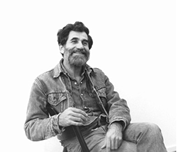
Kunst als leven – Art as Life
Allan Kaprow: Kunst als leven – Art as Life :: February 10 – April 22, 2007 :: VAN ABBEMUSEUM, BILDERDIJKLAAN 10, EINDHOVEN - THE NETHERLANDS :: 31 [0]40 238 1000 :: info[at]vanabbemuseum.nl.
Allan Kaprow, father of ‘happenings’ and ‘the most famous unknown artist’ died in April 2006. In association with the Haus der Kunst, Munich, the Van Abbemuseum organises the largest European solo presentation of the work of this American artist, displaying a development of almost 50 years of artistic work. The concept for this exhibition was developed together with the artist shortly before his death. Much of Kaprow’s art is special because it is interactive, intended to be carried out by people. The exhibition consists of a range of objects from Kaprow’s artistic legacy on view as well as a number of ‘happenings’ in which visitors can participate. The Van Abbemuseum’s artistic policy is to exhibit major overview exhibitions of artists from the sixties and seventies, who are the ‘classics’ of today.
The theme of the Allan Kaprow 'Kunst als leven – Art as Life' exhibition is the paradoxical question of how museums can display art in an appropriate manner in this day and age, while approaching real life with art as closely as possible. A range of objects from Kaprow’s artistic legacy will be displayed: early paintings, environments, video documents and photographs, as well as a fast array of original scores for his ‘happenings’ and ‘activities’.
This special presentation is not intended as an attempt to rewrite or document history, but to encourage visitors to see the ‘museum as mediation’. Kaprow was never interested in passively consumptive viewers but in active participation. The Van Abbemuseum is both a place of mediation and an agency of action. The exhibition will entail a re-enactment of a selection of happenings – on condition, however, that the visitors understand their new role and participate.
ALLAN KAPROW
Towards the end of the 1950s, American artist Allan Kaprow (1927-2006) coined the term ‘happenings’ for a new art form. A decade earlier, Kaprow had studied philosophy and subsequently art history with Meyer Shapiro in New York. At the same time he studied art with Hans Hofmann. It was while following composition classes with John Cage at the New School for Social Research in 1956/57 that he discovered he could use coincidence as well as everyday materials in his art. His work metamorphosed from expressionist scenes of figures through raw assemblies of materials to room-filling ‘environments’. With audiences participating, events took place in these ‘configured’ spaces from the late 50s onwards. Kaprow succeeded in doing what many painters and sculptors had endeavoured to achieve before him: the dissolution of the boundaries between art and reality. He accomplished the move into reality in such a radical fashion that his ‘happenings’ – which he later relabelled ‘activities’ – became indistinguishable from real life. During this process the artist drew back more and more from the institutions. To him, museums were burial chambers of art that no longer had anything to do with life.
HAPPENINGS
During the exhibition various happenings will take place in and outside the Van Abbemuseum. Participation is a must. For more information, dates and reservations, visit http://www.kaprow.org.
CURATOR
Exhibition concept: Eva Meyer-Hermann & Stephanie Rosenthal Van Abbemuseum exhibition curator: Eva Meyer-Hermann
The exhibition Allan Kaprow 'Kunst als leven – Art as Life' is a cooperation with Haus der Kunst, Munich, and co-sponsored by the Andy Warhol Foundation for the Visual Arts. The project has been carried out within the framework of TRANSFORM and with the support of the Culture 2000 programme of the European Union.
Posted by jo at 11:17 AM | Comments (0)
Turbulence Commission:
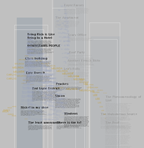
Gothamberg
Turbulence Commission: Gothamberg by Martin Wattenberg and Marek Walczak, with Chuck Crow, Johanna Kindvall, Warren Lehrer, Christiane Paul and Vivian Selbo.
Everyone who has lived in an apartment has a story to tell. "Gothamberg" is a place to read, interact and exchange stories of lives in apartment buildings. Together, these tales of unwanted sounds and smells, lobbies and bathrooms, laundry room gossip and unexpected favors form a single collective building, "Gothamberg". Their experiences form the elliptical threads of inhabitation, a mnemonic quality expressing something of the shared nature of dwelling.
"Gothamberg" is a 2006 commission of New Radio and Performing Arts, Inc., (aka Ether-Ore) for its Turbulence web site. It was made possible with funding from the Andy Warhol Foundation for the Visual Arts.
BIOGRAPHIES
MARTIN WATTENBERG'S work centers on the theme of making the invisible visible. Past projects include "The Shape of Song," "Thinking Machine," "history flow", the Whitney Artport's "Idea Line," and "Apartment." Wattenberg is a researcher at IBM's Visual Communication Lab where he creates new forms of data visualization. He is also known for the SmartMoney.com "Map of the Market." Wattenberg holds a Ph.D. in mathematics from U.C. Berkeley.
MAREK WALCZAK is an artist and architect who is interested in how people participate in physical and virtual spaces. This has led to digital tools and interactive projects such as "Apartment" which was shown at the Whitney Museum and many venues worldwide. "Dialog Table" has recently been completed for the Walker Art Center, it is a shared interface that replaces a keyboard and mouse with gesture recognition technology. Current projects bridge physical installations with user interaction, including a one block long facade at "7 World Trade Center" that reacts to pedestrians walking beneath it (for James Carpenter Design) and video installations that activate physical space based on user engagement such as Third Person, recently shown at the ICA, London.
CHUCK CROW is a financial engineer who specializes in the theory and implementation of autonomous trading systems. He obtained a B.S. in Computer Science with minors in Mathematics and Business Management from Johns Hopkins University and an M.S. in Operations Research from Columbia University. Chuck uses digitally rendered sound and raw field recordings to create engaging soundscapes intended for controlled listening environments. From lush layering to stark microsound, his compositional techniques include the use of static noise, stochastic processes, and real-time web data. He acquired a private pilot's license during the summer of 2000.
JOHANNA KINDVALL is an architect with a background in social work. She grew up in South Sweden and is now living in New York. After her degree in social studies she worked for seven years mostly with drug addicts and the mentally ill. At the same time she also worked with sculpture and art installations. For her architecture is a way to combine art with social issues. Johanna's work is often about the relationship between spaces and people, movement and behavior. In May 2003 Johanna got a grant from the Arts Grants Committee in Sweden to work with Marek Walczak in New York City on spaces and digital interaction. Currently Johanna is working for James Carpenter Design in New York. In her spare time she is also working on the Hudson Park Project.
WARREN LEHRER is a multi-disciplinary artist, writer, designer, performer, and educator. Over the past 25 years, he has been writing and designing books and theatrical works that explore the music of thought and speech, the complexity of character, the pathos and absurdity of life, and the relationship between social structures and the individual. The form and structure of his books attempt to capture the shape of thought and reunite the oral and pictorial traditions of storytelling with the printed page. Warren has published ten books including "Crossing the BLVD": strangers, neighbors, aliens in a new America (written with Judith Sloan). With Dennis Bernstein, he wrote the play Social Security: the basic training of Eugene Solomon, and with Harvey Goldman, he co-wrote and co-composed a contemporary opera, The Search for It and Other Pronouns. He has also produced two audio CDs, and six radio documentaries for Public Radio. His plays and performance pieces have been performed at La MaMa Experimental Theatre, the Public Theatre, the Theatre Workshop (Scotland), the Knitting Factory, the Jewish Museum, Independent Art at Here, the Painted Bride, etc.
CHRISTIANE PAUL is the Adjunct Curator of New Media Arts at the Whitney Museum of American Art and the director of "Intelligent Agent", a service organization dedicated to digital art. She has written extensively on new media arts and her book "Digital Art" (part of the World of Art Series by Thames & Hudson, UK) was published in July 2003. She teaches in the MFA computer arts department at the School of Visual Arts in New York and has lectured internationally on art and technology. At the Whitney Museum, she curated the show "Data Dynamics" (2001), the net art selection for the 2002 Whitney Biennial, as well as the online exhibition "CODeDOC" (2002) for artport, the Whitney Museum’s online portal to Internet art for which she is responsible. Other curatorial work includes "The Passam3eege of Mirage" (Chelsea Art Museum, New York, 2004); "Evident Traces" (Ciberarts Festival Bilbao, 2004); and "eVolution -- the art of living systems" (Art Interactive, Boston, 2004).
VIVIAN SELBO has conceptualized and designed web projects for "PBS/P.O.V.", the San Francisco Museum of Modern Art (SFMOMA), the Brooklyn Academy of Music, the Walker Art Center, Minneapolis, and the Museum of Modern Art, NY, among others. From 1995 to 1998, Selbo was the interface director of adaweb.com, now part of the Walker Art Center's Digital Arts Study Collection. Selbo is also an adjunct professor at the School of the Visual Arts, and New York University.
Posted by jo at 08:28 AM | Comments (0)
February 01, 2007
Do It With Others (DIWO): E-Mail-Art at NetBehaviour

Call for Contributions
Do It With Others (DIWO): E-Mail-Art at NetBehaviour :: An E-Mail-Art project on the NetBehaviour email list culminating in an exhibition at the HTTP Gallery in London :: Open Call for contributions from 31st January to 28th February 2007 via NetBehaviour email list: Subscribe here :: Exhibition at HTTP Gallery, London :: Initiated by Furtherfield.org.
The Do It With Others (DIWO) E-Mail-Art exhibition aims to highlight the already thriving imaginations of those who use social networks and digital networks on the Internet as a form of distribution. Just like Mail Art, E-Mail-Art bridges the divide between artists and non artists to share a freely accessible form of distribution.
The Mail Art projects of the 60s, 70s and 80s demonstrated Fluxus artists’ common disregard for the distinctions of ‘high’ and ‘low’ art and a disdain for what they saw as the elitist gate-keeping of the high’ art world. They often took the form of themed, ‘open calls’, in which all submissions were exhibited and catalogued. Mail Art has always been a useful way to bypass curatorial restrictions for those who wish to create active and imaginative exchange on their own terms; this form of activity usually flourishes outside of the gallery system.
This E-Mail-Art exhibition, intends to follow the spirit of past Mail Art endeavours by asking those submitting their works to open themselves to a shared dialogue as part of the process and medium on the NetBehaviour mail list, as a playful platform for experimentation together at the same time.
The theme of this E-Mail-Art project is Do It With Others (DIWO).
This project suggests that we extend the DIY ethos of some early net art and tactical media (said to be motivated by curiosity, activism and precision) towards a more collaborative DIWO approach. Peers connect, communicate and collaborate, creating controversies, structures and culture using both digital networks and shared physical environments.
You are invited to contribute and curate text, images, sound, net movies, physical objects, installation plans etc. on the theme of DIWO, only via the NetBehaviour email list, towards an open exhibition at the HTTP Gallery in London that opens in March '07.
To participate in Do It With Others (DIWO): E-Mail-Art at NetBehaviour
please join the NetBehaviour email list.
What Will Happen?
All posts to the NetBehaviour email list between 31st January and 1st April 2007 will be considered part of the artistic and curatorial project. In the spirit of early Mail Art Do It With Others (DIWO): E-Mail-Art at NetBehaviour is completely open. For the HTTP Gallery contributors are be invited to propose works for networks, computers, screens, projection, sound, print...
31st January: Contributions to Netbehaviour email list begin. List members are invited to devise their own ordering and selection strategies for the exhibition.
25th February 2 - 5pm GMT: Collaborative Curation Event Open review of contributions and discussion about the exhibition. The event will be webcast from the HTTP gallery. List contributions thus far will take physical form as an exhibition. Discussions using IM (chat) between Furtherfielders and other active contributors. Documented and posted to the list.
1st March: Gallery Opening of Do It With Others (DIWO): E-Mail-Art at NetBehaviour
1st March- 1st April: Continue to shape the exhibition via the email list by contributing more work, suggesting things be taken down, put back up, rearranged, anything!
1st May: All contributions documented in a catalogue available as a pdf download.
The project will also be documented in:- -- the NetBehaviour email list archive
-- LaurenDIWO's Blog [http://blog.netbehaviour.org/?q=blog/7] maintained by Furtherfield newcomer Lauren Wright.
Do It With Others (DIWO): E-Mail-Art at NetBehaviour a project by Ruth Catlow, Marc Garrett and Lauren Wright for Furtherfield in collaboration with all contributors to the NetBehaviour email list.
Posted by jo at 11:49 AM | Comments (0)
JANET CARDIFF & GEORGE BURES MILLER
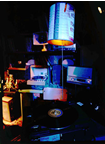
The Killing Machine and other Stories
The Killing Machine and other Stories :: JANET CARDIFF & GEORGE BURES MILLER :: Opening: Thursday, February 1, 2007, 7.30 p.m. :: Exhibition dates: from 2 February to 1 May 2007 :: Coproduced by: Museu d’Art Contemporani de Barcelona (MACBA) and Institut Mathildenhöhe Darmstadt :: Curated by: Bartomeu Marí (Chief Curator of MACBA) :: MACBA, Museu d’Art Contemporani de Barcelona, Plaça dels Angels, 1, 08001 Barcelona, Spain.
Since the early nineties Janet Cardiff (Brussels, Ontario, Canada, 1957) and George Bures Miller (Vegreville, Canada, 1960) have been working together on works in which they use sound and voice as raw material and main subject. Through techniques of edition and reproduction of binaural sound and the use of earphones and loudspeaker systems these works can be characterised as authentic sound sculptures.
These installations become temporal units of experience, in narrations that combine fictional stories and sound effects and question the visitor’s sensory experience, opposing the sense of hearing with the sense of sight. The sculptural space is therefore transformed into a phantasmagorical or hallucinatory one where apparently contradictory cultural traditions coincide at a specific place and time. The spectator is looking at works that are difficult to classify, since they propose a collage that brings together forms of high culture such as opera, art films or literature with popular culture, B-movies, rock’n’roll or radio broadcasts.
This exhibition contains a total of ten installations that weave a fabric of independent but complementary experiences. Each work imposes a time and a rhythm of its own, and like a play is linked to the imaginative capacity of each individual, which gives rise to a host of readings. This very high reading visuality brings Cardiff and Miller’s work close to literature by generating a script which can be read or interpreted according to the eye or ear of each reader-spectator. This produces stories that live side by side in time and transport the visitor to superimposed fictions: of the museum and of the works.
Among the Solo Exhibitions of Janet Cardiff and George Bures Miller in recent years are: the Lousiana Museum and the Art Gallery of Hamilton in 2006; the Hirshhorn Museum (Washington) and the Kunsthaus Bregenz, in 2005; the Vancouver Art Gallery and the Thyssen-Bornemisza Art Contemporary in 2004; the Whitechapel Art Gallery de Londres and the Museum of Modern Art of Oslo, in 2003; The National Gallery of Canada (Ottawa), the L.Augustine Gallery of New York and the Hamburger Bahnhof (Berlin) in 2002; the Canadian Pavillion in the 49 Biennale Venice, the Ps.1 Contemporary Art Center (New York), the Musée d’Art Contemporain de Montréal and the Castello di Rivoli (Torino) in
2001. [Related 1, 2]
Posted by jo at 09:01 AM | Comments (0)
SoundNetwork
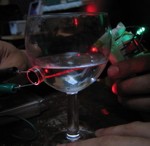
OWN [SOUND] ART Podcasting
SoundNetwork, a new network for NorthWest UK Artists using sound Present OWN [SOUND] ART Podcasting. Or art by subscription :: Launched 1st February 2007 :: Subscribe for free at www.folly.co.uk/soundnetwork
'Transmission K' by Andres Burbano, Colombia: A retrospective Sci-Fi piece - an inverse reconstruction of the crash of Soyuz 1: In 1967 the BBC in London announced the death of the crew member in this way: “ … He was an experienced cosmonaut, on his second flight, and had completed all his experiments successfully before returning to Earth. But within seconds of landing, just after he re-entered the Earth's atmosphere, the strings of the parachute intended to slow his descent apparently became tangled. The spaceship hurtled to the ground from four miles up. It is likely that Colonel Komarov was killed instantly on impact..."
Podcasting is the broadcast medium of the masses. It is possible for anyone to make and publish a podcast about anything they please and to access a global audience with the click of a mouse. Throughout February 2007 folly, in partnership with SoundNetwork, is publishing a series of specially commissioned podcasts that explore the possibilties of the medium for artists and the distribution of their work in sound. Anyone can subscribe to the series and with each download (1 every week in February) the listener will add a new piece of art to their digital collection.
This series not only explores the practical delivery of sound art on the internet, but also the very nature of communication through broadcasting; from the transmissions of a cosmonaut beyond our own atmosphere, to communicating ideas about spirituality through frequency, and through inviting sounds from our computers to occupy our environment as a backdrop to our own lives.
You can subscribe to the series by visiting www.folly.co.uk/soundnetwork
The series continues with podcasts from Gintas K (8th Feb), Neil Webb (15th Feb) and Antony Hall (22ndFeb).
http://soundnetwork.omweb.org info[at]soundnetwork.org.uk
Posted by jo at 08:57 AM | Comments (0)
Quartet

Virtual Dancer
Quartet :: 15 Feb 2007 - 18 Feb 2007 :: The Great Hall at Barts :: Informed by new scientific research in the field of physiology, this ICA co-production is the culmination of several years' collaborative research. It is an investigation into the kineasthetics of music: determining movements which produce sounds, which in turn produce new choreographies.
Movement is played across the senses of the human body. On stage at the Great Hall at St Bart's hospital live music and dance come together in the form of a virtual dancer that is driven by the mechanics of physical expression. This multi-media interplay is the culmination of several years collaborative research from specialists from engineering, biomedical and computational science, 3D animation and motion control in the field of physiology. Three leading choreographers - Lea Anderson, Russell Maliphant and Lisa Nelson - will each shape sections of the performance.
Quartet has 4 components: a virtual dancer; a musician; a robot camera; and, a real dancer. Quartet's central figure, the virtual dancer, is an avatar of sensual information, playing between its manifestation and its puppeteers. On stage the interactions between the human and computerised performers slip through different pairings, trios, and quartets, such as the musician using the speed or acceleration of her violin playing to duet with the real dancer; or a trio between the real and virtual dancers and the robot camera, exploring the choreography of cinematic space: the poetics of looking and moving. This interplay uncovers the tensions within the transfer of data.
The performance experiments with our perception and its articulation. It demonstrates communication within and between bodies in real-time by creating relationships between music, the gesture of musical performance, dance, robotics and animation.
Quartet has been funded by Sciart Production Awards 2005-6 for the Wellcome Trust in collaboration with the Physiological Laboratory at Cambridge University and the Arts Council of England. It is co-produced by the Live and Media Arts Department at the Institute of Contemporary Arts, London, with support from the Australia Council for the Arts, Arts Victoria, and ZKM Center for Art and Technology, Germany.
£15 / £10 Concessions / £9 ICA Members.
To book tickets please call the ICA box office on 020 7930 3647, open between 12noon and 9.00pm daily. Alternatively go to the ICA web site http://www.ica.org.uk/Quartet+12978.twl
Quartet Talk :: 17 February 2007 :: ICA Cinema
The creators of Quartet, specialists in dance, music, computational science, 3D animation and motion control, will discuss the creation of the software and hardware for its new interactive systems.
The discussion will be chaired by Margie Medlin, Project Director and Dr Susanna Ackers from the Hartware MedienKunstVerein, Dortmund, Germany.
Stevie Wishart Musical Director and Composer & Todor Todoroff, Sound and Gesture Systems Engineer will speak about creating real-time musical instruments to map the sounds and gestures of the musician to a virtual dancer.
Lea Anderson, Choreographer, Gerald Thompson, Motion Control Camera Designer & Carlee Mellow, Dancer will speak about working with motion control technologies to create choreographies of cinematic space and dialogues that uncovers the tensions within the transfer of data.
Nick Rothwell, Interface Designer and Systems Development & Holger Deuter, 3D character designer will speak about creating a versatile and flexible creative system for experimenting with cause and effect in multiple media.
£6 / £5 Concessions / £4 ICA Members.
** SPECIAL OFFER SPECIAL OFFER SPECIAL OFFER SPECIAL OFFER SPECIAL OFFER SPECIAL OFFER SPECIAL OFFER SPECIAL OFFER**
The first 20 people to book tickets for this talk will be able to purchase 2 for 1 tickets for a performance of Quartet (subject to availability). Offer only available via telephone bookings: call the Box Office to book on 020 7930 3647.
Emma Quinn
Director of Live and Media Arts
ICA
Visit the new ICA website www.ica.org.uk
Posted by jo at 08:21 AM | Comments (0)
Eduardo Navas
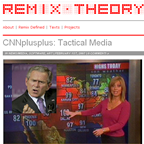
Remix Theory
http://remixtheory.net :: http://remixtheory.org :: http://remixtheory.com :: Remix Theory is an online resource by Eduardo Navas that offers some of his research on Remix. Navas focuses on Remix itself as opposed to Remix Culture. In this site you will find a brief definition of Remix, which is examined more extensively in essays that will be added to this website as they become available.
Remix Theory is not meant to function on a daily basis. It is a resource updated periodically, according to the flow of research. It does not focus on the latest information, but on relevant material to the history of Remix, some which may have been published years ago. The site contains material that is obtained from other online sources, with the proper reference to the original source. The content of the site consists of reviews, articles, projects and images relevant to Remix. The site also features reviews, criticisms and preliminary theories by Eduardo Navas.
Remix Theory is designed to move towards a remix of itself, by recombining much of the material that is archived to put to test the possibilities of Remix. This will become transparent as the database grows, and specific projects are developed. The site is designed to host, archive and promote projects which explore the current possibilities of Remix online and offline; it is prepared to become a repository of collaborations with different people and institutions.
Posted by jo at 08:08 AM | Comments (0)

